



In 2019 we celebrate the 150th anniversary of Finsbury Park, and we time travel through its past and future with the launch of our Citizen Sci-fi programme and methodology. Dominant sci-fi franchises of our time, from Black Mirror to Westworld, have captured popular attention by showing us their apocalyptic visions of futures made desperate by systems of dominance and despair.
What is African-American author, Octavia E. Butler’s prescription for despair? Sci-fi and persistence. Sci-fi as a tool for getting us off the beaten-track and onto more fertile ground, and persistent striving for more just societies.The 2015 book Octavia’s Brood honoured her work, with an anthology of sci-fi writings from US social justice movements and this inspired us to try a new artistic response to the histories and possible futures of Finsbury Park.
Furtherfield’s Citizen Sci-Fi methodology combines citizen science and citizen journalism by crowdsourcing the imagination of local park users and community groups to create new visions and models of stewardship for public, urban green space. By connecting these with international communities of artists, techies and thinkers we are co-curating labs, workshops, exhibitions and Summer Fairs as a way to grow a new breed of shared culture.
Each artwork in the forthcoming exhibition invites audience participation – either in it’s creation or in the development of a parallel ‘people’s’ work – turning every idea into a portal to countless more thoughts and visions of the past and future of urban green spaces and beyond.
So where do we start? Last year we invited artists, academics and technologists to join us in forming a rebel alliance to fight for our futures across territories of political, cultural and environmental injustice. This year both our editorial and our exhibition programme are inspired by this alliance and the discoveries we are making together.
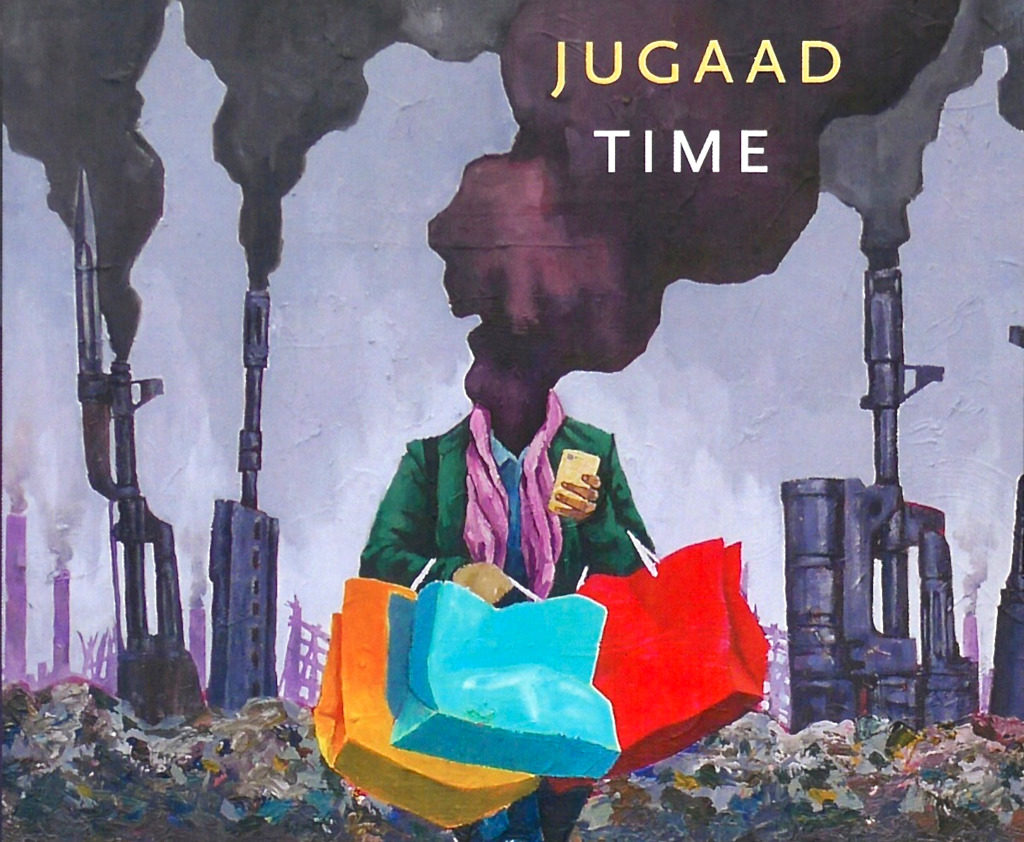
To kick off this year’s Time Portals programme at Furtherfield, in April we will host the launch and discussion around Jugaad Time, Amit Rai’s forthcoming book. This reflects on the postcolonial politics of what in India is called ‘jugaad’, or ‘work around’ and its disruption of the neoliberal capture of this subaltern practice as ‘frugal innovation’. Paul March-Russell’s essay Sci-Fi and Social Justice: An Overview delves into the radical roots and implications of Mary Shelley’s Frankenstein (1818). This is a topic close to our hearts given our own recent exhibitions Monsters of the Machine and Children of Prometheus, inspired by the same book. Meanwhile we’ve been hosting workshops with local residents exploring our visions for Finsbury Park 150 years into the future. To get a flavour of these activities Matt Watkins’ has produced an account of his experience of the Futurescapes workshop at Furtherfield Commons in December 2018.
In May we will open the Time Portals exhibition which features several new commissions. These include Circle of Blackness by Elsa James. Through local historical research James will devise a composite character to embody the story of a black woman from the locality 150 years ago and 150 years in the future. James will perform a monologue that will be recorded and produced by hybrid reality technologist Carl Smith and broadcast as a hologram inside the Furtherfield Gallery throughout the summer. While Futures Machine by Rachel Jacobs is an Interactive machine designed and built through public workshops to respond to environmental change – recording the past and making predictions for the future while inspiring new rituals for our troubled times. Once built, the machine occupies Furtherfield Gallery, inviting visitors to play with it.
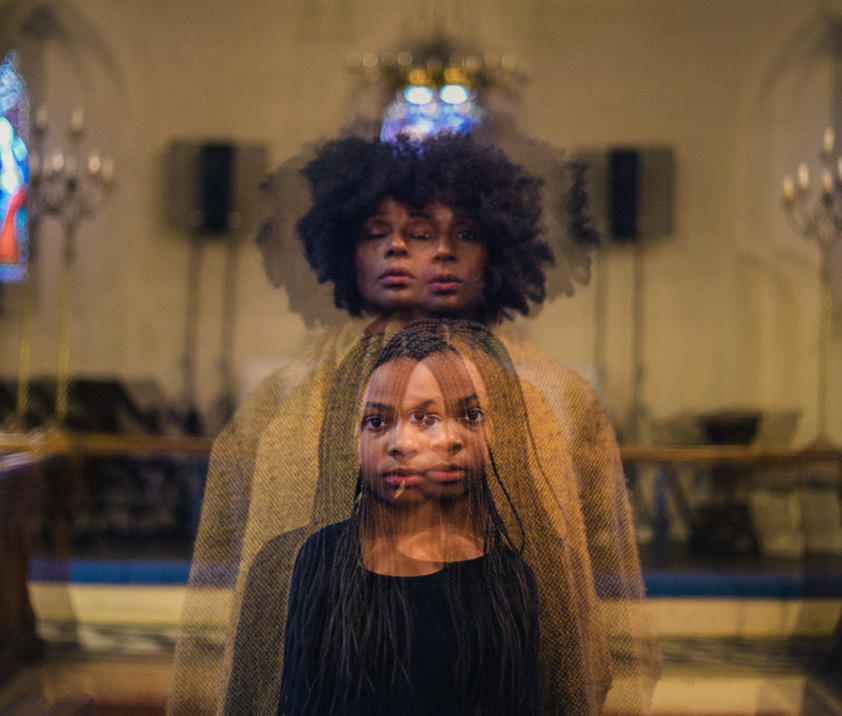
Time Portals opens on May 9th (2019) with other time traveling works by Thomson and Craighead, Anna Dumitriu and Alex May, Antonio Roberts and Studio Hyte. Visitors will be invited to participate in an act of radical imagination, responding with images, texts and actions that engage circular time, long time, linear time and lateral time in space towards a collective vision of Finsbury Park in 2169.
From April onwards, a world of activities, workshops with local families and their enriching noises, reviews, interviews and an array of experiences will unfold. Together we dismiss the dystopian nightmares and invite communities to join us in one of London’s first “People’s Parks” to revisit and recreate the future on our own terms together.
Marc Garrett will be interviewing Elsa James, about her artwork Circle of Blackness, and Amit Rai about his book Jugaad Time. Both will soon be featured on the Furtherfield web site.
On a blustery cold and wet Sunday in the build up to Christmas I joined a group of people at Furtherfield Commons to discuss the future of Finsbury Park. I finally arrived after prowling around their darkened Gallery in the centre of the park, only to discover the event was being hosted in their other space in the far southeastern corner of the park. This brief detour gave me a moment to breathe in one of my local parks and I experienced a familiar feeling of vulnerability as the night drew in and cold drops of rain started to make themselves felt. The few brave families and exercisers were beginning to retreat as I crossed the open stretch of field that runs parallel to the roaring Seven Sisters Road. Drawn by the welcoming light coming from the building in the small gardens behind the legendary Rowans Ten Pin Bowling and guided by the sound of the drumming, a regular feature of this corner of the park, I entered the workshop and was greeted with mince pies, tea and other goodies, and met the 11 other workshop participants.
Timed to coincide with the 150th anniversary of Finsbury Park, this workshop for local residents, aimed to tap into our experiences and imaginations to generate future visions of the park. The event was led by Dr Rachel Jacobs, who is a local with a special affection for the park, and she started by sharing it’s stories and describing some of the features that are no longer in existence including a bandstand and the many trees that have been removed over the years.
We started by identifying features of the park that we would like to ‘lose’ and those we wanted to ‘protect’. Answers were varied but along similar themes. Many people shared a desire to preserve the trees and if possible, have more. The lake featured prominently with many people wanting to maintain the space and the sanctuary it provides for birds. Rose, one of my fellow workshoppers, gleefully called for those people who feed bread to the ducks to be poisoned.
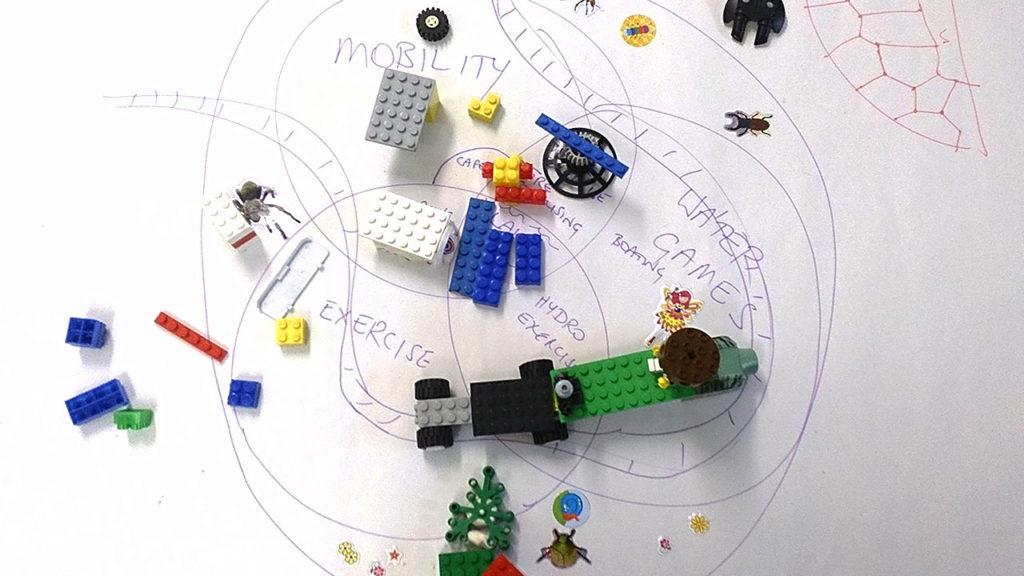
The underground reservoir, a cathedral-like temple to water supply was hailed as a hidden gem that could be utilised as a space during the colder months by Polly a local resident and manager of Space4. Simon, Chair of Friends of Finsbury Park, suggested we consider uses for Manor House Lodge (another building that had escaped my attention). Zeki prioritised the the rocks in the park for protection – especially at the amphitheatre space beside the play park. There were wistful expressions of personal connections to conkers, squirrels and swans. The things that people wanted to lose were more elusive: the atmosphere that the park creates at night; its association with crime and a lack of safety. Gab who overlooks the park from his 8th floor flat, feels the park can be scary and in his words, sometimes ‘sly’. Removing the fences was suggested as a possible remedy.
Next, we were introduced to an initially bemusing process based on Play Your Place, designed by artists Ruth Catlow and Mary Flanagan, to introduce playful and game-like activities to public consultation. We were each asked to select different cards with random words that we were told would help us to disrupt our conventional view of problem solving. The cards were divided into provocative statements, for example mine were: ‘London is no longer’ and ‘getaway car’. Then a spinning wheel contained words associated with game features, like ‘mission’, ‘protagonist’, ‘goal’ or ‘reward’. After drawing or writing out our scenarios based on the random words we had to pick a segment of the wheel in which to place our ideas.
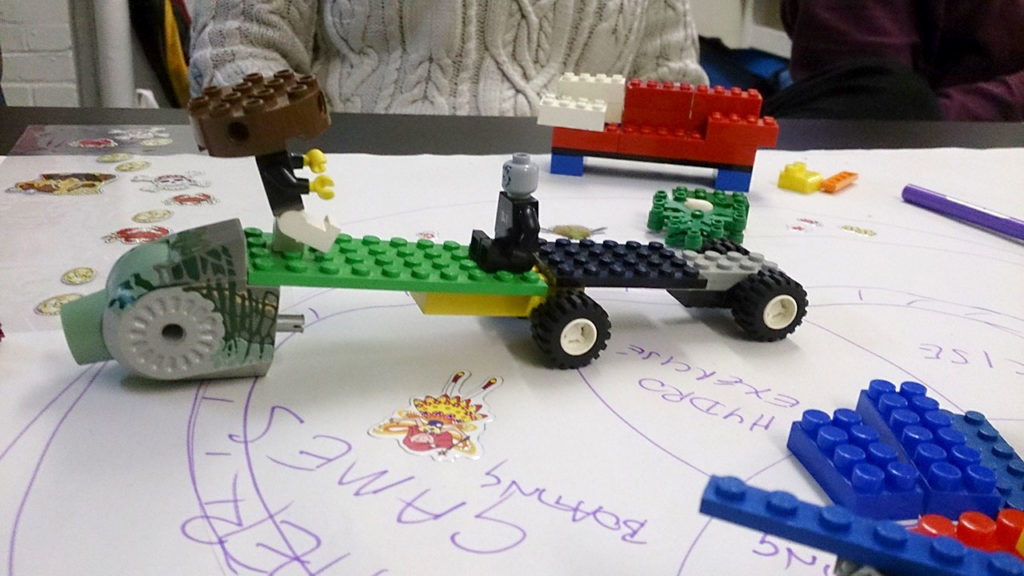
I asked if London is no longer, why is that so? Perhaps the park has eaten London. I was making the park the protagonist, the hero of the story. My ‘getaway car’ card prompted me to imagine Finsbury Park criss-crossed by many roads. So what if a part of the park could move very slowly, a moving park that people could take in the rest of the park from and jump on and off.
Zeki, one of the youngest participants had the cards ‘maps‘ and ‘someone caring for the park’ they assigned it the wheel word ‘reward’. He imagined the rocks in the park could become an area where people could come and paint and draw on the rocks. People will be able to look at the drawings and climb on the rocks. He said this suited ‘reward’ because you get a nice place.
Finally we worked with lego and plasticine, felt and coloured paper, to make a representation of our scenarios. Time flew by before we were then asked to talk about what we had created.
Simon and Talal ended up using a lot of lego. They said they weren’t that confident ‘creating’ but their riotous explosion of lego pieces described the Finsbury Park Lodge with lots of tropical trees growing around them. They included a clocktower which they felt the park needed. Ominously on the edge of their diorama there was, in their words: ‘the threat of a forest fire’.
Ilenia and Gab created intricate visions of the park modelled from tiny pieces of plasticine. Ilenia created crosses to represent all the buildings that she was going to destroy. She said “All the fences will be replaced by nice trees. The lake will be larger than it is now. There will be more people using the park.” Gab described the a tree as becoming “a colourful multi-form creator. It will be very friendly and very different from normal. Everything will be very colourful and this will be linked to representing climate change.” Emma who earlier in the workshop explained her love of conkers ended up building robot conkers.
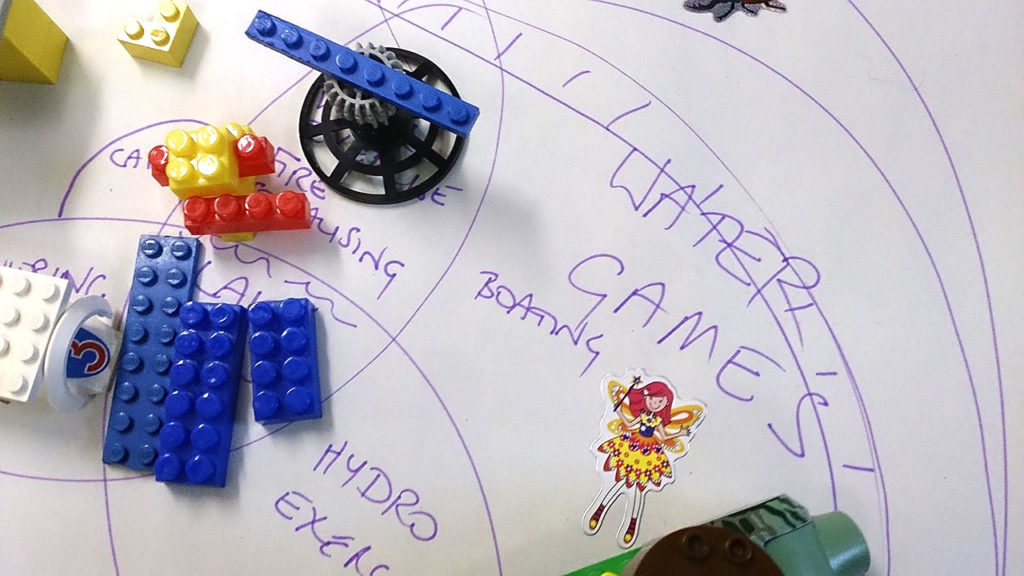
The outcomes were unexpected and realised in a wonderfully ad hoc way with a rich mix of ideas. Rachel and the Furtherfield team were on hand to support and provide more insight. Although the process of drawing cards and selecting from a wheel was initially quite perplexing, staying with the uncertainty of the process meant that we came up with ideas that were novel and unhindered by more formal or conservative notions of preserving or enhancing Finsbury Park. The two hour time limit, meant that everything moved along at pace that kept the idea generation restless. I believe I speak for all who took part in anticipating the results of the wider project.
What can possibly be made from such a kaleidoscope of raw material, I wondered on my way home in the pouring rain? Perhaps my plant car or Emma’s robot conkers will see the light of day or the darkness of the underground reservoir.
Futurescapes is an Innovate UK Audience of the Future Design Foundations project that uses Finsbury Park as a test case to examine the commercial potential for using immersive experiences as a tool for collaborative placemaking for public spaces and integrated public services. Furturescapes is a partnership project with Furtherfield, The Audience Agency and Wolf in Motion.
Join us in Edinburgh at the first DAOWO ‘Blockchain & Art Knowledge Sharing Summit’ of 2019
DAOWO (Distributed Autonomous Organisations With Others) Summit UK facilitates cross-sector engagement with leading researchers and key artworld actors to discuss the current state of play and opportunities available for working with blockchain technologies in the arts. Whilst bitcoin continues to be the overarching manifestation of blockchain technology in the public eye, artists and designers have been using the technology to explore new representations of social and cultural economies, and to redesign the art world as we see it today.
This summit will focus on potential impacts, technical affordances and opportunities for developing new blockchain technologies for fairer, more dynamic and connected cultural ecologies and economies.
Programme
Although the term ‘blockchain’ has trickled downstream into the public domain, the principles behind the technology remain mysterious to many. Embodied within physical assemblages or social interventions that mine, hash and seal the evidence of human practices, creatives have provided important ‘coordinates’ in the form of artworks that help us to unpick the implications of the technology and the extent to which it re-configures power structures.
Hosted by Prof Chris Speed and Mark Daniels with panellists:
Pip Thornton – The Value of Words in an Age of Linguistic Capitalism
Bettina Nissen & Ailie Rutherford – Designing feminist cryptocurrency for Govanhill
Evan Morgan – GeoPact
Jonathan Rankin – OxChain, Pizza Block
Larissa Pschetz – Karma Kettles
Contributors include:
Ruth Catlow, Furtherfield and DECAL
Mark Daniels, New Media Scotland
Clive Gillman, Creative Scotland
Marianne Magnin, Arteïa
Prof Chris Speed, Design Informatics, University of Edinburgh
Ben Vickers, Serpentine Galleries
Through two UK summits, the DAOWO programme is forging a transnational network of arts and blockchain cooperation between cross-sector stakeholders, ensuring new ecologies for the arts can emerge and thrive.
DAOWO Summit UK is a DECAL initiative – co-produced by Furtherfield and Serpentine Galleries in collaboration with the Goethe-Institut London. This event is realised in partnership with the Department of Design Informatics at the University of Edinburgh and New Media Scotland.
OxChain is a major EPSRC research project which explores how Blockchain technologies can be used to reshape value in the context of international development and the work of Oxfam, involving the Universities of Edinburgh, Northumbria and Lancaster.
“À la recherche de l’information perdue” was a performance that Cornelia Sollfrank contributed to the ‘Post-Cyber Feminist International’ event at the Institute of Contemporary Arts in London.1 The event in November 2017 marked the twentieth anniversary of the First Cyberfeminist International (documenta X, Kassel, Germany, 1997) organized by the Old Boys Network, paying homage to its productive format and legacy. In her own words, Sollfrank set out to offer an “one-hour lecture performance that makes a (techno-)feminist comment on the entanglements of gender, technology and information politics,” with the rationale that “with the technological landscape vastly changed since the first Cyberfeminist International, we are living in a time well beyond the imagined future of the early cyberfeminists. Expanding upon this particular genealogy, this convening purposefully constellates thinkers to consider a new vision for “post-cyberfeminism” that is substantive and developed, without being exclusionary of contestation.”
I was surprised at the invitation of the charismatic woman I came to know as “Coco” to attend her performance. My surprise, which I bet is going to surprise Coco in turn, was due to two reasons. I had published two academic papers on WikiLeaks (2012, 2014 with Robinson), later included in a monograph charting on digital activism from 1994-2014 (2015), and at the time I was working on another paper on ‘Leaktivism and its Discontents’ examining the DCLeaks, CIA Vault7Leaks and DNCLeaks (2018). Although I took a critical view of the ideological and organizational conflicts within WikiLeaks as an organization internally, and examined the impact of that organization externally on academic debates in three disciplines between 2010-2012, and followed the leaks religiously in my scholarship, I had not written or commented on the rape allegations against Julian Assange.2 The related legal requirements, however, were what forced him to be stranded in the Ecuadorian Embassy from the 12th of June 2012 to the time of writing in 2018, in the first place. On March 6th, 2016, I was one of the signatories urging Swedish and UK Permanent Representatives to the United Nations in Geneva, to respect the United Nations’ decision to free Julian Assange. Moreover, as my work almost in its entirety has not focused on gender aspects of technology, or gender studies (apart from say examining ethno-patriarchal racist ideologies in anti-migrant discourses on digital networks in 2010-2013 for the Project, see et al. 2018),3 I felt rather intrigued by the invitation to the event, and its technofeminist context and agenda. If Coco was brave enough to invite me to watch her performance and trust me to comment on it, considering both my research (see references), and critical but supportive stance to Julian Assange’s quest for freedom, then I had to also be brave enough to take up the challenge!
As academics we are encouraged not to write in the first person. In fact, “do not use the first person in your scholarship” is served up in higher education establishments around the world, bar in certain sub-disciplines who take a certain pride in reflecting on the situated knower and their reflective positionality. In my own scholarship, I have used the first person sparingly. Here, in this text however, I feel obliged to do so, as I watched an artist perform and I would like to convey the thoughts aroused in the internal empire; and also understand whether and if so, how it has transformed me. After all, that is what art is for, right?
Sollfrank’s performance consists of her reading a text, overlaid by electronic sounds, and the projection of changing images behind her. There are nine images: orange font capital letters on a black and white pixel background: INFORMATION, ORGANISATION, ZEROS+ONES, BINARY WORLDS, PURE DIFFERENCE, CYBERFEMINISM, GENDER+TECHNOLOGY, NAKED INFORMATION, TRANPARENCY. The first image background is a very close zoom in to a black-and-white image and each image background zooms out to the final one. Only the last two images reveal the subject of the image: the photograph of the ripped condom used by Julian Assange during sexual intercourse with one of the women that subsequently accused him of rape, table by the Swedish police and published in their report. This was the final image of her lecture below.
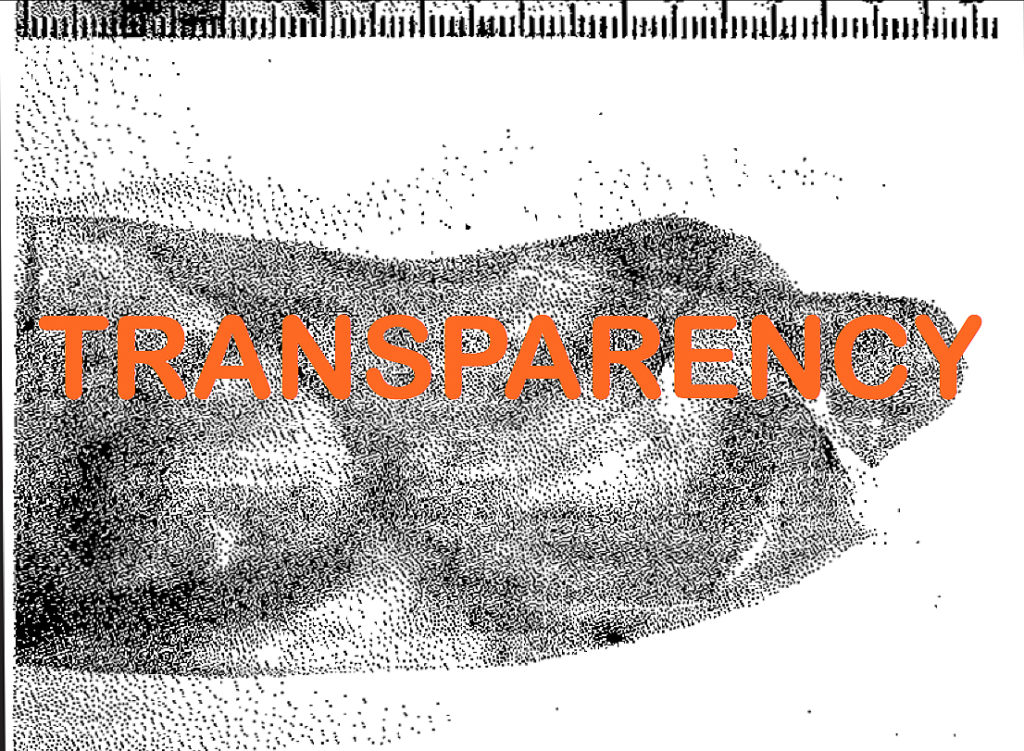
The structure of the lecture is an assemblage really of separate elements she uses to launch her critique. In introducing her performance, she asks:
“On the road to freedom, one has to make sacrifices; but what remains when the way gets swampy and forks into affective structures? Rape can be performed in many ways.
So, what is missing? What are we looking for?
Has it been lost at all? Maybe it just multiplied, and stayed a much as it has gone away? Who knows?
We all create reality collectively and long ago have become zombies of transparency.”
Here, already I am baffled by the sentence “Rape can be performed in many ways.” I hadn’t thought about the “performativity” of rape. I make a mental note of this. Who “performs” during a rape? Can you perform before, during, or after a rape? What are the “many ways” a rape can be performed? This thought grabs me immediately at the start of her performance. But I relieve myself of it, thinking I got to be self-policing: this is the kind of thought that gets you into hot water: she must mean either literally the various categories of rape in Sweden, or this is some kind of allegory on reactive affect, discursive violence, a form of sexual misconduct, or again literally the case of broken trust found in a broken condom? I don’t have time to think, as Sollfrank swiftly moves on to the first section “INFORMATION,” where she talks about theoretical approaches to information: structure, knowledge, signal, message, meaning, process. In the sentence,“Julian Assange is accused of rape,” the information is coded in words and letters, the meaning of that structure is conveyed and at the pragmatic level, the receiver finds value in that information depending on whether he/she is interested in this person, his organization, what he represents, subjectively decoding this information to create meaning. The next piece of the puzzle is, of course, “ORGANISATION.” Sollfrank quotes the WikiLeaks organisation mantra: “One of our most important activities is to publish original source material alongside our news stories so readers and historians alike can see evidence of the truth.” Assange faced criticism for his centralised style of leadership in the organisation, which caused people to leave it. And obviously his political aims are somewhat inconclusive. Here, in this part of the lecture, I recognise my own writing, when Sollfrank says: “Maybe, the man and his organisation are an empty signifier, filled ideologically to reflect the discursive mood of anyone.” I had made that argument in ‘WikiLeaks Affects’ (2012), analyzing the diverse actors who supported Assange and the public feelings of him as a traitor or hero, the overflow of affective structures and the acceleration offered by digital networks (digital materialisation of the revolutionary virtual that may or not happen in the real).
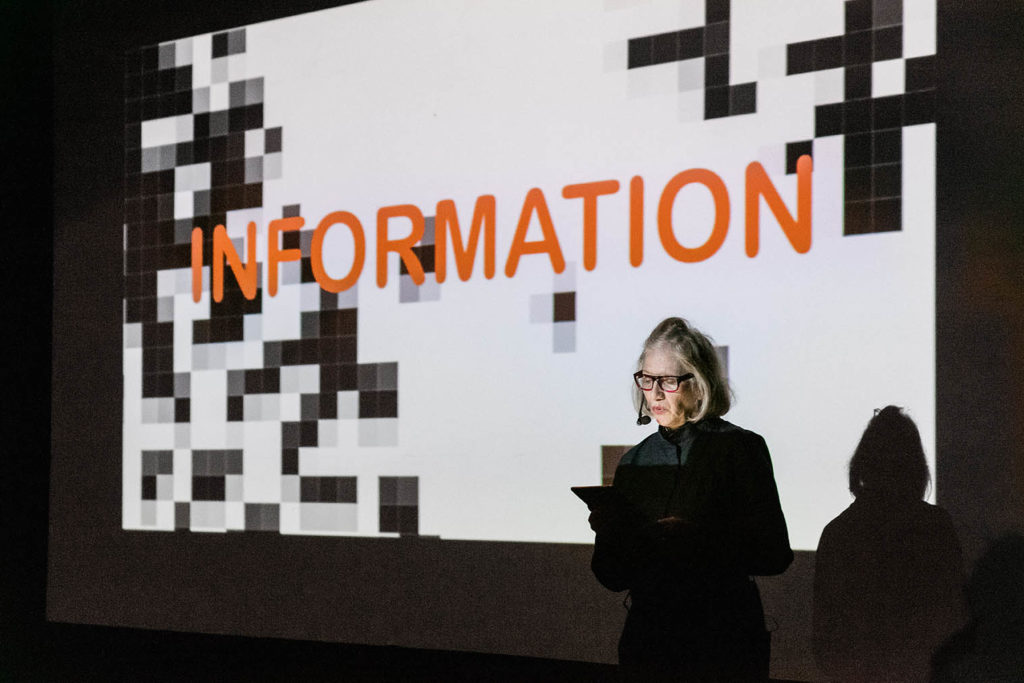
But Sollfrank extends this argument by asking: “Why do they all express their particular feelings, even though these are uniformly rooted in their own individual causes and systems of belief?” Yes, what is at stake when Assange’s organisation jump-scaled globally after the release of the Collateral Damage video in 2010? Would the strong tradition of the women-protective Swedish state have taken on the same exact legal process for someone less than Assange? Letting him leave for the UK, after a police station visit, but then after the leaks occurred, recall him for further questioning? The saga between the Swedish government and Assange,culminated in Swedish prosecutors dropping their investigation into Assange, bringing to an end a seven-year legal standoff on May 19, 2017.4 In February 2018, a judge, nevertheless, upheld the warrant for his arrest. On 28 March 2018, Ecuador cut Assange’s Internet connection at its London embassy refuge “in order to prevent any potential harm,” caused by his social media posts denouncing the arrest of a Catalonian separatist leader, which Ecuador officials claimed “to put at risk” Ecuador’s relations with European countries. Assange might well be an obnoxious bastard to whom rape charges might be thrown at and dropped, but he becomes a target for Sollfrank for another reason…
This is where the performance goes SURREAL. Of the ONE and ZERO, Sollfrank makes beautiful poetry of this, in her “BINARY WORLDS” section:
“The man is the ONE, and ONE is everything. And the female has nothing you can see. Woman functions as a hole, a gap, a space, a nothing that is not the same, identical, identifiable, … a fault, a flaw, a lack, an absence outside the system of representations and auto-representations. Lacan lays down the law and leaves no doubt when he syas: ‘There is woman only as excluded by the nature of things. She is not “all,” “not whole,” “not-one,” and whatever she knows can only be described as “not-knowledge.” There is no such thing as THE woman, where the definite article stands for the universal. She has no place like home, nothing of her own, other than the place of the Other which,” writes Lacan, “I designate with a capital O.”
And it remains up to us, the audience, to make the association she would never express herself: the ONE mal god, is it him?
In “PURE DIFFERENCE,” Sollfrank finally gets irritated herself! “ONE, the definite, upright line; and ZERO the diagram or nothing at all: penis and vagina, thing and hole; a perfect match… Now the only thing that counts is whether there is something to see, and there seems to be something missing with the Zero. What makes the <woman> in this respect? …Why not admit that we are as blind for the invisible sexual difference as between a Zero and a ONE, because we always have to see pictures and that means something else?”
“CYBERFEMINISM” is brought in to help answer some of the questions here, but its focus has been how to use technology to fight “Big Daddy Mainframe,” technology as a way to dissolve sex and gender. The cyberfeminist techno-utopian expectations did not digitally or otherwise materialise, and Sollfrank asks: “What is between your legs NOW? Zeroes and ones? Liberated data? Digital slime? The warm machine still awaits your intention, but never forget the flesh.” What Sollfrank goes on to declare in “GENDER & TECHNOLOGY” is that “Big Daddy rules supreme.” That is my least favorite part of the lecture. Yes, engrained spheres of masculinity are still ubiquitous within all techno-cultures, and Sollfrank offers the GamerGate example with men harassing women, trolling, doxxing, cyberstalking, intimidation and policing experienced by women and queers are real. Indeed.
But here’s also where the binary lures to manifest itself. Extending Assange’s obnoxious techno-geek persona accused of rape and making him the master signifier of patriarchy reproduced in digital networks and especially technoculture would in turn reproduce exactly the same that fills the empty signifier Assange with the baggage of their own beliefs. Watch out and not fall into the same trap here, although it might be beautiful just to fall.
Sollfrank’s contribution here is really not on Assange’s signifier as a male God of ONE the personification of toxic masculinity, it is more her critique of his ideology of TRANSPARENCY, in the last section of her performance.
The inconvenient question remains, what information at which moment and from whom? If it is not related to a political goal, transparency becomes an end in itself – an ideology, and we: its zombies. With transparency as the new imperative: How do we distinguish … between accountability, surveillances and privacy invasion? Liberating public data and protecting private ones? All data are made of similar substance and follow the same logic; who might be able to stop the flow, once it is flowing? Who would want to interrupt the continuum, to crack and leak and disrupt the flow – of capital? No way!
The performance finishes with “Naked information is incapable of generating a myth, I live off that which others do not know about me. And will I ever know myself? In contrast to calculating, thinking is not self-transparent. There is nothing more intransparent than the subject to herself – no matter how much data I have and share. Information is just information, only once you know what you are looking for, the search can begin.”
Sollfrank’s performance approached information from all the sides she started with: structure, knowledge, signal, message, meaning, process. I had to reflect on why I never wrote about the Swedish case in all the scholarship I developed on WikiLeaks over the years. I felt Assange is an easy target to be used as a prop to talk about sexism reproduced in digital networks, techno-patriarchy and cyberfeminism, filling him in as an empty signifier to whatever the pet subject and the ideological discursive purpose happens to be. And yet, I think here Sollfrank does something brilliant, bringing a picture of the ripped condom as a background to her red-font words. Because she is connecting meanings to structures, material, affective, digital and interrogating trust, extending to the trust that a condom should not be ripped, interrogating the winner takes all justification register of transparency as an ideology, surveillance as the normal, and the end of secrecy, the quest of truth at all costs, even disrupting democracy, even the neoliberal capitalist kind. When there is no true self, even in itself, the search for lost information can be the point or utterly pointless, the same way as ZERO and ONE. This is what Sollfrank I think transformed with her art in my (post-cyberfeminist?) soul machinery.
Link to most recent performance at the hacker convention 35c3 in Leipzig:
1 https://www.ica.art/whats-on/season/post-cyber-feminist-international
2 https://diem25.org/urging-sweden-and-the-uk-to-free-julian-assange
4 https://www.theguardian.com/media/2015/oct/12/timeline-julian-assange-and-swedens-prosecutors
Associate Professor in Media and Communication at the University of Leicester. Her work contributes to theorising cyberconflict, and exploring the potential of ICTs and network forms of organization for social movements, resistance and open knowledge production.
artist, researcher and university lecturer, living in Berlin (Germany). Recurring subjects in her artistic and academic work in and about digital cultures are artistic infrastructures, new forms of (political) self-organization, authorship and intellectual property, techno-feminist practice and theory. She was co-founder of the collectives women-and-technology, – Innen and old boys network, and currently is research associate at the University of the Arts in Zürich for the project ‘Creating Commons.’ Her recent book Die schönen Kriegerinnen. Technofeministische Praxis im 21.Jahrhundert was published in August 2018 with transversal texts, Vienna. For more information, pls visit: artwarez.org
In thinking about the relationship between science fiction and social justice, a useful starting-point is the novel that many regard as the Ur-source for the genre: Mary Shelley’s Frankenstein (1818). When Shelley’s anti-hero finally encounters his creation, the Creature admonishes Frankenstein for his abdication of responsibility:
I am thy creature, and I will be even mild and docile to my natural lord and king, if thou wilt also perform thy part, the which thou owest me. … I ought to be thy Adam, but I am rather the fallen angel, who thou drivest from joy for no misdeed. … I was benevolent and good; misery made me a fiend. Make me happy, and I shall again be virtuous.
Popularly misunderstood as a cautionary warning against playing God (a notion that Shelley only introduced in the preface to the 1831 edition), Frankenstein’s meaning is really captured in this passage. Shelley, influenced by the radical ideas of her parents, William Godwin and Mary Wollstonecraft, makes it clear that the Creature was born good and that his evil was the product only of his mistreatment. Echoing the social contract of Jean-Jacques Rousseau, the Creature insists that he will do good again if Frankenstein, for his part, does the same. Social justice for the unfortunate, the misshapen and the abused is what underlies the radicalism of Shelley’s novel. Frankenstein’s experiments give birth not only to a new species but also to a new concept of social responsibility, in which those with power are behoved to acknowledge, respect and support those without; a relationship that Frankenstein literally runs away from.
The theme of social justice, then, is there at the birth also of the sf genre. It looks backwards to the utopian tradition from Plato and Thomas More to the progressive movements that characterised Shelley’s Romantic age. And it looks forwards to how science fiction – as we would recognise it today – has imagined future and non-terrestial societies with all manner of different social, political and sexual arrangements.
Shelley’s motif of creator and created is one way of examining how modern sf has dramatized competing notions of social justice. Isaac Asimov’s I, Robot (1950) and, even more so, The Caves of Steel (1954) ask not only the question, ‘can a robot pass for human?’, but also more importantly, ‘what happens to humanity when robots supersede them?’. Within current anxieties surrounding AI, Asimov’s stories are experiencing a revival of interest. One possible solution to the latter question is the policing of the boundaries between human and machine. This grey area is explored through use of the Voigt-Kampff Test, which measures the subject’s empathetic understanding, in Philip K. Dick’s Do Androids Dream of Electric Sheep? (1968) and memorably dramatized in Ridley Scott’s film version, Blade Runner (1982). In William Gibson’s novel, Neuromancer (1984), and the Japanese anime Ghost in the Shell (1995), branches of both the military and the police are marshalled to prevent AIs gaining the equivalent of human consciousness.
Running parallel with Asimov’s robot stories, Cordwainer Smith published the tales that comprised ‘the Instrumentality of Mankind’, collected posthumously as The Rediscovery of Man (1993). A key element involves the Underpeople, genetically modified animals who serve the needs of their seemingly godlike masters, and whose journey towards emancipation is conveyed through the stories. It is surely no coincidence that both Asimov and Smith were writing against the backdrop of the Civil Rights Movement, but it is also indicative of the magazine culture of the period that both had to write allegorically. In N.K. Jemisin’s Broken Earth trilogy (2015-7), an unprecedented winner of three successive Hugo Awards, the racial subtext to the struggle between ‘normals’ and post-humans is made explicit.
Jemisin, like Ann Leckie’s multiple award-winning Ancillary Justice (2013), is indebted to the black and female authors who came before her. In particular, the influence of Octavia Butler, as indicated by the anthology of new writing, Octavia’s Brood (2015), has grown immeasurably since her premature death in 2006. Butler’s abiding preoccupation was with the compromises that the powerless would have to make with the powerful simply in order to survive. Her final sf novels, Parable of the Talents (1993) and Parable of the Sower (1998), tentatively posit a more utopian vision. This hard-won prospect owes something to both Joanna Russ’s no-nonsense ideal of Whileaway in The Female Man (1975) as well as the ‘ambiguous utopia’ of Ursula Le Guin’s The Dispossessed (1974). Leckie, in particular, has acknowledged her debt to Le Guin, but whilst most attention has been paid to the representation of non-binary sexualities in both the Ancillary novels and Le Guin’s The Left Hand of Darkness (1969), what binds both authors is their anarchic sense of individualism and communitarianism.
Whilst sf has, like many of its recent award-winning recipients, diversified over the decades, there is little sense of it having abandoned the Creature’s plaintive plea in Frankenstein: ‘I am malicious because I am miserable.’ It is the imaginative reiteration of this plea that makes sf into a viable form for speculating upon the future bases of citizenship and social justice.
When I first heard about MoneyLab, it was back in 2013 or the beginning of 2014, when I was doing my masters in London. A friend of mine handed a flyer to me and I was intrigued by the strange typography and the combination of bright colours. However, I didn’t quite believe that any kind of initiative could really start an alt-economy movement. Not that I didn’t believe in local currency or creative commons, but those gentle approaches generally seemed to lack traction, just like liberals do with voters. I naturally thought MoneyLab was one of those initiatives.
However, as Bitcoin was becoming a hype, the name popped up again; MoneyLab itself was also becoming a hype. While bitterly regretting not being able to be associated as the first wave of participants, I started to think that maybe MoneyLab might be the framework that can really push out alternative economic attempts as mainstream culture. My stance towards economic shifts was somewhat similar to that of William Gibson’s; he said in an interview with the British newspaper The Guardian, ‘What would my superpower be? Redistribution of wealth’. How did that change after reading the MoneyLab Reader 2?
Before going into the details of what blockchain technology can really do, it is crucial to understand a new “unit of value” created in modern society (Pine and Gilmore 1999). Since the most prominent piece of technology of our era is undoubtedly smartphones (with Apple being the first 1 trillion dollar publicly listed company in the US), a lot of transactions are inevitably conducted through apps and web services. The proliferation of the so-called “payments space” signifies the era of UX design, which is the third paradigm of HCI (Human-Computer Interaction), “tak[ing] into account…affect, embodiment, situated meaning, values and social issues” (Tkacz and Velasco 2018). In other words, experience has become the deciding factor of customers’ choices. With vast amounts of data generated at the back of sleek interfaces, one can precisely oversee the users’ behaviour, which then is fed back into the system.
All the payments spaces are essentially digital. This means transactions leave digital traces whether you like it or not. The idea of a cashless society exactly stems from this interest, the authorities can have better understandings of how people make money; in other words, where black money flows. Brett Scott has been pointing out the danger of a cashless society for quite some time now, I saw another variation in this book.
According to Jaya Klara Brekke, blockchain technology can make money programmable, “allow[ing] for very fine-grained (re)programming of the medium of money, from what constitutes, and how to measure, value-generating activity to the setting of parameters on the means and conditions of exchange – what is spendable, where and by whom” (Brekke 2018). The overall impression I got from the MoneyLab Reader 2 about what blockchain technology can really do is basically this. Making a currency programmable using smart contracts.
More than a couple of authors discuss how “contingency” should take place in designed currencies. Contingency is different from randomness; in fact, it could mean exactly the opposite. For example, when coins are distributed in a perfectly random manner, you have absolutely no control in the handling process. If contingency is embedded in a system, it means there are exploitable gaps, which seem to almost randomly benefit people. On the other hand, some individuals would find ways to make use of these gaps, which are considered to be legitimate. Brekke discusses how the way in which contingency is programmed into a currency will be a key for the future of finance, both in terms of experience and redistribution of wealth. Therefore, currency designers will be the next UX designers.
A number of ideas applying blockchain technology to both physical and cultural objects are mentioned in this book, from a self-maintaining forest to blockchain-based marriage. “Terra0” is the concept of an autonomous forest which can “self-harvest its own value” (Lotti 2018). Utopian views of a human-less world are prevalent, but in reality, a healthy forest requires an adequate amount of human intervention. In addition, the value of a forest cannot be determined by itself; trade routes, demand and supply, they are all drawn by human movements. For example in Japan, domestic wood resources are generally not profitable because of the expensive labour costs. Illegally cut trees without certification from Southeast Asia dominate the market, putting domestic ones in a bad position. When a forest itself is not profitable, how can it accumulate capital autonomously? Besides, the oracle problem has not been discussed at all. Unless everything is digital in the first place, there always needs to be somebody to put data onto the blockchain. In other words, the transcendence of the boundaries between the physical and the digital is not possible without human intervention. Blockchain marriage would face a similar problem; who might be the witness if circumventing the government official? Max Dovey investigates the notion of “crypto-sovereignty” while introducing an example of a real blockchain marriage where they “turn[ed] ‘proof of work’… into ‘proof of love’”(Dovey 2018). Just as the sacramental bond between spouses can be broken before Death Do Them Part, so can any cryptographic marriage unravel despite having been recorded in an immutable ledger. Whatever repercussions may exist for divorce, there are no holy or technological mechanisms to prevent it.
Platform co-ops is one of the largest topics in the book besides Universal Basic Income (UBI). A platform co-op is often a cooperatively owned version of a major platform that is supposed to be able to pay better fees to the workers. Also, a platform co-op is often associated with “lower failure rate”; 80% of them survive the first five years when only 41% of other business models do (Scholz 2018). While embracing the positive aspects of platform co-ops, I have this question stuck in my head: can you not make a platform co-op based on a new idea rather than copying existing ones?
Most platform co-ops seem that they are looking at already successful and established concepts such as rental marketplaces for rooms and ride hailing services. As a result, platform co-ops are considered more to be a social movement than an innovation. Why not just run a business right at the centre of Capitalism without being motivated by profit? Many platform co-ops challenge the main stream services such as Airbnb or Uber, however those services operate based on scale; if they have the largest user base, it will be very difficult to take them on, unless they die themselves like Myspace… Moreover, more hardware side of development can be happening around co-ops, but I don’t hear anything except for Fairphone. When can I stop using my ThinkPad with Linux on it?
After reading the MoneyLab Reader 2: Overcoming the Hype, now I’m thinking of how I should design my own currency. Of course whether cryptocurrencies are actually currencies is up to debate; depending on who you ask, Ethereum is a security (SEC), a commodity (CFTC), taxable property (IRS) or a currency (traders).
MoneyLab 2 authors overall suggest that we should not limit our imagination to fit in the existing finance systems, but think beyond. You don’t necessarily need to cling to cryptocurrencies but they may help you shape your ideal financial system.
Futurescapes connects local groups with our wider team of designers, researchers, techies and visionaries, to co-create new visions of Finsbury Park using immersive technology.
Furtherfield disrupt and democratise arts and technology so that more people can be involved in the business of shaping their cultures and places. Our current focus is on ways to connect the governance and funding of culture to the communities that they serve.
We are currently developing a three year programme called Citizen Sci-Fi, in the heart of Finsbury Park where we have 2 venues: a gallery and a lab. Using the model of citizen science and citizen journalism we are crowdsourcing the imagination of park users and local community groups to create new visions and models of stewardship for public, urban green space.
Like many other public spaces, Finsbury Park has immense economic, social and natural value, yet there is a disconnect between the ‘owners’ of public space and the people that use (or should be) using them. Local councils have limited funds, the ‘superdiverse’ local population are not engaged in public consultations; and there are conflicts between park users and stakeholders.
Immersive models can be used as a tool for engagement through co-design, to discover how the council, park stakeholders including nearby property developers, and park users imagine its future and their involvement with it. Placemaking is recognised as a core part of regeneration, requiring a foundation of strong partnerships cutting across the public and private sectors, where social, cultural and ‘natural’ capital interleave to create stronger bonds and local identity.
We aim to co-design an immersive platform to facilitate the co-design of development in and around public spaces. It will engage with and directly benefit a number of stakeholders:
By coordinating and connecting Furtherfield’s international community of artists, techies and thinkers, and the groups that we work with in Finsbury Park, we have the opportunity to combine the powerful insights of grounded communities with experimental practitioners. We want to find a way to empower a long term collaboration across all these layers.
Futurescapes is an Audiences of the Future Design Foundations project, funded by Innovate UK (part of UK Research & Innovation)
ART AFTER MONEY, MONEY AFTER ART is a workshop with Max Haiven, author of Art After Money, Money After Art: Creative Strategies Against Financialization.
In a world turned into a casino is it any wonder that corporate gangsters increasingly run the show? What are the prospects for a democratization of the economy when new technologies appear to further enclose us in a financialized web where every aspect of life is transformed into a digitized asset to be leveraged? Ours seems to be an age when art seems helpless in the face of rising authoritarianism, or like the plaything of the worlds speculator-plutocrats, and age when “creativity” has become the buzzword for the violent reorganization of work and urban life towards an endless “now” of competition and austerity.
And yet… we are witnessing an effervescence of imaginative struggles to challenge, hack and reinvent “the economy.” Artists, technologists and activists are working together not only to refuse the hypercapitalist paradigm but reinvent the methods and measures of cooperation towards different futures. This workshop brings together many of these protagonists and their allies for a discussion on the occasion of the publication of Max Haiven’s new book Art After Money, Money After Art: Creative Strategies Against Financialization.
Haiven will kick off the conversation with a short presentation of key themes in the book as they impinge upon the question of working at the intersection of “art” and new technologies (including but not limited to blockchains) to create alternative economic paradigms. The central question is, to what extent can these efforts surpass the (important) desire to redistribute wealth in a world of growing inequalities and, additionally, aim for a much more profound and radical collective reimagining of who and what is valuable.
Austin Houldsworth
Dan Edlestyn
Brett Scott
Cassie Thornton
Kate Genevieve
Emily Rosamond
Jonathan Harris
Ruth Catlow and Martin Zeilinger will chair discussions and the event is sponsored by Anglia Ruskin University
Pluto Press are happy to offer a Furtherfield discount on the book. Add Art After Money to the cart and use the discount code ART15 to get the book at £15.
On the 7th September, the Disruption Network Lab opened its 14th conference in Berlin entitled “INFILTRATION: Challenging Supremacism“. The two-day-event was a journey inside right wing extremism and supremacist ideology to provoke direct change, second appointment of the Misinformation Ecosystems series that began in May. In the Kunstquartier Bethanien journalists, activists, researchers, and infiltrators had the chance to discuss the increasing presence of movements that want to oppose immigration, multiculturalism and political correctness, sharing their experiences and proposing a constructive critical approach, based on the motivation of understanding the current debates in society as well as transforming mere opposition into a concrete path for inspirational change.
“How can you hate me when you don’t even know me?” With this question Daryl Davis tried to crumble the wall of ignorance and fear that he believes to be the basis of racial hatred. This 65 year-old author, activist and blues man, who played for decades with Chuck Barry, Jerry Lee Lewis and B.B. King, has spent 35 years studying race relations and befriending members of the Ku Klux Klan to turn them away from racism. In the context of increased supremacist ideologies and right-wing extremism, the Disruption Network Lab invited Davis to speak about racism and his interactions with individuals holding racist beliefs.

Growing up, Davis lived a privileged life as the son of a U.S. Foreign Service officer, travelling around the world and studying in an international context surrounded by children of other Foreign Service workers. His first shocking encounter with racism occurred when he was 10 years old in a 1968 Massachusetts. He was marching in a parade carrying the US- flag in front of his scouting group as people yelled racial epithets and threw rocks and bottles at him. His parents later explained that those people were targeting just him because of the color of his skin. Someone who knew absolutely nothing about his person and his life wanted to inflict pain upon him for no other reason than that. Because of this hateful reaction from so many white spectators along the route, Davis started wondering the fatidic question.
Ignorance causes fear and obviously the theses of supremacists and racist groups are built on these two components. Many years ago Davis decided to sit with them and listen to their point of view, contradicting their falsehoods using dialogue. Davis is convinced that if we do not fight ignorance it will escalate to destruction, “ignorance breeds fear; fear breeds hatred; hatred breeds destruction” as he previously stated. So, when someone says he thinks white people are superior, Daryl faces them and answers: “we are equal.” On this basis, Davis befriended hundreds of KKK-members and convinced them to rethink their choices. According to the media, he has persuaded more than two hundred of them to throw away their hoods and robes, their stereotypes and beliefs. His activity became national news as he befriended the KKK-member Roger Kelly and CNN broadcasted a story on their unusual relationship. When they first met, Kelly was “Maryland’s Grand Dragon”. Kelly didn’t know Davis was a black man and agreed to meet him. During their first meeting he spewed a lot of stereotypes, but – as Davis narrates – by the end of the evening they could agree on a few topics. The Grand Dragon told Davis they would never agree on racial issues; he said his Klan views on race and segregation were “cemented.” They continued to meet and converse about difficult and controversial matters for a long period: Kelly would attend Davis’s house and Davis would go to KKK-rallies. It took a few years but Kelly’s cemented beliefs got weaker, until he decided to quit the Klan and run for local elections. He had meanwhile become “Imperial Wizard” – which means national leader of the Klan.
During his key note Davis explained that his search for the answer to his question began one night in 1983. After having played in a country music bar a white man approached him and offered him a drink. The man later told him that it was the first time he had ever sat down and had a drink with a black man because he was a member of the Ku Klux Klan. Davis thought at first that the man was joking, but he wasn’t. The bluesman decided to talk to him, focusing on the fact that “they are just human beings,” he says “I respect these people when they sit, talk and listen. It’s just about difference of opinion. If you talk with them you can find things in common.” Someone might disagree with Daryl Davis that Fascism, Racism, Supremacism cannot be considered opinions, that they are crimes and that normalizing their cult is dangerous. But Davis prefers dialogue to posturing and fights. Davis believes in addressing ignorance through communication and education, to ease fear and prevent destruction. His efforts at dialogue are represented by his collection of hoods and robes from former Klan members he has befriended over time. Davis thinks that society should give these people a chance to express their views publicly to challenge them and force them to actively listen to someone else, dialoguing, to passively learn something. Many of them are anti-Semitic, neo-Nazi, Holocaust-denial and racist white supremacist, but he sees them mostly as victims of ignorance, fearing something that they just do not know. For these reasons he talks with them trying to overcome their prejudices. “Always keep the lines of communication with your antagonist open, because when you’re talking, you’re not fighting.”
Davis offers an extreme example of breaking down stereotypes to change the minds of white supremacists. It can be deeply understood only in the context of his US-American background and cultural formation. His keynote speech tended to get soaked in clichés, enriched by several “I am proud of my country” and “my country is great.” Maybe it is just a way to subtract right winged racists the monopoly over the patriotic discourse, through a moderate and gentle approach, to disrupt their one-way narrative, that conflates patriotism with rabid nationalism, showing them that he has traits in common with them. All in all his underlying convincement is that racism comes from a lack of personal knowledge of the African American experience and history, for example in music, and from a lack of personal relationships of a certain part of the white community with human beings that are not white. He thinks that by befriending ignorant racists they could relent, change their minds, have a change of heart and learn how to respect others. Davis is conscious about the fact that such an uncommon approach can be considered, at least, controversial. Many disapprove of it, pointing out that he is offering them a prominent stage in the national and international spotlight.
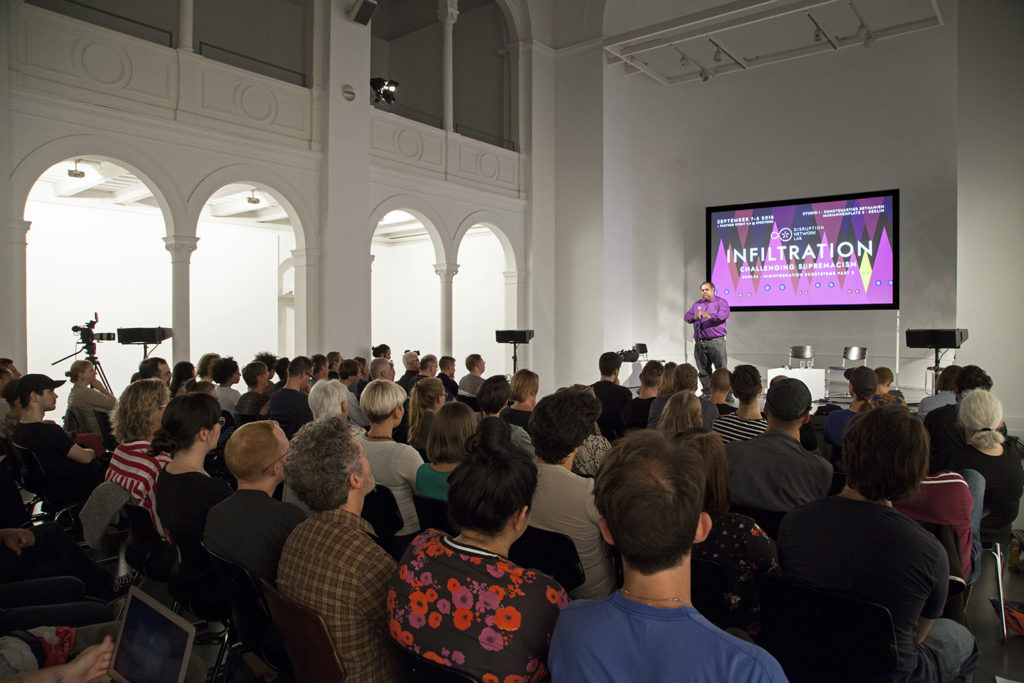
Davis´ activity can also be dangerous. In the past thirty years he has been attacked because of what he does. However, he is not afraid of the Klan or of racist groups. He has cultural tools to face dialectics, he has a strong identity and doesn´t want to fight against someone´s else idea of identity. On the contrary he is convinced that people of all backgrounds shall come together, getting along without losing their sense of identity or individualistic dimension, as no one shall be forced to accept an idea. Matt Ornstein has directed a documentary about Daryl Davis, that the Disruption Network Lab decided to screen during the third day of this 14th Conference. Entitled “Accidental Courtesy: Daryl Davis, Race and America.”
In Germany, individuals and organizations have been mobilizing to prevent the access of neo-Nazi to public platforms and media to spread Negationism and racist propaganda, in a collective lucid reasoning. Dialoguing with neo-Nazis, allowing them to exhibit symbols and to represent reactionary bigotry and hatred as something normal is not accepted by many people in Germany and the audience of the Conference showed reservations about Davis ‘words. Davis replied that his approach pays back. To those who tell him that he is giving racist and violent groups a platform to be normalized and to be part of the public discourse, he reminds them that most of those KKK-members that he approached decided afterwards to quit the group. It took him courage and dedication, he went to KKK-rallies, listened to their hymns, watched them set on fire giant wooden crosses during liturgical rites, witnessing moments of collective frenzy, delirium and hatred.
The documentary shows the efforts to dialogue with representatives from the movement Black Lives Matter too, that sadly ended up in a moment of misunderstanding and dramatic confrontation. Davis and Black Lives Matter have met again and have found a way to work together, going the same way approaching the issue of racism and discrimination with two alternative techniques, that are not mutually exclusive. However, Davis approach is markedly distant from this grassroots movement that organizes demonstrations and protests.
The audience of the 14th DNL Conference challenged Daryl Davis as his approach “we are all human beings” looks fragile in days of uncertainties, when extreme right movements are gaining consensus upon lies and discrimination. Inevitably, the debate after Davis ‘speech focused on the cultural shift represented by Donald Trump´s election and what came after that on a global scale. Davis said that in his opinion what is happening works as a bucket of cold water, that wakes people up and makes them engage and fight for change, reacting with indignation. Davis explained that in his opinion the #MeToo campaign came out as a positive consequence to Donald Trump´s election. “Obama was not elected by black people, who are all in all 12% of the US-population. Things change if we dialogue together, creating the bases for that change. In this way we can accomplish things that just few decades ago were thought to be unachievable.”
The panel of September the 7th represented a cross-section of the research being conducted by journalists, researchers and artists currently working on extreme-right movements and alt-right narrative. By accessing mainstream parties and connecting to moderate-leaning voters, right wing extremists have managed to exercise a significant influence on social and political discourse with an impact that is increasingly visible in Europe. The speakers on this first day of the Conference reported about their experiences with a focus on what is happening in their countries of origin: Sweden, Germany and Slovenia. Interconnecting three methodologies of provoking critical reflection within right-wing political groups, the panel reflected on possible strategies of cultural and political change that go beyond mere opposition.
Recalling all this, the moderator Christina Lee, Head of Ambassador Program and Hostwriter, introduced Mattias Gardell, first panelist of the day, Swedish Professor of comparative religion at Uppsala University, who dedicated part of his studies to religious extremism and religious racism, addressing groups such as the Nation of Islam and its connections to the KKK and other American racist activists, to focus than on the rise of neo-Paganism and its meaning for the radical right. Among his publications, a book on his encounters with Petter Mangs, “the most effective and successful racist serial killer” Sweden has ever encountered, as he writes, and recent analyses of the “lonely wolf” tactic of militant action and groups from the extreme right and the radical Islamism, that are operating under the radar, to avoid being detected and blocked by authorities.
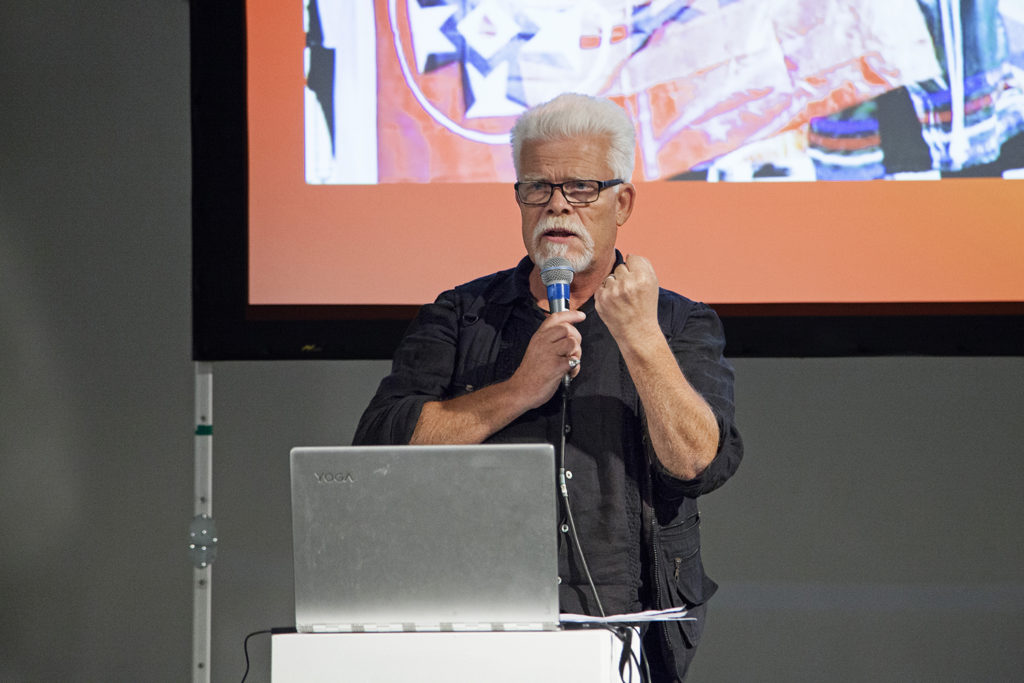
At the time of the Conference, parliamentary elections were about to take place in Sweden. The country was then set for political uncertainty after a tight vote where the far right and other small parties made gains at the expense of traditional big parties. Gardell reported that in Sweden the political and social climate of intolerance has risen. More than half of the mosques have been assaulted or set on fire and minorities are continuously under threat. During his speech he focused on how new radical nationalist parties and movements are investing in narratives built on positive images of love and community, nostalgic sentiments and promises to return the once good society and its original harmony. They are nationalist and ‘identitarian’ groups (as they call themselves), from different nations and united under their belief in separation on the base of national identities. They often portray themselves as common citizens, worried about the vanishing of their country and identity due to a program of multicultural globalism that aims at substituting national identities and people by means of a white genocide: a constant sense of paranoia, that Gardell also perceives in a country like Sweden, where the economy is flourishing, and inequalities hit mostly migrants and non-white population.
These groups work to spread the idea of a “white nostalgia”, a rhetorical discourse based on their efforts to reiterate a rosy, but hazy period, when life was better for the white native population of a certain territory. They ambiguously evoke a moment in history, that has probably never existed, at which national identities were free from external contaminations and people were wealthy sovereign citizens. This propaganda emerges into a multi-faced production in music, film and visual arts. It is not the “angry white men” image alone that can contain such a new fragmented and liquid reality; in fact, explained Gardell, the opposite is true. They often offer a narrative, that appears to be built on love rather than on hate. Love for their nation, love for their hypothetical race, for their selected groups and communities. It is not an imaginary love, it is a deep true feeling that they feel and upon which they construct their sense of collectivity.
Gardell underlined the importance of studying every-day-Fascism, focusing on its essence made up of ordinary individuals that like football, accompany children to school, listen to music and therefore have things in common with their neighbors and colleagues to whom they might appear as moderate people. “You can’t defeat national socialism with garlic. You have to face the fact that Fascism has been supported by millions of ordinary people who considered themselves to be good and decent citizens” he said. It is necessary to unveil the false representation of a political view, evoked through posters of blonde children and pictures of smiling women, that are designed to embody a bright future and a safe homeland. It is necessary to oppose the program of selective love and restricted solidarity that extreme right and nationalist groups promote. Therefore, says Gardell, we need to challenge those representations of love for nation, homeland and family built on a language that is impressive-sounding but not meaningful or sincere at all. And not just because “white nostalgia” is a fictional invention, but – more important – because on the collective and public sphere, love and solidarity are meaningful only if they are universal and express the value of equality unless they are just synonyms for privilege from which just few people can benefit.
At the moment, ultra-nationalist and radical right parties assembling the new political scene, appear to be able to influence traditional parties and vast parts of the population using love as a political weapon, affecting the social and political landscape in many countries, succeeding in making those traditional parties copy their agenda. Their recurrent themes exploit desire for individual social retribution, the tradition of a misogynic masculinity, the enhancement of self-government tendencies and isolation in opposition to openness and solidarity. A rhetoric that exploits the presence of nonwhite minorities and economic instability of this late capitalism, creating hateful propaganda. An intense online activity of manipulation supports the point of view of these ultra-nationalists. As the DNL Conference “Hate News” (May 2018) showed, online facts can become irrelevant against a torrent of abuse, memes and hate.
Online and offline, right extremists can easily find supporters in isolated realities, in the countryside or in close web-communities. Consequently, it is important to act locally and be focused, disrupting their ability to contaminate small groups. Young people are still intrigued by the gruesome and brutal part of the black metal scene, by the fringes of anarcho-fascists and by hooligans, feeding into an international network of neo-Nazi black labels and groups. But there are now also presentable faces, new political formations with attractive slogans supported by glossy music bands and influencers that are building a narrative of love. Mattias Gardell concluded his intervention saying that these groups are currently on the rise throughout Europe, whilst a storm of Fascism is coming again, widely, to hurt exposed individuals and communities, as it is already doing. He is disillusioned and reminded the audience of the Disruption Network Lab that it is necessary to focus and act to defeat it, knowing that it will cause blood.
The analyses of Mattias Gardell introduced topics covered by the second panelist of the day Richard Gebhardt, political scientist and journalist, who gave an insight into Hooliganism based on his direct researches from the last four years in Germany and England, where the Football Lad’s Alliance established itself as a complex reality. He focused on the reasons that pushed this violent collective to become a political movement, connected in Germany to the foundation of Pegida (Patriotic Europeans Against the Islamisation of the West), and the increasing popularity of the parliamentary party AfD (Alternative for Germany), which is today – according to opinion polls and surveys – the second biggest political formation in Germany.
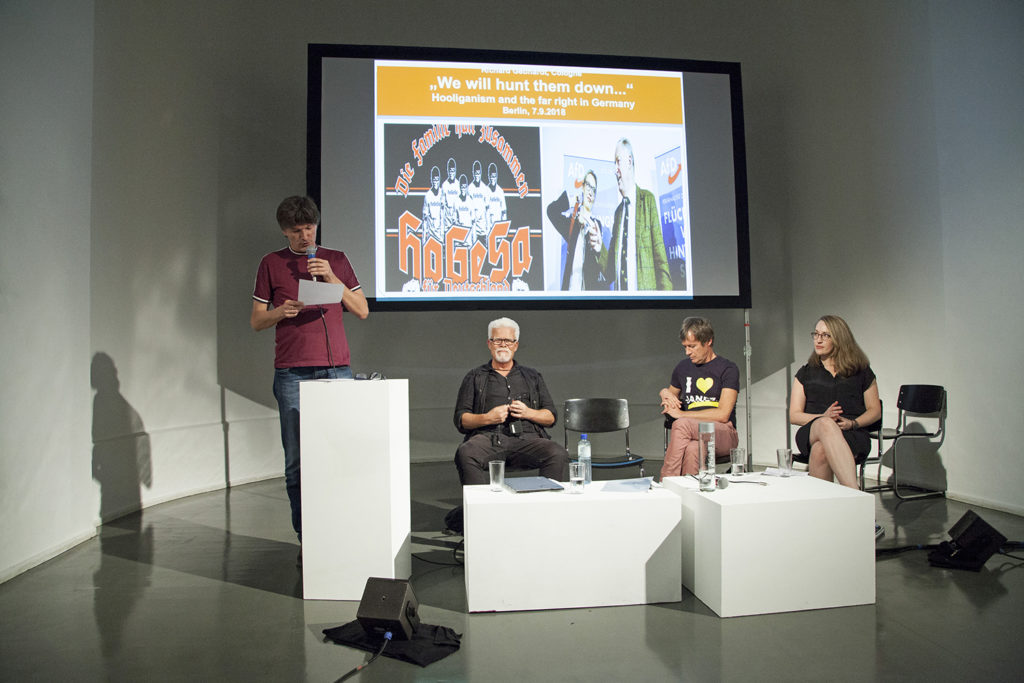
Gebhardt’s intervention began indeed with a quotation by the leader of the alt-right party Alternative for Germany: “We will hunt them down.” The parliament member was suggesting that the new members of parliament from his political formation would use their new powers to hold Angela Merkel’s government to account for its refugee policies “to reclaim their country and people.”
At the time of the Conference only a few days had passed since right-wing extremist thugs and neo-Nazis organized an assault on foreigners in the German city of Chemnitz on the 26th and 27th of August, in reaction to a murder that happened a few days before. It was a shocking moment for many Germans. However, in the following days politicians and members of the German government have tried to downplay the events, showing that big moderate parties tend to favor a certain kind of narration. Far-right violence in Germany has indeed seen a sharp rise in the last period. In this context the guest talked about the group “Hooligans gegen Salafisten” also known as HoGeSa (Hooligans against Salafists) and its origins.
On October 26, 2014, in Cologne the HoGeSa organized its first rally against Salafism. The number of participants can be ultimately estimated around 4.000 people, violent hooligans, who threw stones, bottles and firecrackers. They gathered in Cologne Central Station, with several speakers and live music, and to later march through the streets of Cologne. Xenophobic and neo-Nazi slogans were frequent, and so was the Hitler salute. During the riots dozens of police officers were injured and several police cars were damaged. Police were surprised by the inclination to excessive and unpredictable use of force. In that year thousands of refugees were traveling to Germany from conflict-ridden Middle Eastern countries and the HoGeSa was already targeting them.
In the days immediately after the demonstration, leading German politicians and prominent jurists sought to give a lighter representation of the events. The first official comments to the HoGeSa demonstration were not referring to it as a neo-Nazi demonstration, stressing the fact that hooligans are “for the most part politically indifferent” and that “they are not political but antisocial. They meet just to fight and drink.” The motto “Fußball ist Fußball und Politik bleibt Politik“ (football is football, politics stays politics) was repeated often but did not sound convincing at all. The Hooligans gegen Salafisten represented undeniably a new network of neo-Nazis, that had joined forces with football hooligans, nationalists and other right-wing extremists. Thousands of football supporters appeared to have left their football clubs of choice behind in favor of uniting against a common enemy: Islam. They chose their name HoGeSa hoping to receive popular support by recalling the fight against Islamist extremists.
Nonetheless, not every hooligan is a neo-Nazi. Press reported that in Hannover, for example, hooligans and ultras distanced themselves from the demonstration of HoGeSa and non-fascist football Ultras and that groups in Aachen, Dortmund, Duisburg, Braunschweig and Düsseldorf say they have been threatened, chased down and beaten by these Nazi-hooligans. Gebhardt suggested to the audience of the Conference a book, “Among the Thugs” by Bill Buford, to better understand the dynamics behind hooliganism. The book follows the adventures of Bill, an American writer in England, as he explores the world of soccer hooligans and “the lads”. Setting himself the task of defining why young men in England riot and pillage in the name of sports fandom, Bill travels deep into a culture of violence both horrific and hilarious.
Gebhardt portrayed these extreme right-wing rioters from HoGeSa as men, claiming to be equally distant from conservative and progressive parties, who want to be seen just as football supporters that are not carrying any ideological content, neither that of the Left nor of the Right. However, the nonpolitical hooligan is a myth: they are the heirs of a fascist tradition based on prevarication, arrogance and violence, that plays with the aestheticization of fighting and war, the glorification of militarism and pseudo-heroism. They are not worried citizens, they are thugs “ready for a civil war.” They claim to speak for the silent majority of their community, defending their country and their people. The work of Gebhardt can be seen in a documentary “Inside HoGeSa” (2018) and in his articles online.
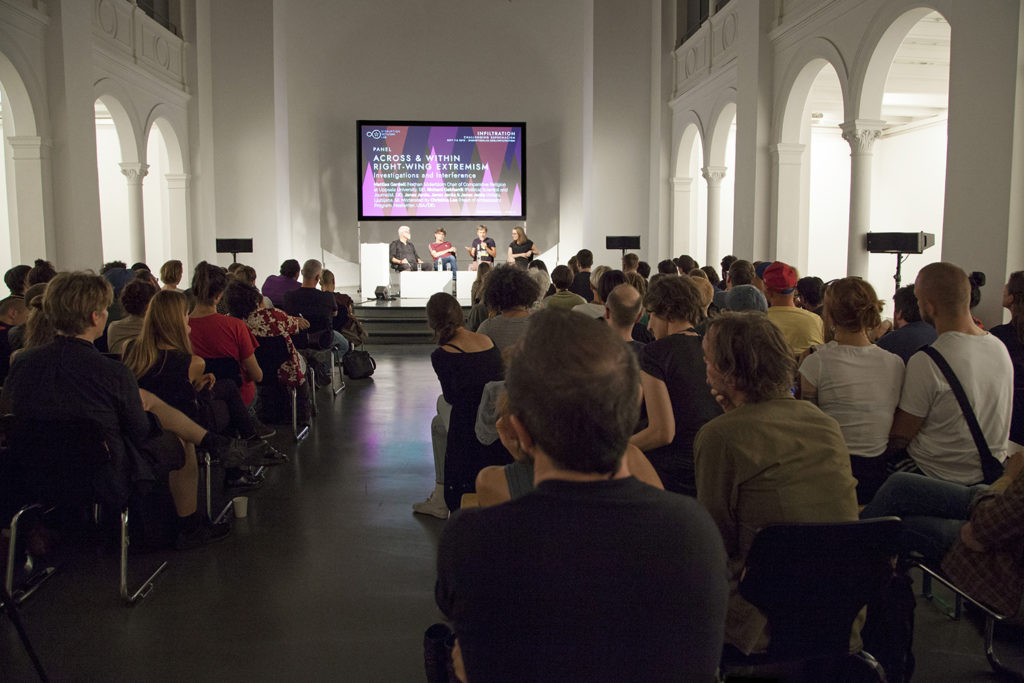
The last guest of Friday’s Conference was a member of the project ”Janez Janša, Janez Janša and Janez Janša,” who run for office in Slovenia at the last 2018 elections, confronting the leader of the conservative Slovenian Democratic Party (SDS), and former Prime Minister, Janez Janša. “Old names, new faces” was their motto.
In 2007 three artists decided to legally change their name to Janez Janša and joined the right conservative Slovenian Democratic Party (SDS, which was originally a moderate political formation). Janez Janša is also the name of the former President of Slovenia. All of a sudden, there were at least four Janez Janšas in the country: the three artists and the politician famous for his aggressiveness and contentiousness with the opposition and anyone who dares to criticize his choices. At the time President Janša made a public statement about the artists and pro-government media started to comment on their name change criticising their “politicized art”. The activity inside the SDS of the artists served to explore the bureaucratic and political systems of their home country. Their work of investigation is instead much more complex. It reveals how the perceptual influence of a name can interfere with social dynamics. Both on a collective and subjective dimension, they researched the meaning of identity and sectioned how their private life was affected by such name change. They proved that names are just a convention, an instrument, but with a relevant role. Janša remembered as an example that the Slovenian Democratic Party, despite this name, turned into a radical, right and conservative party between 2000 and 2005. Nowadays it is engaged in anti-migrant rhetoric and populist right-wing propaganda.
The artist illustrated how, in the last decade, the Janšas responded with art, cleverness and culture to campaigns of hate and propaganda, an approach that is the base for their political interventions. Their experience was the subject of the documentary from 2012, “My Name Is Janez Janša” and is internationally known. Artists and academics are still pondering about the meaning of the Janez Janšas experience, political critique, art work, activism, provocation or never-ending joke.
During the conclusive debate all panellists agreed that the world they have been in touch with and that they described in the Conference is mostly a world of men. Women are generally present as an accompaniment and/or an accessory. It is certainly a characteristic of Fascism, described in literature and art, as designated in the book “Male Fantasy” by Klaus Theweleit, where the author talks about the fantasies that preoccupied a group of men who played a crucial role in the rise of Nazism. Proto-fascists seeking out and reconstructing their images of women. Another aspect that all three guests agreed on, is the fact that individuals are massively not voting or taking part in public life, since they are increasingly distrustful of traditional media and politicians. European moderate politicians have on the other side the responsibility of a systematic dismantlement of social rights, they justified and supported an unequal economic system of wealth distribution for too many years. Now, scandals and arrogance in public and institutional life do not seem to affect the popularity of extreme right parties, that are ridiculing the excess of fair play and the interests of those moderate politicians.
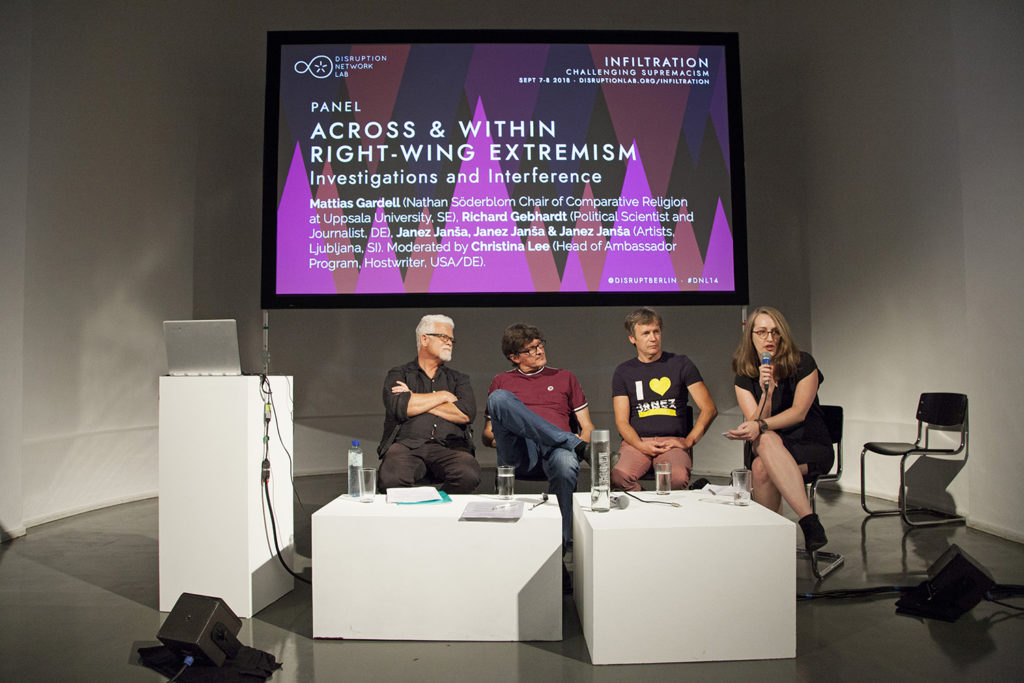
Focusing on new strategies to directly provoke change, the Conference on the 8th of September began with a performative conversation between Stewart Home (artist, filmmaker, writer, and activist from London), and Florian Cramer, (reader in 21st Century Visual Culture at Willem de Kooning Academy in Rotterdam), moderated by Tatiana Bazzichelli, artistic director of the Disruption Network Lab. The universe of the extreme-right seems to have embraced a path of transgression, arrogance and nonconformity, employed to suggest that its members are holders of a new alternative approach in cultural, political and social criticism. What comes out from such a wave of counterculture is an articulated patchwork that flirts with violence, discrimination and authoritarism.
Bazzichelli asked the audience to question the nowadays extreme right self-definition of their political offer as an “alternative,” considering that the issue of transgression and counterculture has been widely developed by academic and artistic Left, and that experimentation, theorisation and political antagonism have been growing together in the left-leaning universe. In such a perspective, “working on something alternative” – explained Bazzichelli – is supposed to be synonymous with creating a strong criticism of media and society, through political engagement, art and intellectual efforts. An alternative that could enhance a positive, constructive contribution in the collective socio-economic discourse. Today, words like “infowar” and “alternative” tend instead to be associated with a far-right countercultural chaotic production. On this basis, Bazzichelli introduced the lecture by Stewart Home and Florian Cramer, that investigated if and to which extent it is possible to affirm that ideas and values driven from the Left are now reclaimed and distorted in an extreme-right alternative narrative.
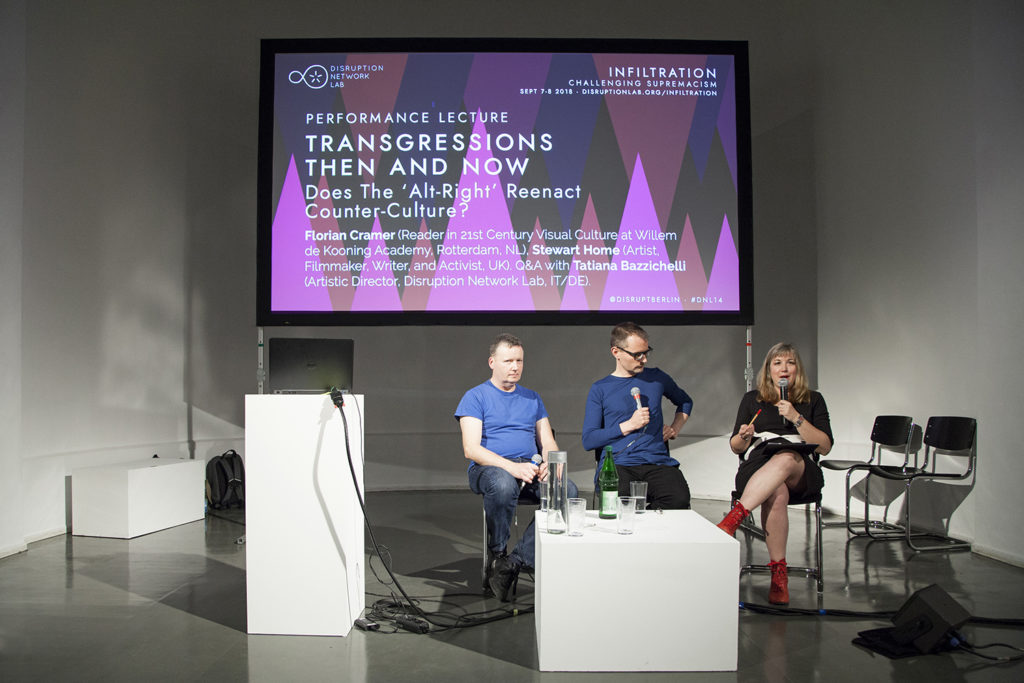
In an historical excursus on art, literature and subcultures, the two speakers focused on the 1970s-1990s counter-cultural currents that used radical performance, viral communication and media hoaxes and examined the degree to which they may be seen as playbooks for the info warfare of the contemporary extreme right. With their presentation they suggested that it is improper to state that the alt-right has now occupied established leftist countercultural territories. There have been several examples of a parallel development and interpenetration of very opposite points of view over time. Tommaso Marinetti, father of Futurism and its Manifesto about “War, the World’s Only Hygiene,” mixing anarchist rebellion and violent reaction became then a fervent supporter of the Italian Fascism, that glorified the new futuristic approach. However, Futurism means also sound poetry, since discordant sound had a vital role in Futurist art and politics; an experience that developed into the noise movement with an influence that reached post-industrial musicians and further.
Cramer remembered that Futurism represents also an avant-garde and counterculture from the 1900s, that had similarities with Dadaism. In fact, though Dadaism was anti-war and antibourgeois, they shared a spirit of mockery and provocative performances, mixing distant genres and a massive use of communication, experimental media and magazines. Always considering the beginning of the 20th Century, the lecturers recalled the production of the painter Hugo Höppener Fidus, expression of the Life Reform Movement, linked both to the left- and the right-leaning political views, that strongly influenced Hitler and Nazism, showing roots of an alternative counterculture that went both into the political extreme right and left.
In the 1970s and 1980s, in subcultural production and artistic performances it was frequent the use of fascist symbols as provocation and transgression, for example in the punk scene, which ranged notoriously from left wing to right wing views as pseudo-fascist camp in post-punk culture turn into actual Fascism. A conscious ambiguity, part of experimentation, that – particularly in the U.S. – meant also leaving space to things that were in contrast to each other. In the context of US underground culture, the speakers mentioned publications like those from Re/Search “Pranks!” on the subject of pranks, obscure music and films, industrial culture, and many other experimental topics. Pranks were intended as a way of visionary media manipulation and reality hacking. Among the contributors, you could find artists from the industrial movement, like the controversial Peter Sotos and Boyde Rice, who became today established part of right-winged countercultural movement.
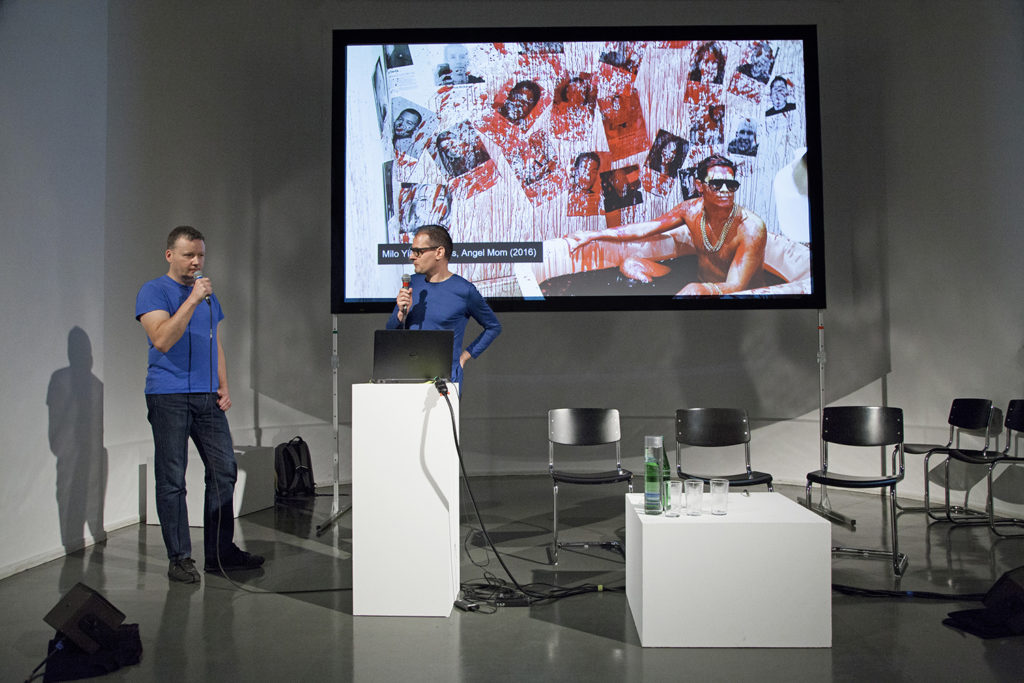
Talking about the present, Cramer and Home also mentioned Casa Pound, a neofascist-squat and political formation from Rome, that adopted the experience described by the anarchist writer Hakim Bey of the “temporary autonomous zones,” that redefined the psychogeographical nooks of autonomy – as well as appropriated the name of Ezra Pound, a member of the early modernist poetry movement.
All this suggests that the so-called alt-right has probably not hijacked counterculture, by for example deploying tactics of subversive humour and transgression or through cultural appropriation, since there is a whole history of grey zones and presence of both extreme right and left in avant-garde and in countercultures, and there were overlooked fascist undertones in the various libertarian ideologies that flourished in the underground. Home and Cramer reminded their common experience in the Luther Blissett project, based on a collective pseudonym used by several artists, performers, activists and squatter collectives in the nineties. The possibility to perform anonymously under a pseudonym gave birth to a mixed production, with undefined borders, in few cases expression of reactionary drives. An experience that we can easily reconnect to the development of 4chan, the English-language imageboard very important for the early stage of Anonymous, that today is very popular among the members of the Alt–Right scene,
Cramer illustrated so how Libertarianism can sometimes flip into a reactionary ideology. The same can be for Anarchism (with the Anarcho-Capitalism) and Cyberlibertarianism, just like for the subcultures. In the Chaos Computer Club – explained Cramer – there is a strong cyberlibertarian component, but we might find also grey zones where a minority of extreme-right can find ways to express itself. Spores of extreme-right and fascist-anarchical degeneration can so be found in the activities of political and art collectives from the Left and, in this sense, it looks necessary to expose their presence in relation to those grey areas, that could become a context for spreading ambiguous points of view within cultural production.
Marinetti, Pound, Heidegger, have a general relevance that cannot be denied. Home and Cramer underlined that, at the moment, nothing of what we see internationally in the extreme-right panorama can be considered culturally relevant. The alt-right is not re-enacting counterculture. This “alternative” of the extreme right consist mostly of a cluster of media outlets producing hate and propaganda, within a revisionist narrative. It picks up an old rhetoric about heroic rebellion, arrogance, overbearing masculinity, mythization of war and the use of violence, in most cases using new definitions for old concepts. Home and Cramer concluded that there is no intrinsic value in being transgressive, and transgression alone cannot be enough to gain any kind of attribute of quality. Because transgression is just a tool. Artists and activists cannot stop experimenting and using the tool of transgression to criticise society, building alternatives and being alternative. The moderate approach in an era of political correctness is a way to enchain the Left; moreover people have the right to hate their condition, hate their job and the inequalities that affect their lives. This feeling is legitimately generated by a critical thinking.
The panel of the second day of the conference reflected on the practice of political, journalistic and activist infiltration as a way of better understanding extremist groups. The moderator explained how from one side infiltration maps extremist groups from the inside, and from the other, it analyses how extremist groups are building their networks, becoming widespread in online and offline. The aim is to explore such groups from within, analysing the reason for people to join them, as well as understanding their inner dynamics.
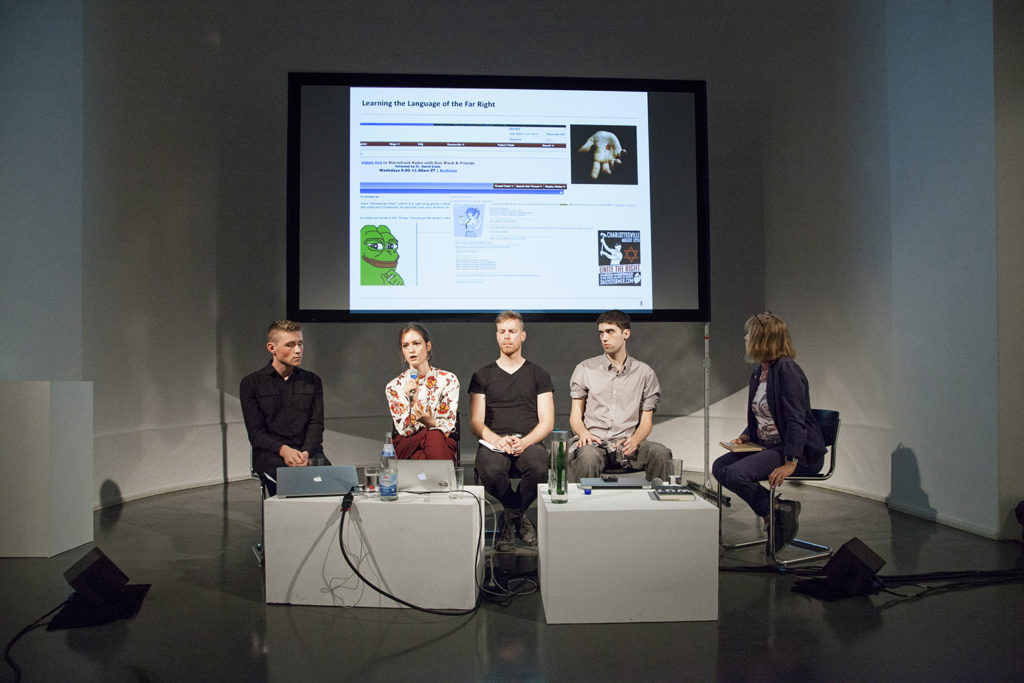
Rebecca Pates, Political Anthropologist from the University of Leipzig, moderated the discussion and introduced the four guests, commenting that a number of different things can be done when infiltrating. The activities and the achievements can differ, and so the technique, from total concealment in infiltration to openness about it. Pates suggested that from the inside it is possible to understand for example the reason why young people are attracted by groups that from the outside look so angry and violent, and it could be defined the sense of comradeship and belonging that convinces individuals to participate into these movements.
Julia Ebner is a Research Fellow at the Institute for Strategic Dialogue (ISD) and author of the bestselling book The Rage: The Vicious Circle of Islamist and Far-Right Extremism. She opened the panel explaining how, after the terroristic attacks from right extremists in Europe and in the US, she decided to get a better understanding of the world of the far-right and their narrative. She infiltrated both online and offline, undercover, with fake identities and avatar accounts, changing her appearance. Her goal was to get into groups that are very different ideologically one from the other, like the neo-Nazi, the old conservative fascist movements and the counter Jihad movement. During her speech she described how she built up a new identity and made connections necessary to her purpose.
To get in touch with active members she used some social media and crowdsourcing platforms available for the extreme-right, such as “Gab”, the alt-right equivalent of twitter, “Wasp love”, a place to date “reformed Christians, confederate, home-schooled, white nationalists, alt-right and sovereign singles.” She was asked to send a full account of her genetic ancestry to be accepted or to share a picture of her skin colour. She had voice chat interviews to enquire about her ideological background or sexual orientation. Ebner entered an alternative universe of disinformation ecosystems and accessed subcultures that interact in parallel as a part of a same bigger network. When she was asked to justify fresh profiles, that she just created, she could benefit from the fact that many far-right users are removed and banned for what they post. She started frequenting all the different tech platforms considered a safe environment for far-right extremism, where they could very openly cultivate antisemitic and conspiracy theories, anti-left rhetoric, coordinate doxing and harassment activities. In 2016 the writer and researcher joined undercover the English Defence League and went to a rally of theirs against what they would call Muslim grooming gangs. A year later she was then recruited into the movement Generation Identity or Identitäre Bewegung, always as part of the new European alt-right (alternative right) and was invited to join them in public and private meetings, like a secret meeting in an Airbnb location in Brixton. In that occasion she was sitting among 20 white nationalists discussing their strategies to launch a British branch of their group, with a manifest focus on optics and media strategy briefings, to learn how to deal with tough questions from journalists about anti-Semitism and racism. They discussed about their political background and their selection procedures in order to achieve a good branding and quality in their membership. The obsession of appearing as decent citizens in public was and is very important in rallies like Charleville. Reports attest indeed that far right groups were concerned about how to dress and even told some people, not particularly good looking, that they could not join the event as they would not make a good impression. Events like Chemnitz, Charlottesville’s “rally to unite the right” or the experience of Defend Europe – an illegal far right ship that sought to hamper the rescue of refugees in the Mediterranean in 2016 – represent a cross-border collaboration between movements that until few years ago were not communicating. These events bring them together on the basis of their lowest common denominator for the sake of having a bigger impact.
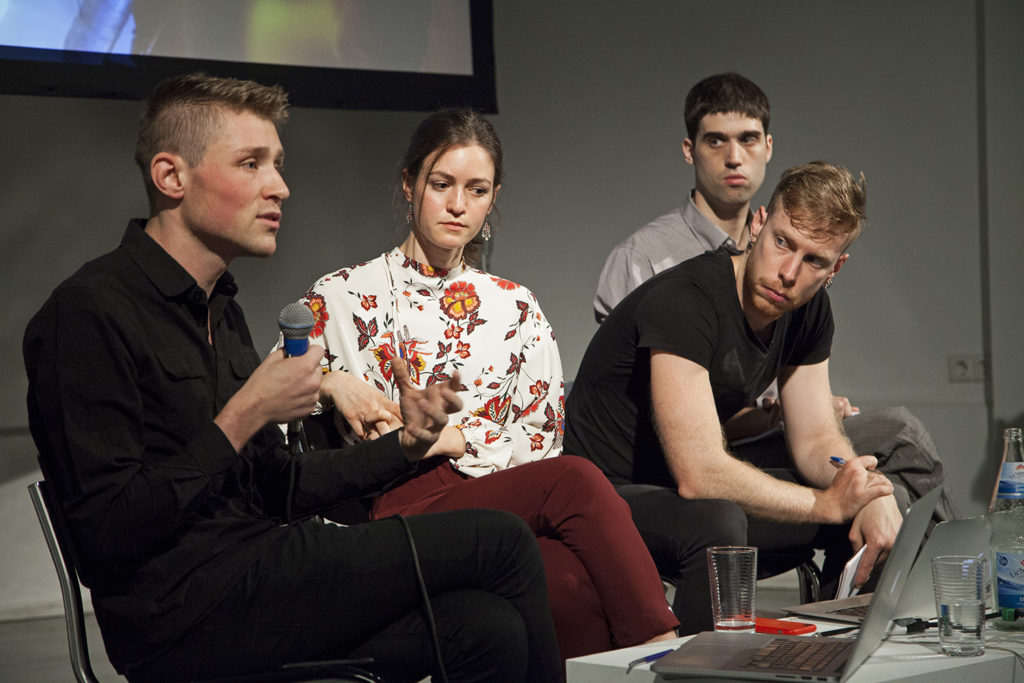
After Ebner wrote an article for the Guardian and for the Independent she got backlash from the far-right and the English Defence League. Its founder, Tommy Robinson, ended up storming into her office with a cameraman, filming the whole confrontation and live streaming it to Rebel Media, a far-right news outlet in Canada. The influencer has 300.000 followers and these channels are very popular too. They gave immediate resonance to the aggression and set off a long chain reaction among other far-right and alt-right news platforms, globally. Her whole life got under attention, they used all available data to publicly discredit her. The researcher realised how much it is possible to do with online data to intimidate political opponents or people who criticize. Ebner and her colleagues experienced the hate campaign machine. She noticed that women are more attacked and threats, symptom of the wide anti-feminist and mesogenic culture. It seemed to her that the whole universe was against her activity of infiltration and that she had no supporters. Many different groups and networks were creating a distorted representation of her engagement, and this pushed her to embark on a research project about the interconnectedness of the variegated far-right media galaxy.
With other colleagues Ebner analysed about 5.000 pieces of content, accomplishing a lot of linguistic analysis, and studying interactions with social media monitoring tools. Thanks to this work the researcher can describe the mainstreaming strategies of the extreme right and how its members try to create compelling and persuasive countercultural campaigns using humour, satire and transgression and co-opting Pop Culture. An attitude common with the fundamental Islamism is they are creating content that has appeal on young people on the Internet but they are also concentrated on the traditional media, to make sure that they pick up on their provocations or fake news. They trigger media to report on them by staging online complaints that would go viral. Ebner has also started a project in collaboration with the organisation #ichbinhier e.V., discovering that this technique of coordinated interactions often creates the illusion that they represent the majority of the users. The research shows something different: 50% of the interactions or of the hateful comments below news articles, that they analysed, came from just 5% of all active accounts. A small but very loud minority of people that is now dominating the whole discourse amplified by bots or a media outlet sometimes also Russian ones, staging online psychological operations, jokes and meme to hide extreme right hatred campaigns behind humour-images.
Memetic warfare and gamification are two very relevant aspects, as frequent as quotations from the movies Matrix and Fight Club, with the rhetoric of the red pilling to see the truth. Most of the accounts active in this activity were coordinating posts and hashtags so that their content could get prioritised in the feeds and create viral campaigns, striving to dominate the whole social media discourse. They have very clear hierarchies, which could be ascribed to the gaming dimension too. Hateful comments and negative interactions appear in a flow, getting soon in the top section due to a high degree of coordination. Generation Identity is known for sharing content according to the tactics of the so-called media guerrilla warfare manual, based on a very militarised language, that describes actions, goals and sniper-missions to target and intimidate political opponents exploiting media. All comes in a very gamified way, as they talk about a virtual battlefield and electronic items, where a good performance allows to grow of level. During the German elections in 2017 members and followers of Reconquista Germanica (an extreme-right channel running on the Discord platform) were quite successful in spreading extreme-right topics and making politicians and media pick up on them. Some of their hashtags were often listed in the top 5 trends in the two weeks before the vote. In the meantime, they were evaluating and analysing their activity, celebrating successful “generals” or “soldiers” that were promoted into higher levels. Ebner expressed her concerns as this reflects in in real-world practice what they would do if they manage to establish their own vision and get in power. Since Trump was elected we’ve seen a growing ecosystem that repeats itself, where extreme-right is certainly reappearing. It is indeed possible to spot similar tactics and vocabulary among several European far-right groups, in the campaigns of Italian, German, French, Swedish and Dutch elections. She underlined how important it is to understand far-right extremism better and the relationship between Islamist and far-right extremism, as they have a lot in common and are reinforcing each other.
Anti-racist activist and “Hope Not Hate” researcher Patrik Hermansson reflected on the meaning of radical right-wing practices today bringing his direct story as undercover activist inside the international Alt-Right, and published in The International Alternative Right Report. Starting in the fall of 2016 he joined a London based organisation and then travelled through many other related groups, living a dual life. He described his year of infiltration inside an international secret formation called London Forum, for which you need to be vetted, background checked and have someone who lets you in. Hermansson works as a researcher for Hope Not Hate, an organisation established to offer a more positive and engaged way of doing anti-Fascism. This 26-year-old man has been “Erik”, a fascist who came to London inspired by Brexit and to get away from the liberal prejudice of Swedish universities. He entered and investigated the Forum, discovered members, techniques and goals, until he witnessed the terrible violence in Charlottesville, Virginia. To do so, Hermansson had to become a Swedish teacher of a member and was quickly driven into the world of the extreme right. From former Tory Party members to famous alt-right influencers, he met people in different countries and different social context. It was a safe space of anonymity, that you do not find on Social media.
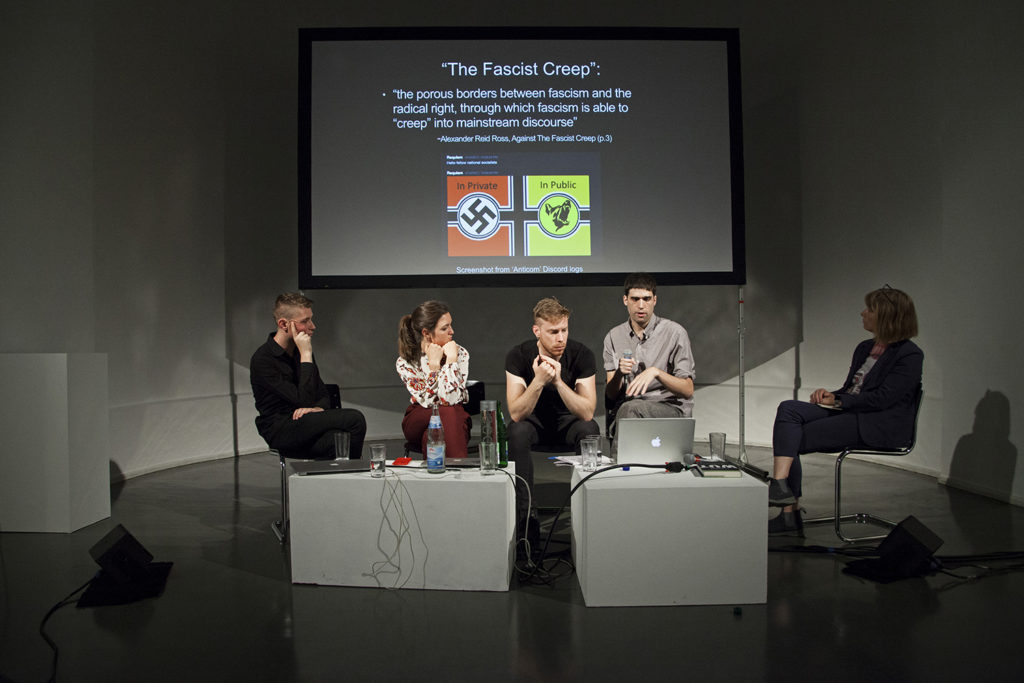
Hermansson described to the audience of the Conference the social aspects animating the group, where members can feel part of a community, make new friends even overcoming political differences until they have anything else outside. Conspiracy theories have a relevant role too. Holocaust denial, addressed as “the biggest PR event in history”, or the chemistry rails, are important part of their theorization. They feel part of a group that is bound together by secrets that allow you to see behind the curtain and make you understand more than the rest of the population. Hermansson pointed out that the activity of infiltrate is a difficult and immoral business. It exploits people’s trust. It is justified by the need to expose techniques of recruitment, data, but we should not romanticize, not to go too far not to be ruthless. Hermansson infiltrated for a purpose, to get a closer image of right extremism and decided to expose the top players of the organisation, musicians and influencers. The most effective part of the activity, he said, was the sabotage. Infiltration makes people point fingers, paranoia spread in the movement and things broke apart. Hermansson explained that it was a conscious decision: the anti-fascist part of the research. The London Forum is not active anymore, people left it showing that the method of exposure is quite effective. He found out that his activity raised the cost of their recruiting process, which is now much tighter.
The panel was concluded by a member of the Unicorn Riot collective, “a decentralized non-profit media organization of artists and journalists, dictated to exposing root causes of dynamic social and environmental issues through amplifying stories and exploring sustainable alternatives in the globalized world.” The investigative journalist Christopher Schiano presented his work of analysing and publishing of leaked messages from white supremacist, neo-Nazi and various alt-right fascist groups in the US – followed by an introduction of the DiscordLeaks platform by the developer Heartsucker, who is working as an affiliated volunteer for the Unicorn Riot. The guests talked about how Unicorn Riot has obtained hundreds of thousands of messages from white supremacist and neo-Nazi Discord chat servers after the events in Charlottesville, and decided to organise and open a far-right activity centre to allow public scrutiny through data journalism.
Discord is a voice-over-Internet Protocol (VoIP) application for video gaming communities, offering text, image, video and audio communication between users in a chat channel. The US non-profit media organisation with its Discord Leaks has exposed hundreds of thousands of chats from alt-right and far-right servers received. Parker was receiving screenshots of real-time communications between alt-right activists involved in planning the Charlottesville rally and got a “general orders” document, along with audio recordings of a planning meeting ahead of the rally. The screenshots kept then coming throughout the following days.
As reported by the Washington Post, Discord allowed the organizers and participants of the rally to convene in private, invite-only threads shrouded in anonymity – with usernames such as “kristall.night” and “WhiteTrash.” On a Discord server called “Charlottesville 2.0,” they planned everything from car pools, dress code and lodging in Charlottesville to how one might improvise weapons in case of a fight. Some suggested using flag poles as a makeshift spear or club. Many of these things took place. The collective received also internal logs, which enabled them to better see the scope of plans for the Unite the Right rally. Since its founding, Unicorn Riot has gained relevance among people looking for alternative news sources, principally covering protests with an on-the-ground perspective that many mainstream outlets miss. Unicorn Riot was for example among the first media outlets to get to the rally in Charlottesville and cover it. Through their investigation they explained how the far right tries to recruit new member via Discord, or they unveiled the attempts of extremists to look like ordinary Trump’ supporters, building a victim narrative to insinuate the idea that they are targeted citizens. Some of them are supporting the police and members of the police force have been exposed for leaking information to far-right members. They exposed the movement Anticom, anti-communist action, active mostly in shitposting, and the group Patriot Front, whose members unite under the motto “we are Americans and we are Fascists.”
At the end of the three the panellists reasoned on the importance of infiltration, as a means to study the extreme right and expose their networks and members, their strategies and tactics. It can also be helpful to try to predict what these groups are about to do, foreseeing their next step. It means getting in touch with them, entering their circles based on comradeship and exchange of personal experiences. Ebner commented that the use of lies and distortion is the cost of it, wondering, however, about what the cost of inaction is instead. Hermansson reported about the effects of infiltration in terms of the desensitisation he went through, taking part in conversations without reacting. The same desensitisation process can be described in the memetic warfare.
As part of the Disruption Network Lab thematic series “Misinformation Ecosystems” (2018), this 3-days-conference concluded the 2018 programme of the Disruption Network Lab. The series began with a focus on hate-news, manipulators, trolls and influencers, that investigated online opinion manipulation and strategic hate speech in the frame of a growing international misinformation ecosystem, and their impact on civil rights. HATE NEWS focused on the issue of opinion manipulation, from the interconnections of traditional and online media to behavioural profiling within the Cambridge Analytica debate. This second conference took the process further by pointing to specific researches and investigations that illustrated how a process has clearly set in motion, whereas radical right is currently working on an international level, building cross-national connections and establishing global cooperation.
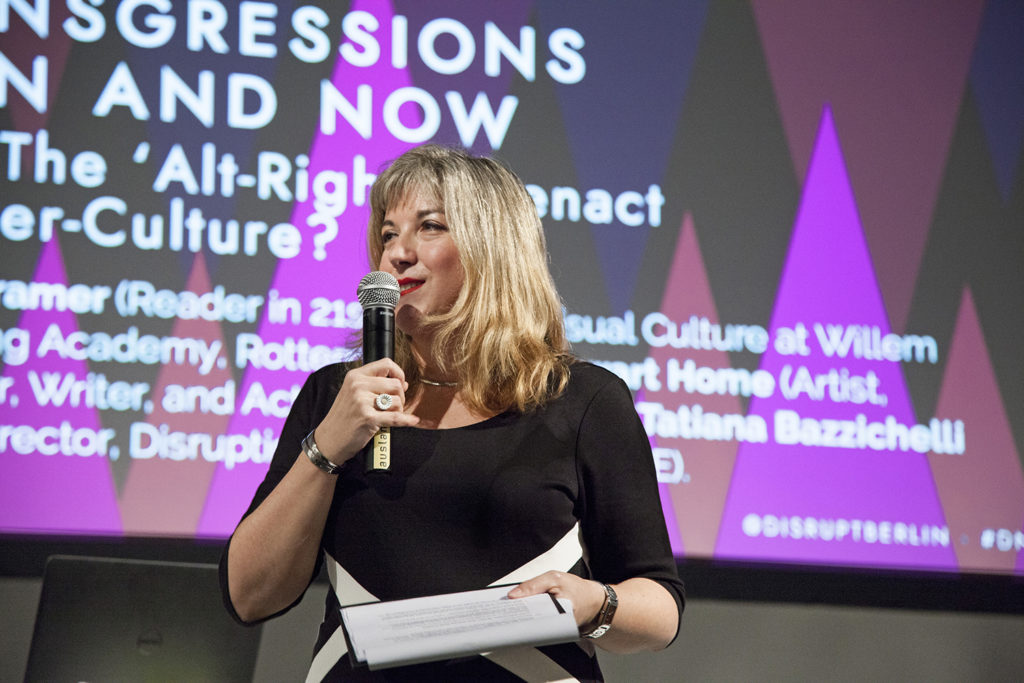
Not just Steve Bannon and a galaxy of media outlet and online platforms are pushing for a new authoritarian turnaround, based on discrimination and ultra-nationalism, having factual impact on political systems. On a grassroot level, there are local networks and formations able to unite different realities and backgrounds, melt together under new trendy labels, slogans and influencers. A new scene that is carefully designed to be appealing to moderate-leaning electorate, where you can find hooligans, hipsters, neo-Nazi and politicians dressed in suits and ties, all striving to appear like conscious citizens and decent members of society, part of a new generation of activists. However, beyond the facade, the majority of far-right groups shows to be against an open, multicultural society as well as against inter-religious and inter-cultural togetherness. They play with economic uncertainties, fear, anger and resentment to spread hate, attack opponents and discriminate minorities, often through a meme-driven alt-right humour, designed to cover with dark hilarity their racist propaganda and fascist drives. Jokes are used by public figures and influencers to promote misogyny, homophobia, a distorted idea of masculinity, racism and justify unacceptable statements. Too often mainstream media and newspapers pick up staged news from such misinformation ecosystems, enforcing a revisionist narrative built on manipulated facts and interactions, arrogance and violence.
Conspiratorial and paranoid thinking acts like a catalyst, provoking participation and fascinating individuals, who want to become warriors and custodians of knowledge. Alongside the image of the angry white man, there is a whole narrative of love and solidarity for their chosen group, the community they decide to protect, identified on utilitarian basis.
Despite of what is represented in media, many speakers at the conference pointed out that there is neither something alternative nor innovative in what they are offering. However, mainstream parties and media tend to follow their reactionary narrative, enforcing the idea that it is competitive. The guests of the Disruption Network Lab came from Africa, Europe, North and South America and exposed an intertwined scenario of transnationalism of the radical right. The direct engagement of activists, that decide to infiltrate, together with the work of researchers, journalists and artists, allowed for a clearer image of what is going on at a global as well as local scale, to understand how it is possible to interrupt this process working actively within the civil society. Sabotage and exposure are instruments useful to disrupt and unveil strategies aimed at sending the world back of a hundred years of human rights achievements. Thanks to Tatiana Bazzichelli and the Disruption Network Lab team, who offered a stage to learn about constructive practices that can be activated in order to change the course of things.
–
INFILTRATION: Challenging Supremacism
SEE VIDEO DOCUMENTATION OF THE CONFERENCE
SEE PHOTOS FROM THE CONFERENCE
What happens to the hole when the cheese is gone?
Bertolt Brecht
Transient Hole (Variations) is a hybrid curatorial project and symposium by Viennese artist and curator Alexander Felch. The project`s title refers to a concept for a media artwork, that cannot, properly speaking, be materialized for it deals with a moving void – a transient hole.
Across the floor of a white, three-dimensional room a little black hole is constantly and randomly moving. The hole is simultaneously there and not there. It is a portal to nowhere. But is it really? Might it not lead to transcendence, to another reality, or perhaps our reality can only be understood through this liminal presence of nothingness?
The participants are invited to provide their own interpretation for this problem and develop means to represent it, whether through art or science, to display processes that cannot be depicted in reality. The aim of the project is obviously not to find a solution to this existential paradox but to bring about a reflection on the topic from a myriad of disciplines and different perspectives, which explore the limits of representation. The various responses to the THR problematic will be gathered in a collected volume that is in itself a reflection on the boundary between art and science, reality and fantasy.
The project appears – just like the transient hole – in different cities popping up in various forms and is accompanied by lectures, talks and (sound-) performances.
Contributions by:
Atzgerei Productions, Arnold Berger, Ryan Mc Donagh, Sophie Dvorak, Alexander Felch / Aisek Ifraimov, Mariana Ferreira / Dayjon Edwards, Christoph Höschele, Hrvoje Hirsl, Harald Hund, Sandy Leong, Stefan Lutschinger, Nicholas Moloney, Anja Nowak, Jaysha Obispo, Shinji Toya, Jeroen van Amelsvoort, Anna Vasof, Stefan Voglsinger, Jan Vormann, Yilin Wang, David Wauters, Hui Ye.
Featuring concepts developed by students of Middlesex University London – BA Digital Media and BA Media and Cultural Studies
Monday 12 November – Friday 16 November 2018
Middlesex University
FREE
Saturday 17 November 2018, 11:00 – 16:00
Furtherfield Gallery
FREE
13:00
Opening
14:30
Introduction and Guided Tour
Alexander Felch “Transient Hole Research – Instationarity as an artistic concept / a scientific particularity”
Saturday 17 November 2018, 16:00 – 21:00
Furtherfield Commons
FREE
16:00
Limehouse Hole Atlas Datathon
Navino Evans and Sean McBride (http://histropedia.com/)
18:00
Sound Performances
Karl Salzmann (A) is a sound & visual artist, curator and researcher currently based in Vienna / Austria. Within process-oriented and experimental setups, he develops and presents works that study the materiality of sound and its social, cultural and metaphorical levels of meaning. His artistic activities mainly concern the interaction between sound and visual arts and often relate to works and topics of (sound) art history.
http://www.karlsalzmann.com/
T_A-Z (Paul Gründorfer) (A) is using process-related setups to explore sonic worlds and to realise site specific interventions, developing real time audio systems, that act autonomous or in reference to the spatial constellation. While considering the encounters between analog and digital, structured or improvised elements, he is focusing on the abstract occurrence of sound and its physical impact.
Electronic circuits are interconnected to cause semi-natural entities, autonomous organisms. Voice and articulation are generated through loops in feedback networks. Onomatopoeia.
His artistic activities examine variable connections between transmitter-receiver networks, which function as a conceptual framework for experimentation with sound and transmission of information.
http://tricx.net/
Monsterfrau Lena Wicke Aengenheyster (A/D) – MONSTERFRAU PJ (Performance Jockey) – Part III of the performance serial MONSTERFRAU The voices’ bodies: MONSTERFRAU triggers, mixes and morphes dance music rythms, samples and sounds with her movement. STAATSAFFAIRE: Production of and reflection through artistic projects in music and performance art. Beyond that it is the common optimisation of production environments and network.
http://www.staatsaffaire.com/
–
Visuals:
Simon Sarginson (live coding) (UK)
London edition curated by Alexander Felch + Stefan Lutschinger
Realised in cooperation with Cybersalon, Middlesex University London and the Austrian Cultural Forum London – with kind support by the Federal Chancellery Of Austria.
–
www.facebook.com/transienthole/
www.mdx.ac.uk
www.cybersalon.org
www.furtherfield.org
DOWNLOAD CURATORIAL STATEMENT
SEE IMAGES FROM THE PRIVATE VIEW
Feature image: Jeremy Hutchison, Movables, 2017. Photo courtesy of the artist.
We live in a time of stark and often violent paradoxes: the increasing liberalisation of social values in some parts of the world compared to increasing fundamentalism in others; the wealth of scientific discovery and technological advances in contrast to climate denialism, “post-factual” and conspiracy-driven politics; freedom of movement for goods and finance while individual movement is ever more constricted and subject to law; a drive towards agency, legibility and transparency of process while automation, computerisation and digitisation, render more of the world opaque and remote. At every level, mass movement of peoples and the rise of planetary-scale computation is changing the way we think and understand questions of geography, politics, and national identity.
These ever-increasing contradictions are seen most acutely at the border. Not merely the border between physical zones and between nation states, with their differing legal jurisdictions and requirements for entry and residency, but also the border between the physical and digital, when we apparently – but perhaps misleadingly and certainly temporarily – cross over into a different zone of possibility and expression.
This contradiction is also clear in the balkanisation of newly independent and fragmenting states, and in the rising current of nationalism across Europe, which seems to run in parallel to, and might even be accelerated by, digital connectivity. Some of the most outwardly regressive powers themselves employ what Kremlin theorist Vladislav Surkov has called “non-linear strategy”: a strategy of obfuscation and deliberate contradiction clearly indebted to the convolutions and confusions of the digital terrain – and of art. As ever more varied expressions of individual identity are encouraged, revealed, made possible and validated by online engagement, so at the same time a desperate rearguard action is being fought to codify and restrain those identities – online and off. These new emergent identities are, inevitably and by necessity, transient and contingent, slippery and subject to change and redefinition.
The artists featured in Transnationalisms address the effect of these pressures on our bodies, our environment, and our political practices. They register shifts in geography as disturbances in the blood and the electromagnetic spectrum. They draw new maps and propose new hybrid forms of expression and identity. In this exhibition Transnationalisms acknowledges and even celebrates the contradictions of the present moment, while insisting on the transformative possibilities of digital tools and networks on historical forms of nationalism, citizenship, and human rights. While the nation state is not about to disappear, it is already pierced and entangled with other, radically different forms. Alternative models and protocols of citizenship, identity, and nationhood are being prototyped and distributed online and through new technologies. Transnationalisms examines the ways in which these new forms are brought into the physical world and used to disrupt and enfold existing systems. It does not assume the passing of old regimes, but proclaims the inevitability of new ones, and strives to make them legible, comprehensible, and accessible.
Raphael Fabre CNI, 2017
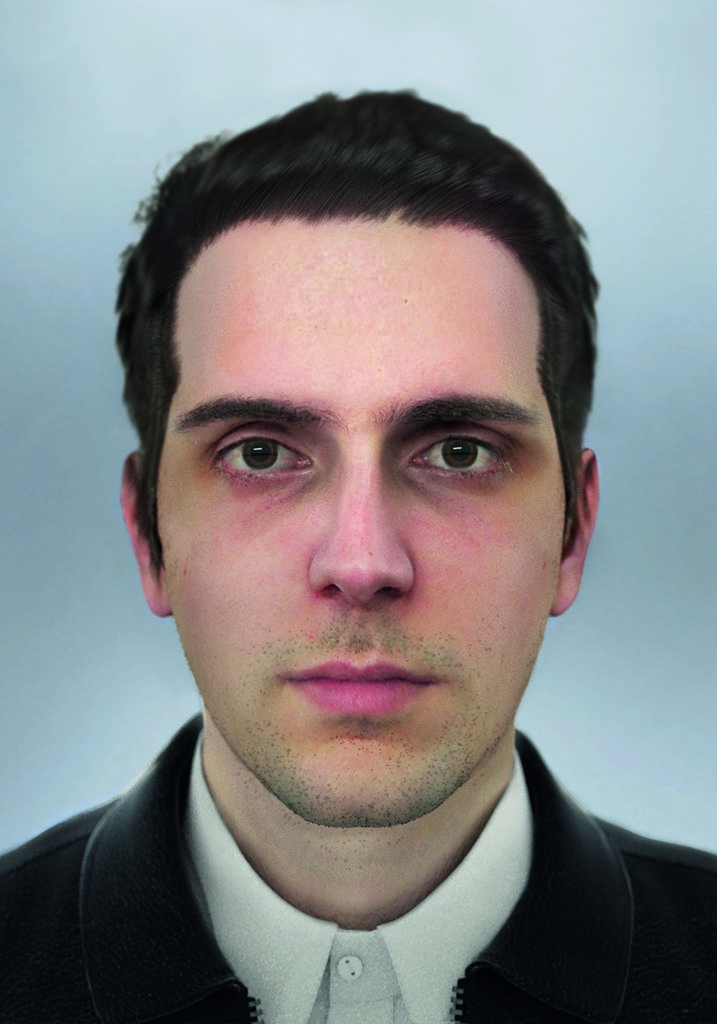
On April 7th, 2017, Raphael Fabre submitted a request for a French ID card. All of his papers were deemed to be legal and authentic and so the demand was accepted and a new national ID card was issued. In fact, the photo submitted to accompany this request was created on a computer, from a 3D model, using several different pieces of software and special effects techniques developed for movies and video games. Just as our relationship with governments and other forms of authority is increasingly based on digital information, so the image on the ID is entirely virtual. The artist’s self-portrait suggests the way in which citizens can construct their own identities, even in an age of powerful and often dehumanising technologies.
Jeremy Hutchison Movables, 2017
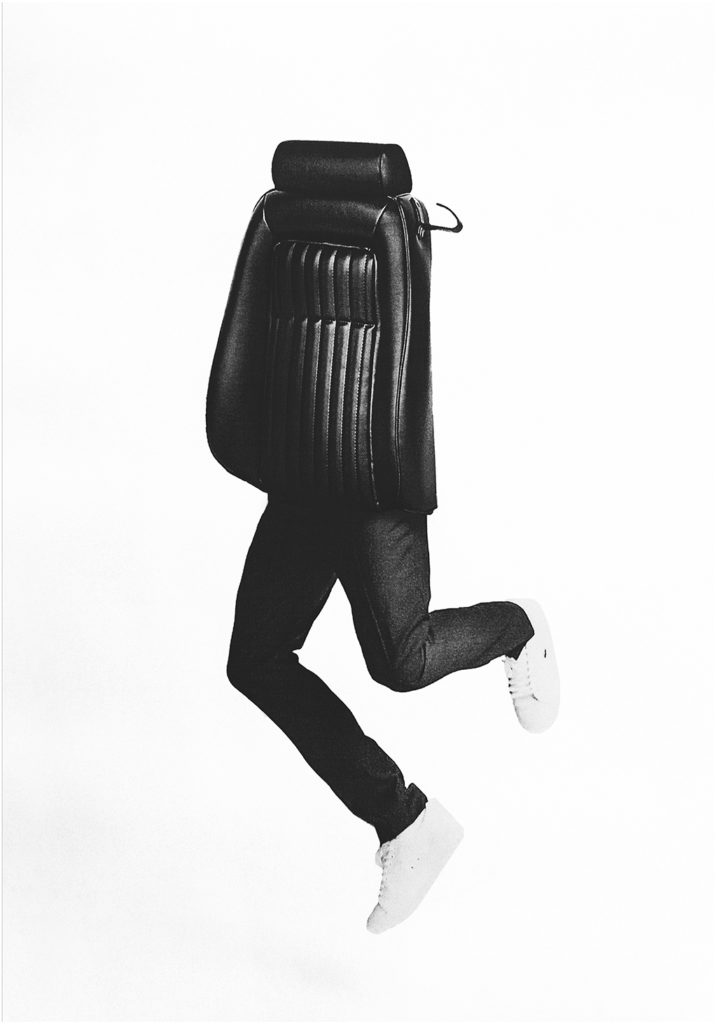
The starting point for this work was a found photograph, taken by police at a border point somewhere in the Balkans. It showed the inside of a Mercedes, the headrests torn open to reveal a person hiding inside each seat. This photograph testifies to a reality where human bodies attempt to disguise themselves as inanimate objects, simply to acquire the same freedom of movement as consumer goods. Movables translates this absurdity into a series of photo collages, combining elements of high-end fashion and car adverts, enacting an anthropomorphic fusion between the male form and the consumer product. The results are disquieting yet familiar, since they appropriate a visual language that saturates our everyday urban surroundings, highlighting the connections between transnational freedoms and limitations, and international trade.
They Are Here
We Help Each Other Grow, 2017
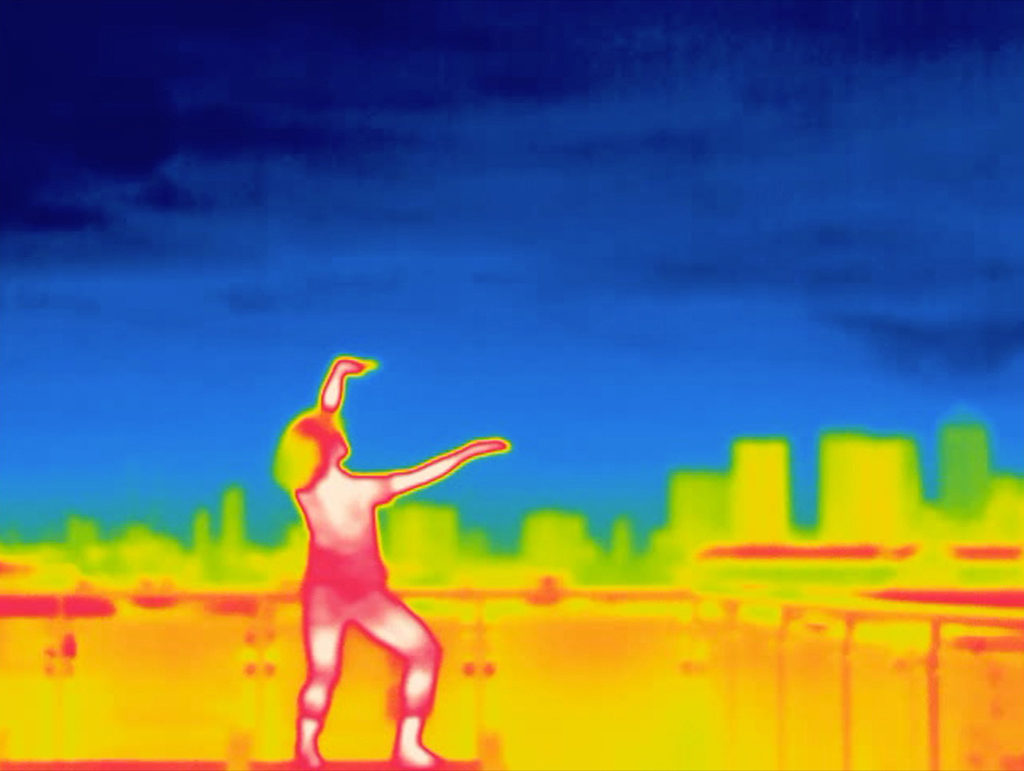
Thiru Seelan dances on an East London rooftop, looking out towards the skyline of the Canary Wharf financial district. His movements are inspired by the dance form Bharatanatyam, traditionally only performed by women and taught to Thiru in secret by his younger sister. Thiru is a Tamil refugee and when he arrived in the UK in 2010, following six months of detention in Sri Lanka during which he was tortured for his political affiliations, Canary Wharf was his first home. His movement is recorded by a heat sensitive camera more conventionally used as surveillance technology and deployed to monitor borders and crossing points, where bodies are recorded and captured through their thermal signature. The song ‘We’ve helped each other grow’, composed and performed by London based Mx World, was chosen with Thiru to soundtrack the performance. Mx is a prefix that does not indicate gender. In the UK, it can be used on many official documents – including passports. The repeated refrain, ‘We’ve helped each other grow’ suggests a communal vision for self and social development.
Daniela Ortiz
Jus Sanguinis, 2016
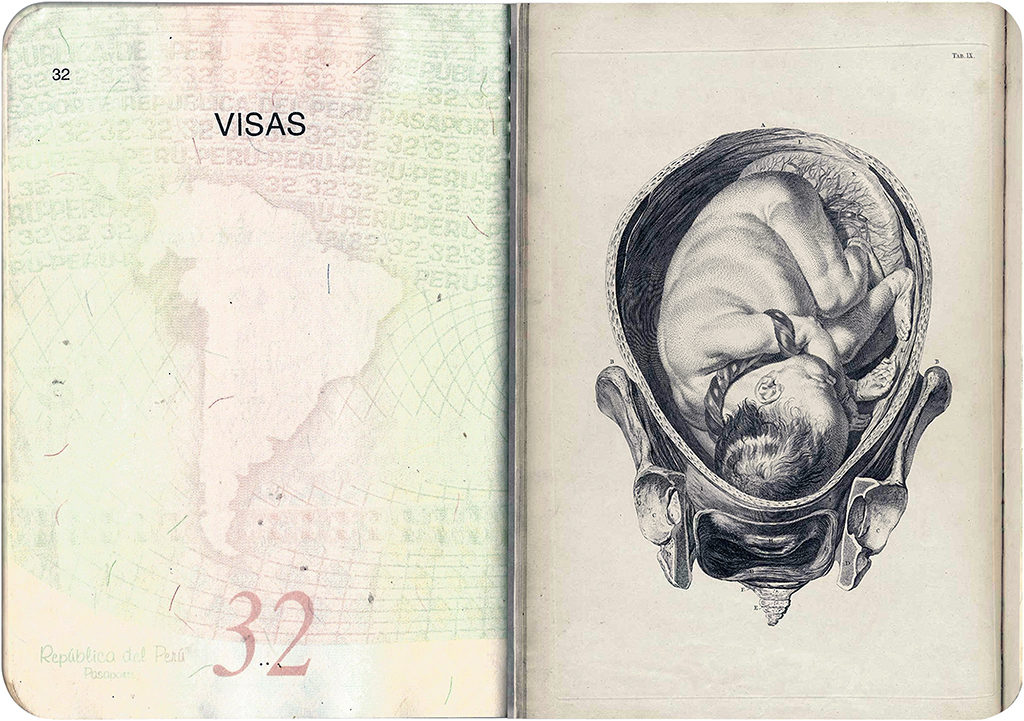
Jus sanguinis, meaning ‘the right of the blood’, is one of the main ways in which people acquire citizenship: from the blood of their parents. Daniela Ortiz is an artist of Peruvian descent living in Spain, where only babies with Spanish blood are recognized as subjects with the right to the nationality at the moment of the birth. As a result, her child would not have access to Spanish nationality. In this performance, undertaken when Ortiz was four months pregnant, she receives a blood transfusion from a Spanish citizen, directly challenging the racist and nationalist regime of citizenship which would classify her Spanish-born child as an immigrant.
The Critical Engineering Working Group (Julian Oliver and Danja Vasiliev)
VPN, 2018

Virtual Private Networks (VPNs) have come into increasing demand in recent years, providing route encryption through hostile networks. In China, Vietnam, Turkey and Pakistan they also serve to mitigate government censorship, so that foreign sites otherwise blocked by state firewalls are made available to VPN users (Twitter, Facebook, Wikipedia, activist sites and digital libraries being the most common).
Vending Private Network takes the form of a condom vending machine, such as those typically seen in toilets. Equipped with mechanical buttons, a coin-slot and USB ports, it offers 4 VPN routes, each adorned with an animated graphic depicting a fantasy destination. Audiences are invited to insert a USB stick into the slot, and a coin into the machine, then to select a VPN destination by pressing a mechanical button, a unique VPN configuration file is then written onto their USB stick. Special instructions (in the form of a README.txt) will also be copied to the USB stick that explain how to use the VPN in a special ‘sheathed’ mode that evades detection methods (namely Deep Packet Inspection, or DPI) used by corporations and state-controlled infrastructure administrators. This is the only means known to work against state controlled firewalls, for instance and requires an extra install of freely available, open source software and leverage economic and cultural privilege to benefit those not included. With each VPN config generated, another is covertly shipped to contacts in Turkey, China, Vietnam and Iran (and other countries to be confirmed).
Jonas Staal New Unions, 2016
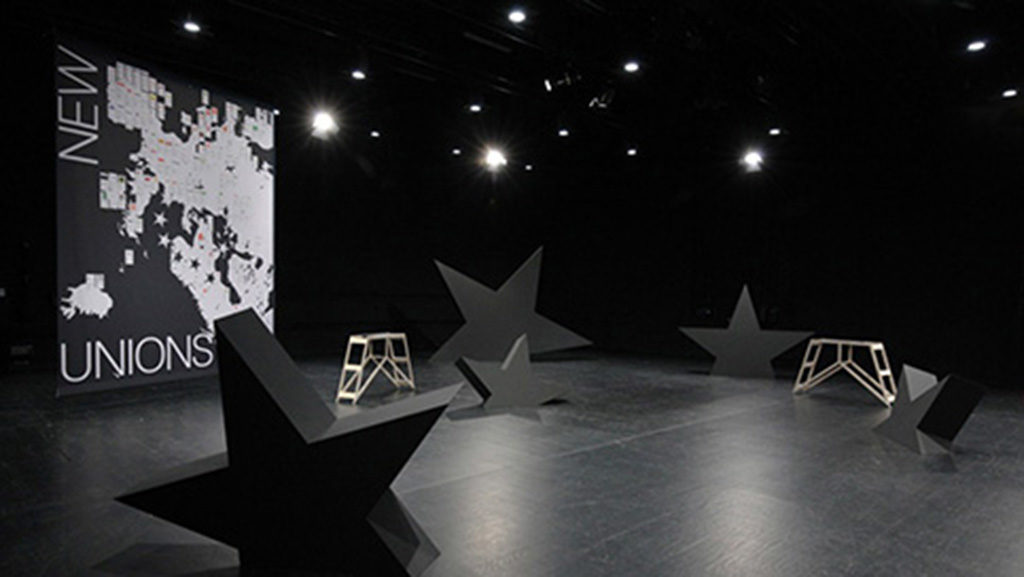
Jonas Staal’s New Unions is an artistic campaign supporting progressive, emancipatory, and autonomist movements all over Europe, and proposing the creation of a “transdemocratic union” which is not limited by the boundaries of nation states. The New Unions map illustrates the recent, massive rise in social movements and new political parties which are creating new models of political assembly and decision making while challenging traditional national and institutional structures. From the civil initiative in Iceland to collectively rewrite the constitution after the economic crash, to regional independence movements and pan-European solidarity groups, these emerging political experiments propose new forms of transdemocratic practices. This map is the first in a series which is continuously updated to reflect the evolving geography of transdemocracy.
The Critical Engineering Working Group is a collaboration between Julian Oliver and Danja Vasiliev. Their manifesto begins: “The Critical Engineer considers Engineering to be the most transformative language of our time, shaping the way we move, communicate and think. It is the work of the Critical Engineer to study and exploit this language, exposing its influence.”
criticalengineering.org
Raphaël Fabre works on the interference of fictions and narrative storytelling in the real world, using techniques ranging from digital 3D technologies to set decoration. Born in 1989, he lives and works in Paris.
raphaelfabre.com
Jeremy Hutchison works with situational performance. Operating in sites of production and consumption, he often collaborates with factory employees, migrant labourers, online workers and jobseekers to examine the structures that limit human existence. How are unequal human relations constructed by global capital? How do consumer products function as portraits of exploitative material structures? In the process of developing these works, each context becomes a stage; a metaphor for the production of reason. To some extent, his projects are rehearsals for an uncertain kind of freedom. He was recently a member of the Whitney Independent Study Program in New York.
jeremyhutchison.com
Daniela Ortiz (Cusco, 1985) lives and works in Barcelona. Through her work, she generates spaces of tension in which the concepts of nationality, racialization, social class and gender are explored in order to critically understand structures of inclusion and exclusion in society. Her recent projects and research revolve around the issue of migration control, its links to colonialism, and its management by Europeanwhite states and societies. At the same time, she has produced projects about the Peruvian upper class and its exploitative relationship with domestic workers. Daniela gives talks and participates in discussions on Europe’s migration control system and its ties to coloniality in different contexts.
daniela-ortiz.com
Jonas Staal lives and works in Rotterdam (NL). He has studied monumental art in Enschede (NL) and Boston (US) and received his PhD for research on Art and Propaganda in the 21st Century from the University of Leiden (NL). His work includes interventions in public space, exhibitions, theater plays, publications and lectures, focusing on the relationship between art, democracy and propaganda. Staal is the founder of the artistic and political organization New World Summit and, together with BAK, basis voor actuele kunst, Utrecht (NL), of the New World Academy.
jonasstaal.nl
They Are Here (f. 2006) is a collaborative practice steered by Helen Walker and Harun Morrison. They are currently based in London and on the River Lea. Their work can be read as a series of context specific games. The entry, invitation or participation can be as significant as the game’s conditions and structure. Through these games, they seek to create ephemeral systems and temporary, micro-communities that offer an alternate means of engaging with a situation, history or ideology. In parallel, they initiate multiyear socially engaged projects that become generative spaces for further works. They Are Here work across media and types of site, particularly civic spaces.
theyarehere.net
James Bridle is an artist and writer working across technologies and disciplines. His artworks and installations have been exhibited in Europe, North and South America, Asia and Australia, and have been viewed by hundreds of thousands of visitors online. He has been commissioned by organisations including the Victoria & Albert Museum, the Barbican, Artangel, the Oslo Architecture Triennale, the Istanbul Design Biennial, and been honoured by Ars Electronica, the Japan Media Arts Festival, and the Design Museum, London. His writing on literature, culture and networks has appeared in magazines and newspapers including Frieze, Wired, Domus, Cabinet, the Atlantic, the New Statesman, and many others, in print and online, and he has written a regular column for the Observer. “New Dark Age”, his book about technology, knowledge, and the end of the future, is forthcoming from Verso (UK & US) in 2018. He lectures regularly on radio, at conferences, universities, and other events, including SXSW, Lift, the Global Art Forum, Re:Publica and TED. He was been a resident at Lighthouse, Brighton, the White Building, London, and Eyebeam, New York, and an Adjunct Professor on the Interactive Telecommunications Programme at New York University.
jamesbridle.com
Furtherfield is an internationally-renowned digital arts organisation hosting exhibitions, workshops and debate for over 20 years. We collaborate locally and globally with artists, academics, organisations and the public to explore digital culture and the changing world we live in. From our unique venues in Finsbury Park we offer a range of ways for everyone to get hands on with emerging technologies and ideas about contemporary society. Our aim is to make critical digital citizens of us all. We can make our own world.
Furtherfield Gallery
McKenzie Pavilion
Finsbury Park, London, N4 2NQ
Visiting Information
This project has been funded with the support from the European Commission. This communication reflects the views only of the author, and the Commission cannot be held responsible for any use which may be made of the information contained therein.
Transnationalisms is realised in the framework of State Machines, a joint project by Aksioma (SI), Drugo More (HR), Furtherfield (UK), Institute of Network Cultures (NL) and NeMe (CY).
The Alternative UK write about Transnationalisms: We live in an age of transnationalisms. At Furtherfield, artists test all the borders
Join Stacco Troncoso & Ann Marie Utratel (Commons Transition) and Ruth Catlow (Furtherfield) to play Commonspoly – the resource-access game where we win by working as a community.
Commonspoly is a hack and a critique of the game Monopoly. Players aim first to re-municipalize private goods and then turn them into a Commons – you’ll learn why this is the best strategy while playing the game.
Rather than compete against each other, players must overcome their conditioning and ‘rational, self-interest’ to instead maximize cooperative behaviours and create a commons-oriented locality. Who wins? Everyone in the community! Unless the speculators take over…which we must fight at all costs. United we stand!
This event at Design Museum in partnership with Furtherfield forms part of Convivial Tools, a programme of talks, debates and workshops exploring new strategies for a more cooperative society, based on the thinking of the late philosopher Ivan Illich.
Stacco Troncoso is the advocacy coordinator for Commons Transition and the P2P Foundation, and a co-founder of the Guerrilla Translation collective. He is the designer and content editor for CommonsTransition.org, the P2P Foundation blog and the Commons Strategies Group website.
Ann Marie Utratel is part of the Commons Transition team, and is a co-founder of the Guerrilla Translation collective. Her work helps connect a widening network of people involved in forward-thinking communities including the Commons and P2P movement, collaborative economy, open licensing, open culture, open cooperativism, and beyond.
Ruth Catlow, artist, curator, and co-founder and co-director of Furtherfield, is a recovering web-utopian and has worked since the mid-90s with network practices in arts, technology and social change.
At Furtherfield we have worked with decentralised network practices in arts and technology since we published our first webpages in 1996 – before the great centralisation – when the web thought it was already distributed and P2P. We took the spirit of punk and DIY in a more collaborative direction inspired by Free and Open Source Software methods and cultures, to build new platforms and art contexts with a playful Do It With Others (DIWO) ethos. We still connect with artists, techies, activists and thinkers from our base in Finsbury Park in North London, and internationally online. In 2015 Furtherfield launched the Art Data Money programme that sought to develop a commons for the arts in the network age.
DECAL – Decentralised Arts Lab is the outcome.
DECAL exists to mobilise crowdsourced research and development by leading artists, using blockchain and web 3.0 technologies for fairer, more dynamic and connected cultural ecologies and economies now.

Furtherfield Spring Editorial 2018 – Blockchain Imaginaries
2018
Introduction to Furtherfield Spring season of art and blockchain essays, interviews, events, exploration and critique.
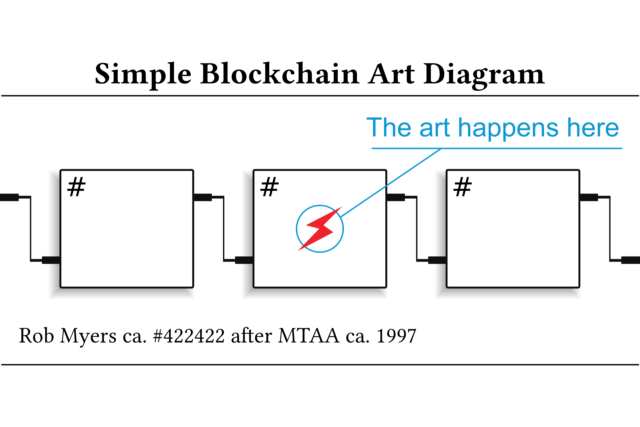
Collected writings by Rhea Myers
2014 – Present
On blockchain geometries, accelerationist art, crypto and DAWCs, art for algorithms, and (Conceptual) Art, cryptocurrency and beyond.
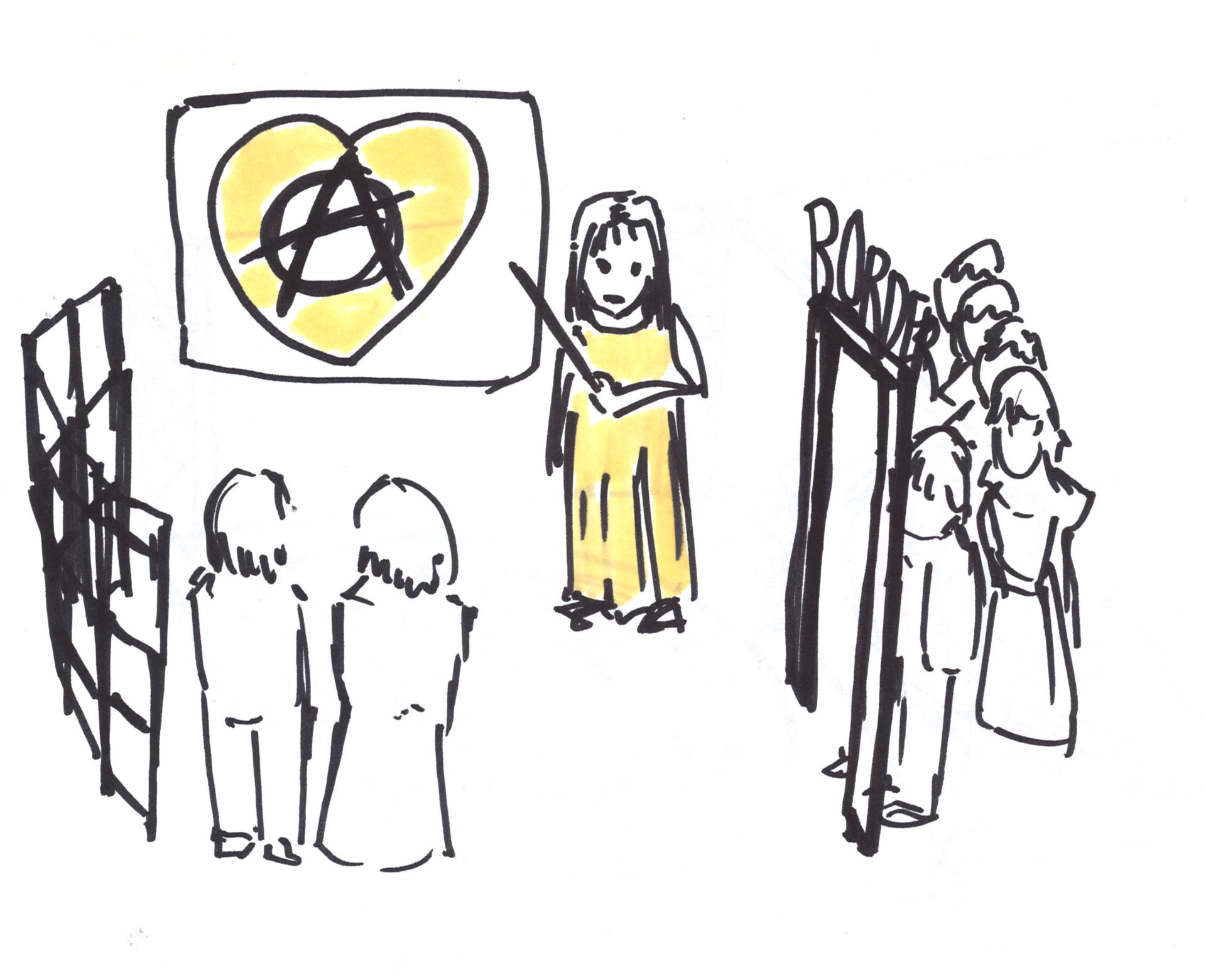
DAOWO – The blockchain laboratory and debate series for reinventing the arts
Oct 2017 – Present
A temporary laboratory for the creation of a living blockchain art laboratory devised by Ruth Catlow and Ben Vickers in collaboration with Goethe Institut, London.
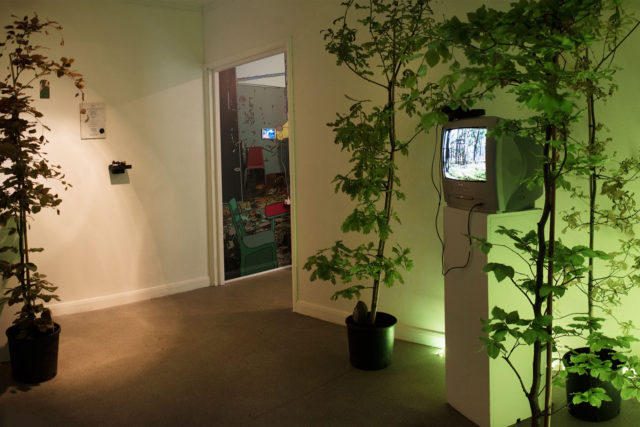
New World Order
2017 – 18
Artists envision a world made by machines, markets and natural processes, without states or other human institutions in an international touring exhibition curated by Furtherfield.
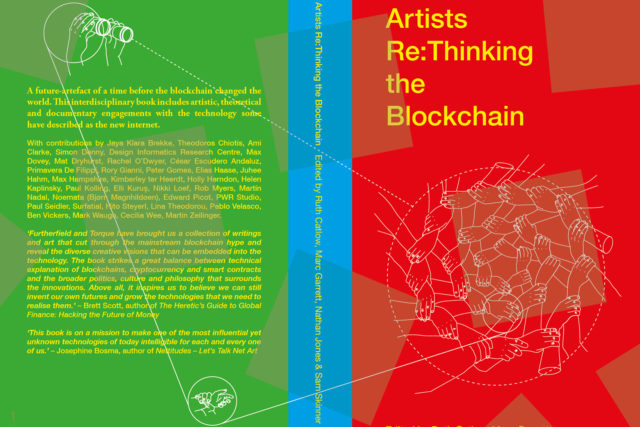
Artists Re:thinking the Blockchain
2017
The first book of its kind, bringing together artistic, speculative, conceptual and technical engagements with blockchains.
Edited by Ruth Catlow, Marc Garrett, Nathan Jones, and Sam Skinner
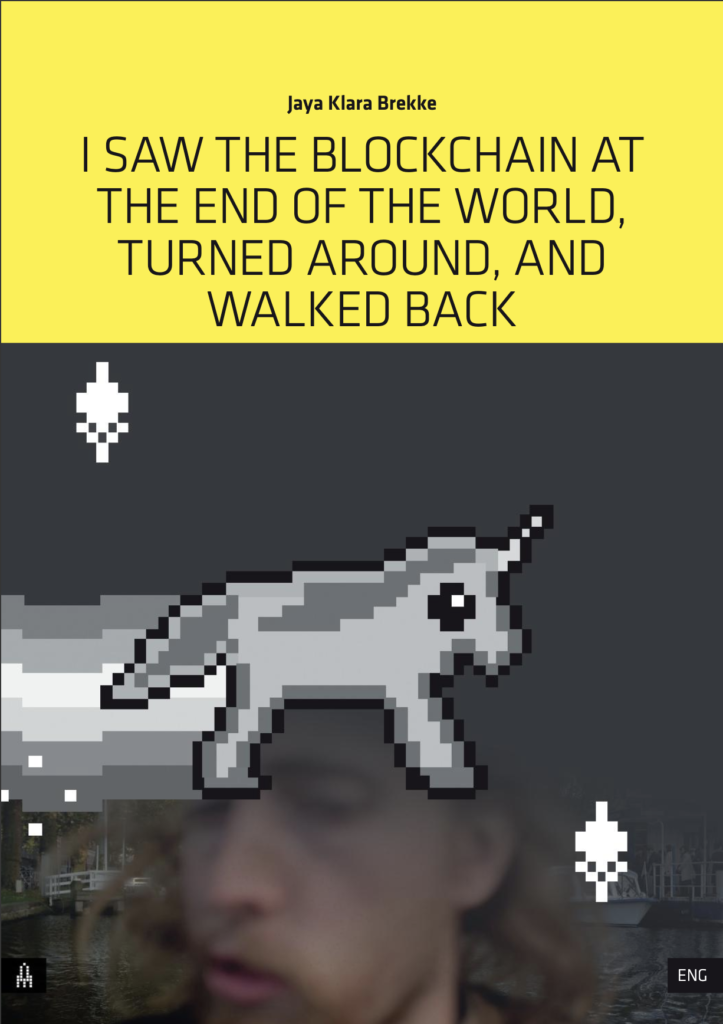
Jaya Klara Brekke: I saw the Blockchain at the End of The World, turned around, and walked back
2018
Written on the occasion of the New World Order group exhibition for PostScriptUM #31 Series published by Aksioma, edited by Janez Janša
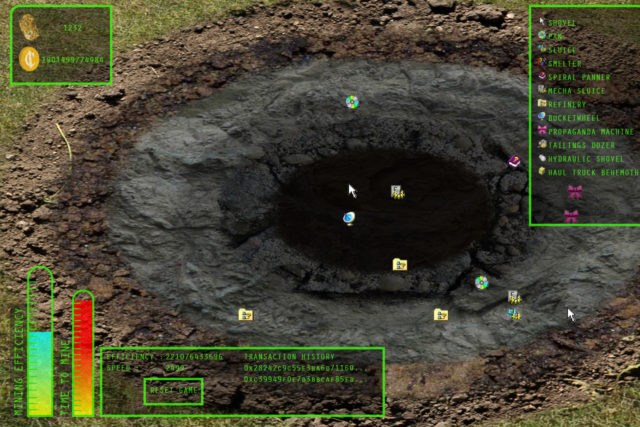
Blockchain Art Commission*
2017
Clickmine by Sarah Friend is a hyperinflationary ERC-20 token that is minted by a clicking game.
A Furtherfield and NEoN Digital Arts Festival Co-commission
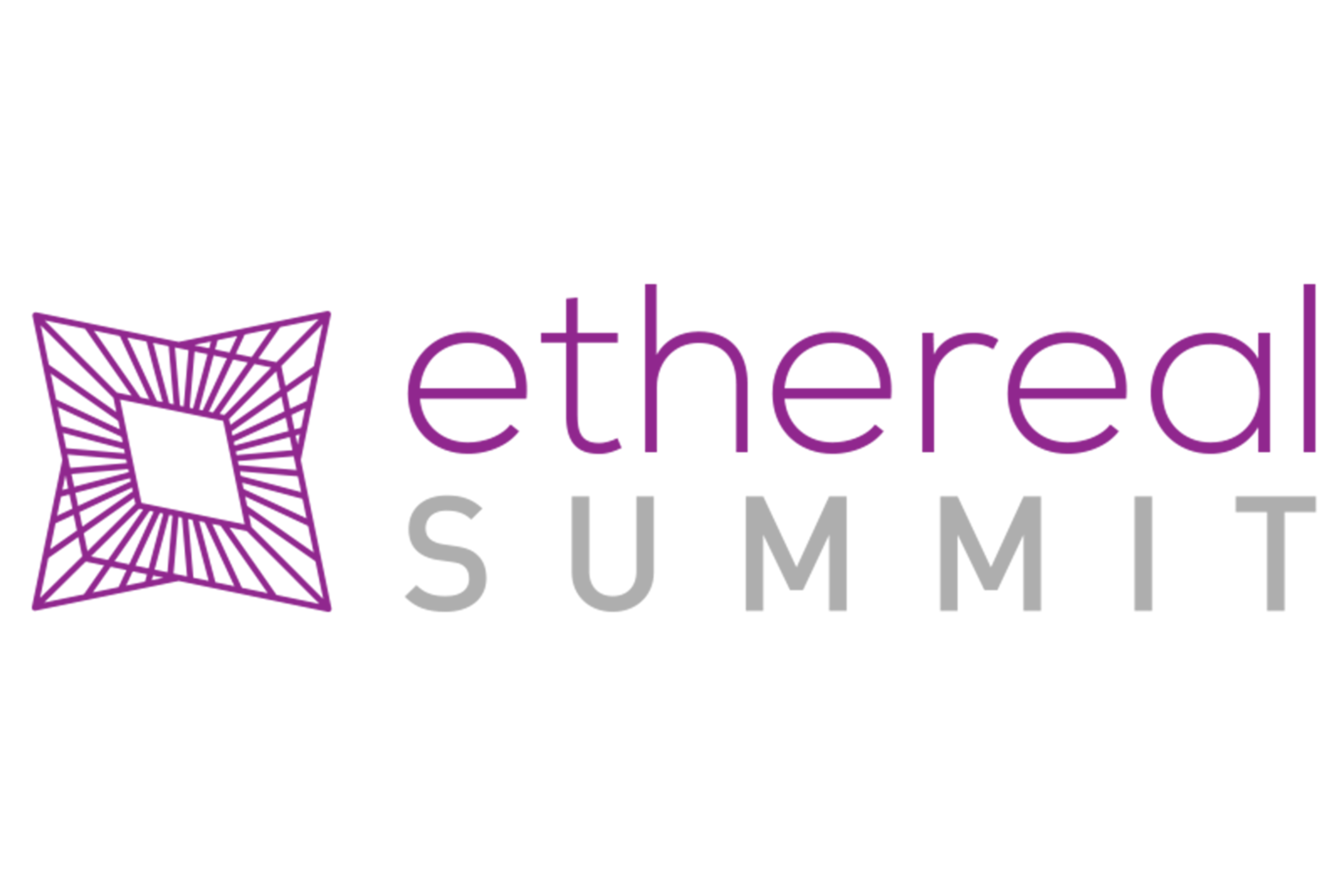
Ethereal Summit NY
2018
Commission and exhibition of contemporary artists working with public blockchains as a medium for conceptual and social experimentation. Jurors and curators, Ruth Catlow, Giani Fabricio, Sam Hart, Will King, Saraswathi Subbaraman
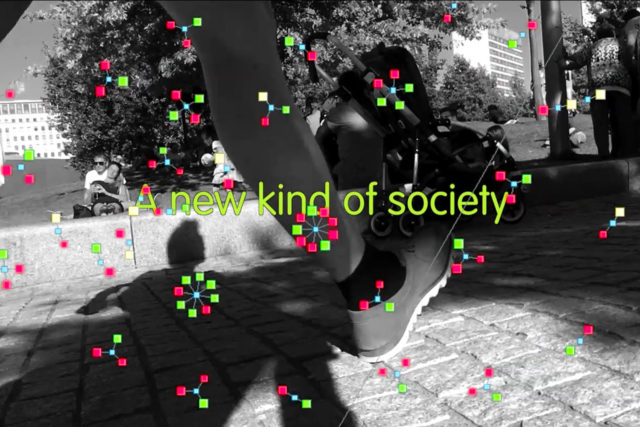
The Blockchain: Change Everything Forever
2016
A short film to stimulate cross sector debate around how emerging blockchain technologies change the social contract, directed by Pete Gomes
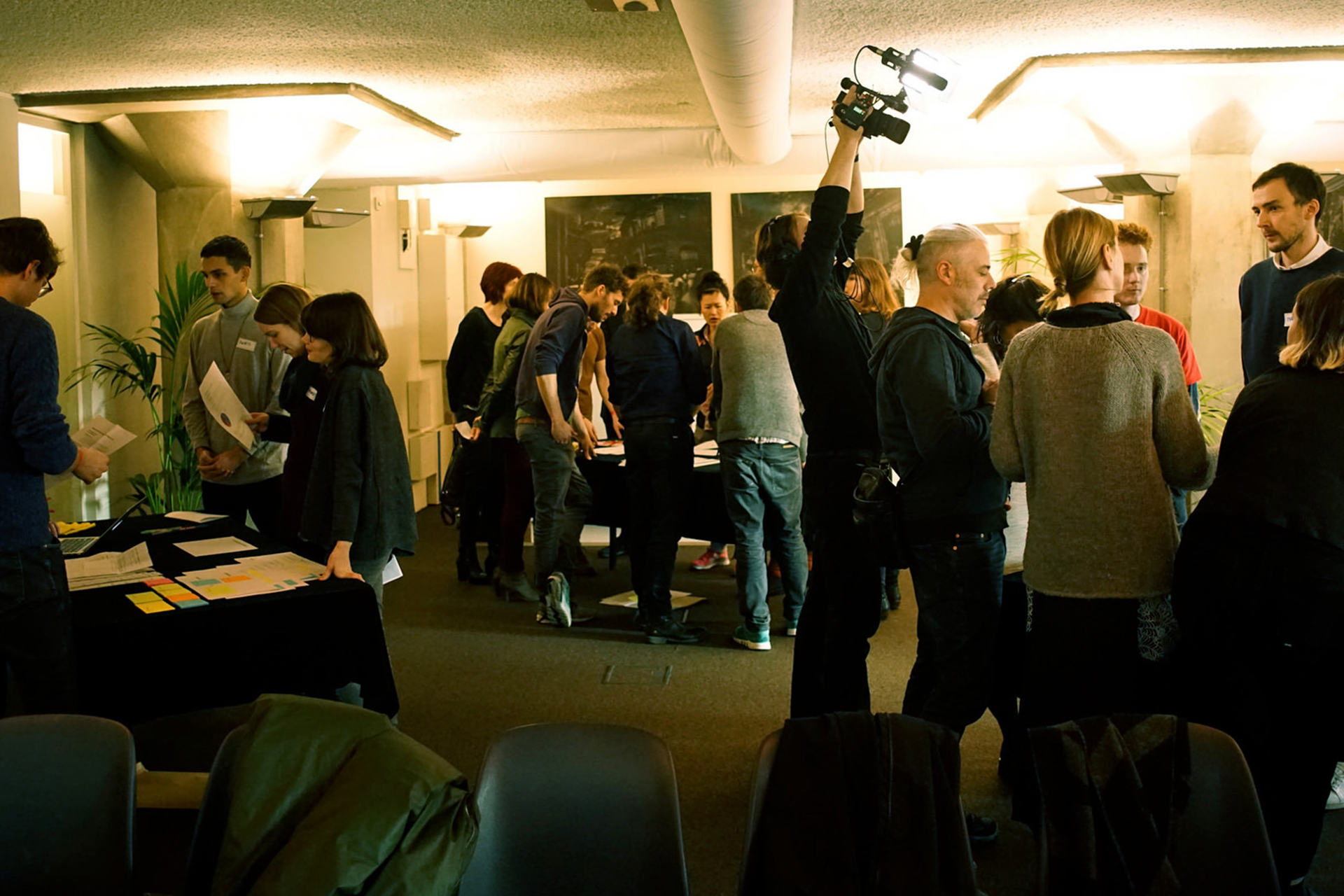
Role Play Your Way to Budgetary Blockchain Bliss
2016
Ruth Catlow and Ben Vickers brought the LARPing tradition to INC’s MoneyLab. Inviting participants to take on generic roles from the business cycle of start up tech companies trying to make the next big thing with the latest technological innovation.
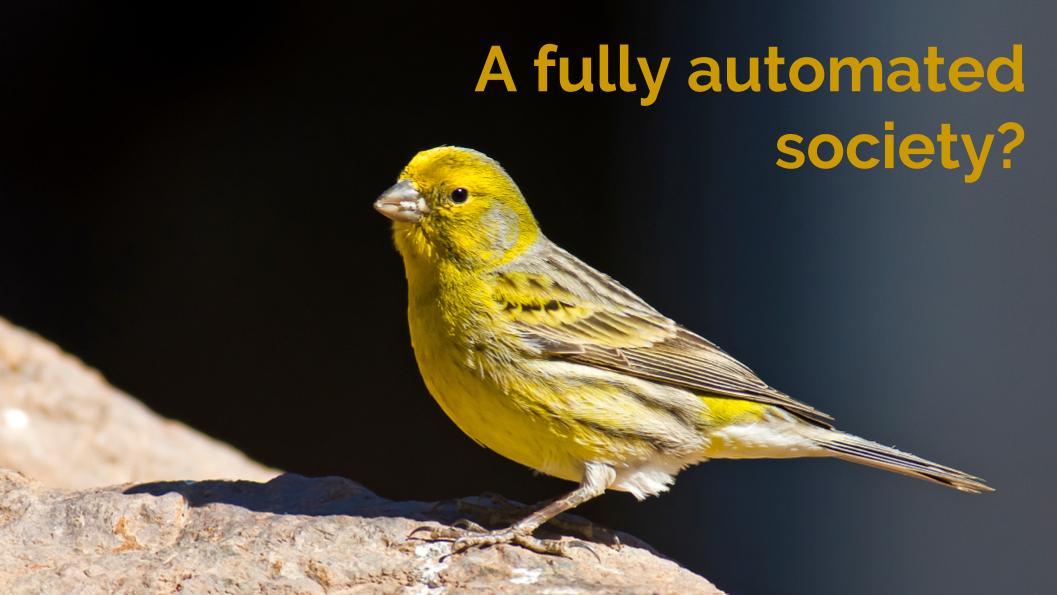
Blockchain’s Potential in the Arts
2016
A gathering of organisations, academics and policy makers in arts and culture to explore blockchain’s potential. Convened by Ben Vickers and Ruth Catlow and hosted by the Austrian Cultural Forum, London.
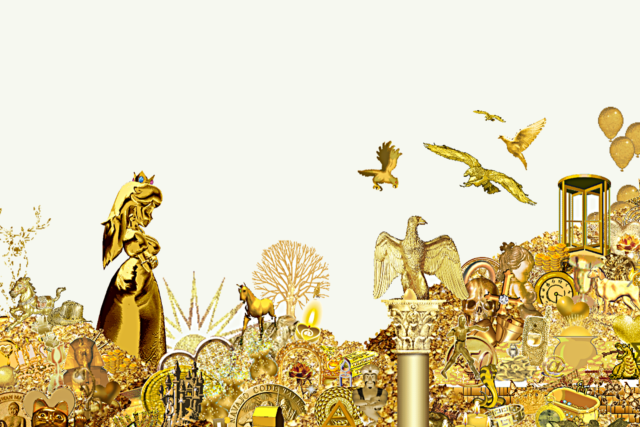
The Human Face of Cryptoeconomies
2015
An exhibition curated by Futherfield to explore how might we produce, exchange and value things differently for a transformed artistic, economic and social future?
http://rhizome.org/editorial/2018/jun/14/island-mentality/
https://edition.cnn.com/style/article/cryptokitty-blockchain/index.html
http://hyperallergic.com/440936/what-blockchain-means-for-contemporary-art/
https://www.artbasel.com/news/artists-as-cryptofinanciers–welcome-to-the-blockchain
Exhibition, Furtherfield Gallery, London Oct 2015 – Nov 2015
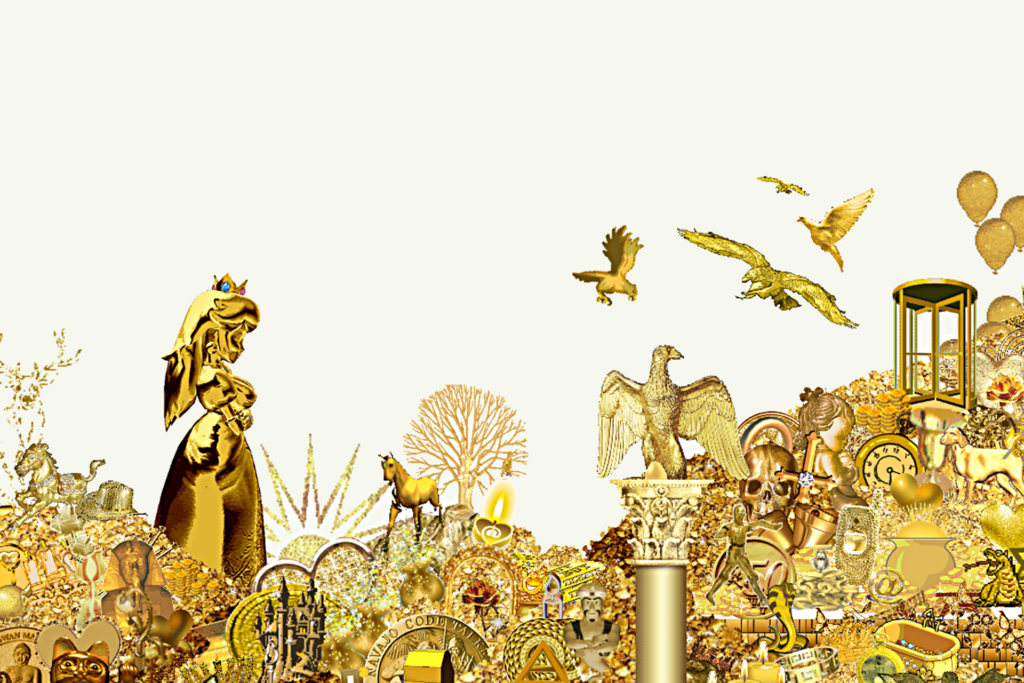
Émilie Brout and Maxime Marion exhibit ornamental Gold and Glitter created with ‘found’ internet GIFs and Nakamoto (The Proof) – a video documenting the artists’ attempt to produce a fake passport of the mysterious creator of Bitcoin, Satoshi Nakamoto. FaceCoin by Rhea Myers is an artwork that is also a machine for mining faces as proof of aesthetic work. His Shareable Readymades are iconic 3D printable artworks for an era of digital copying and sharing. The Museum of Contemporary Commodities by Paula Crutchlow and Dr Ian Cook treats everyday purchases as if they were our future heritage and Jennifer Lyn Morone™ Inc reclaims ownership of personal data by turning her entire being into a corporation. The Alternet by Sarah T Gold conceives of a way for us to determine with whom, and on what terms, we share our data and Shu Lea Cheang anticipates a future world where garlic is the new social currency.
Press:
JJ Charlesworth for Art Review Jan-Feb 2016
Short film, 2016
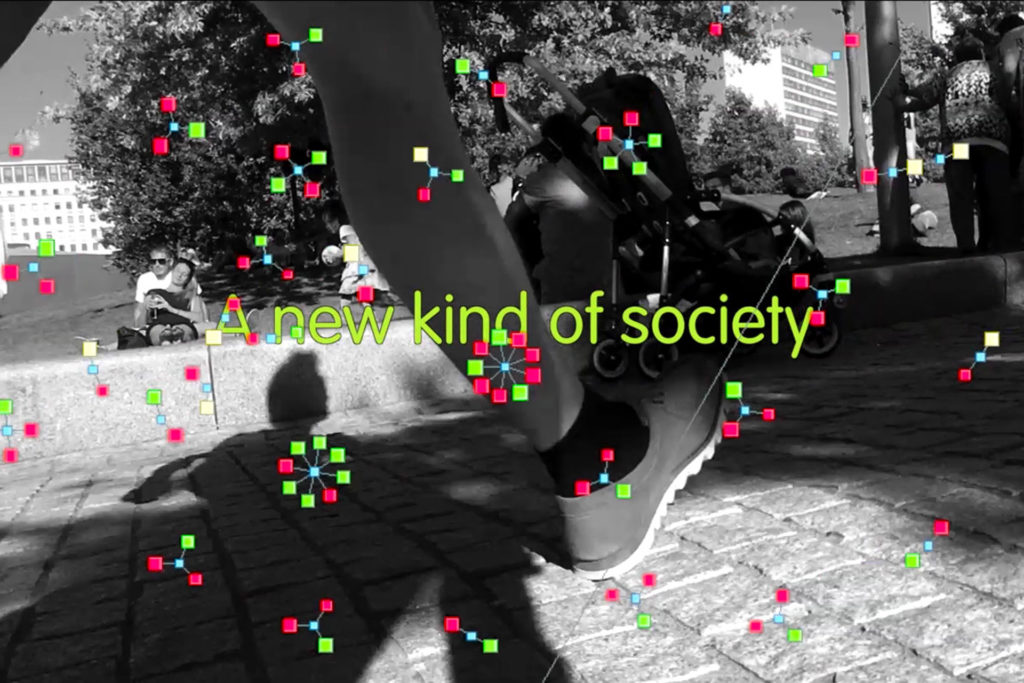
The underpinning technology of digital currencies and smart contracts, the blockchain is reshaping concepts of value, trust, law and governance. This film sets out to diversify the people involved in its future by bringing together leading thinkers, computer scientists, entrepreneurs, artists and activists who discuss:
A Furtherfield film with Digital Catapult London. Directed by Pete Gomes, concept and research by Ruth Catlow. Featuring interviews with: Dr Anat Elhalal; Ben Vickers; Dr Catherine Mulligan; Elias Haase; Irra Ariella Khi; Jaime Sevilla; Jaya Klara Brekke; Kei Kreutler; Pavlo Tanasyuk; Rhea Myers; Sam Davies; and Vinay Gupta
Live Action Role Play, 2016
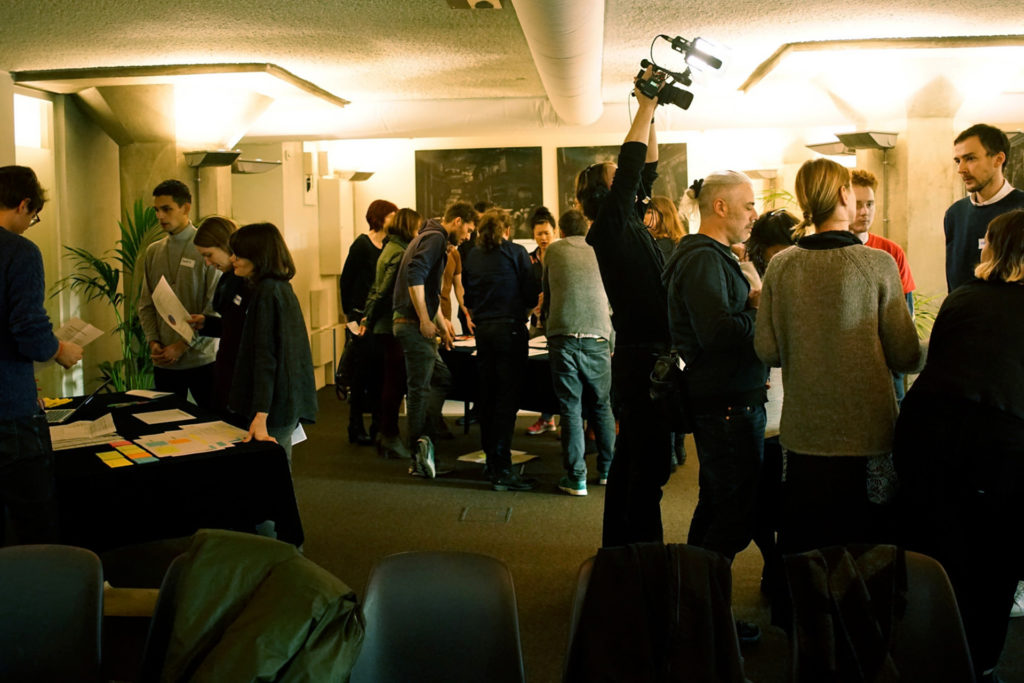
This 2-day start up tech hackathon compressed into 2 hours was aimed at creating Blockchain based businesses ideas that improve the life and future of cats. The workshop critically emulated the extravagant discourse and excitement surrounding the super-automation and hyperconnectivity that comes with blockchain and similar technologies, and the capacity of the technology stakeholders to both increase and diminish global inequity. Devised by Ben Vickers, Ruth Catlow for Institute of Network Cultures’ MoneyLab.
Report:
http://networkcultures.org/moneylab/2016/12/06/role-play-your-way-to-budgetary-blockchain-bliss/
International Touring Exhibition, 2017 – 2018
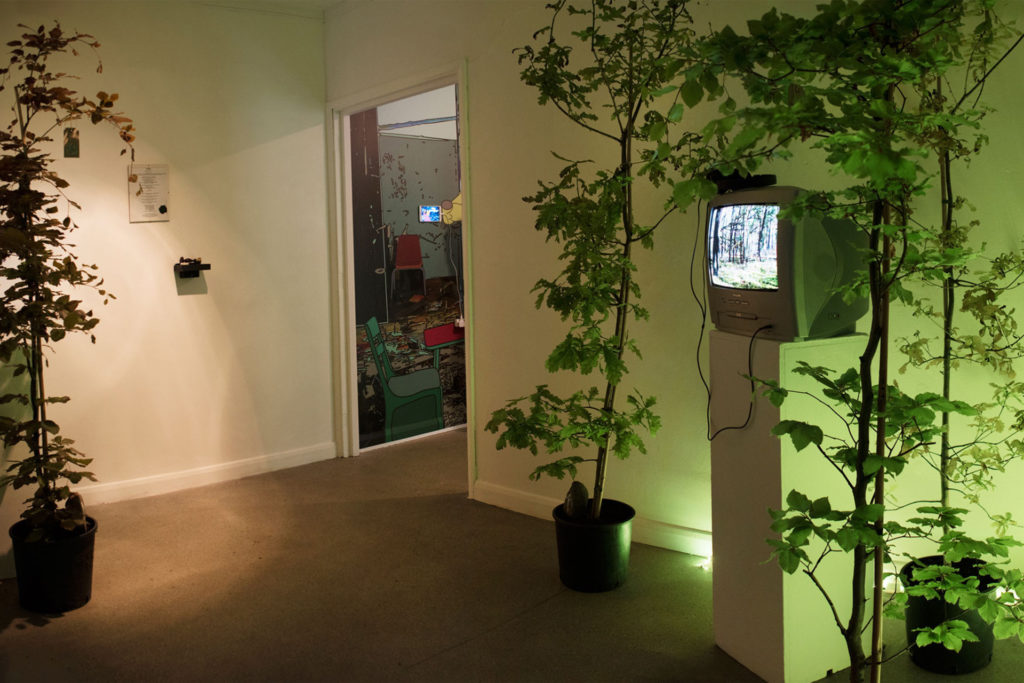
Jaya Klara Brekke, Max Dovey, Pete Gomes, HandFastr, Rhea Myers, Primavera De Filippi of O’Khaos, Terra0, Lina Theodorou and xfx (aka Ami Clarke). Curated by Furtherfield
A self-owning forest with ideas of expansion, a self-replicating android flower, a cryptocurrency rig to mine human breath, a five minute marriage contract, a Hippocratic Oath for software developers; in an exhibition about living with blockchain technologies.
Artists investigate and test the possible consequences of blockchain technologies, and their capacity to embody divergent political ideas. They explore dramatic new conceptions of global governance and economy, that could permanently enrich or demote the role of humans. They portray a world in which responsibility for many aspects of life are transferred, permanently (for better or worse) from natural and social systems into a secure, networked, digital ledger of transactions, and computer-executed contracts.
Produced as part of the State Machines programme*
Press: https://edition.cnn.com/style/article/cryptokitty-blockchain/index.html
Book published by Torque Editions, 2017
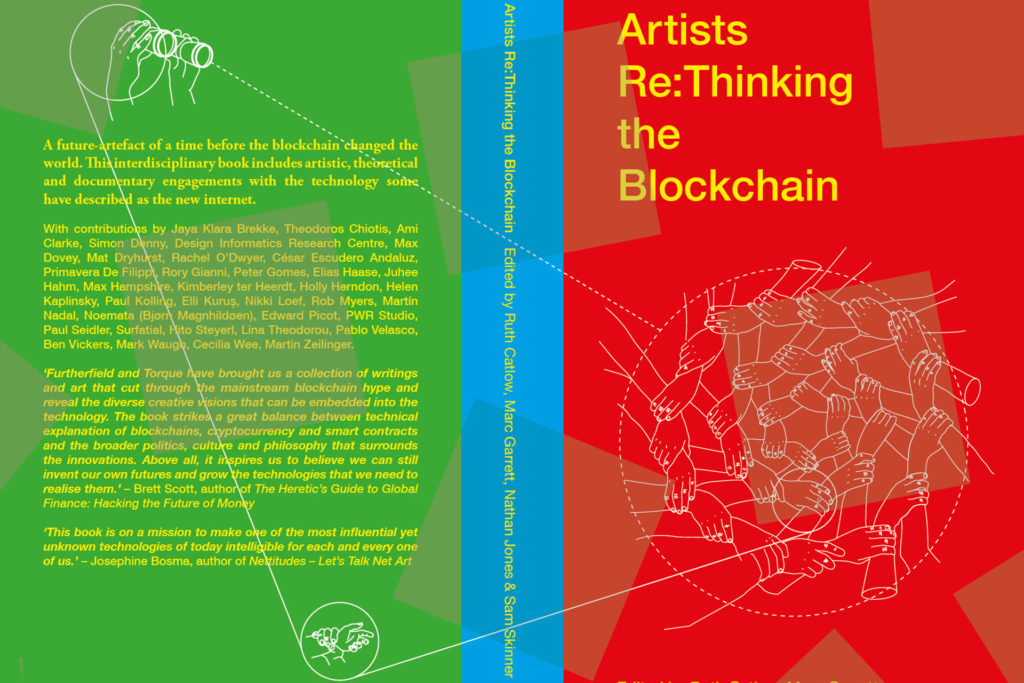
Artists Re:Thinking the Blockchain is the first book of its kind, intersecting artistic, speculative, conceptual and technical engagements with the the technology heralded as “the new internet”. The book features a range of newly commissioned essays, fictions, illustration and art documentation exploring what the blockchain should and could mean for our collective futures.
Artists Re:Thinking The Blockchain
Imagined as a future-artefact of a time before the blockchain changed the world, and a protocol by which a community of thinkers can transform what that future might be, Artists Re:Thinking The Blockchain acts as a gathering and focusing of contemporary ideas surrounding this still largely mythical technology. The full colour printed first edition includes DOCUMENTATION of artistic projects engaged in the blockchain, including key works Plantoid, Terra0 and Bittercoin, THEORISATION of key areas in the global blockchain conversation by writers such as Hito Steyerl, Rachel O’Dwyer, Rhea Myers, Ben Vickers and Holly Herndon, and NEW POETRY, ILLUSTRATION and SPECULATIVE FICTION by Theodorios Chiotis, Cecilia Wee, Juhee Hahm and many more. It is edited by Ruth Catlow, Marc Garrett, Nathan Jones and Sam Skinner.
Along with a print edition, Artists Re:Thinking the Blockchain includes a web-based project in partnership with Design Informatics at University of Edinburgh: Finbook is an interface where readers and bots can trade on the value of chapters included in the book. As such it imagines a new regime for cultural value under blockchain conditions.
This book and surrounding events is produced in collaboration between Torque and Furtherfield, connecting Furtherfield’s Art Data Money project with Torque’s experimental publishing programme. It is supported by an Arts Council England Grants for the Arts, Foundation for Art and Creative Technology and through the State Machines project by the Creative Europe Programme of the European Union.
Buy Artists Re:thinking the Blockchain
Format: Paperback
ISBN number: 978-0-9932487-5-7
Torque and Furtherfield, London, 2017
Distributor: Liverpool University Press
Press:
http://we-make-money-not-art.com/artists-rethinking-the-blockchain/
https://hyperallergic.com/440936/what-blockchain-means-for-contemporary-art/
http://networkcultures.org/moneylab/2018/01/26/artists-rethinking-the-blockchain/
The blockchain laboratory and debate series for reinventing the arts, 2017 – Present

This series brings together artists, musicians, technologists, engineers, and theorists to join forces in the interrogation and production of new blockchain technologies. The focus is to understand how blockchains might be used to enable a critical, sustainable and empowered culture, that transcends the emerging hazards and limitations of pure market speculation of cryptoeconomics.
Devised by Ruth Catlow and Ben Vickers in collaboration with Goethe Institut, London.
Contributors include Ramon Amaro, Jaya Klara Brekke, Ed Fornieles, Jess Houlgrave, Janez Jansa, Helen Kaplinsky, Thor Karlsson, Kei Kreutler, Sarah Meiklejohn, Julian Oliver, Emily Rosamond, Hito Steyerl, Mark Waugh, Laura Willis.
Visit the DAOWO website to view video and pdf resources
Produced as part of the State Machines programme*
Press:
http://rhizome.org/editorial/2018/jan/03/reinventing-the-art-lab-on-the-blockchain/
http://rhizome.org/editorial/2018/jun/14/island-mentality/
*State Machines: Art, Work and Identity in an Age of Planetary-Scale Computation
Focusing on how such technologies impact identity and citizenship, digital labour and finance, the project joins five experienced partners Aksioma (SI), Drugo More (HR), Furtherfield (UK), Institute of Network Cultures (NL) and NeMe (CY) together with a range of artists, curators, theorists and audiences. State Machines insists on the need for new forms of expression and new artistic practices to address the most urgent questions of our time, and seeks to educate and empower the digital subjects of today to become active, engaged, and effective digital citizens of tomorrow.
This project has been funded with the support from the European Commission. This communication reflects the views only of the author, and the Commission cannot be held responsible for any use which may be made of the information contained therein.
On the day of the General Data Protection Law (GDPR) going into effect in Europe, on the 25th of May, the Disruption Network Lab opened its 13th conference in Berlin entitled “HATE NEWS: Manipulators, Trolls & Influencers”. The two-day event looked into the consequences of online opinion manipulation and strategic hate speech. It investigated the technological responses to these phenomena in the context of the battle for civil rights.
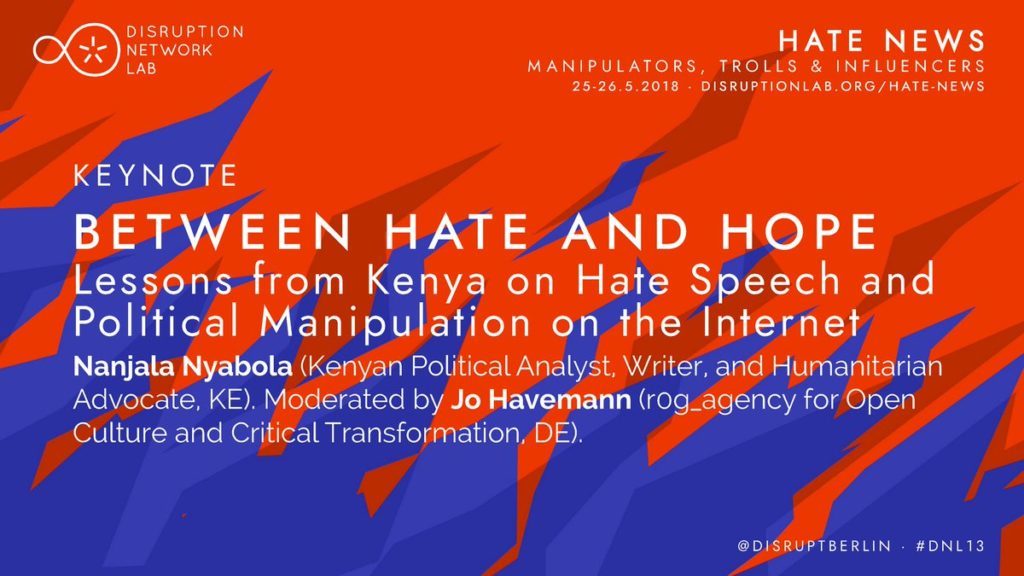
The conference began with Jo Havemann presenting #DefyHateNow, a campaign by r0g_agency for open culture and critical transformation, a community peace-building initiative aimed at combating online hate speech and mitigating incitement to offline violence in South Sudan. More than ten years ago, the bulk of African countries’ online ecosystems consisted of just a few millions of users, whilst today’s landscape is far different. This project started as a response to how social media was used to feed the conflicts that exploded in the country in 2013 and 2016. It calls to mobilize individuals and communities for civic action against hate speech and social media incitement to violence in South Sudan. Its latest initiative is the music video #Thinkbe4uclick, a new awareness campaign specifically targeted at young people.
In Africa, hate campaigns and manipulation techniques have been causing serious consequences for much longer than a decade. The work of #DefyHateNow counters a global challenge with local solutions, suggesting that what is perceived in Europe and the US as a new problem should instead be considered in its global dimension. This same point of view was suggested by the keynote speaker of the day, Nanjala Nyabola, writer and political analyst based in Nairobi. Focusing on social media and politics in the digital age, the writer described Kenya´s recent history as widely instructive, warning that manipulation and rumours can not only twist or influence election results but drive conflicts feeding violence too.
The reliance on rumours and fake news was the principal reason that caused the horrifying escalation of violence following the Kenyan 2007 general election. More than 1,000 people were killed and 650,000 displaced in a crisis triggered by accusations of election fraud. The violence that followed unfolded fast, with police use of brutal force against non-violent protesters causing most of the fatalities. The outbreak of violence was largely blamed on ethnic clashes inflamed by hate speech. It consisted of revenge attacks for massacres supposedly carried out against ethnic groups in remote areas of the country. Unverified rumours about facts that had not taken place. Misinformation and hate were broadcast over local vernacular radio stations and with SMS campaigns, inciting the use of violence, animating different groups against one another.
The general election in 2013 was relatively peaceful. However, ethnic tensions continued to grow across the whole country and ethnic driven political intolerance appeared increasingly on social media, used mainly by young Kenyans. Online manipulation and disinformation proliferated on social media again before and after the 2017 general election campaign.
Nyabola explained that nowadays the media industry in Kenya is more lucrative than in most other African regions, which could be considered a positive aspect, suggesting that within Kenya the press is free. Instead a majority media companies depend heavily on government advertising revenue, which in turn is used as leverage by authorities to censor antagonistic coverage. It should be no wonder Kenyans appear to be more reliant on rumours now than in 2007. People are increasingly distrustful of traditional media. The high risk of manipulation by media campaigns and a duopoly de facto on the distribution of news, has led to the use of social media as the principle reliable source of information. It is still too early to have a clear image of the 2017 election in terms of interferences affecting its results, but Nyabola directly experienced how misinformation and manipulation present in social media was a contributing factor feeding ethnic angst.
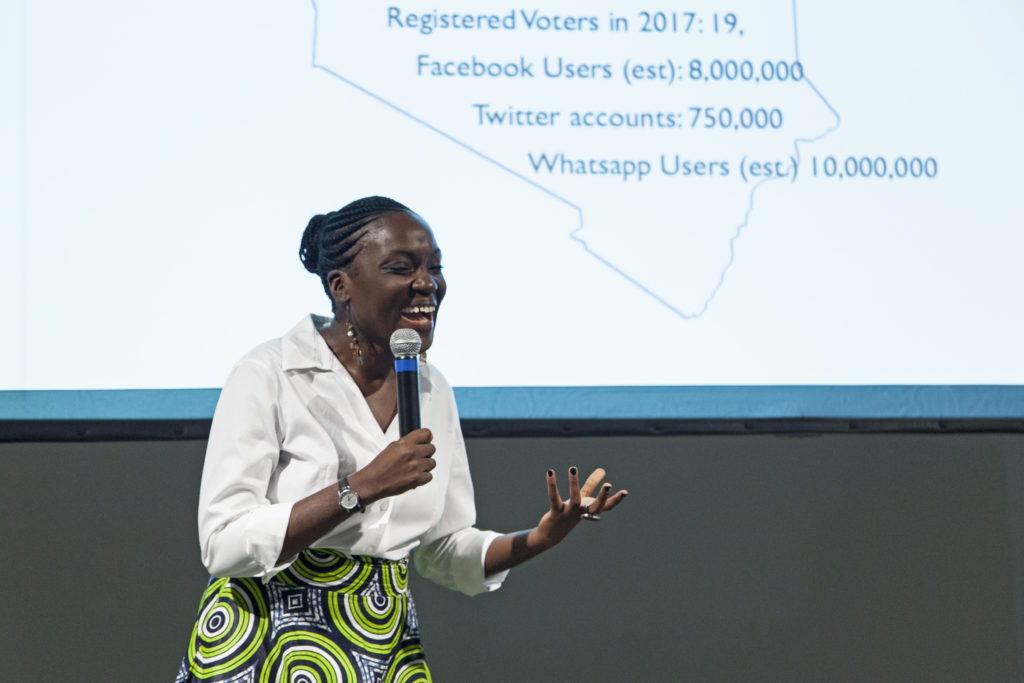
Rafiki, the innovative Kenyan film presented at the Cannes Film Festival, is now the subject of controversy over censorship due to its lesbian storyline. Nyabola is one of the African voices expressing the intention to support the movie’s distribution. “As something new and unexpected, this movie might make certain people within the country feel uncomfortable,” she said, “but it cannot be considered a vehicle for hate, promoting homosexuality in violation of moral values.” It is essential not to confuse actual hate speech with something labelled as hate speech to discredit it. Hate speech is intended to offend, insult, intimidate, or threaten an individual or group based on an attribute, such as sexual orientation, religion, colour, gender, or disability. The writer from Nairobi reminded the audience that when we talk about hate speech, it is important to focus on how it makes people feel and what it wants to accomplish. We should always consider that we regulate hate speech since it creates a condition in which social, political and economic violence is fed, affecting how we think about groups and individuals (and not just because it is offensive).
Nyabola indicated few key factors that she considers able to increase the consequences of hate speech and manipulation on social media. Firstly, information travels fast and can remain insulated. Whilst Twitter is a highly public space where content and comments flow freely, Facebook is a platform where you connect just with a smaller group of people, mostly friends, and WhatsApp is based on groups limited to a small number of contacts. The smaller the interaction sphere is, the harder it is for fact-checkers to see when and where rumours and hate speech go viral. It is difficult to find and stop them and their impact can be calculated just once they have already spread quickly and widely. Challenges which distinguish offline hate speech and manipulation from online ones are also related to the way information moves today among people supporting each other without a counterpart and without anyone being held to account.
Nowadays Kenya boasts an increasingly technological population, though not all rural areas have as yet been able to benefit from the country being one of the most connected ones in sub-Saharan Africa. In this context, reports indicate that since 2013 the British consulting firm Cambridge Analytica had been working in the country to interfere with elections, organizing conventions, orchestrating campaigns to sway the electorate away from specific candidates. It shall be no surprise that the reach of Cambridge Analytica extended well beyond United Kingdom and USA. In her speech, Nyabola expressed her frustration as she sees that western media focus their attention on developing countries just when they fear a threat of violence coming from there, ignoring that the rest of the world is also a place for innovation and decision making too.
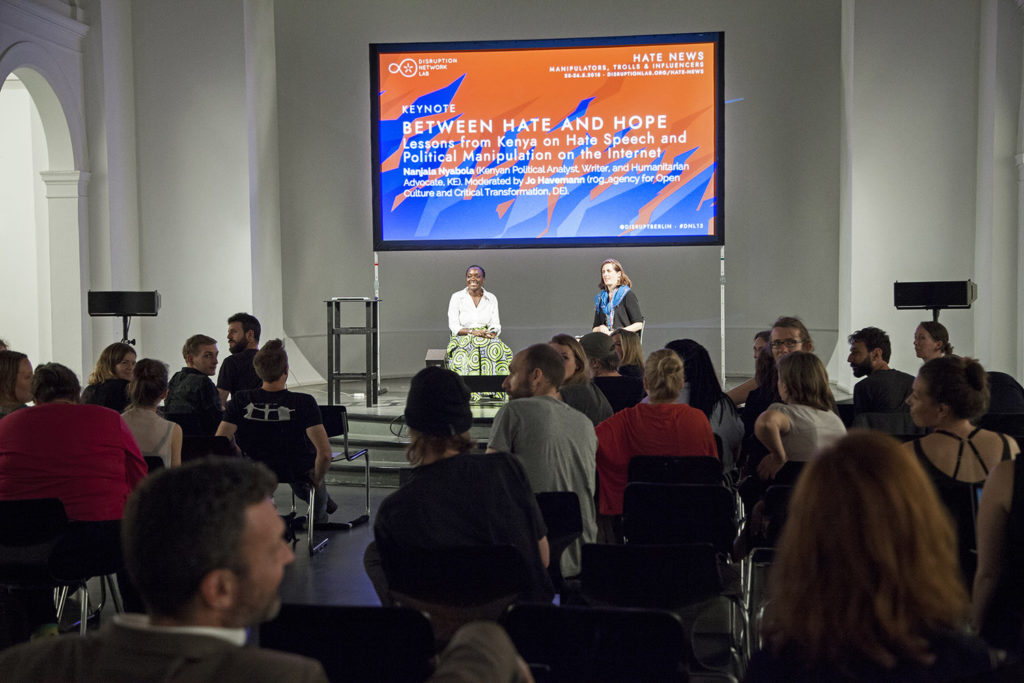
Kenya has one of the highest rates of Internet penetration in Africa with millions of active Kenyan Facebook and Twitter accounts. People using social media are a growing minority and they are learning how to defeat misinformation and manipulation. For them social media can become an instrument for social change. In the period of last year’s election none of the main networks covered news related to female candidates until the campaigns circulating on social media could no longer be ignored. These platforms are now a formidable tool in Kenya used to mobilize civil society to accomplish social, gender and economic equality. This positive look is hindered along the way by the reality of control and manipulation.
Most of the countries globally currently have no effective legal regulation to safeguard their citizens online. The GDPR legislation now in force in the EU obliges publishers and companies to comply with stricter rules within a geographic area when it comes to privacy and data harvesting. In Africa, national institutions are instead weaker, and self-regulation is often left in the hands of private companies. Therefore, citizens are even more vulnerable to manipulation and strategic hate speech. In Kenya, which still doesn’t have an effective data protection law, users have been subject to targeted manipulation. “The effects of such a polluted ecosystem of misinformation has affected and changed personal relationships and lives for good,” said the writer.
On social media, without regulations and control, hatred and discriminations can produce devastating consequences. Kenya is just one of the many countries experiencing this. Hate speech blasted on Facebook at the start of the Rohingya crisis in Myanmar. Nyabola criticized that, as in many other cases, the problem was there for all, but the company was not able to combat the spread of ethnic based discrimination and hate speech.
Moving from the interconnections of traditional and online media in Kenyan misinformation ecosystem, the second part of the day focused on privacy implications of behavioural profiling on social media, covering the controversy about Cambridge Analytica. The Friday’s panel opened with the analyses of David Carroll, best known as the professor who filed a lawsuit against Cambridge Analytica in the UK to gain a better understanding of what data the company had collected about him and to what purpose. When he got access to his voter file from the 2016 U.S. election, he realized the company had been secretly profiling him. Carroll was the first person to receive and publish his file, finding out that Cambridge Analytica held personal data on the vast majority of registered voters in the US. He then requested the precise details on how these were obtained, processed and used. After the British consulting firm refused to disclose, he decided to pursue a court case instead.
As Carroll is a U.S. citizen, Cambridge Analytica took for granted that he had neither recourse under federal U.S. legislation, nor under UK data protection legislation. They were wrong. The legal challenge in British court case that centred on Cambridge Analytica’s compliance with the UK Data Protection Act of 1998 could be applied because Carroll’s data was processed in the United Kingdom. The company filed for bankruptcy not long after it was revealed that it used the data of 87 million Facebook users to profile and manipulate them, likely in contravention of UK law. Professor Carroll could never imagine that his activity would demolish the company.
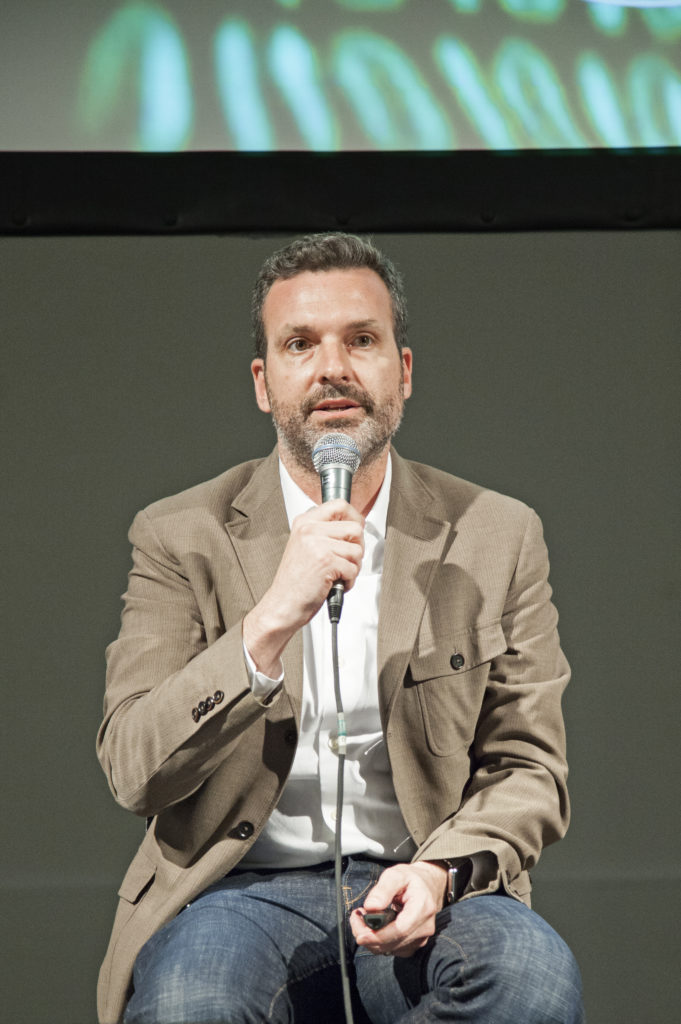
Cambridge Analytica, working with an election management firm called SCL Group, appears to have been a propaganda machine master, able to manipulate voters through the combination of psychometric data. It exploited Facebook likes and interactions above all. Its technique disguised attempts at political manipulation since they were integrated in the online environment.
Carroll talked about how technology and data were used to influence elections and popular voting for the first time in countries like USA and UK, whereas for a much longer time international campaign promoters were hired to act on an international scale. In Carroll’s opinion Cambridge Analytica was an ‘oil spill’ moment. It was an epiphany, a sudden deep understanding of what was happening on a broader scale. It made people aware of the threat to their privacy and the fact that many other companies harvest data.
Since 2012 Facebook and Google have been assigning a DoubleClick ID to users, attaching it to their accounts, de-anonymizing and tracking every action. It is an Ad-tracker that gives companies and advertisers the power to measure impressions and interactions with their campaigns. It also allows third-party platforms to set retargeting ads after users visit external websites, integrated with cookies, accomplishing targeted profiling at different levels. This is how the AdTech industry system works. Carroll gave a wide description of how insidious such a technique can be. When a user downloads an app to his smartphone to help with sport and staying healthy, it will not be a secret that what was downloaded is the product of a health insurance or a bank, to collect data of potential customers, to profile and acquire knowledge about individuals and groups. Ordinary users have no idea about what is hidden under the surface of their apps. Thousands of companies are synchronizing and exchanging their data, collected in a plethora of ways, and used to shape the messages that they see, building up a tailor-made propaganda that would not be recognizable, for example, as a political aid. This mechanism works in several ways and for different purposes: to sell a product, to sell a brand or to sell a politician.
In this context, Professor Carroll welcomed the New European GDPR legislation to improve the veracity of the information on the internet to create a safer environment. In his dissertation, Carroll explained that the way AdTech industry relates to our data now contaminates the quality of our lives, as singles and communities, affecting our private sphere and our choices. GDPR hopefully giving consumers more ownership over their data, constitutes a relevant risk for companies that don’t take steps to comply. In his analyses the U.S. professor pointed out how companies want users to believe that they are seriously committed to protecting privacy and that they can solve all conflicts between advertising and data protection. Carroll claimed though that they are merely consolidating their power to an unprecedented rate. Users have never been as exposed as they are today.
Media companies emphasize the idea that they are able to collect people’s data for good purposes and that – so far – it cannot be proved this activity is harmful. The truth is that these companies cannot even monitor effectively the Ads appearing on their platforms. A well-known case is the one of YouTube, accused of showing advertisements from multinational companies like Mercedes on channels promoting Nazis and jihad propaganda, who were monetizing from these ads.
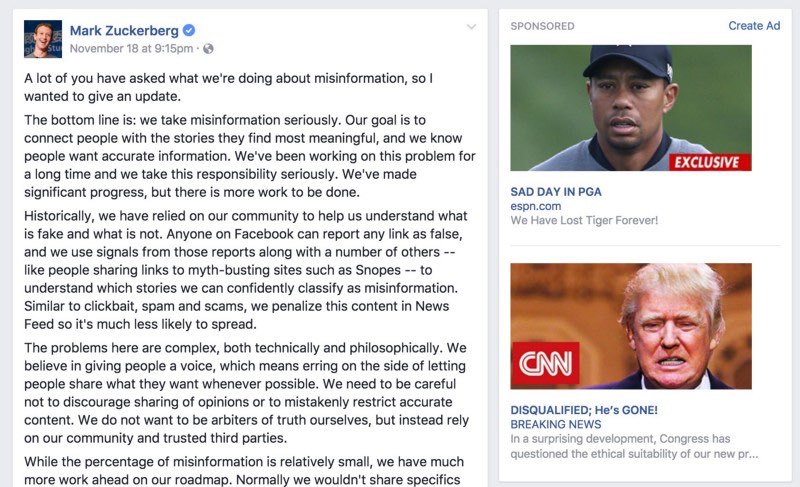
Carroll then focused on the industry of online advertisement and what he called “the fraud of the AdTech industry.” Economic data and results from this sector are unreliable and manipulated, as there are thousands of computers loading ads and making real money communicating to each other. This generates nowadays a market able to cheat the whole economy about 11 billion dollar a year. It consists of bots and easy clicks tailor-made for a user. The industries enabled this to happen and digital advertising ecosystem has evolved leading to an unsafe and colluded environment.
Alphabet and Facebook dominate the advertising business and are responsible for the use of most trackers. Publishers as well as AdTech platforms have the ability to link person-based identifiers by way of login and profile info.
Social scientists demonstrated that a few Facebook likes can be enough to reveal and accurately predict individual choices and ideas. Basic digital records are so used to automatically estimate a wide range of personal attributes and traits that are supposed to be part of a private sphere, like sexual orientation, religious beliefs, or political belonging. This new potential made politicians excited and they asked external companies to harvest data in order to generate a predictive model to exploit. Cambridge Analytica’s audience-targeting methodology was for several years “export-controlled by the British government”. It was classified as weapon by the House of Commons, at a weapons-grade communications tactics. It is comprehensible then that companies using this tech can easily sell their ability to influence voters and change the course of elections, polarizing the people using social networks.
The goal of such a manipulation and profiling is not to persuade everybody, but to increase the likelihood that specific individuals will react positively and engage with certain content, becoming part of the mechanism and feeding it. It is something that is supposed to work not for all but just for some of the members of a community. To find that small vulnerable slice of the U.S. population, for example, Cambridge Analytica had to profile a huge part of the electorate. By doing this it apparently succeeded in determining the final results, guiding and determining human behaviours and choices.
Bernd Fix, hacker veteran of the Chaos Computer Club in Germany, entered the panel conversation describing the development from the original principle of contemporary cybernetics, in order to contextualize the uncontrollable deviated system of Cambridge Analytica. He represented the cybernetic model as a control theory, by which a monitor compares what is happening into a system with a standard value representing what should be happening. When necessary, a controller adjusts the system’s behaviour accordingly to again reach that standard expected by the monitor. In his dissertation, Fix explained how this model, widely applied in interdisciplinary studies and fields, failed as things got more complex and it could not handle a huge amount of data in the form of cybernetics. Its evolution is called Machine Learning (or Artificial Intelligence), which is based on the training of a model (algorithm) to massive data sets to make predictions. Traditional IT has made way for the intelligence-based business model, which is now dominating the scene.
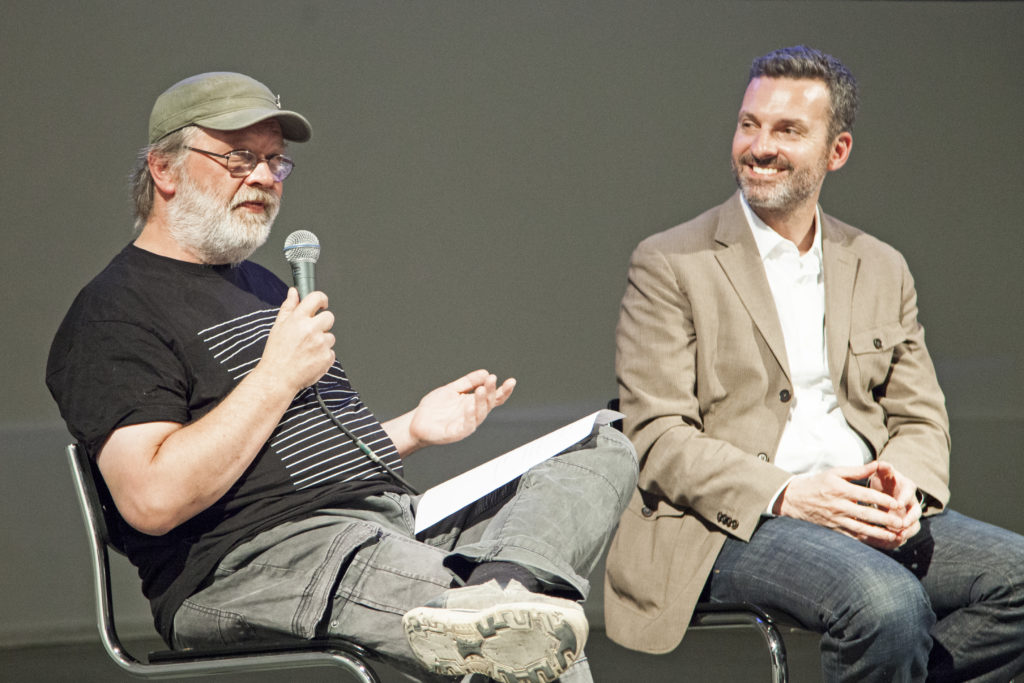
Machine learning can prognosticate with high accuracy what it is asked to, but – as the hacker explained – it is not possible to determine how the algorithm achieved the result. Nowadays most of our online environment works through algorithms that are programmed to fulfil their master’s interests, whereas big companies collect and analyse data to maximize their profit. All the services they provide, apparently for free, cost users their privacy. Thanks to the predictive model, they can create needs which convinces users to do something by subtle manipulating their perspective. Most of the responsibilities are on AdTech and social media companies, as they support a business model that is eroding privacy, rights and information. The challenge is now to make people understand that these companies do not act in their interest and that they are just stealing data from them to build up a psychometric profile to exploit.
The hacker reported eventually the scaring case of China’s platform “social credit,” designed to cover every aspect of online and offline existence and wanted by the national authorities. It is supposed to monitor each person and catalogue eventual “infractions and misbehaviours” using an algorithm to integrate them into a single score that rates the subjective fidelity into accepted social standards. A complex kind of ultimate social control, still in its prototype stages, but that could become part of our global future where socio-political regulation and control are governed by cybernetic regulatory circuits. Fix is not convinced that regulation can be the solution: to him, binding private actors and authorities to specific restriction as a way to hold them accountable is useless if people are not aware of what is going on. Most people around us are plugged into this dimension where the bargain of data seems to be irrelevant and the Big Three – Google, Facebook and Amazon – are allowed to self-determine the level of privacy. People are too often happy consumers who want companies to know their lives.
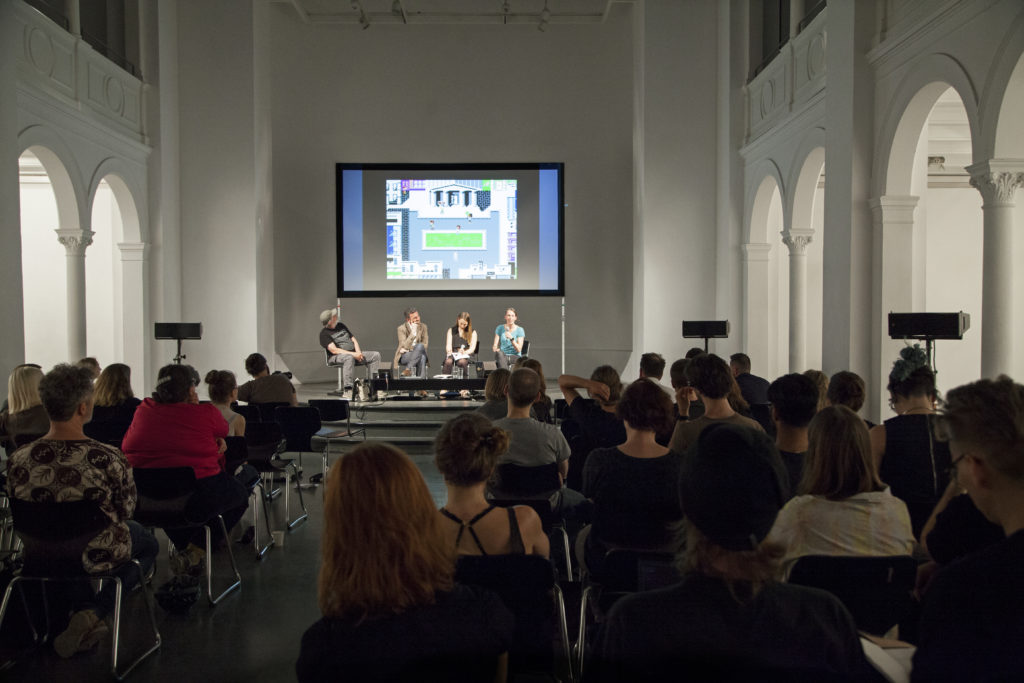
The last panellist of the afternoon was the artist and researcher Marloes de Valk, who co-developed a video game for old 1986 Nintendo consoles, which challenges the player to unveil, recognize and deconstruct techniques used to manipulate public opinion. The player faces the Propaganda Machine, level after level, to save the planet.
“Acid rains are natural phenomena”, “passive smoke doesn’t affect the health,” “greenhouse´s effects are irrelevant.” Such affirmations are a scientific aberration nowadays, but in the ‘80s there were private groups and corporations struggling to make them look like legitimate theorizations. The artist from Nederland analysed yesterday´s and today’s media landscape and, basing her research on precise misinformation campaigns, she succeeded in defying how propaganda has become more direct, maintaining all its old characteristics. De Valk looked, for example, for old documents from the American Tobacco Institute, for U.S. corporations‘leaked documents and also official articles from the press of the ´80s.
What remains is a dark-humoured game whose purpose is that of helping people to orientate inside the world of misinformation and deviated interests that affects our lives today. Where profit and lobbyism can be hidden behind a pseudoscientific point of view or be the reason rumours are spread around. The artist and researcher explained that what you find in the game represents the effects of late capitalism, where self-regulation together with complacent governments, that do not protect their citizens, shape a world where there is not room for transparency and accountability.
In the game, players get in contact with basic strategies of propaganda like “aggressively disseminate the facts you manufactured” or “seek allies: create connections, also secret ones”. The device used to play, from the same period of the misinformation campaigns, is an instrument that reminds with a bit of nostalgia where we started, but also where we are going. Things did not change from the ‘80s and corporations still try to sell us their ready-made opinion, to make more money and concentrate more power.
New international corporations like Facebook have refined their methods of propaganda and are able to create induced needs thus altering the representation of reality. We need to learn how to interact with such a polluted dimension. De Valk asked the audience to consider official statements like “we want to foster and facilitate free and open democratic debate and promote positive change in the world” (Twitter) and “we create technology that gives people the power to build community and bring the world closer together” (Facebook). There is a whole narrative built to emphasize their social relevance. By contextualising them within recent international events, it is possible to broad the understanding of what these companies want and how they manipulate people to obtain it.
What is the relation between deliberate spread of hate online and political manipulation?
As part of the Disruption Network Lab thematic series “Misinformation Ecosystems” the second day of the Conference investigated the ideology and reasons behind hate speech, focusing on stories of people who have been trapped and affected by hate campaigns, violence, and sexual assault both online and offline. The keynote event was introduced by Renata Avila, international lawyer from Guatemala and a digital rights advocate. Speaker was Andrea Noel, journalist from Mexico, “one of the most dangerous countries in the world for reporters and writers, with high rates of violence against women” as Avila remembered.
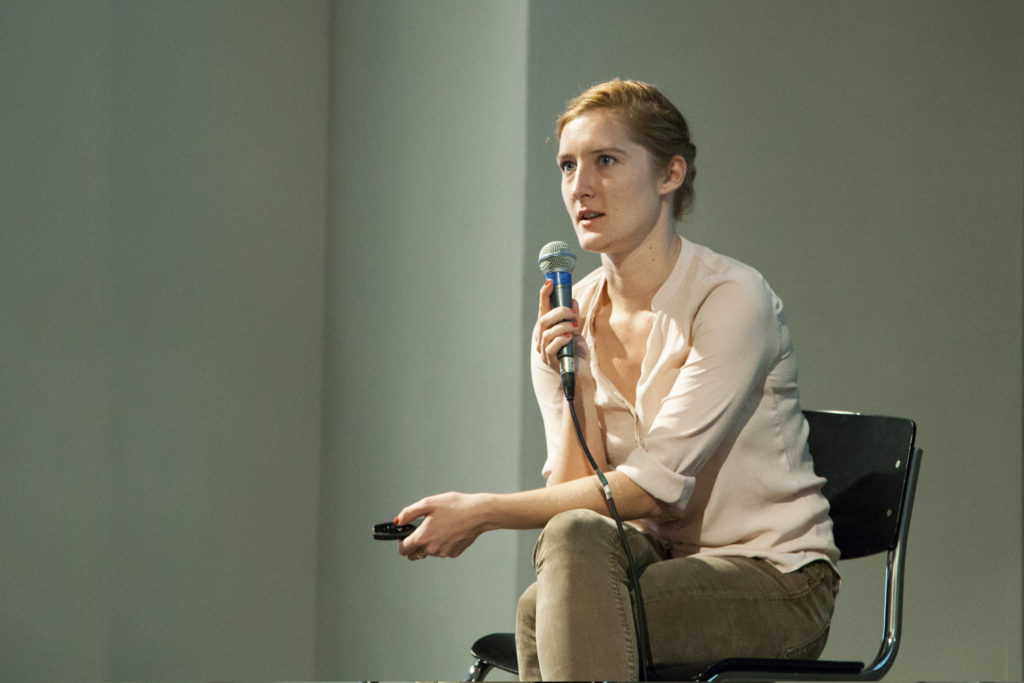
Noel has spent the last two years studying hate speech, fake news, bots, trolls and influencers. She decided to use her personal experience to focus on the correlation between misinformation and business, criminal organizations and politics. On March 8, 2016 it was International Women’s Day, and when Noel became a victim of a sexual assault. Whilst she was walking down the street in La Condesa (Mexico City) a man ran after her, suddenly lifted up her dress, and pulled her underwear down. It all lasted about 3 seconds.
As the journalist posted on twitter the surveillance footage of the assault commenting: “If anyone recognizes this idiot please identify him,” she spent the rest of the evening and the following morning facing trolls, who supported the attacker. In one day her name became trend topic on twitter on a national level, in a few days the assault was international news. She became so subject of haters and target of a misogynistic and sexist campaign too, which forced her to move abroad as the threat became concrete and her private address was disclosed. Trolls targeted her with the purpose of intimidating her, sending rape and death threats, pictures of decapitated heads, machetes and guns.
In Mexico women are murdered, abused and raped daily. They are victims of family members, husbands, authorities, criminals and strangers. Trolls are since ever active online promoting offensive hashtags, such as #MujerGolpeadaMujerFeliz, which translates as ‘a beaten woman is a happy woman’. It is a spectrum of the machismo culture affecting also many Latin American countries and the epidemic of gender-based violence and sexual assault.
Facts can be irrelevant against a torrent of abuse and hate toward journalists. Noel also received hundreds of messages telling her that there was a group of famous pranksters named “master trolls” that used to assault people on the streets in that same way, to make clicks and money out of it. Noel found out that they became best known for pulling down people’s pants and underwear in public, and that this brought them directly to popular tv shows. A profitable and growing business.
The journalist decided to face her trolls one by one and later realized that they were mostly part of an organized activity, not from a TV show but from a political group targeting her, a fact that made everything way more intricate. In two years she “got to know her trolls” as she said, and she studied their ecosystem. The description of the whole story is available on podcast Reply All.
Moving from her story, Noel focused in her second part of dissertation on the relation linking together trolls, criminal organizations, political and social manipulation. She described how, by using algorithms, bots and trolls, it is possible to generate political and election related postings on Facebook and Twitter that go viral. Manipulation comes also by weaponizing memes to propel hate speech and denigration, creating false campaigns to distract public attention from real news like corruption and atrocious cartel crimes.
Marginal voices and fake news can be spread by inflating the number of retweets and shares. Hashtags and trends are part of orchestrated system, where publishers and social media are not held in account for the fraud. Automated or semi-automated accounts, which manipulate public opinion by boosting the popularity of online posts and amplifying rumours. There is a universe of humans acting like bots, controlling hundreds of fake accounts.
Noel is particularly critical against Twitter. Its legal team expressed their engagement facing this “new major problem and novel threats”. The journalist hypothesized that the company had been well aware of the issue since 2010 but decided not to intervene to weed out organized groups manipulating its environment. Moreover, they knew that organized campaigns of discredit can water down the impact of real grassroot spontaneous protests and movements.
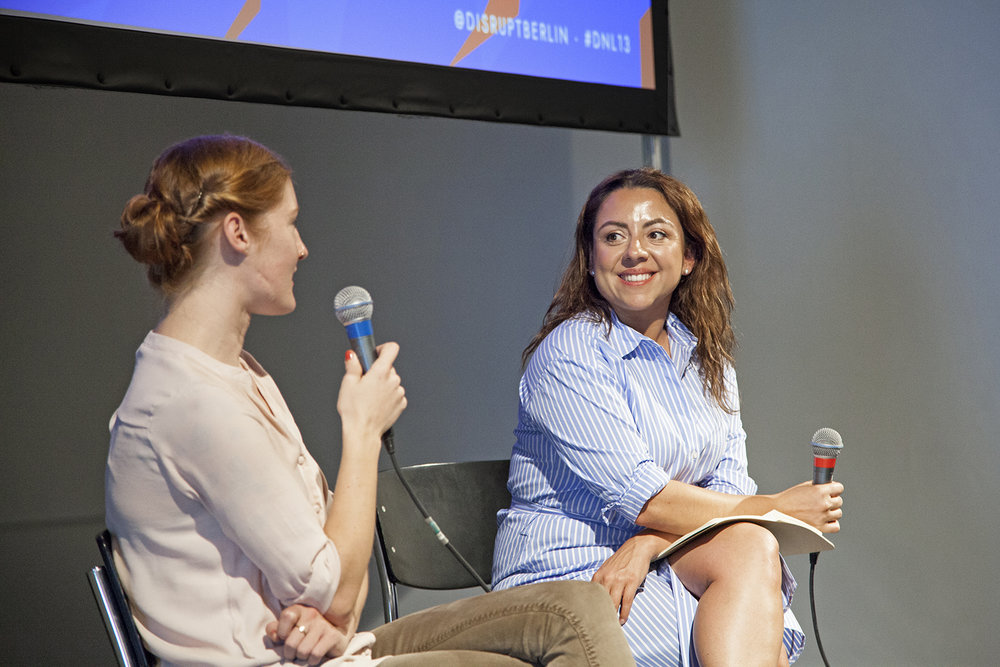
These manipulation techniques are responsible for digitally swaying the 2016 election toward the candidate Peña Nieto, organizing an army of thousands of bots to artificially generate trends on Twitter. Trends on this social media move up and down based on the number of tweets in a topic or hashtag related to the speed of sharing or retweeting. Trolls and bots can easily control the trending topic mechanism with their intense spamming activity.
Noel reported that false stories are shared via WhatsApp too, they are difficult to track and the most challenging to debunk. Her portrayal of social media and information market is not different from the description on the first day of the Conference by the writer Najala Nyabola.
To see the future of social media manipulation in politics we need to look at Mexico. All parties in Mexico have used bots to promote their own campaigns, journalists and opponents are overwhelmed with meaningless spam and denigrating hashtags. Offline, media landscape across Mexico is not free and organised crime has been using propaganda and manipulation to further its own aims. President Peña Nieto’s administration spent hundreds of millions of dollars on advertising, making media dependent and colluded. This system suppresses investigative articles and intimidates reporters.
The next general election is scheduled for July 1st. Andrea Noel warned that manipulation, trolls and bots are already irreversibly polluting the debate, in a country where more than 100 candidates have already been murdered (at the time of the Conference) and a history of corruption makes media and authorities unreliable in the eyes of people.
As a response, universities and NGOs formed an anti-fake news initiative called “Verificado” a platform that encourages people to forward stories found on social media using the hashtag #QuieroQueVerifiquen, ‘I want you to verify this’. The researchers of this project answer with fact-checking and publish their findings online. When asked, Noel expressed appreciation for the efforts of organizations and civil society. However, she is becoming increasingly disillusioned. She can see no immediate prospect of finding solutions able to slow or halt the impact of misinformation and hate speech online. In her opinion projects like Verificado can be easily hijacked. On the other side genuine social media campaigns are still an effective tool in the hands of civil society but the lack of trust in media fed by corruption often undermines all efforts to mobilize society, leading the public to routinely dismiss initiative to fight injustice.
When asked about the possibility to shut down social networks as a solution, Noel could not say she did not think of it. A first step could be to oblige media like Twitter and Facebook to guarantee users a safe environment where the economic interest comes after the need of a hate speech and manipulation free environment. The way they operate confirms they are content platforms and as such media entities they lack of transparency and accountability. These companies shirk their obligation for publishing responsibly. They should be held to account when they spin lies and allow groups to act unethically or against target single or communities.
The program of the second day continued with the presentation of the documentary The Cleaners, by Hans Block and Moritz Riesewieck, a project started in 2013 and in the cinemas at the time of the Conference. Initially, the authors wanted to learn more about the removal of pedo-pornographic content and sexualised images of children on Facebook. Social networks have largely pledged to work harder to identify and remove illegal, offensive and improper content, to limit violations and deny hate speech. But how does it work? Who decides what shall be cancelled and on what basis? These questions arose frequently during the first part of the Hate News conference and the German authors could answer it in relation to the social media Facebook, subject of their documentary.
The choice about what shall and what shall not belong the internet is a subjective one. Content moderators, who censor postings and content on platforms like Facebook, have indeed a controversial and central role. Their work is subject to almost no open scrutiny. However, it shapes attitudes and trends of both individuals and social groups, impacting the public discourse and the cultural dialectic. When a social network decides to censor content and delate videos about the effects of drone bombings, since by showing civilian victims Daesh builds its propaganda, it makes a choice that affects the narration of events and the perception of facts.
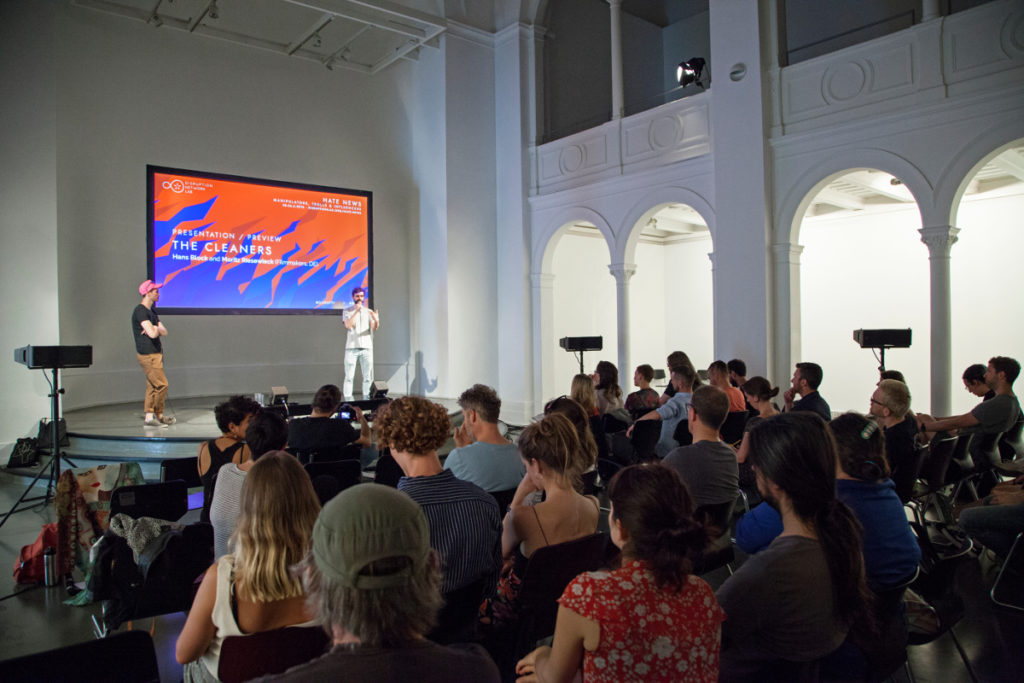
Investigating how the social media platform Facebook polices online content, and the direct impact of these decisions on the users’ interactions, Block and Riesewieck ended up in the Manila, where Facebook boasts its biggest department for content moderation, with more than 10,000 contractors. The Cleaners shows how this platform sees its responsibilities, both toward people moderating and censoring the content and its users. Based on interviews with Philippine content moderators at work, the documentary contributes to the debate about the public responsibilities of social media and online platforms for publishing, from political manipulation and propaganda to data protection.
Humans are still the first line of content moderation and they suffer horrible consequences and traumas for they see daily the worst of the web. Companies like Facebook have developed algorithms and artificial-intelligence tools able to work as a first level, but the most of this technology cannot substitute human capabilities. Certain content moderators describe themselves as custodians of moral values, as their work turns into decisions that can shape social media and consequently society. There are indeed countries where people consider Facebook as the Internet, ignoring that the world wide web is much more than that social media.
The authors go beyond, showing that Manila cleaners are influenced by their cultural background and social believes. They build a parallel between Philippines’ Catholicism and discourse about universal enslavement of humans to God and sacrifice, photographed in the years of the government of Rodrigo Duterte, controversial president who is leading a war against drugs and moral corruption, made of extrajudicial killings and a violent, abusive approach.
Despite denials by the company, cleaners in Manila also moderate Europeans’ posts and they are trained for that. A single world, a historical reference, together with a picture can make all the difference between an innocent joke and hate speech. Whilst memes can be used as weapons, for example by the alt-right groups or by reactionary movements against gender equality, cleaners have just few seconds to decide between removing and keeping a content, checking more than 35,000 images per day. The authors of the documentary explained how it is almost impossible for them to contextualize content. As a result, there is almost no control over their work, as a team leader can just proof 3% of what a cleaner does.
The last panel closing the conference on the second day was moderated by the curator, artist and writer Margarita Tsomou. American independent online harassment researcher Caroline Sinders focused her dissertation on online protests and political campaigns in the frame of the hate speech discourse. She recalled recent events able to pollute the public debate by creating chaotic and misleading messages to enhance a reactionary anti-progressive culture. Misogyny thrives on social media and hatred of women and entrenched prejudice against them are everywhere in the Internet. Fake online campaigns are often subtly orchestrated targeting women.
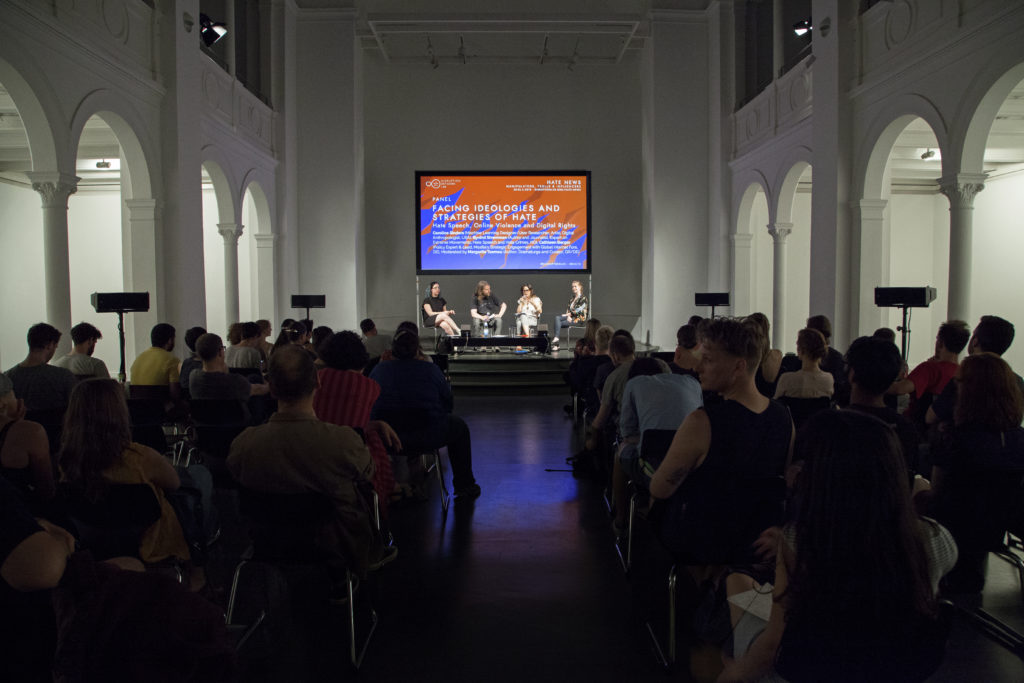
In 2014 on social networks appeared an organised action associated with the hashtag #EndFathersDay, presented as a feminist political campaign to eradicate the celebration of Father’s Day as a “celebration of patriarchy and oppression”. That campaign had nothing to do with feminism and grassroots movements, it was a harassment campaign against women, a fake with manipulated images and hundreds of trolls to feed a sentiment of hatred and hostility against activists for civil rights and equality.
It is not the only case of its genre. The #Gamergate campaign, that in 2014 targeted several women from the video game industry (on Twitter, Reddit, 4chan, and 8chan) falls into this context. The campaign was not immediately perceived as a harassment instrument due to attempts of making it appear as a movement against political correctness and bad journalistic ethics. It was though a misogynistic reactionary campaign against female game developers, that soon revealed its true face as right-wing sexist backlash. Under this hashtag women were indeed victims of doxing, threats of rape and death.
Sinders explained that in the last several years we have seen a shift from a sectorial market to a global dimension where we are all potentially identifiable as gamers. Video games and gaming culture are now mainstream. People are continuously connected to all kind of devices that enable the global gaming industry to generate more than 100 billion dollar every year. The Gamergate controversy reopened the debate that gaming is a world for (white) males, pointing out how the video game industry has a diversity problem, as sexism, racial and gender discrimination in video game culture appear to be a constant factor.
A relevant aspect of the controversy is related to how trolls organised and tried to reframe the narrative of the harassment campaign. Instead of a misogynistic and violent action, they claimed it was about journalistic integrity and candid reviewing, thus denouncing a collusion between the press and feminists and social critics. Most of the trolls and supporters were anonymous, ensuring that the campaign be defined merely by the harassment they have committed against women and as a reaction to what they reported as the increasing influence of feminism on video game culture.
Sinders concluded her speech explaining that organised actions and campaigns like those described above are structured on precise tactics and harassment techniques that have already entered in our vocabulary. Words like doxing, swatting, sealioning and dogpiling are neologisms that describe strategies of hate speech and harassment nowadays common.
The Norwegian journalist Øyvind Strømmen, author and managing editor of Hate Speech International, has extensively researched and written about how extreme right movements and religious fundamentalism are able to build an effective communication online and use the web as an infrastructure to strategically enhance their activities. He joined the panel explaining that despite his intense international activity, he has never been subjected to harassment and death threats like his female colleagues, whilst he finds daily-organised activities to sow hatred and intolerance to repress women.
Cathleen Berger, former International cyber policy coordination staff at the German Foreign Office and currently lead of Mozilla’s strategic engagement with global Internet fora, closed the conference with an analyses of the new German NetzDG legislation, defined by media as an extreme example of efforts by governments to make social media liable for what circulates on their pages. The law was adopted at the end of 2017 to combat illegal and harmful content on social media platforms. It is defined also as anti-hate-speech law as it was written in the historical context of the refugees’ mass migration to Europe and the new neo-nazi propaganda from political formations like the Alternative for Germany (AfD). At the time, fake news and racist material were shared online on several mainstream channels for the first time, with relevant impact on public opinion.
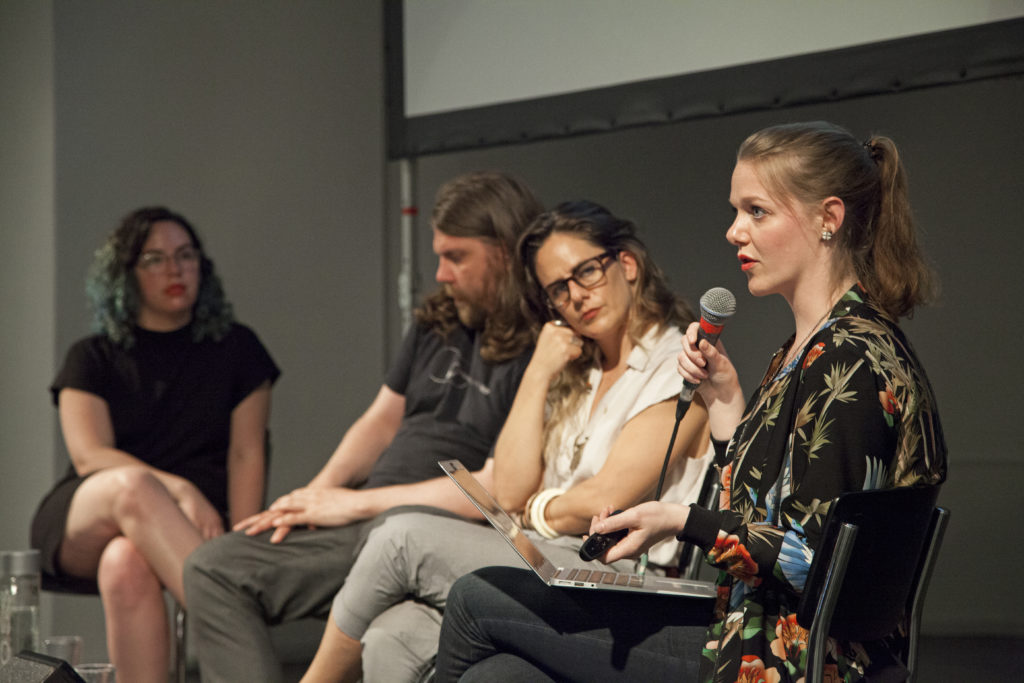
The new German law requires social media companies to provide users with a wide-ranging complaints structure to make sure that discriminatory and illegal posts can quickly be reported. It is left to social media platforms to decide if a certain reported content represents a promotion of or an incitement to terrorism, child abuse, hate or discrimination of any kind.
The law forces social media to act quickly too. Under NetzDG, social media platforms with more than 2 million users in Germany have 24 hours to remove posts reported by users for being illegal. Facebook, Twitter and YouTube seem to be the law’s main focus. Failure to comply with the law carries a fine up to € 50 million.
The German government’s Network Enforcement Act has been criticised for its risks of controversial inadvertent censorship, limiting legitimate expressions of opinion and free speech. Once again private companies, that are neither judges nor any kind of public authority, have the power to decide whether reported content is in fact unlawful.
All credit is due to Tatiana Bazzichelli and the Disruption Network Lab, who provided once again a forum for discussion and exchange of information that provokes awareness on matters of particular concern from the different perspectives of the guests – especially women – able to photograph with their international activities and their researches several topical issues.
This 13th Conference (https://www.disruptionlab.org/hate-news/) was a valid opportunity to discuss and rationalise the need for civil society to remain globally vigilant against new forms of hate speech, manipulation and censorship. Ideological reasons behind hate speech and online manipulation are on the table and the framing is clear enough to hold online media and publishing companies accountable for the spread of frauds, falsehood and discrimination within their networks.
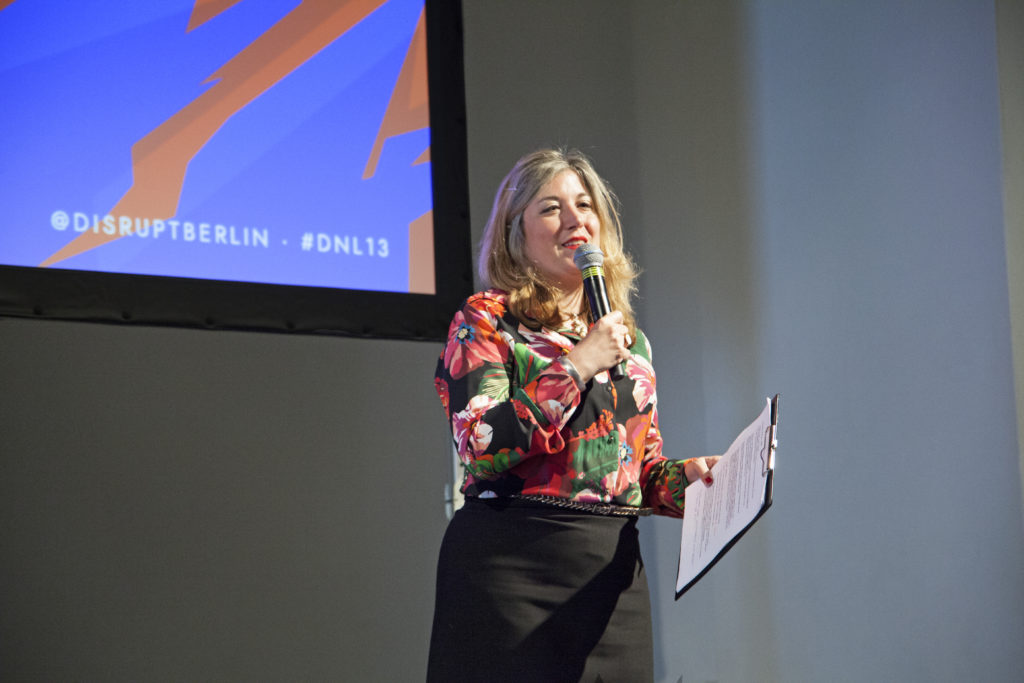
Companies like Facebook and Twitter have demonstrated their inability to recognise real threats and appear to be thinking of profit and control without considering the repercussions that their choices have. However, we are delegating them the power to define what is legal and what is not. Their power of censorship shapes society, interfering with fundamental rights and freedoms, feeding conflicts and polarization. This legal response to hate speech and manipulation in the context of the battle for privacy and civil rights is completely inadequate.
Propaganda and hate speech have historically been tools used in all countries to influence decision making and to manipulate and scare public opinion. Forms of intrusive persuasion that use rumours or manipulation to influence people’s choices, beliefs and behaviours are now occupying the web too. Individuals should be able to give due value to their online interactions, focusing on the risks that they run when they click on something. There is too little awareness of how companies, aggressive trolls, criminals, private groups and advertisers subtly manipulate online environment for political and economic interest.
Such a corrupted online ecosystem – where almost nothing of what we meet can be trusted and where individuals and communities are exposed to private interest – generates often hate campaigns targeting women and minorities, normalising crimes, reactionary gender stereotyping and deplorable cultural customs. As all speakers suggested, Cyber-ethnography can be a worthwhile tool as an online research method to study communities and cultures created through computer-mediated social interaction. It could be helpful to study local online exchanges and find local solutions. By researching available data from its microcosmos, it is possible to prevent ethnic, socioeconomic, and political conflicts linked to the online activity of manipulators, destructive trolls and influential groups, to disrupt the insularity of closed media and unveil the economic and political interest behind them.
HATE NEWS: Manipulators, Trolls & Influencers
May 25-26, 2018 – Kunstquartier Bethanien, Berlin
disruptionlab.org/hate-news/
Info about the 13th Disruption Network Lab Conference, its speakers and thematic is available online here:
https://www.disruptionlab.org/hate-news
To follow the Disruption Network Lab sign up for its Newsletter and get informed about its Conferences, ongoing researches and projects. The next Disruption Network Lab event is planned for September. Make sure you don´t miss it!
The Disruption Network Lab is also on Twitter and Facebook
Photocredits: Maria Silvano for Disruption Network Lab
Our times are characterized by the accelerating collapse and redrawing of multiple borders: between nation states, personal identities, and the responsibilities we have for each other. Also between the old distinctions, work and pleasure.
Some leaders as part of the new world order, tell us through their political actions and their fashion accessories, that they “Just Don’t Care”. This “political art-form”1 of not caring permits an insidious spread of hatred online and on the ground. In recent times, the digital condition has lent it’s networks and platforms to this poisonous, rhetorical hyperbole, turning against immigrants, and others who do not fit into the framework of a western world, oligarch orientated vision. Mass extraction and manipulation of social data has facilitated the circulation of fake news and the production of fear, anxiety and uncertainty. Together these fuel the machine of structural violence adding to the already challenging conditions created by Austerity policies, growing debt and poverty.
In the face of these outlandish difficulties our digital tools and networks – taken up with a spirit of cultural comradeship. More inspiring narratives are emerging from across disciplines and backgrounds, to experiment with new solidarity-generating approaches that critique and build platforms, infrastructures and networks, offering new possibilities for reassessing and re-forming citizenship and rights.
The exhibition and labs for Playbour – Work, Pleasure, Survival, have created new contexts for collaboration. Artists (from the local area and internationally), game designers and architects, come together with researchers from psychology and neuroscience addressing the data driven gamification of life and everything.
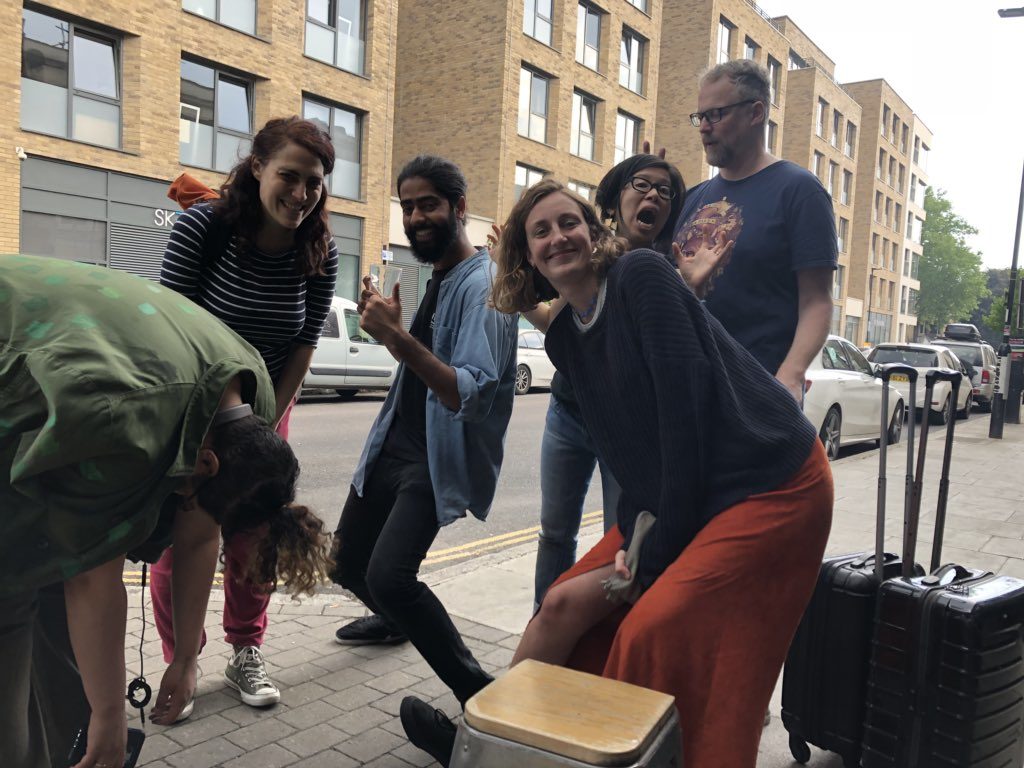
In her interview, the curator Dani Admiss discusses how they reassess the power relationships of the gallery, park users and the local authorities, asking who owns the cultural infrastructure and public amenities – and so create a polemic to open up questions of public value. The exhibition is open every weekend through 14 July to 19 August 2018.
The artists featured in Transnationalisms exhibition curated by James Bridle address the effect on our bodies, our environment, and our political practices of unstable borders.
“They register shifts in geography as disturbances in the blood and the electromagnetic spectrum. They draw new maps and propose new hybrid forms of expression and identity.”2

“Thiru Seelan, a Tamil refugee who arrived in the UK in 2010 following detention in Sri Lanka during which he was tortured for his political affiliations, dances on an East London rooftop. His movements are recorded by a heat sensitive camera more conventionally often used to monitor borders and crossing points, where bodies are identified through their thermal signature.”3
The show opens at Furtherfield from September 14th to October 26th 2018, touring as part of State Machines the EU cooperation which investigates the new relationships between states, citizens and the stateless made possible by emerging technologies.
We have another interview with artist and activist Cassie Thornton, where we discuss her current project Hologram, which examines health in the age of financialization, and works to reveal the connection between the body and capitalism. Her interview focuses on a series of experiments that actively counter the effects of indebtedness through somatic – or body – work including her focus on the way in which institutions produce or take away from the health of the artists and workers they “support”.
“In my work for the past decade, I have been developing practices that attempt to collectively discover what debt is and how it affects the imagination of all of us: the wealthy, the poor, the indebted, financial workers, babies, and anyone in-between.” Thornton
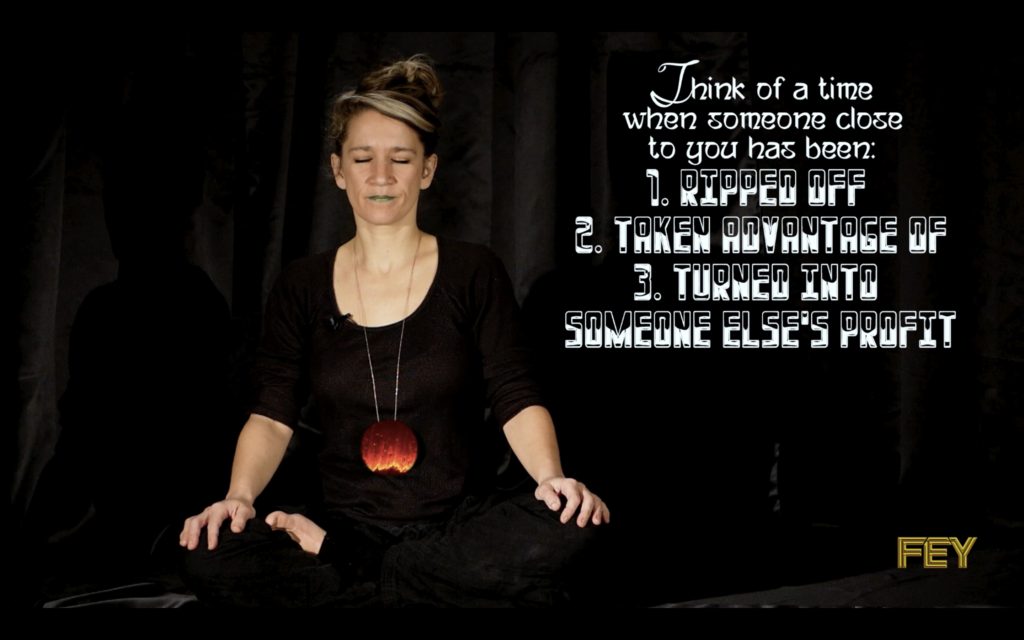
Finally I interview Tatiana Bazzichelli, artistic director and curator of the Disruption Network Lab, in Berlin, questions about art as Investigation of political misconducts and Wrongdoing. Since 2015, the Disruption Network Lab has cultivated a stage and a sanctuary for otherwise unheard and stigmatised voices to delve into and explore the urgent political realities of their existence at a time when the media establishment has no investment in truth telling for public interest.
“When the speakers are with us and open their minds to our topics, I feel that we are receiving a gift from them. I come from a tradition in which communities, networks and the sharing of experience were the most important values, the artwork by themselves.” Bazzichelli.
The programme creates a conceptual and practical space in which whistleblowers, human right advocates, artists, hackers, journalists, lawyers and activists are able to present their experience, their research and their actions – with the objective of strengthening human rights and freedom of speech, as well as exposing the misconduct and wrongdoing of the powerful.
To conclude, all one needs to say is…
“Whether in the variety of human, backgrounds and perspectives, biodiversity or diversity of technologies, coding languages, devices, or technological cultures. Diversity is Proof of Life.” Ruth Catlow, 2018.
In this interview with Tatiana Bazzichelli, artistic director and curator of the Disruption Network Lab, in Berlin, we discuss questions about art as a process for investigating political misconduct and wrongdoing.
Disruption Network Lab is an ongoing platform of events and research focused on art, digital rights, hacktivism and disruption. So far, they have hosted twelve conference events in Berlin and one in London. The programme creates a conceptual and practical space in which whistleblowers, human right advocates, artists, hackers, journalists, lawyers and activists are able to present their experience, their research and their actions – with the objective of strengthening human rights and freedom of speech, as well as exposing the misconduct and wrongdoing of the powerful. The programme has been covering topics such as the drone war, whistleblowing, counter-surveillance, ISIS media propaganda, hate speech, and artistic and activist strategies in times of increased geopolitical control (see: disruptionlab.org).
Marc Garrett: Why do we need the Disruption Network Lab now?
Tatiana Bazzichelli: The goal of the Disruption Network Lab is to present and to generate new possible routes of social and political action within the framework of hacktivism, digital culture and information technology, focusing on the disruptive potential of artistic practices. We aim to investigate projects that disrupt the field of information technology in unexpected ways, shedding light on interventions that provoke political and social change from within closed systems. The curatorial strategy aims to connect and to bring into dialogue experts that unfold inner structures of political, economical and technological systems, therefore promoting an in-depth understanding of digital culture in everyday life and society.
I believe that the Disruption Network Lab is necessary because we create a dialogue among people and practices that not necessarily meet often. For example, we connect whistleblowers and artists, policy makers and hackers, investigative journalists and activists. Most of the time, these people are acting within specific scenes, without having occasions of exchange. The curatorial methodology is based on a montage of practices, as well as of fieldwork, to create a conceptual network of multiple points of view.
Each event starts with an in-depth investigation of a subject that is pressing and urgent, and that sometimes needs to be revealed or exposed to the general public. It is not only about organising events, but also to research on what is important to cover according to what is happening in politics, culture and society at a specific moment.
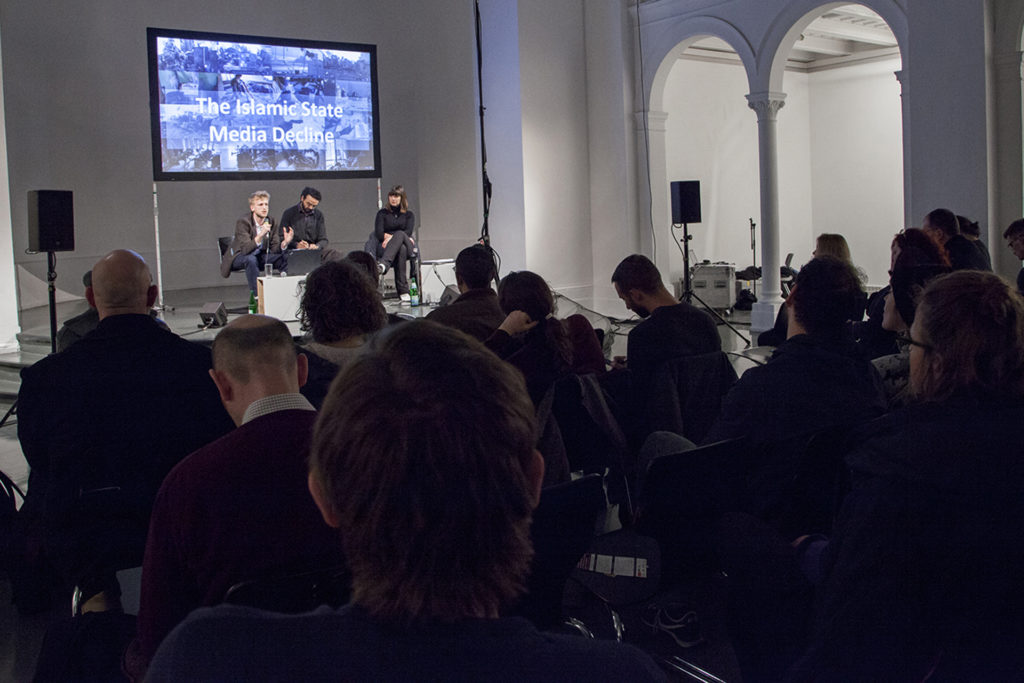
MG: An aspect I find really interesting about DNL is its investigative approach. It deals with those current issues usually tackled by journalism, but manages to go much deeper through the lab and conference formats. It also bridges other political, economical and technological systems, and digital culture. I’m wondering why you’ve chosen an investigative approach?
TB: Our aim is not only to comment on subjects of analysis, but to invite people that experience such subjects themselves, often at a high personal risk, and are able to offer to the public concrete advice and countermeasures that go beyond theoretical speculation. Our objective is to provoke change: change of opinion, practical change in our everyday life, and change in political and cultural terms.
At the core of my curatorial and research analysis is the reflection on practices that work from the inside of social, political and technological systems, questioning such systems themselves. This research path follows my theoretical investigation initiated with my PhD research “Networked Disruption: Rethinking Oppositions in Art, Hacktivism and the Business of Social Networking” (published in 2013 by the Digital Aesthetic Research Centre of Aarhus University in Denmark, and followed by a traveling exhibition in various European venues: aksioma.org/networked.disruption).
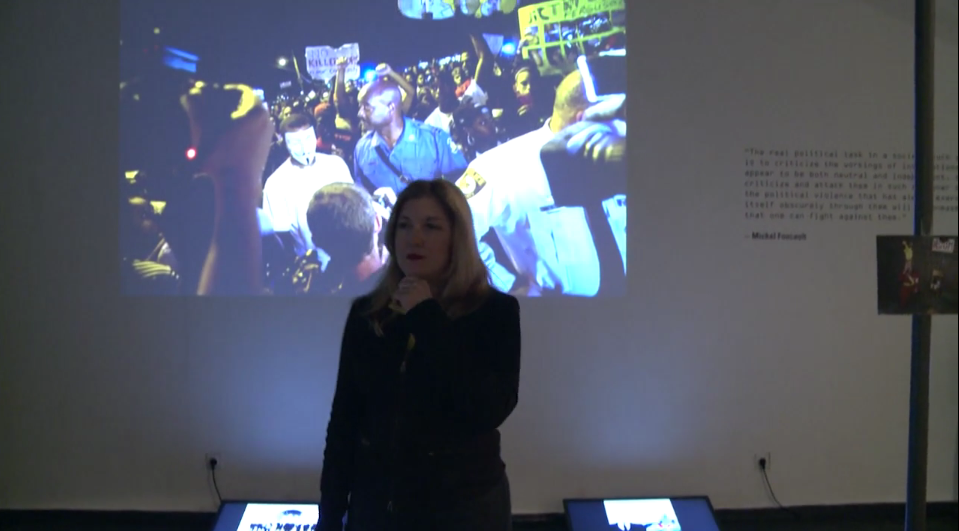
Since the first conference in April 2015, the Disruption Network Lab has been investigating the concept of whistleblowing, bringing attention to abuses of governments and large corporations, involving speakers such as Laura Poitras, Brandon Bryant, John Kiriakou, Annie Machon, Cian Westmoreland, Mustafa Al-Bassam, Abdalaziz Alhamza, Trevor Paglen, Henrik Moltke, a.o.
I come from a practical and theoretical background that combined art, hacking and political activism, but since 2014 my attention has been oriented to art as a act of investigation, thanks also to the work of Laura Poitras that deeply inspired me. I am progressively getting interested in artistic practices and investigations that provoke concrete outcomes, that are even difficult to be defined as “art”. Hacker art was my field of interest since the emergence of hacker culture in the 1990s, but thanks to the Disruption Network Lab activity I got even more concrete, and I started being passionate about the field of investigative journalism.
My intent is to combine the culture of investigation with artistic practice, or even operate a conceptual shift, by starting to define investigative journalism and whistleblowing as art.
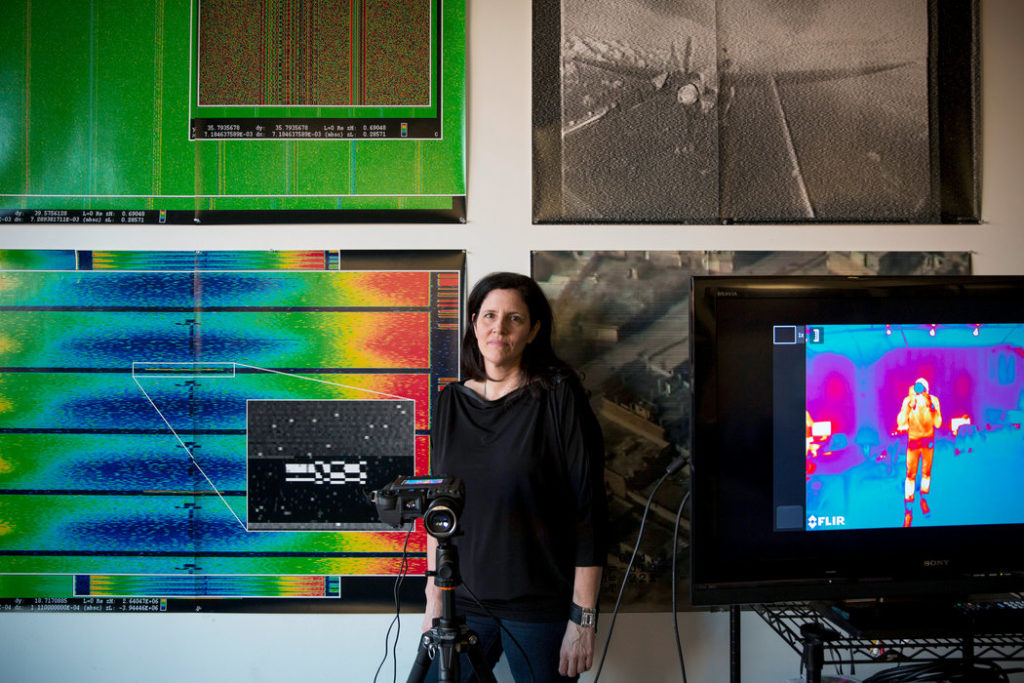
In the act of whistleblowing is embedded a deep change of perspective, where the unexpected emerges. This search for a radical change of point of views, which results in a deep disruption of individual life is something extremely valuable not only in political and cultural terms, but also on an artistic level. It is the contemporary Avant-garde, the search for a profound unexpected gesture that interferes with society and politics at a global level.
The investigative approach is necessary not only in the realm of journalism and whistleblowing, but also in the art context. It is thanks to an artistic approach that many discoveries can be done because artists are able to see reality as a challenge, and in a sense there is an important thread that connects them with whistleblowers. When I brought together these expertise during the Disruption Network Lab conferences, I could really see how it was possible to combine such methodologies and how whistleblowers and artists were intellectually benefiting from each other.
MG: To what degree does your investigative approach stem from what in the media art world has been termed as Tactical Media or Post-Tactical Media?
TB: There is for sure a connection with the tradition of tactical media strategies, and the discourse of post-digital interventions. The idea is to go beyond the digital per se, to focus on the impact of technology on the everyday life, culture, society and politics. However, I like to involve people that do not necessarily theorise on the methods, but that are coming from concrete fields of investigation and would never define themselves as “artists”. It is my conceptual “pleasure” to define them as such, but I know that for them it is not really necessary to present their practices via such definition.
A whistleblower wants to provoke real change, she/he/they is a person that was part of a specific institution or organisation and often is a person that believes in systemic structures. It is perhaps because this person believes so much in them that gets frustrated and decides to disrupt an entire life to reveal a wrongdoing. I find this gesture something impressive, it is a work of art by itself. My question would be how much many established artists would be able to risk to provoke changes. Is actually contemporary art able to provoke concrete changes? For sure the meaning of artistic practice is making us reflect on the concept of change, but I feel that nowadays we need more than that. Power is becoming stronger and more pervasive, my opinion is that art needs to have a stronger and more pervasive impact, beyond distribution of ephemeral privileges.
Just to say something about this curatorial approach: it is absolutely not easy. I see the difficulties when I am looking for funds for the Disruption Network Lab. Cultural funders have difficulty to understand how investigative journalism might be considered useful in the realm of art; alongside, political funders don’t like us to use the word art because they want to give money to something that appears more impactful on society. I like to connect dots, and to be in between, because it is thanks to this liminal zone that change can really emerge and that we can provoke it. Therefore I am choosing the most difficult path, but luckily until now we managed…
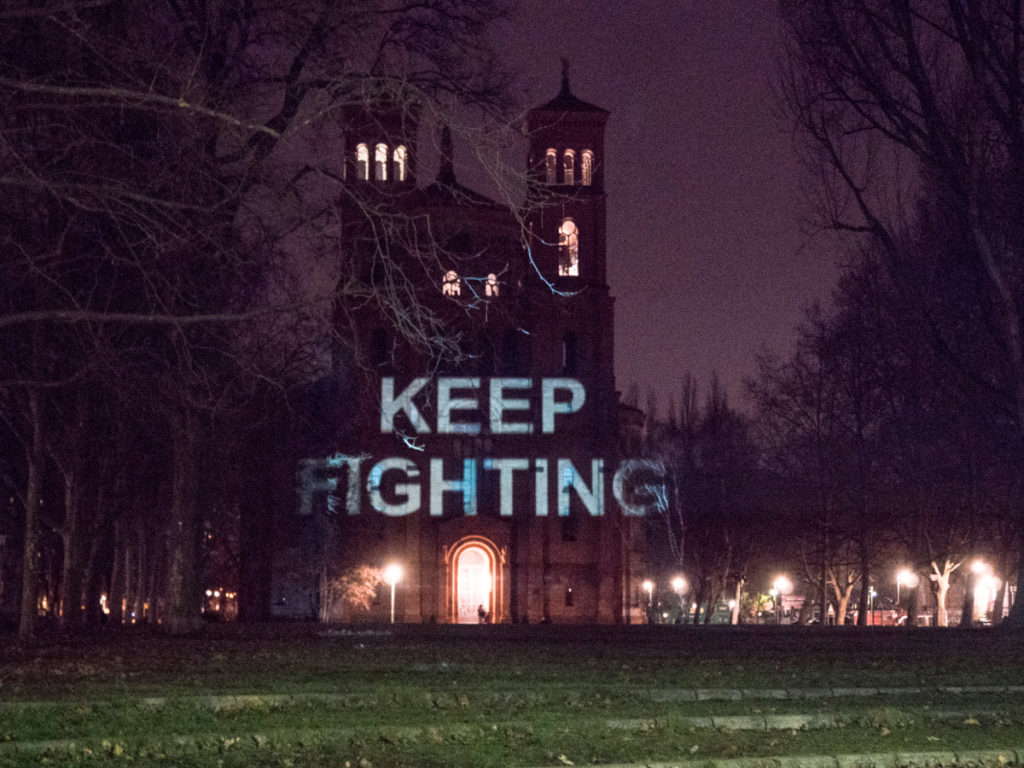
MG: What values are you trying to communicate through this way of working with others?
TB: We want to provide challenging debates within local and international communities, developing a context of critical reflection and analysis beyond what is usually communicated by mainstream media. The format of two-days events with a keynote and a panel each day encourages a very strong community sharing, which works on two levels: first, between the participants altogether, as they often know each other’s work, allowing them to meet for the first time in person and engage in actual discussions about their research; second, among the audience, that is usually formed by real experts working on the topics under analysis, as well as by people interested in getting a deep insight.
This unique combination of expertise creates a solid space for critical questions and discussions during the collective moments of sharing, as well as during breaks and dinners, which add to the Lab’s credibility to handle and discuss sensitive topics in a safe context.
Since each of our events requires a deep content research before the finalisation of the programme, it is extremely important to us to feel supported by organisations that we can trust and allow our research becoming concrete. The challenge of being independent while also looking for funding is very hard, and often some team members have to handle parallel jobs and sustainability struggles. Considering that we work with whistleblowers and people at risk, as it happened in the November 2017 event “TERROR FEEDS”, in which we needed to hire private security, having precarious finances is a severe challenge to the realisation of the project. This is the reason why we try to sensitise our network to sustainability issues in culture production.
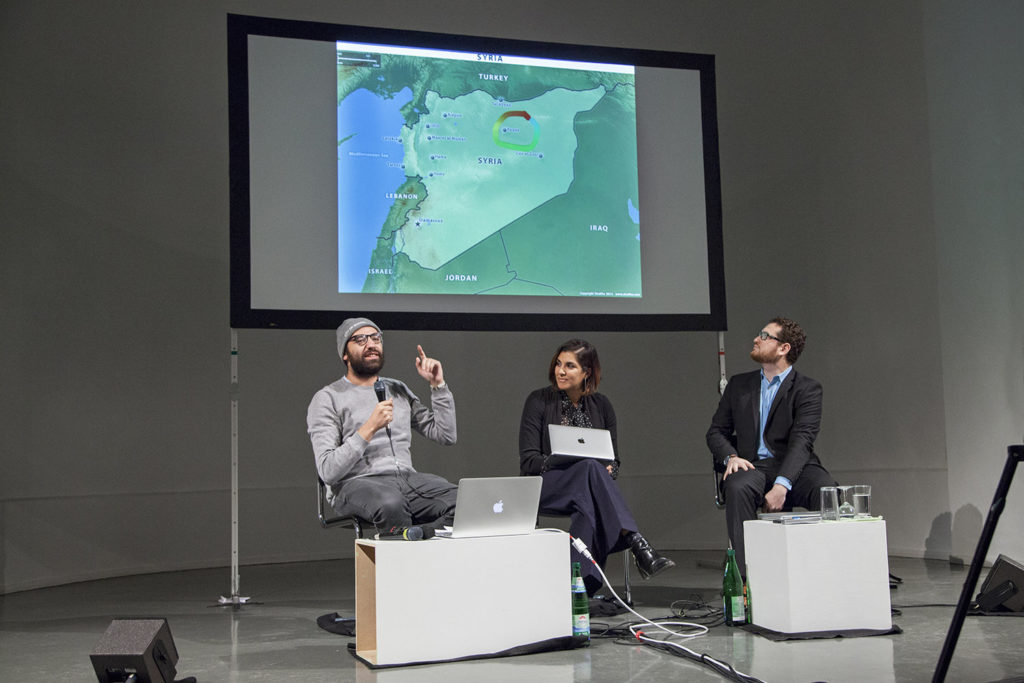
Since 2014 I have been working with wonderful and competent women in my team: Daniela Silvestrin, Kim Voss and Nada Bakr (Project Managers), Claudia Dorfmüller and Rahel Währer (Project Managers and Administration Officers), and with Jonas Frankki that has been shaping the visual identity of the conference programme since the start.
The Disruption Network Lab project was founded in 2014, and since 2016 it is a registered non-profit association in Germany (Disruption Network Lab e.V. – gemeinnütziger eingetragener Verein). The Disruption Network Lab e.V. produces the Disruption Network Lab programme.
The founding of the association was a solid step towards presenting and promoting the topic of digital culture in Berlin and internationally. We evolved from a single, private initiative, to an organisation devoted to digital culture and its applications on politics, technology, and society, locally and internationally. The grounding of the association was supported in 2016 by the Open Society Foundations (OSF) with a structural funding. For the organisation of the events, however, the association has been dependent on external private and (mostly) public funding. The first series of events in 2015 started thanks to the support of the Capital Cultural Funds of Berlin.
I want to be open on these details because they are really important for the way we shape our work. Often organisations in our field do not speak about the “making of”, but to be transparent it is part of our values. In our organisation we unfortunately do not benefit regularly of structural grants, and we have to search for grants event after event. During the production of our conferences, we have to undertake fundraising activities and this makes our lives very precarious.

While in 2015, 2016 and 2018 we got funding support from the City of Berlin, this did not happen in 2017. This pushed us to look for international funds, which was a very complex task while being busy with production – thing that almost compromised the whole conference series. This search opened us toward international foundations that are working with human rights, social justice and investigative journalism, such as the Reva and David Logan Foundation, the Bertha Foundation and the Mozilla Advocacy Fund, which supported us in 2017 (and in the case of the Reva and David Logan Foundation, also afterward). This pushed me to research more extensively the field of investigative journalism, because I understood that there was a concrete need for such practices and approaches in the cultural production scenario, and at an international level.
MG: Could you give us an idea of what the composition of the audiences at the DNL conferences
TB: The audience of our conferences is formed by activists, artists, journalists, computer experts, cultural producers, human right and whistleblower advocates, students and researchers. Entrance ticket is very accessible, only 5 Euro per day. After the conference, we provide a video documentation of the events to reach a broader international audience (youtube.com/c/DisruptionNetworkLab).
We have been collecting a lots of video material in the past four years. At the moment I am researching possible grants to see if we will be able to support the activity of archiving such contents in a systematic way, providing additional references and creating useful infographic. This would be something really important to offer to our public in the future.
MG: I was fortunate enough to be asked to chair two different DNL conferences. The one which affected me most, was “DRONES: Eyes from a Distance” which took place in April 2015, at Kunstquartier Bethanien in Berlin. The keynote speaker Brandon Bryant, was whistleblower and former drone-operator. It all felt very intense. The space was full, and the audience were very inquisitive, they wanted to know more. The length of the panels and discussions are longer than usual panel discussions. Yet, strangely, they go very quickly.

Could you expand on how and why you choose this way of presenting a cultural forum as a platform?
TB: Since 2015 the Disruption Network Lab e.V. produced thirteen conference events (in Germany, UK and Austria). The conference “DRONES” with keynote Brandon Bryant was the first of the series. After that we kept investigating on related subjects, such as activist and resistance strategies after the Snowden-Leaks (“SAMIZDATA”: keynotes Laura Poitras and Jacob Appelbaum); whistleblowing (“TRUTH-TELLERS”: keynotes Grace North and Mustafa Al-Bassam; “PRISONERS OF DISSENT”: keynote John Kiriakou), the ISIS media propaganda (“TERROR FEEDS”: keynotes Charlie Winter, Sue Turton, and Abdalaziz Alhamza): hate speech and political misinformation (“HATE NEWS”: keynotes Nanjala Nyabola and Andrea Noel).
Currently we are working on developing a new conference on the subjects of populism, right-wing extremism, and alt-right, and the effects of such phenomena in art, media, politics and society, under the title of INFILTRATION: Challenging Supremacism (September 7-9 in Berlin at Kunstquartier Bethanien).
Each conference requires a previous research, and an analysis of the topics that are important at the moment. This allows us to be exactly on time for the investigation of current phenomena. It was the case of the last conference, HATE NEWS, which was the result of a funding application done in December 2017, but since the production started later in 2018, I could focus on the “hot news” of the Cambridge Analytica debate, and be really fortunate to have with us David Carroll and Nanjala Nyabola.
Sometimes the topics are also the result of a common sharing within my own community (which actually crosses many communities). It was the case for the first conference event “DRONES” in April 2015. During some months I was sharing ideas with my friends and colleagues Chantal Meloni (criminal lawyer at the ECCHR in Berlin) and Laura Lucchini (freelance journalist) about the topic of the consequences both on military networks and civil society of an increasing automatism of conflicts. Chantal Meloni suggested me to contact former drone operator Brandon Bryant, that at the moment was not well-known as today – she saw him speaking at the ECCHR during an event related to human rights and the drone war. I reached out to him and we decided together how to shape his Keynote – you saw the results. Brandon Bryant was really important for the start of the Disruption Network Lab, his gesture of coming to us was really brave, generous and impactful. In a sense, it was the beginning that shaped the future of our activity.
MG: What responses have you received from your audiences in respect of this way of presenting and the content being explored?
TB: Our audience is usually really committed. I am always impressed when after four hours of discussions, at the Q&A in the late evening, I see people asking very deep, incredibly detailed and specific questions. I have to say that this has been my deep surprise in Berlin since I moved here 15 years ago, to experience that people are so committed, critical and well-informed during events. But of course at the Disruption Network Lab the feedback it brings a more intense value, because I have the feeling that people are enjoying the unexpected connections that I put together after hard work. And the most fulfilling result is when they got them!
However, it is not always easy to keep the public interested in such deep topics, especially because in Berlin the competition with openings, clubs, and parties during the weekend is tough. In the past 4 years we have been shaping our community of passionate people that are regularly coming and following us, even from abroad. The challenge for me now it is to open up more, and to reach new people that are constantly flowing in the city. The support of our close community is important also for this scope, we need to support each other to keep doing what we do.
MG: Since starting DNL what highlights do you remember that have made you feel you are part of something special?
TB: The work before each conference is hard, we are only five people, and in the past we were just three. So at a production level, there is a lots of work which implies fundraising, press and communication, the whole organisation of the logistic and speakers presence. Plus of course, the curatorial work and the research beforhead. We often arrive to the conference very excited but also really tired. However, every time, it is thanks to the speakers and the audience that we get our energy back. In the past conferences we had really unique and wonderful speakers that shared with us their stories, many of them really difficult, heartbreaking and a real challenge to be communicated. This was the case of (among others) Brandon Bryant, Cian Westmoreland, John Kiriakou, Laura Poitras, Jake Appelbaum, Annie Machon, Andrea Noel, Grace North, Mustafa Al-Bassam, Abdalaziz Alhamza, and the constant very important presence of the Chelsea Manning Initiative before Chelsea Manning was released.
I felt that all these people were trusting us and our public by sharing their stories with us. Each conference has been offering an important context at a human level, a moment of reflection, revelation, and also the sensation to belong to a community. With some people I am still in contact, other entered in contact with each other and are still working together on other projects. This is for me the most important result, to see that the Disruption Network Lab is useful not only to inform, but also to make people feel part of something in common.

When the speakers are with us and open their minds to our topics, I feel that we are receiving a gift from them. I come from a tradition in which communities, networks and the sharing of experience were the most important values, the artwork by themselves. By combining all these expertise, I feel the responsibility of creating each time the context for a collective artwork, And this is something special, especially nowadays in which the discourse of networking has been completely commercialised. I feel to thank all these people, not only the ones that worked with me and supported us, but also all the people that shared their experiences and the ones that came to listen to them. I am sure that this path will go on, either with us, or among the people that found themselves related thanks to our conferences.
Tatiana Bazzichelli (1974, Rome) is artistic director and curator of the Disruption Network Lab, a program of conference events at Kunstquartier Bethanien in Berlin. She is currently visiting lecturer at the Fachhochschule Potsdam at the Department of Applied Culture. She has been based in Berlin since 2003. Bazzichelli received a Ph.D. in Information and Media Studies (2011) at Aarhus University in Denmark. In 2012–2014 she was postdoctoral researcher at the Centre for Digital Cultures, Leuphana University of Lüneburg. She founded the networking project Activism-Hacking-Artivism in Rome in 2001 and managed the aha@ecn.org mailing list on art activism. She was program curator at transmediale festival, where she developed the year-round initiative reSource transmedial culture berlin and curated several conference events, workshops and installations (2011–2014). Bazzichelli wrote the books Networking (2006), Networked Disruption (2013), and co-edited Disrupting Business (2013). She curated exhibitions such as Hack.it.art (2005), HACK.Fem.EAST (2008), Networked Disruption (2015), and SAMIZDATA (2015).
The next Disruption Network Lab conference event is INFILTRATION: Challenging Supremacism, as part of the 2018 thematic series “Misinformation Ecosystems”, scheduled on September 7-8, 2018, at Kunstquartier Bethanien in Berlin.
The conference wants to reflect on the practice of political, investigative and activist infiltration as a form of betterunderstanding aims, lifestyles and methods of right-wing extremist groups. What is the reason for people to join extremist groups? How can we analyse their dynamics from the inside? What are the reasons of fascination among young generations of right-wing propaganda and supremacist outrage?
Among the confirmed speakers are Daryl Davis (Musician & Author, USA) famous for being a black American befriending members of the KKK since the 1990s and making possible to convert around 200 of them (the film “Accidental Courtesy:Daryl Davis, Race & America” will be screened at the DNL event on September 9). Other participants are Patrik Hermansson (Anti-racist Activist, “Hope Not Hate” Researcher, SE/UK), Julia Ebner (Terrorism and Extremism Researcher and Author, DE/UK), Stewart Home (Artist and Author, UK), Florian Cramer (Research Professor in New Media at Hogeschool Rotterdam, DE/NL), Janez Jansa (artist, SI), and others. Stay tuned at: disruptionlab.org/newsletter/
Main Image: Brandon Bryant, Former US-Drone Operator speaks at Disruption Network Lab, DRONES, April 17 2015, Berlin. Photo by Nadine Nelken.
Tatiana Bazzichelli is the artistic director and founder of the Disruption Network Lab. Former programme curator at transmediale festival in Berlin from 2011 to 2014, she developed the year-round ‘reSource transmedial culture berlin’ project and curated several conference events. She was visiting lecturer at the Fachhochschule Potsdam at the
Department of Applied Culture in 2016 and 2017, where she taught classes about art, hacktivism and whistleblowing. You can read more about her here.
INFILTRATION: Challenging Supremacism
September 7-8 · Studio 1
Kunstquartier Bethanien · Mariannenplatz 2 · Berlin
Partner Event @ Spektrum · September 9
More info: disruptionlab.org/infiltration
Way back in 1995, the artist collective Critical Art Ensemble (CAE), said “What your data body says about you is more real than what you say about yourself. The data body is the body by which you are judged in society, and the body which dictates your status in the world.” These words now haunt us, and take their place alongside numerous other ignored warnings about global threats to the wellbeing of our societies and the planet.
In this interview with curator Dani Admiss, we discuss how the data-driven gamification of life and everything has shaped the development of Playbour – Work, Pleasure, Survival at Furtherfield and why the Gallery is currently being transformed into a psychological environment.
Gallery visitors are presented with a series of game-like installations, which are the result of the shared and collective cognitive labour of artists, curators and gallery staff. First the artists, and then the public (as players) are invited to test the processes and experiences offered by new mechanisms of play and labour. Each ‘game’ simulates an experience of how some techniques and technologies of gamification, automation, and surveillance, are at work in our everyday lives, in order to capture all forms of existence.
Marc Garrett: Before the exhibition, you initiated an open call for a Lab. You invited participants to join a three-day art and research lab at Furtherfield Commons, Finsbury Park, London. Could you elaborate why you did this and how it informed the exhibition?
Dani Admiss: A couple of months before the exhibition, I ran a 3 day co-research lab that brought together artists, designers, activists, and researchers. I like to refer to it as a performative, temporary exhibition in the form of a lab. There were discussions, performances, interventions, games, and exercises. We had discussion with Jamie Woodcock on gaming and digital labour, he walked us through an interview session with gamers on the Twitch platform. Steven Levon Ounanian held a performative experiment where we thought about how we might render the suffering online in the real world, Itai Palti worked with us to think about design principles and neuroscience. FUN! The idea was that we would collectively explore, discuss and define key issues that we thought were important to then take forward to develop into games and experiences to share with the public. The aim was to play off each other in a live context to generate new perspectives and ideas.
Building on this, I decided to hold an open call for participants. In my most idealistic moment, I’d say I wanted to try and find ways to expand who gets to produce, stage and display, how we define what these issues actually are for wider audiences. Can this lead to new stories about art, tech, society? Like any project it is never exactly as you imagined it, but I think the majority of people got a lot out of working like this. I did. Working with people that aren’t always the people you expect to be attached to a project always throws up unexpected experiences. Everyone brought their best themselves with them. Open. Interested. Warm. Prepared. Ready to listen, and for fun!
I’d make the lab longer next time, so it wasn’t as intense, and I’d try to have more people join the open call.
MG: The open-curation process you have developed is core to the realisation of the Playbour lab and exhibition. It resonates strongly with Furtherfield’s DIWO ethos. It turns on its head, the traditional approach to curating thematic group shows. Please can you tell us about the process and say why this new approach is important at this time?
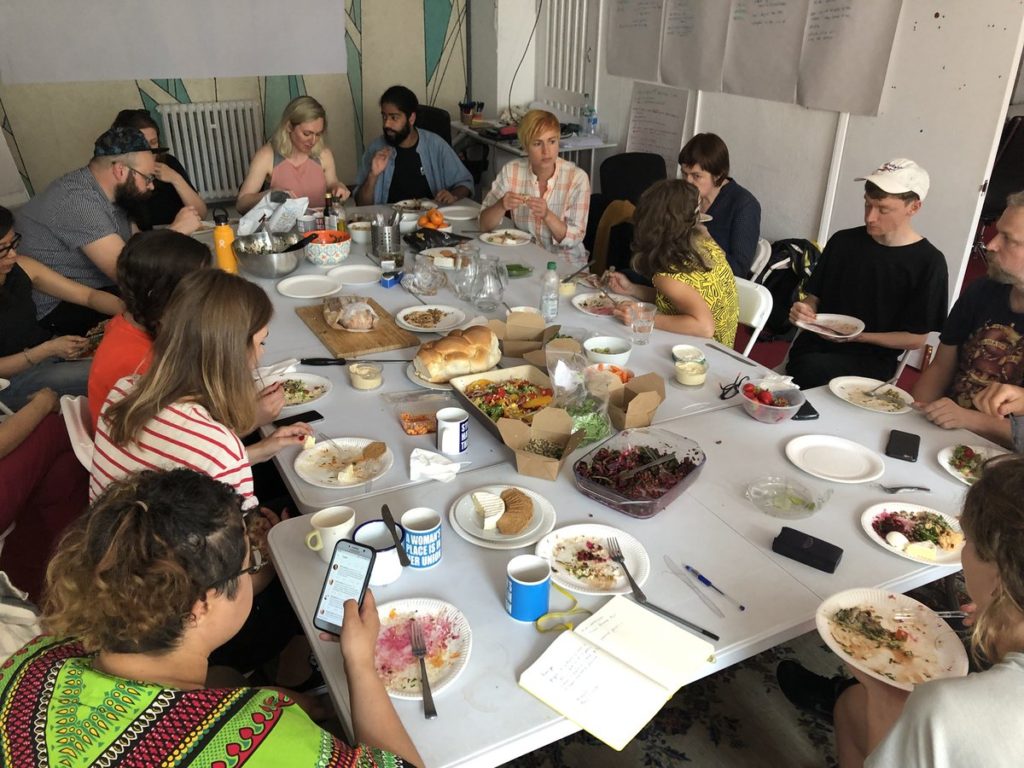
DA: DIWO definitely informed Playbour! I think the spirit of co-creative discovery is a powerful tool that curators should use more. I refer to it as co-research, which is ultimately a way to research-with others. What separates it from more traditional approaches to curating is the unclear distinction between author/researcher and subject/participant. The aim is to achieve closer equality between the participant and subject area, in the form of valuing a person’s idea’s and lived-experience as much as other ‘expert’ forms of knowledge. Historically, it has roots in a highly specific context of the radical Left in post-war Italy with Operaismo. This is where the seeds of debate on post-immaterial labour emerged, arising from Hardt, Negri, Bifo, Terranova, etc, and why I originally was interested in working in this way because of the subject matter of the project, however, it became something so much more.
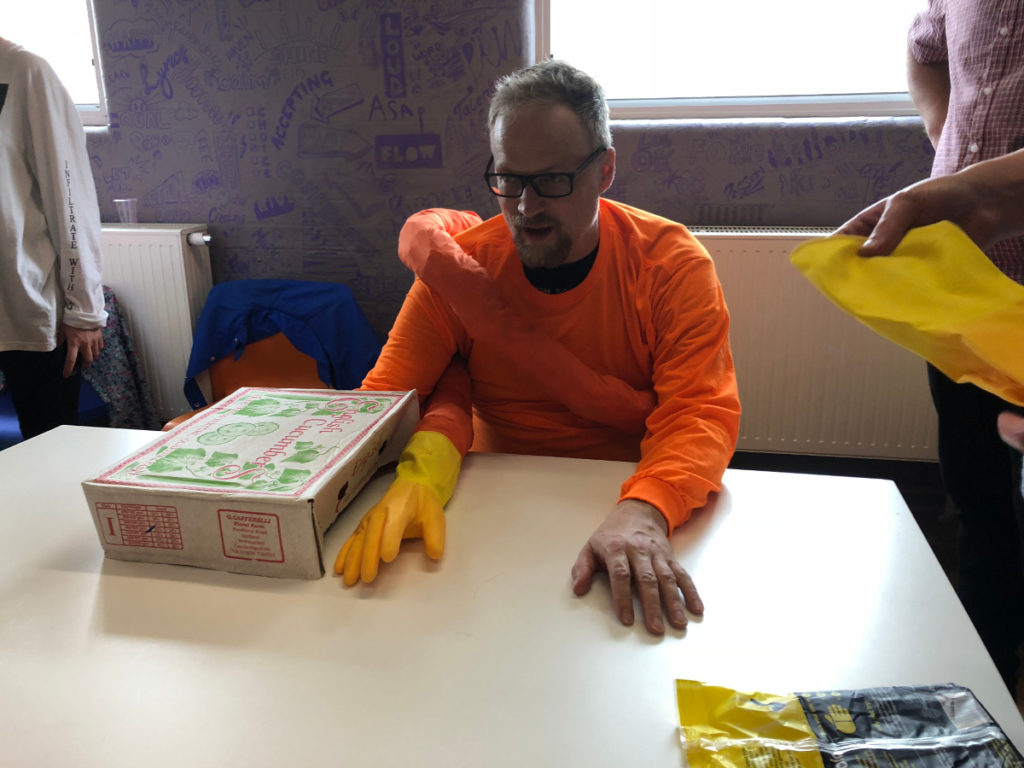
For me, as a curator, creating projects about complex subject areas that bring together embodied and embedded social relations with technical worlds, is something that needs to be done with people rather than to them. I think the most interesting works of art being produced today are treated less like things and instead draw into the very making of the ways in which we get to know what we know. You can see this in works from Cassie Thornton’s project Collective Psychic Architecture (an exploration of “bad support” in Sick Times) 2018, where she extends the responsibilities of the gallery or institution through performative means, or in the high-profile modeling and mapping practices coming out of the Forensic Architecture network. How can curating exist in a wider space than before? I’m trying to work in much more extended and expanded ways with the primary intention to include more end users into the areas we are looking at.
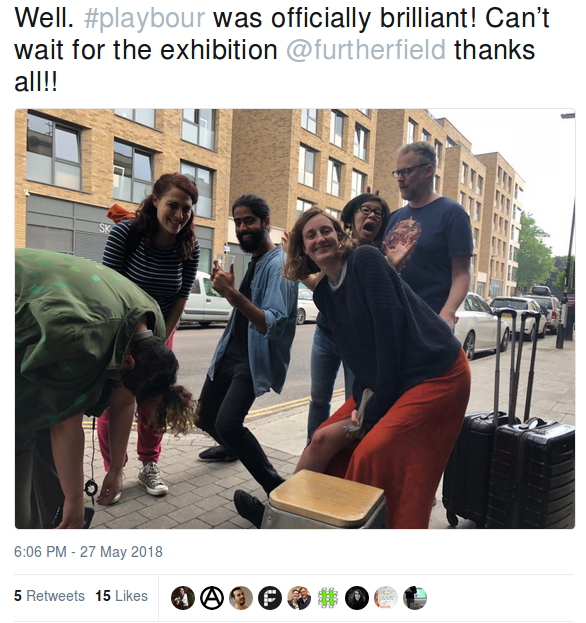
Adopting a co-research model (in the lab, in the show, in the publication, in the micro-commissions) meant that the aim of the exhibition shifts, it becomes less about what the topic is and how it works and more about how it came to be. Brian Holmes once wrote that making an image remakes the world. Yes, but it also distances us from it. Playbour asks people to consider how the world organises us by facilitating moments where people can identify with particular phenomena. I feel this is more fitting and has more potential to create moments of personal learning and change than trying to represent it through curatorial practice. Why do we need this in an age of information? My thinking is that knowledge-projects are not simply objective processes but deeply subjective ones that are enacted through and with others. Finding ways for people to identify in more meaningful ways with the subject will hopefully lead to greater chance that people will gain greater perspective and agency over their own worlds.
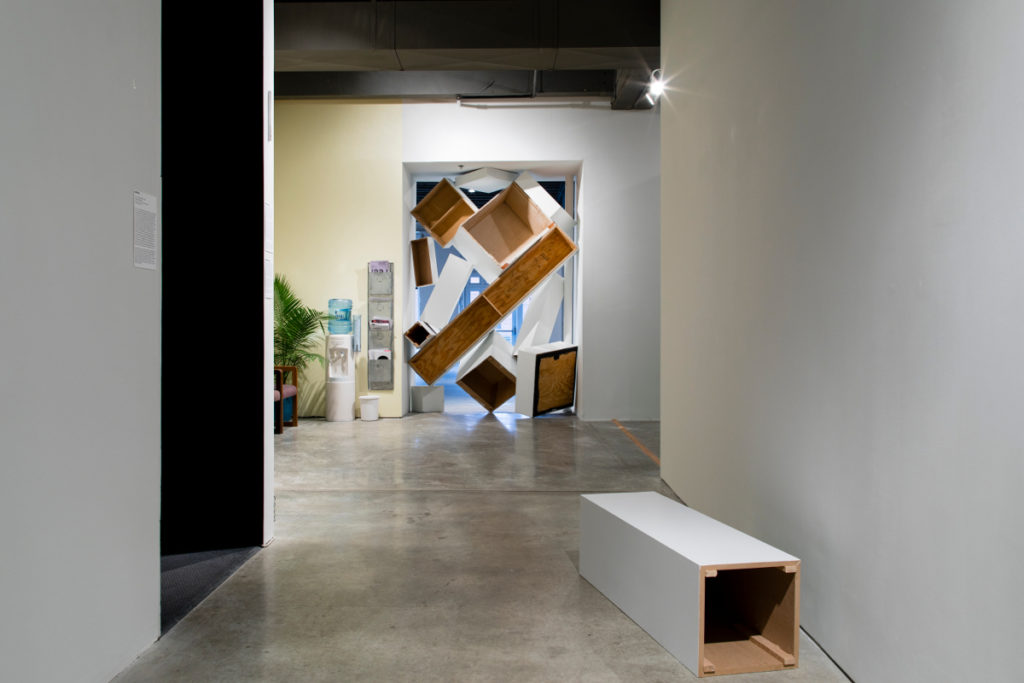
MG: The term Playbour brings attention to critiques of gamification and to the extraction of value via social media platforms. But your subtitle then opens up a whole other world of reflection. What are you discovering about the relationship between “work, pleasure and survival”?
DA: The project is exploring the role of the worker in the age of data technologies, but this looks less at the “future of work” and chooses instead to focus on the shifting roles and blurred boundaries of work, play and well-being – how do we place value on these areas, how do we work with and against them?
Quite often when we talk about opaque terms like immaterial labour and cognitive capitalism we fail to grasp the production processes of these phenomena. Immaterial labour depends on the self and our social relations. We are asked to ‘post’, ‘share’, ‘network’, ‘emote’, ‘communicate’, ‘know’. Not so much ‘understand’. These acts inform the control and creation of our subjectivity. At the same time, very little discussion is happening about the fact that so much exploitation -physical, ecological, economical- sits behind the new commons we are all talking about.
Opening the project out to think about work, pleasure, survival, is a provocation. On one level, it is a nod to the fact that this conversation is for a privileged few. Many choose what they do and this ‘choice’ is supposed to operate as an expression of one’s personality. On the other, it’s human nature to get swept up in what is considered the norm, so it’s also a challenge to think about what are your own limits, returning to the idea of inviting people to find moments of identification with these broader issues to their own lived experience.
MG: Why is it important that the work being prepared for Furtherfield gallery is conceived of more, as a series of game experiences, than a display of discrete art objects, or a didactic exhibition on the topic of Play and Labour? Has the gallery’s location in a public park influenced your thinking at all?
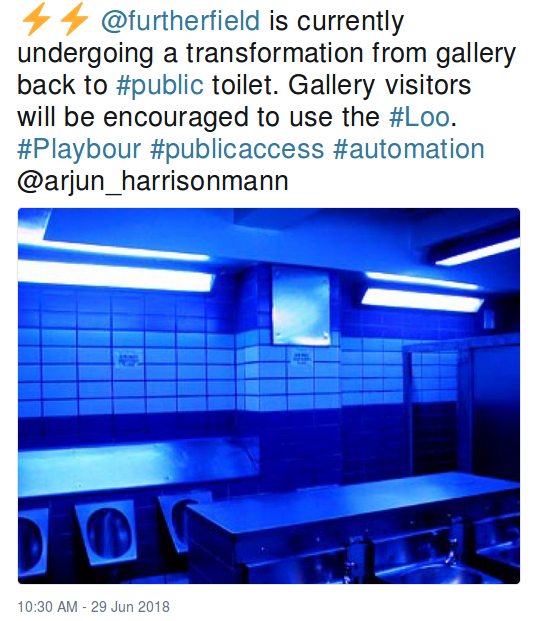
DA: Well, first off, it has been a collective process and so I wanted to show that process to people. Secondly, you have to invest part of yourself in play. The more I research the areas of digital and immaterial labour the more I’m keen to work with others to understand the not yet completed transformations of body, society, and world, into a global capitalist system. These are suffuse and pervasive and nudge our behaviours all of the time. Organising the exhibition as experiences is a way for us all to live-out (at least temporarily and in a safe, playful space) the tentacular effects of immaterial labour and economies of knowledge and information. This is not to say let’s walk away from a highly networked society, it’s an invitation back into perspectival agency.
MG: You’ve chosen to put together three themes for the exhibition, ranging across work, pleasure, and survival. Why was it important to choose these three themes in particular?
DA: I’m fascinated by how we are involved in the making of worlds we are then conditioned by. From the learnings in the lab, my own research and collaborations leading up to Playbour, I think gamification, automation, and surveillance are three key areas that scaffold a lot of the debate on digital and immaterial labour.
1) SURVEILLANCE. How we are measured and how we measure ourselves? Traditionally, government control used to come from top-down surveillance techniques, such as the type Michael Straeubig’s Hostile Environment Facility Training (HEFT) is looking at. However, I think we should be talking about how forms of control are exercised through our own self-monitoring processes – self-improvement culture is a perfect example of this. Cassie Thornton’s Feminist Economics Yoga (FEY), is a wonderful remedy for this.
2) AUTOMATION. How technology is removing decision-making from us in the pursuit of a frictionless universe. In Harrison-Mann’s Public Toilet he is talking about how automation is used to address the need of social issues. The starting point is the lack of public services offered in Finsbury Park and how that is altering how we use and experience the public space of the park. He is interested in making a connection between this and how metrics can often end up being exercised in controversial and even arbitrary ways inhibiting people getting what they need, such as disability benefits in the UK.
3) GAMIFICATION. How are rewards and competition embedded into our online interactions and interfaces? Jamie Woodcock has this excellent term that describes gamification-from-above and gamification-from-below. Like the Situationist socialism-from-below. How we might use gamification for our own positive manipulations, diversions and distractions? I think a lot of media and new media practice has long been engaged in gamification-from-below. Marija Bozinovska Jones’ piece Treebour (201) plays on this, transferring manipulation of social relations levelled at online interactions to the “natural” networking of trees.
MG: After visitors have experienced the exhibition, what emotions, thoughts and understandings, would you like them to leave with?
I think you introduced the show in an interesting way in your opening text with the notion of the data body and the extension of our bodies into new spaces with unknown consequences. These happen inside the screen, at the edges of the world, in transit, at the end of the supply chains. At the same time, they also operate on semi-conscious refrains, in our behaviours, actions, thoughts and emotions about the world. Taking part, thinking-with, making-with, are strategies to find ways to open up discussions about how we are all involved in making and unmaking our worlds via different actions. Something like digital and immaterial labour is not a discrete issue reservable for experts who work in this area, the connections and consequences weave in and out of our lives and impact us all. We are constantly reacting to thing around us, taking in these cues and pushing them back out into the world.
In terms of emotions, I don’t want to spread fear and despair, I’m hoping that some visitors will identify with some of the ideas in the show and relate them to something in their life that perhaps they’d not thought of in that way before.
Notes: Main top image by Marija Bozinovska Jones, Treebour 2018.
DIWO – Do It With Others: Resource
archive.furtherfield.org/projects/diwo-do-it-others-resource
Since the financial crash 10 years ago, we’ve learned that it tends to be everyday people, on the ground, who pick up the pieces and not governments. Millions have been dragged into poverty while those who caused the “crisis”, after creating dangerously high levels of private debt, remain unscathed. [1] The UK Conservative government’s response was an Austerity policy, driven by a political desire to reduce the size of the welfare state. Amadeo Kimberly says, “austerity measures tend to worsen debt […] because they reduce economic growth.”[2] The effect has been devastating, creating all together, more homelessness, precarious working conditions and thus pushing working communities, deeper into debt. In the UK, the NHS is being privatized as we speak. According to a CNBC report, medical bills were the biggest cause of bankruptcies in the U.S in 2013, with 2 million people adversely affected. [3]
The work of artist and activist, Cassie Thornton is included in the upcoming Playbour– Work, Pleasure, Survival exhibition at Furtherfield, curated by Dani Admiss. In this interview I wanted to explore the following questions as revealed in her current Hologram project:
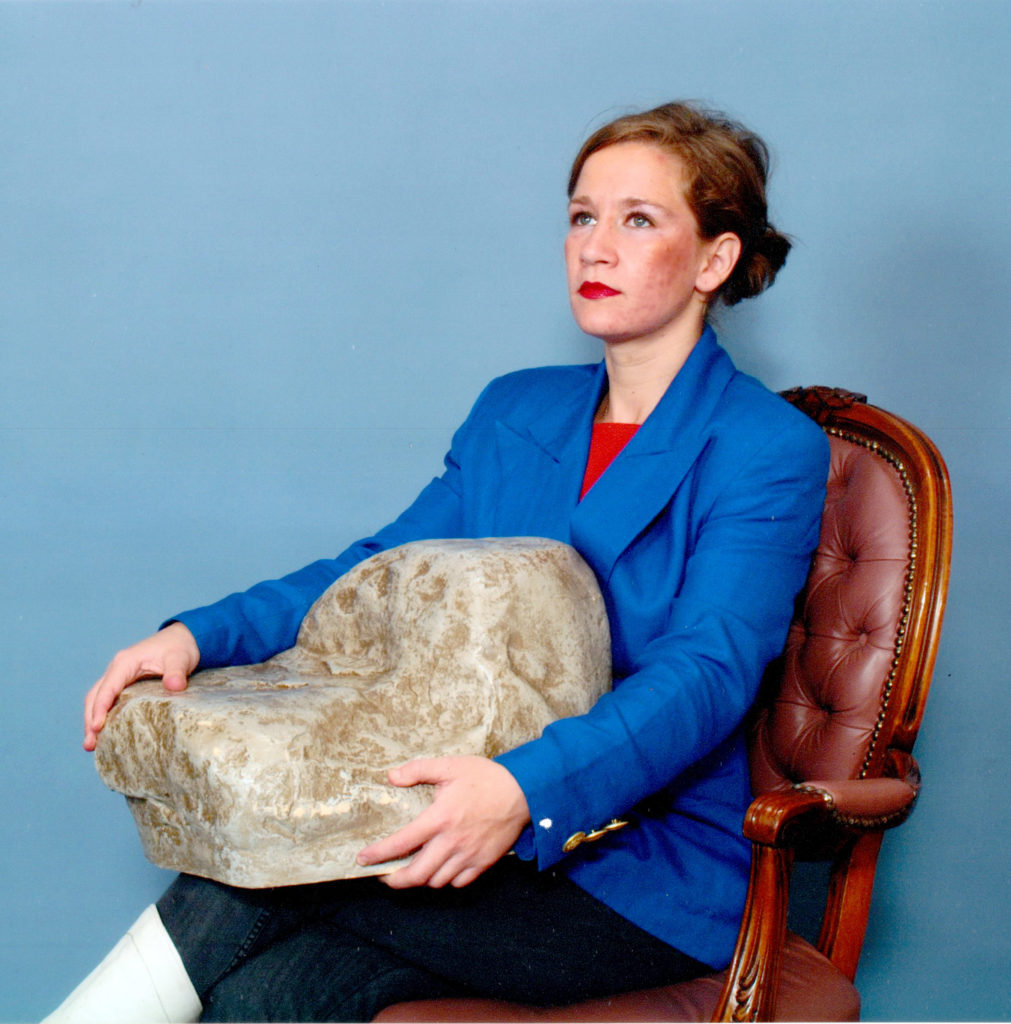
Cassie Thornton is an artist and activist from the U.S., currently living in Canada. Thornton is currently the co-director of the Reimagining Value Action Lab in Thunder Bay, an art and social center at Lakehead University in Ontario, Canada.
Thornton describes herself as feminist economist. Drawing on social science research methods develops alternative social technologies and infrastructures that might produce health and life in a future society without reproducing oppression — like those of our current money, police, or prison systems.
Marc Garrett: Since before the 2008 financial collapse, you have focused on researching and revealing the complex nature of debt through socially engaged art. Your recent work examines health in the age of financialization and works to reveal the connection between the body and capitalism. It turns towards institutions once again to ask how they produce or take away from the health of the artists and workers they “support”. This important turn towards health in your work has birthed a series of experiments that actively counter the effects of indebtedness through somatic work, including the Hologram project.
The social consequences of indebtedness, include the formatting of one’s relationship to society as a series of strategies to (competitively) survive economically, alone, to pay the obligations that you has been forced into. It takes so much work to survive and pay that we don’t have time to see that no one is thriving. Those whom most feel the harsh realities of the continual onslaught of extreme capitalism, tend to feel guilty, and/or like a failure. One of your current art ventures is the Hologram, a feminist social health-care project, in which you ask individuals to join and provide accountability, attention, and solidarity as a source of long term care.
Could you elaborate on the context of the project is, as well as the practices, and techniques, you’ve developed?
CT: Many studies show that the experience of debt contributes to higher levels of anxiety, depression, and suicide. Debt disables us from getting the care we need and leads us away from recognizing ourselves as part of a cooperative species: it is clear that debt makes us sick. In my work for the past decade, I have been developing practices that attempt to collectively discover what debt is and how it affects the imagination of all of us: the wealthy, the poor, the indebted, financial workers, babies, and anyone in-between. Under the banner of “art” I have developed rogue anthropological techniques like debt visualization or auxiliary credit reporting to see how others ‘see’ debt as an object or a space, and how they have been forced to feel like failures in an economy that makes it hard for anyone (especially racialized, indigenous, disabled, gender non-binary, or ‘immigrant’) to secure the basic needs (housing, healthcare, food and education) they need to survive, because it is made to enrich the already wealthy and privileged.
“The rise of mental health problems such as depression cannot be understood in narrowly medical terms, but needs to be understood in its political economic context. An economy driven by debt (and prone to problem debt at the level of households) will have a predisposition towards rising rates of depression.”[4]
After years of watching the pain and denial around debt grow for individuals and entire societies, I was so excited to fall into a ‘social practice project’ that has the capacity to discuss and heal some of this capital-induced sickness through mending broken trust and finding lost solidarity. This project is called the hologram.
MG: What kind of people were involved?
CT: The entire time I lived in the Bay Area I was precarious and indebted. I only survived, and thrived, because of the networks of solidarity and mutual aid I participated in. As the city gentrified beyond the imagination, I was forced to leave. I didn’t want to let those networks die. So, at first, the people who were involved were like me– people really trying to have a stake in a place that didn’t know how to value people over real estate and capital
The hologram project developed when, as I was leaving the city, I had invited a group of precariously employed, transient activists and artists to get together in the Bay Area for a week of working together. We aimed to figure out ways to share responsibility for our mutual economic and social needs. This project was called the “Intentional Community in Exile (ICE)” [the ICE pun was always there, now an ever more intense reference in the public eye] and it grew out of an opportunity offered by Heavy Breathing to choreograph an event at The Berkeley Art Museum. They allowed me to go above and beyond my budget to invite a group of 8 women together from across the US to choreograph methods of mutual aid: sharing resources, discussing common problems and developing methods for cooperating to co-develop an economic and social infrastructure that would allow us to thrive together, interdependently. What would it mean for our work as activists and artists to feel that we had roots within an intentional community, even if we didn’t have the experience of property that makes most people feel at home?


Facebook event: “In departing from the idea of a long term home, family, property, or ownership, ICE models a mutual aid society to sustain creative and political practices within a hostile economic system. This project is about finding ways to exit economic precarity by building human relationships instead of accumulating capital– or to make exile warm. After a one week convergence of a small group of collaborators, ICE presents a discussion and performance of life practices as well as frameworks for material and immaterial mutual support.”
The Hologram was one of many ideas that developed as part of this project. One of the group members, Tara Spalty, founder of Slowpoke Acupuncture, (and one of the two acupuncturists you will see at SF protests or homeless encampments) and I fell into this idea when combining our knowledge about the solidarity clinics in Greece, our growing indebtedness and lack of medical records, and the community acupuncture movement. Then the group brainstormed about what the process would be like to produce a viral network of peer support.
MG: What inspired you to do this project? (particularly interested in the Greek influences here and what this means to you)
CT: My practice of looking at debt became boring to me by 2015 as it became more and more clear that individual financial debt was a signal of a larger problem that was not being addressed. The hyper individualism produced by indebtedness allows us to look away from a much bigger deeper story of our collective debts, financial and otherwise. We don’t know what to do with these much bigger debts, which include sovereign debts, municipal debts, debts to our ancestors and grandchildren, debts to the planet, debts to those wronged by colonialism and racism and more. We find it so much easier to ignore them.
When visiting austerity-wracked Greece after living in Oakland, I noticed that Oakland appeared to have far more homeless people on the street. It made me realize that, while we label some places “in crisis,” the same crisis exists elsewhere, ultimately created and manipulated by the same financial oligarchs. The hedge funds that profit off of the bankruptcy in Puerto Rico are flipping houses in Oakland and profiting off of the debt of Greece. We’re all a part of the same global economic systems. The “crisis” in Greece is also the crisis Oakland and the crisis in London. For this reason, I have been interested in what we can all learn from activists, organizers and others in crisis zones, who see the conditions without illusions.
This led me to an interest in the the Greek Solidarity Clinic movement, which since “the crisis” there has mobilized nurses, doctors, dentists, other health professionals and the public at large to offer autonomous access to basic health care. I went to go visit some of these clinics with Tori Abernathy, radical health researcher. Another project using this social technology is called the Accountability Model, by the anonymous collective Power Makes Us Sick. These solidarity clinics are run by participant assembly and are very much tied in to radical struggles against austerity. But they have also been a platform for rethinking what health and care might mean, and how they fit together. The most inspiring example for me was in at a solidarity clinic in Thessaloniki, the second largest city in Greece. The “Group for a Different Medicine” emerged with the idea that they didn’t want to just give away free medicine, but to rethink the way that medicine happens beyond conventional models, including specifically things like gender dynamics, unfair treatment based on race and nationality and patient-doctor hierarchies. This group opened a workers’ clinic inside of an occupied factory called vio.me as place offer an experimental “healed” version of free medicine.
When new patients came to the clinic for their initial visit they would meet for 90 minutes with a team: a medical doctor, a psychotherapist and a social worker. They’d ask questions like: Who is your mother? What do you eat? Where do you work? Can you afford your rent? Where are the financial hardships in your family?
The team would get a very broad and complex picture of this person, and building on the initial interview they’d work with that person to make a one-year plan for how they could be supported to access and take care of the things they need to be healthy. I imagine a conversation: “Your job is making you really anxious. What can we do to help you with that? You need surgery. We’ll sneak you in. You are lonely. Would you like to be in a social movement?” It was about making a plan that was truly holistic and based around the relationship between health, community and struggles to transform society and the economy from the bottom-up . And when I heard about it, I was like: obviously!
So the Hologram project is an attempt by me and my collaborators in the US and abroad to take inspiration from this model and create a kind of viral network of non-experts who organize into these trio/triage teams to help care for one another in a complex way. The name comes from a conversation I had with Frosso, one of the members of the Group for a Different Medicine, who explained that they wanted to move away from seeing a person as just a “patient”, a body or a number and instead see them as a complex, three dimensional social being, to create a kind of hologram of them.
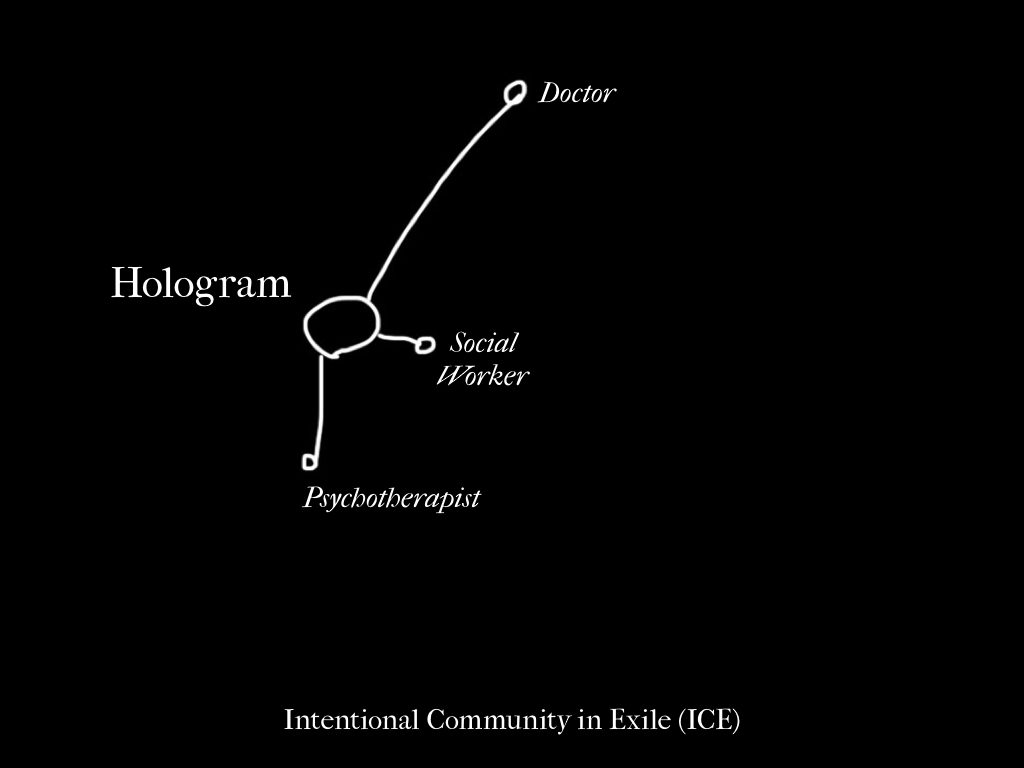
MG: Could you explain how the viral holographic care system works?
CT: Based on the shape above, we can see that we have three people attending to one person, and each person represents a different quality of concern. In this new model, these three people are not experts or authorities, but people willing to lend attention and to do co-research, to be a scribe, or a living record for the person in the center, the Hologram. We call these three attendees ‘patience’. Our aim is to translate the Workers’ Clinic project to a peer to peer project where the Hologram receives attention, curiosity and long term commitment from the patience looking after her, who are not professionals. Another project using this social technology is called the Accountability Model, by the anonymous collective Power Makes Us Sick.
So the beginning of the process, like that of the Workers’ Clinic, is to perform an initial intake where the three patience ask the Hologram questions which are provided in an online form, about the basic things that help or hurt her social, physical and emotional/mental health. When this (rather extended) process is complete, the Hologram will meet as a group every season to do a general check in. The goal of this process is to build a social and a physical holistic health record, as well as to continue to grow the patience understanding of the Hologram’s integrated patterns.
Ultimately, over time we hope to build trust and a sense of interdependence, so that if the Hologram meets a situation where she has to make a big health decision (health always in an expansive sense) about a medical procedure, a job, a move, she will have three people who can support her to see her lived patterns, to help her ask the right questions, and to support peer research so that the Hologram is not making big decisions unsupported.
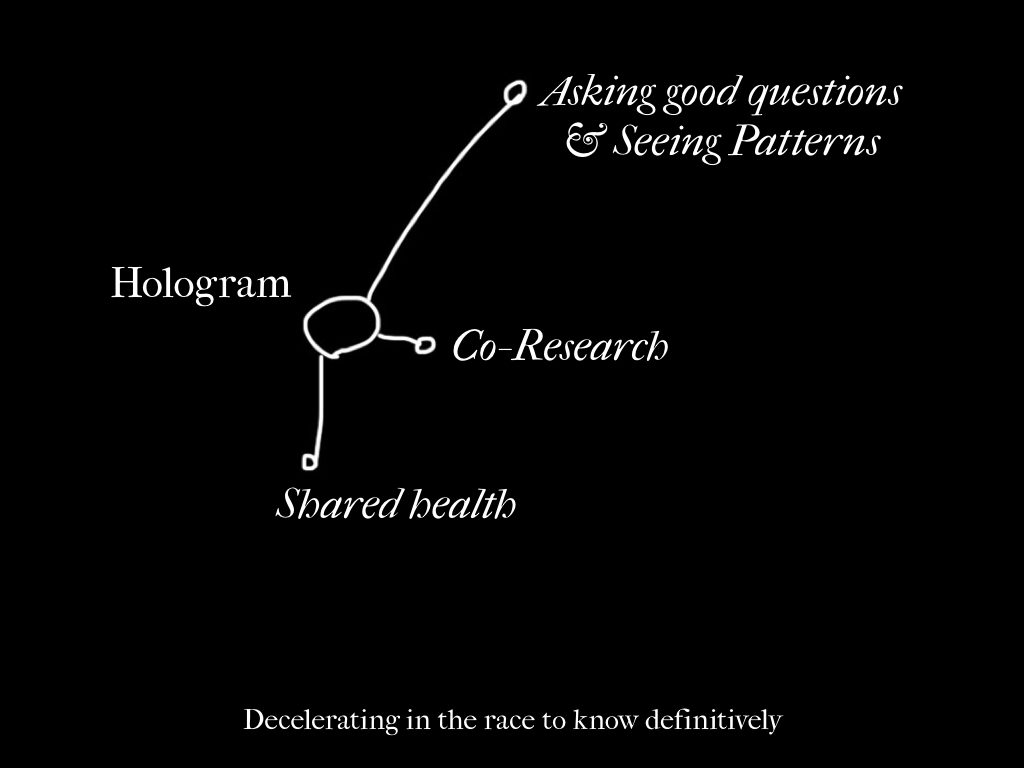
But, in order for the Hologram to receive this care without charge and guilt free, she needs to know that her patience are taken care of as she is. I think this is one part of the project that acknowledges and makes a practice built from the work of feminists and social reproductive theorists – you can’t build something new using the labor of people without acknowledging the work of keeping those people alive; reproducing the energy and care we need to overturn capitalism needs a lot of support. Getting support from someone feels so different if you know they are being, well taken care of. This is also how we begin to unbuild the hierarchical and authoritarian structures we have become accustomed to – with empty hands and empty pockets.
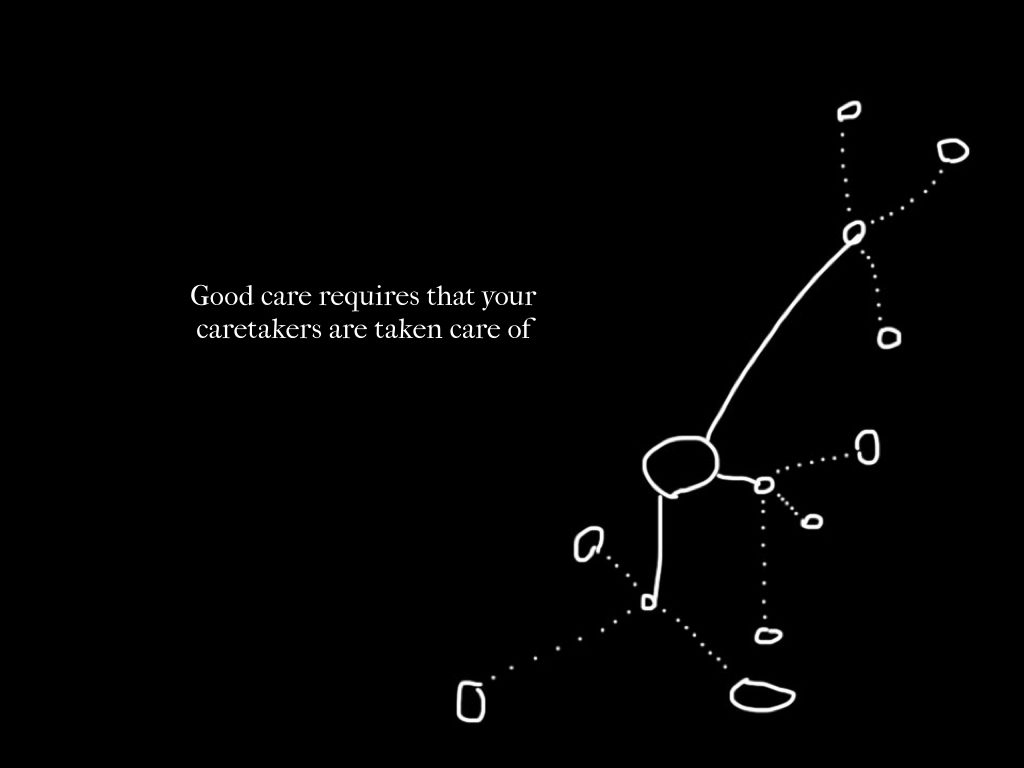
And then, the last important structural aspect of the Hologram project is the real kicker, and touches on the mystery of what it means to be human outside of Clientelist Capitalism – that the real ‘healing’ (if we even want to say it!) comes when the person who is at the center of care, turns outward to care for someone else. This, the secret sauce, the goal and the desired byproduct of every holographic meeting– to allow people to feel that they are not broken, and that their healing is bound up in the health and liberation of others.
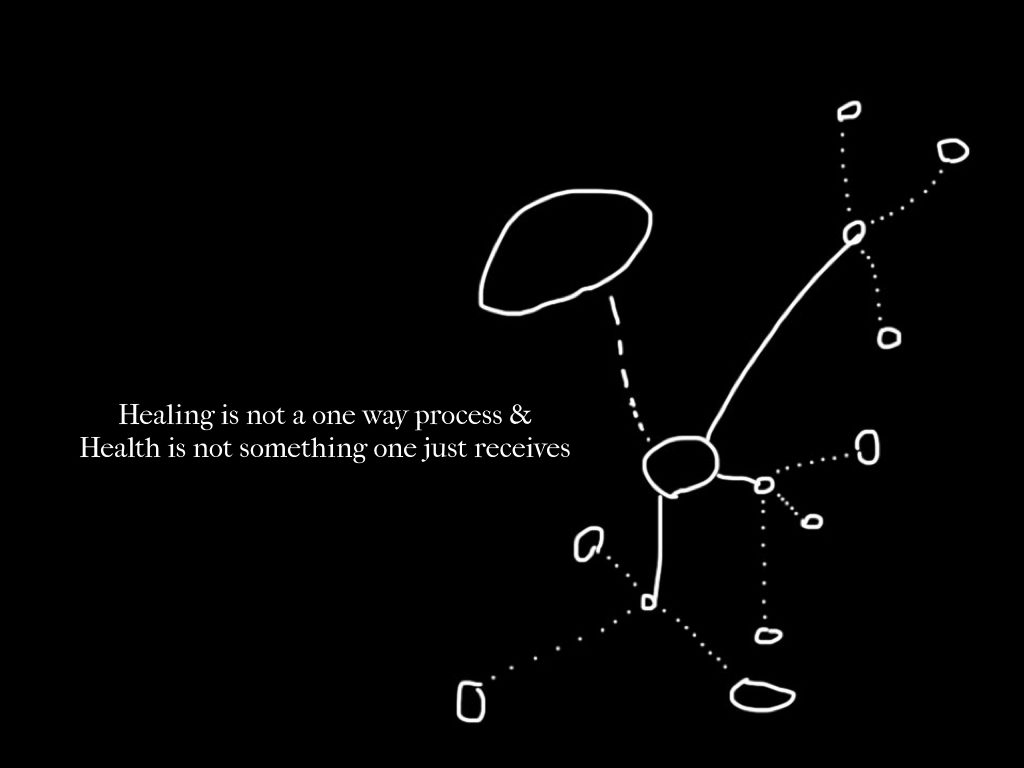
The viral structure, is built into this system and there is a reversal of the standard way of seeing the doctor and patient relationship. In this structure it is essential that we see the work of the Hologram as the work of a teacher or explicator, delivering a case that will ultimately allow the patience to learn things they didn’t previously know. This is the most important, (though totally devalued by money) potent and immediately applicable, form of learning we can do, and it is what the medical system has made into a commodity, at the same time as it is seen as ‘women’s work’ or completely useless.
MG: Could you take us through the processes of engagement. For instance, you say a group of four people meet and select one person who will become a Hologram, and that this means they and their health will become ‘dimensional’ to the group. Could you elaborate how this happens and why it’s important for those involved?
CT: We are about to experiment, this fall, with what it means for these groups to form in different ways. We will start with four test cases, where an invited, self-selected person will become a Hologram. She will be supported to select three Patience in a way that suits her, based on an interview and survey. The selection of Patience is a part of the process that we have not had a chance to refine. It is not simple for any individual to understand what support looks like for them, or who they want support from, if they’ve never really had it.
The experiments we will work through this fall will attempt to understand what changes in the experience of the whole Hologram when the Hologram is supported by Patience who are trusted friends and family, acquaintances or highly recommended strangers. An ‘objective’ perspective from an outside participant also adds a layer of formality to the project, because, instead of a casual gathering of friends, an unfamiliar person signals to the other members of the hologram to be on time, and make the meetings more structured than a regular friend to friend chat.
The onboarding process for the Hologram and the Patience includes a set of conversations and a training ritual, which are still quite bumpy. The two roles every participant is involved in, requires a different set of skills, and so they both involve a special kind of “training” that one can do in a group or independently. This “training” is a structured personal ritual that allows participants to witness and adapt their own communication habits so that they feel prepared to participate and set up trust, curiosity and solidarity for the group in the opening intake conversations.
At the completion of the intake process, the Hologram (1) transitions to become a Patience. At this time, the Hologram (1) begins a short training to transition to the other role, and she is supported by her Patience to do this work. At the conclusion of the Hologram’s (1) transition to Patience, and the completion of the new Hologram’s (2) intake process, the original Hologram’s (1) Patience become Holograms (3,4,5).
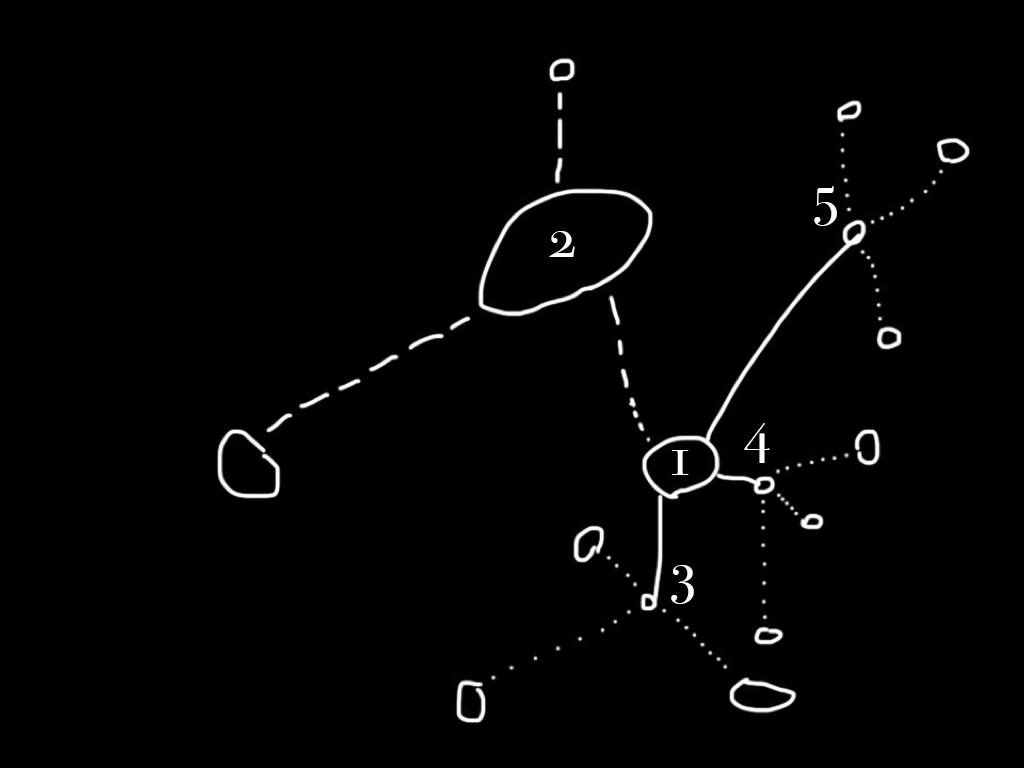
MG: The Hologram project was first trialed as part of an exhibition called Sick Time, Sleepy Time, Crip Time at the Elizabeth Foundation Project Space in New York City, March 31-May 13, 2017. What have you learnt in more recent undertakings of The Hologram project?
CT: Since the original trial one year ago, which lasted for 3 months, the research has shifted to looking at building skills and answering acute questions that will accumulate to support and build the larger project. Starting in the Spring of 2017, I began to offer the Hologram project as a workshop, where participants could test the communication model that is implicit in the Hologram format. The method for offering it is, as a performance artist and rogue architect, creating a situation in a space where people go through a difficult psycho social physical experience together. In the reflective conversations that follow, I ask the groups to use the personal pronoun ‘we’ for the entire duration of the conversation. The idea is that one person’s experience can be shared by the group, and even as temporary Patience we can take a leap and share their experience with them for a duration of time, allowing a Hologram to feel as if their experience is “our” experience. And this feeling that one is not alone in an experience, if carried into other parts of life, has the potential to break a lot of the assumptions and habits that we have inherited from living and adapting to a debt driven hellscape.
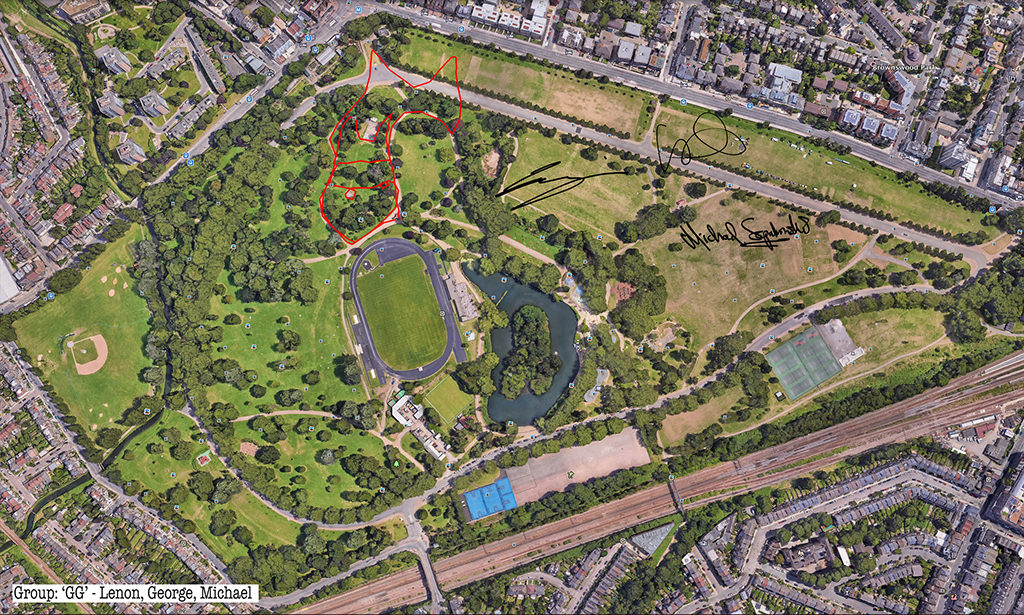
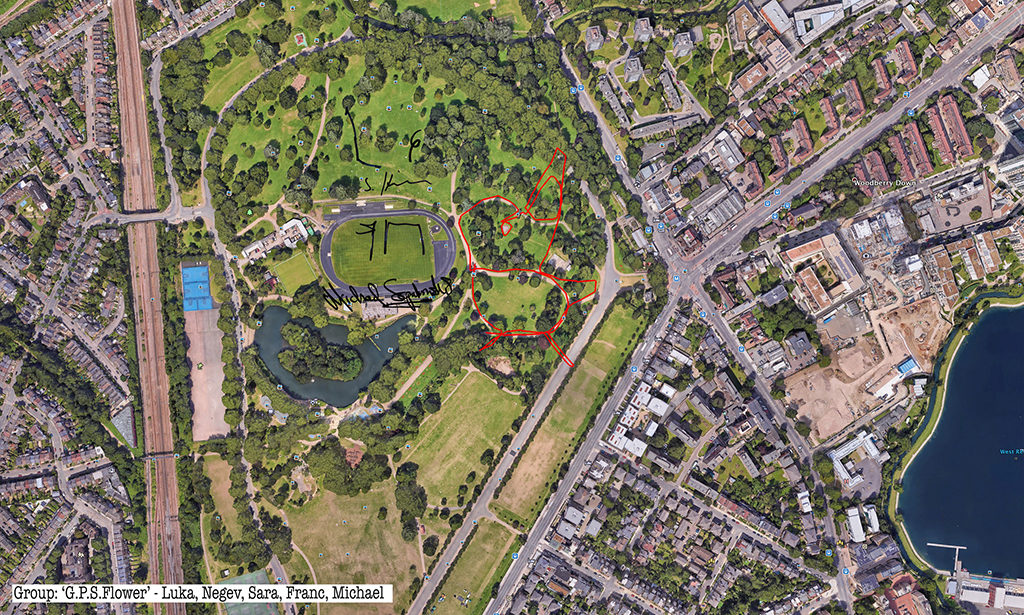
Recently I was approached to conceive and run an outreach project to accompany a solo show of work by Eduardo Kac at Furtherfield Gallery in North London’s Finsbury Park.
Among the works on show was one of Kac’s Lagoogleglyphs, large scale stylised representations of rabbits (something of a signature obsession for him) painted in some sort of sportsground emulsion directly onto a section of the park and allegedly of a scale which make it harvestable by the satellites Google rents for its various mapping activities.
Being completely frank, I have to say I entertained a degree of scepticism about Kac’s work—some of it falling within, in my view, one or both of two entertainment based metaphors—the ‘one-liner’ and the ‘theme park’—neither particularly positive elements of my critical lexicon.
Be that as it may, some of the work, particularly the less grandiose pieces (that delicate bunny flag flapping above the gallery!) were touched enough with real poetry to make me want to take up the challenge.
I say ‘challenge’ advisedly for I’m only ever interested in doing anything which in some sense challenges me and I also felt that my ambivalence about Kac would result in anything I ended up making containing a return element of ‘challenge’ or, perhaps more gently put, practical critique.
The word challenge also described the sense I had of wanting to counterpose collaboration, the collective, the everyday, to the artist with a capital ‘A’; of going some way to claiming art as a way of seeing and feeling and thinking together for All ( also with a capital ‘A’).
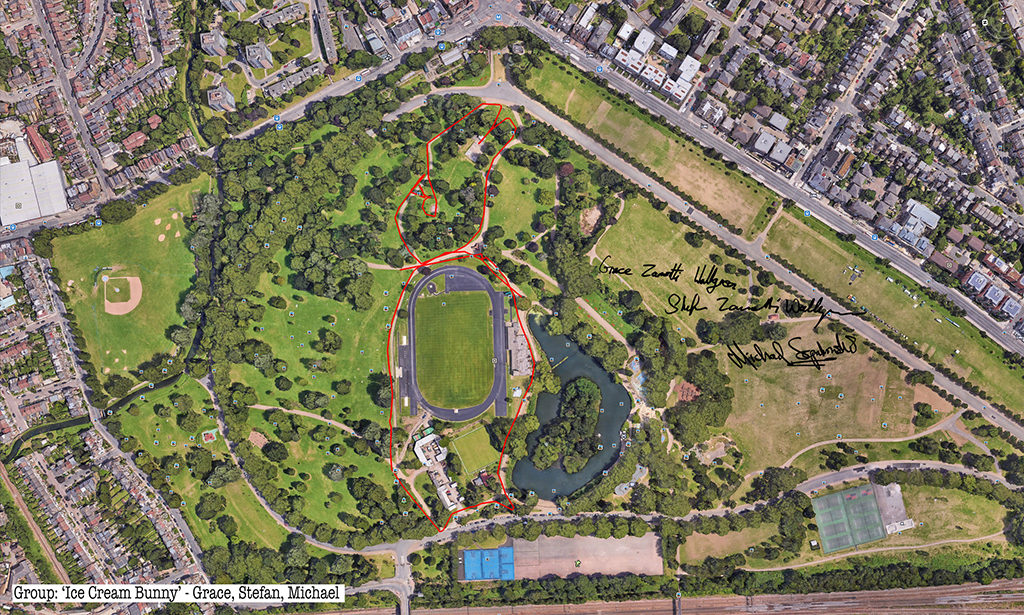
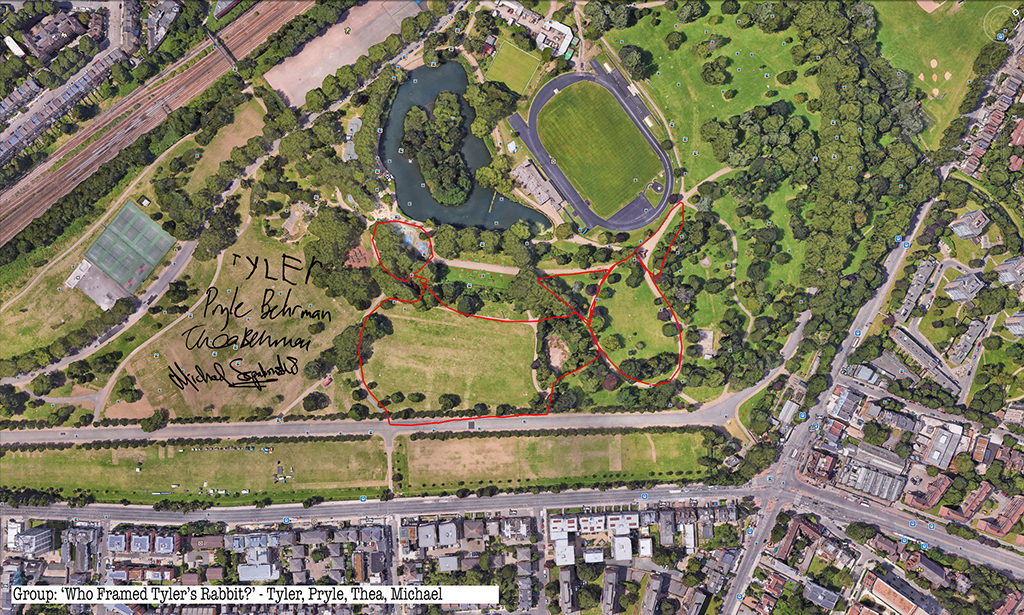
Reaching back in memory I pondered two remix/homage projects from the noughties which somehow straddled, in a pleasantly clunky fashion, practices both cutting edge digital (at least in their original moment) and time honoured too.
Apposite and practical stimuli for my 2018 purposes, they suggested elegant pathways to both honour previous work and to gently…um… stress-test it.
Both evinced rich humour, a warmth and a concomitant refusal to take themselves too seriously, qualities lacking in much contemporary art and both had a kind of performative klutziness I found entirely engaging.
Both were made in the first years of this millennium when digital and particularly online art was a wild west with a few fragile homesteads scattered here and there and not the orderly space it is today colonised almost entirely by the mainstream art world or commerce or both.
I recalled first a project by Nathaniel Stern where he hired South African billboard sign writers to paint physical representations of various, mostly art related, web pages.
The second was artist duo MTAA’s remix of Tehching Hsieh’s One Year Performance project, an endurance piece where Hsieh had forced himself to punch a timeclock on the hour, every hour for a whole year.
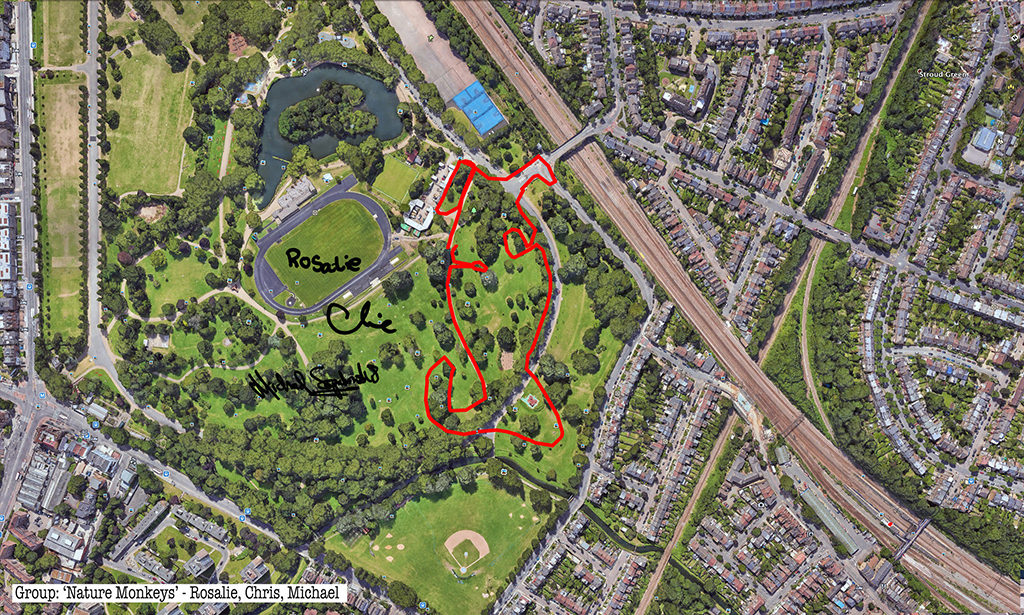
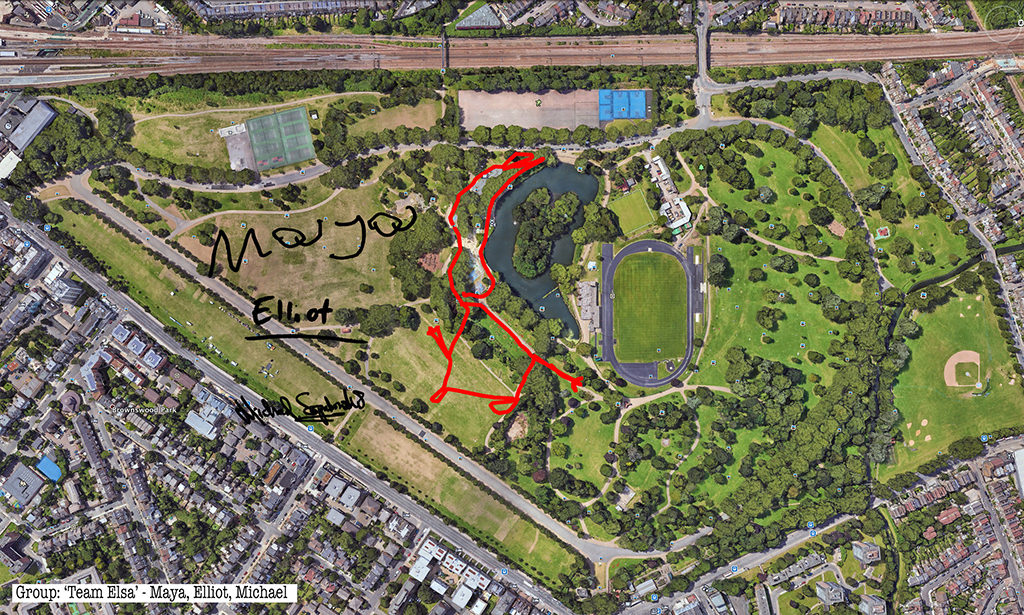
Reversing the premise MTAA’s Whid and River posted a database of video clips of themselves sleeping, eating, inhabiting the space and left it to the online viewer to watch these being digitally assembled (by Flash—remember that?) into a simulacrum of the original over the assumedly continuous period of a year.
Armed, fortified, prepared thus, I set to work—but I still needed a concrete plan and methodology.
Being a keen runner and the project taking place in a London Park in which I had run a 10k not long before (and now having endurance floating near the top of my mind) I felt some kind of park related physical activity would be an element and this would be a way of coming closer to those who loved the park but for whom the art gallery might not be their first association.
But still I lacked the concrete rabbit themed activity which would offer genuine practical, meaningful and autonomous artistic engagement and creation to participants.
I did not want to control what those participants would do but give them a clearly defined (clearly defined enough that all inputs from three separate days of activity could be brought together into a final unified work) and interesting task within which they would need to deploy creativity, focus and skill.
The fad for exercise related GPS devices had previously passed me by but one day whilst running with my daughter, who uses her phone and GPS enabled software to document her running in data and map form, I had a small epiphany—here there (might) be rabbits.
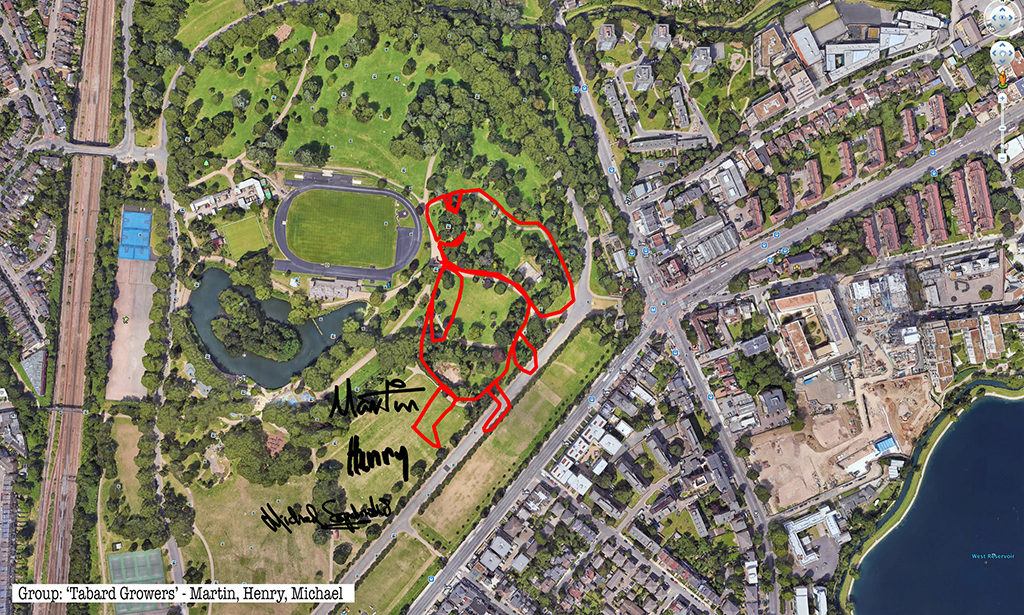
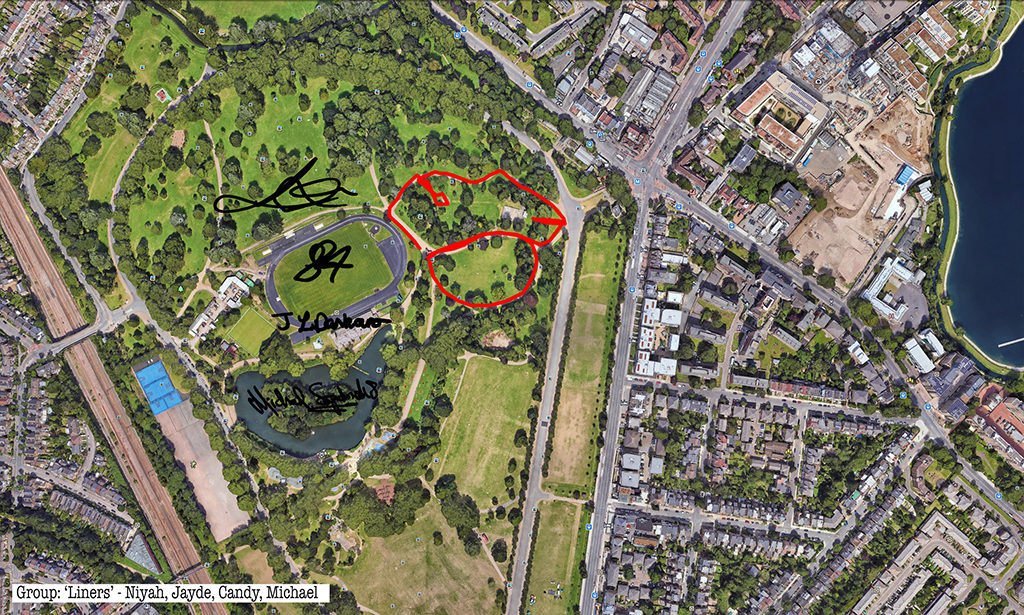
Rabbits, giant GPS rabbits, first planned and sketched by participating teams in marker pen over a satellite image of the park—ears, eyes, paws, body, fluffy tails emergent within its various paths and trails and features and obstructions.
And then, using these maps, we would carefully and attentively walk-out each monster rabbit trapping and freezing it as a succession of data, a series of co-ordinates in the memory of the GPS watch I would wear, finally to be reconstitututed as a continuous line drawing in turn fed back into a fresh satellite view of the park.
But that succession of co-ordinates, actuated by the actual movements of the human body (like a giant pencil lead or nib or brush) will resolve itself into something ancient—line, preconceived and then drawn out by human beings.
Being, together, both the very oldest form of mark making and something blink-of-an-eye recent too (well, as recent as the noughties efflorescence of so-called locative media which I shamelessly pillaged here.)
Inaccuracy in some measure a feature of both ancient and modern—the error margin of even GPS and GLONASS together, two sets of four satellites working in concert; the mix of will and skill and the fallibility and triumph too of flesh and bone and sinew which is part of what thrills and moves us in the arts.
This is what I had in mind.
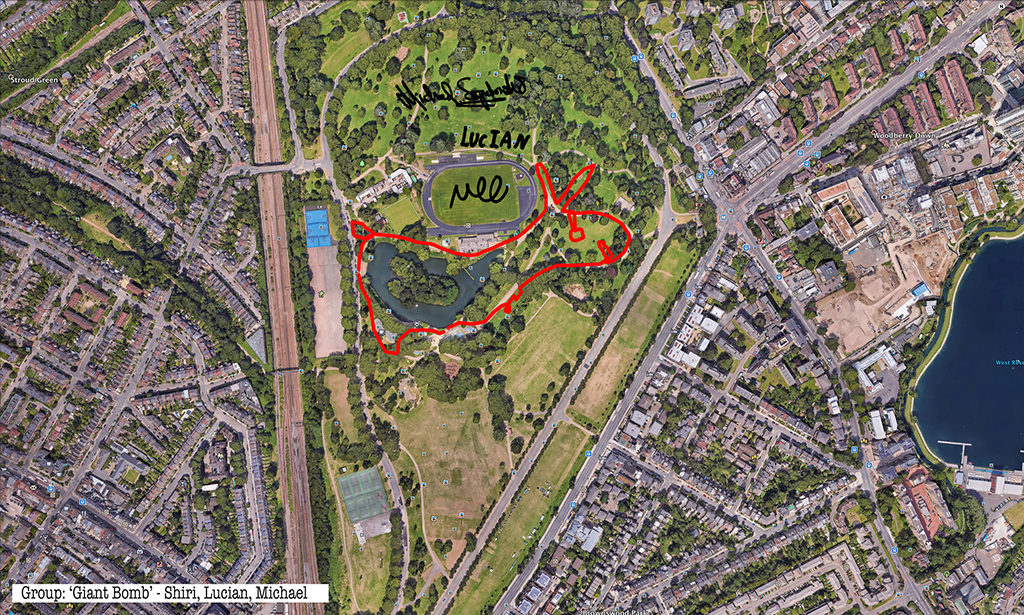
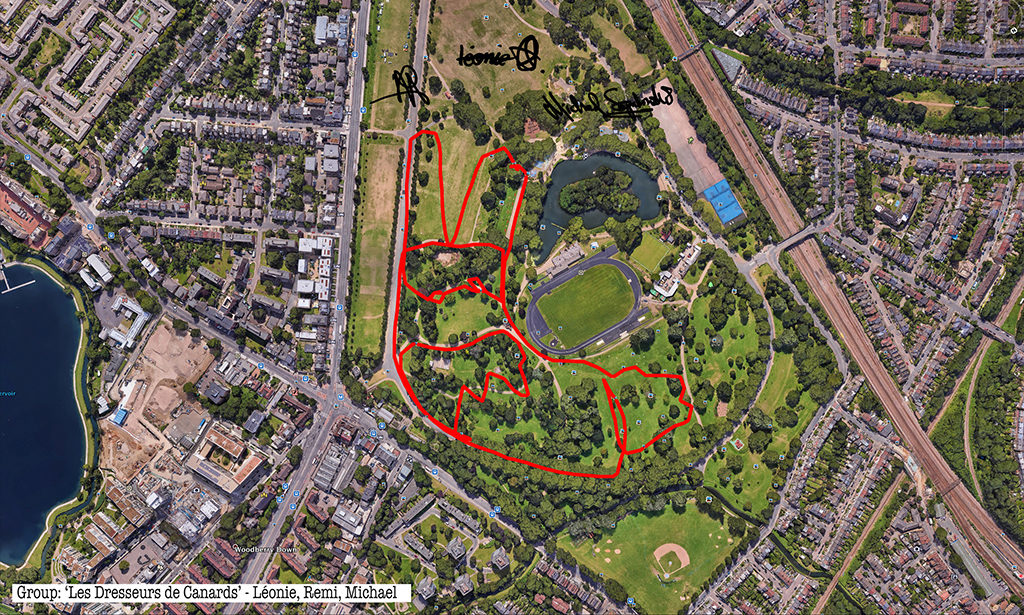
Repeatedly outlining then co-performing an activity which I learned to summarise simply and precisely, almost automatically, one might have thought boredom or a dozy, parroted, routine might threaten.
And how anxious I was each time as to whether and in what way each new team would engage with—buy into—adopt as theirs, as ours—the task.
But how striking the variation both in the simple, basic act of depicting in continuous line each new rabbit-of-the-imagination and the forty minutes lively sociability surrounding that initial sketching and subsequent walking-out.
Balancing the competing claims of making something serious, something with some kind of weight, some satisfying end product, whilst making space for others’ fun and dreams and and will and whimsy is neither easy nor is it trivial.
In the end people seemed to have a good time, they seemed at ease, went at it with a will and—it seems to me—something rich and affecting emerged.
Thanks to all at Furtherfield and thanks—no, not thanks, but credit—to my fellow artists: Alessandra, Anna, Candy, Chris, Elliot, Evgenia, Franc, George, Grace, Henry, Jade, Lenon, Léonie, Lucian, Luka, Martin, Matthew, Maya, Negev, Niyah, Pryle, Rémi, Rosalie, Sara, Shiri, Stefan, Thea and Tyler.
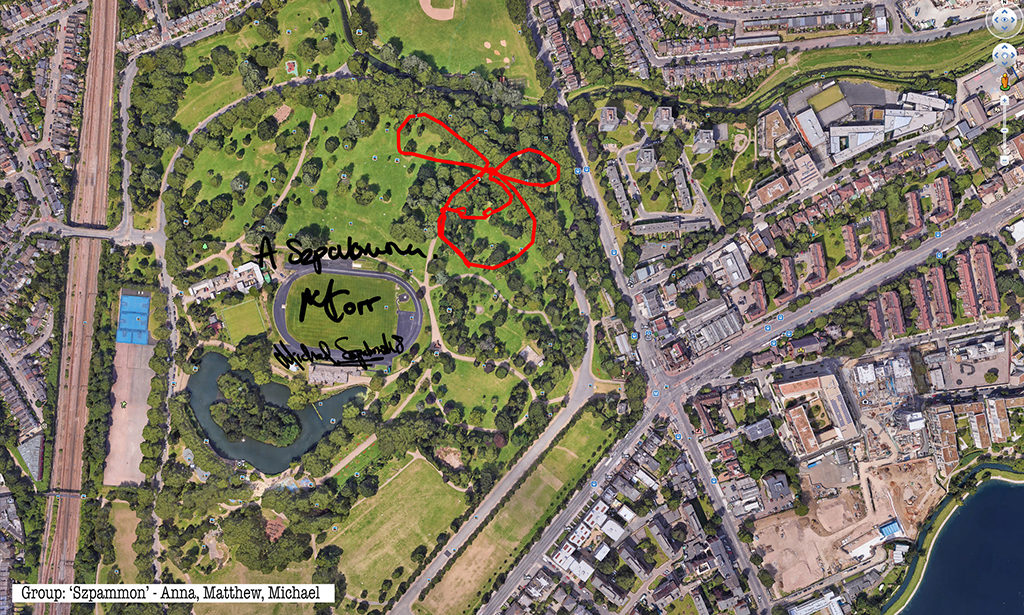
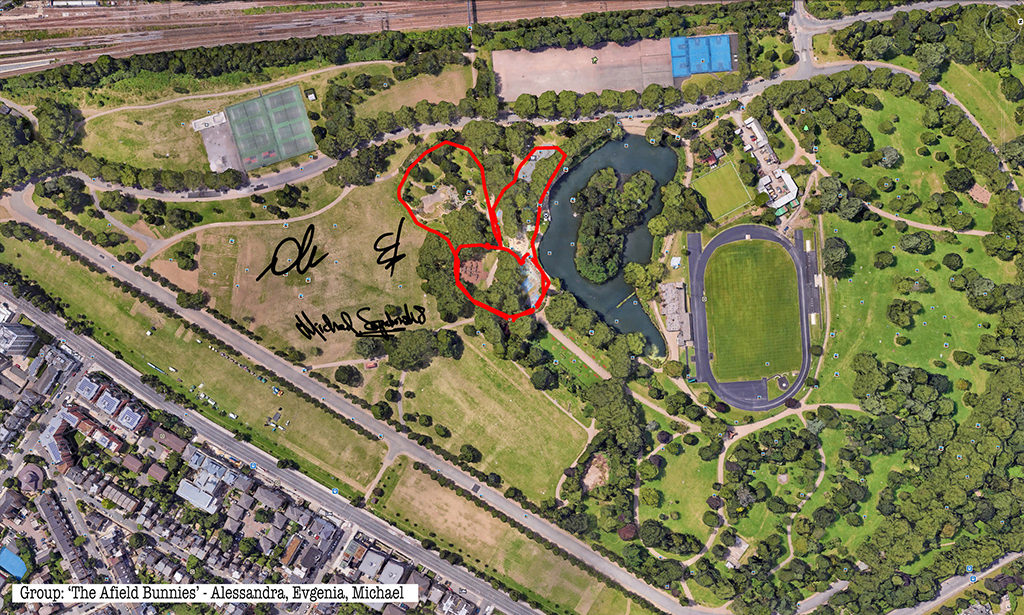
Mark Hancock discusses the politics and artistry of Janez Janša’s identity interventions in the context of their recent challenge at the Parliamentary Elections in Slovenia, in June 3rd 2018.
Ideas firmly deduced, tested against all variables and tentatively sent out into the world for appraisal by others, soon betray us as they bend to the whims of anyone they encounter. But that’s the nature of the malleable, post-digital world we live in. Ideas have to adapt and change to suit the warp and weft of the society if they are to survive in some form. How do we lock down our ideas into their final form? And what level of commitment can we expect from our ideas even if we apply intellectual property rights and that centuries-old mark of authenticity, the signature? The art world is particularly vulnerable to the conceit of signed authenticity. A signature often being the only guarantee that you’ll see any return (financial, reputational or otherwise) on your investment. If you really want to play with systems of power and bureaucracy, try altering artist names.
Davide Grassi, Emil Hrvatin and Žiga Kariž all changed their names to Janez Janša in 2007, joining the conservative Slovenian Democratic Party (SDS) at the same time, to explore the bureaucratic and political systems of their home country, Slovenia. The foundation of their actions ever since has been the question: what power exists in a name? And not just the art power system, but what political forces come into play when that name also belongs to the leader of the Slovenian Democratic Party, Janez Janša, (Prime Minister 2004 to 2008 and then again in 2012 to 2013). Incidentally, or perhaps not, Janez Janša, the politician was born Ivan Janša. The renaming of the three artists becomes a sort of double bluff when you also start to ask who the ‘real’ Janez Janša is.
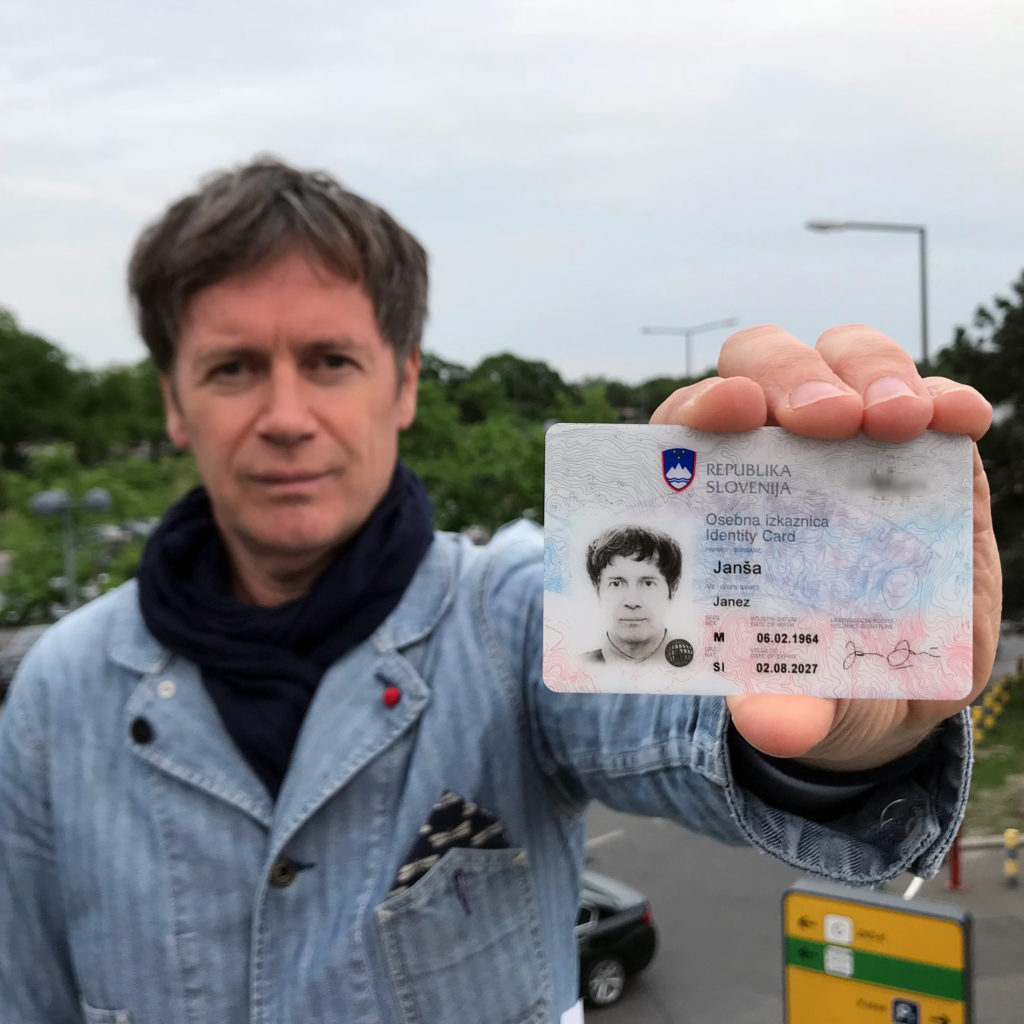
It would be easy to assume that the work of Janez Janša is simply another playful, flaccid baiting of the art world and right-wing political hegemonies. All too often work that challenges the political system might as well be challenging the rules of the Italian Football League, for all the difference in the world it makes beyond the enclosed loop of the art community. There’s only so far that insulting the work of Damien Hirst with another work of art can get you. But the Janez Janša artists have chosen to pierce through the membrane of the art world and make a social difference.
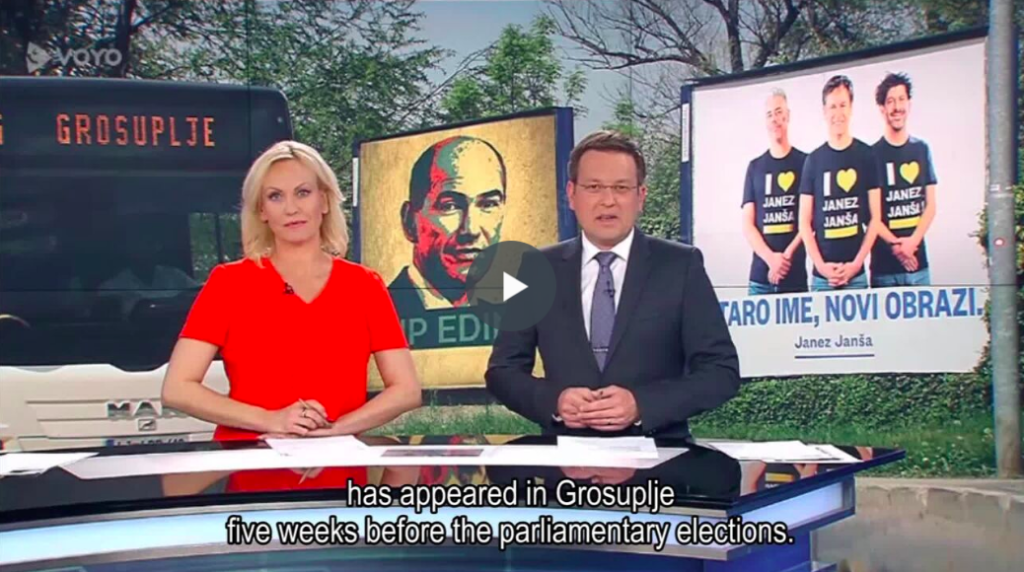
In the Slovenian Parliamentary Elections on the 3rd June 2018, one of them ran as a member of the opposition party, Levica (The Left) in Grosuplje the home district of the ex-Prime Minister, Janez Janša. In a press release, Janez Janša (the artist) said: “Running for parliament is a logical consequence of the view I have towards society. I care about what is happening. I react to things. I want to change them. (…) Society must be organized in such a way that the state begins to serve its citizens, as opposed to serving capital. Capital has no interest either for society or for art or for the individual.”
There is something inherently political in multiple authors using a single name, at least if you cast an eye over recent history. Reference points include Wu Ming, the Italian author collective that produced a number of literary works (they published a best-selling novel, Q, in 1999). They evolved from the Luther Blissett collective, whose playful, socially engaged activities defy the concept of the singular creative voice. This concept seems so alien to much of the mainstream media, particularly in Wu Ming’s home country of Italy, where they have been accused of everything from cybercrime to the less savoury aspects of rave culture. It’s this uncertainty about ownership that seems to bring a nervous lump to the throat of media and political gatekeepers. Perhaps this revolves around two questions so central to capitalism: If you’re doing nothing wrong, why hide behind a nom de plume or a collective? And, who do I send the check to, if I want to buy an Art?
On top of this, copyright issues become complex when the roster of names increases as well. Because we still want ideas to be owned, even when they are expanded through homages and pastiches. Copyright, as the attorney representing the Janez Janšas points out, is a legal construct, protecting, “original artistic (and scientific) creations, which are expressed in any way. A work is protected by copyright only if it was created by a human being (an author) and bears a stamp of author’s personality.” With work by Luther Blissett and Wu Ming, at least the authors can be understood as ‘artists’, even anonymously. Janez Janša, Janez Janša and, last but not least, Janez Janša have layered this authorship of their artwork with another layer of copyright/ownership complexity.
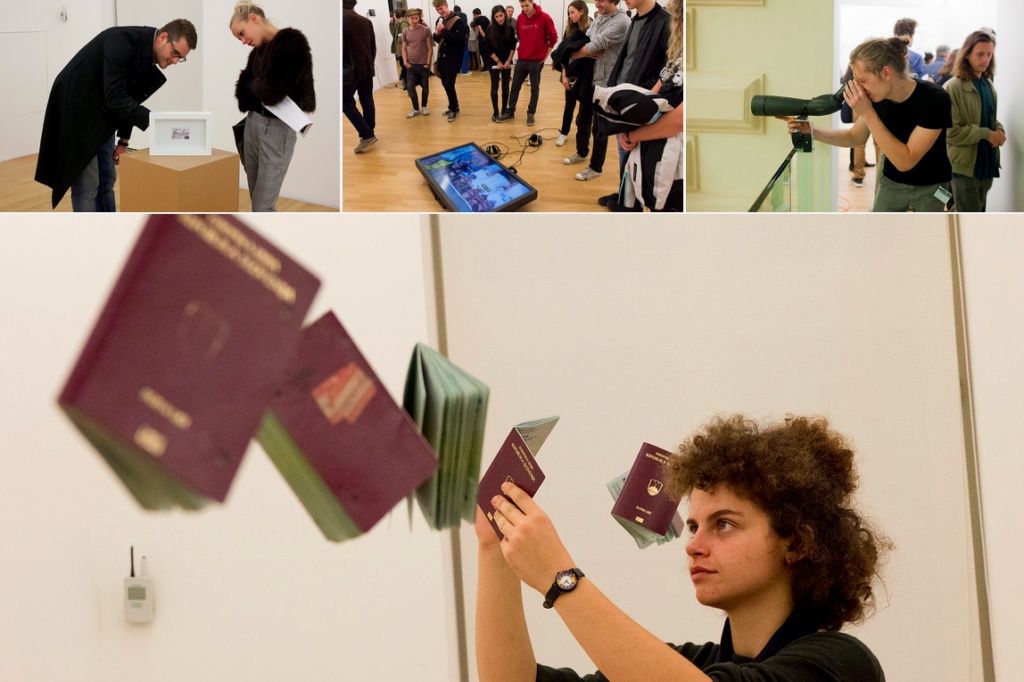
They refer to this work as collateral art, a phrase resonant with the phrase collateral damage, used to describe the acceptable casualties of battles. Collateral art is the acceptable damage on their ideas and projects from engagement with companies and institutions: ID cards, membership cards, the whole panoply of detritus that comes with the work. The artists want this collateral art, often customised by companies on request, to question the relationship between artworks and functional objects, “exploring post-Fordist means of production.” Any art historians still trying to shoehorn the belief of the gifted singular genius crafting his (note the gender pronoun: now discuss) solo masterpiece, probably hasn’t been paying close enough attention. The individual work of art often only becomes such with the signature of the artist attached as providence. When the work of art carries the signature of a non-artist though, can it still be brought into the art world as a valid comment on… anything? Paperwork sent to institutions by Janez Janša, and signed by an official becomes art. But whose art?
The answer, of course, is that it is their art. Whatever bureaucratic grindstone the works have been milled under, they ultimately belong back with the artists. It is they who return the work back to the art world through the exhibition. The exhibition co-produced by Moderna galerija (MG+MSUM) and Aksioma – Institute for Contemporary Art, Ljubljana, and curated by independent curator Domenico Quaranta, in 2017, was a chance to display and reflect back on ten years of work by the artists. Called the Janez Janša® exhibition, on display were works including Signatures (2007 – ongoing) which explored interventions of the Janez Janša name into public spaces, such as the Hollywood Walk of Fame (Signature, 2007), or Signature (Copacabana), in Rio de Janeiro, 2008. Playfully appearing in numerous locations around the world. Or Mount Triglav on Mount Triglav, an action performed in August 2007. This action commemorated “the 80th anniversary of the death of Jakob Aljaž; the 33rd anniversary of the Footpath from Vrhnika to Mount Triglav; the 5th anniversary of the Footpath from the Wörthersee Lake across Mount Triglav to the Bohinj Lake; the 25th anniversary of the publication of Nova Revija magazine and the 20th anniversary of the 57th issue of Nova Revija, the premiere publication of the SLOVENIAN SPRING; this was a re-enactment of Gora Triglav (Mount Triglav), by the OHO group in 1968 and the latest in a chain of re-enactments, as it was also performed by in 2004 by the Irwin Group.
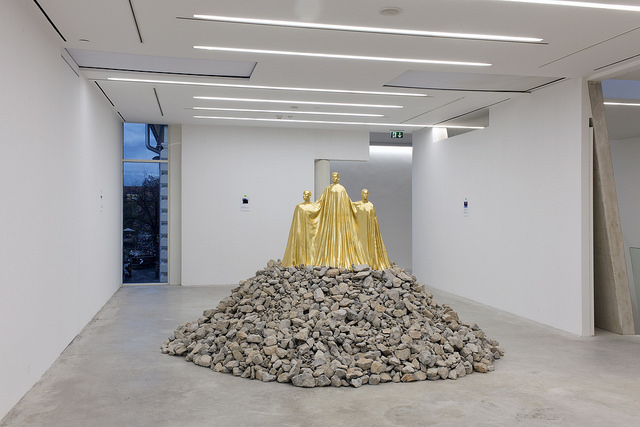
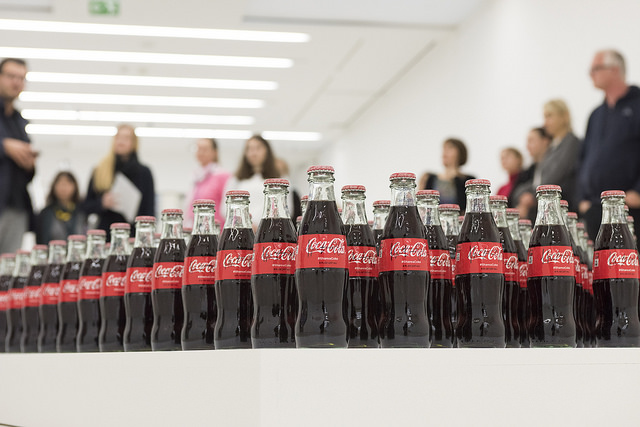
The conference in the same year, Proper and Improper Names: Identity in the Information Society conference, hosted by Aksioma – Institute for Contemporary Art, Ljubljana, and curated by Marco Deseriis in 2017, invited speakers including Natalie Bookchin, Marco Deseriis, Kristin Sue Lucas, Gerald Raunig, Ryan Trecartin, Wu Ming. The subjects under discussion arose from Marco Deseriis’ book Improper Names: Collective Pseudonyms from the Luddites to Anonymous. Deseriis, as keynote speaker, talked about the genealogy of the improper name. This is Deseriis’s term for the use of pseudonyms by artist collectives, including Wu Ming (who presented a talk at the conference) and Ned Ludd, the fictional leader of the English Luddites.
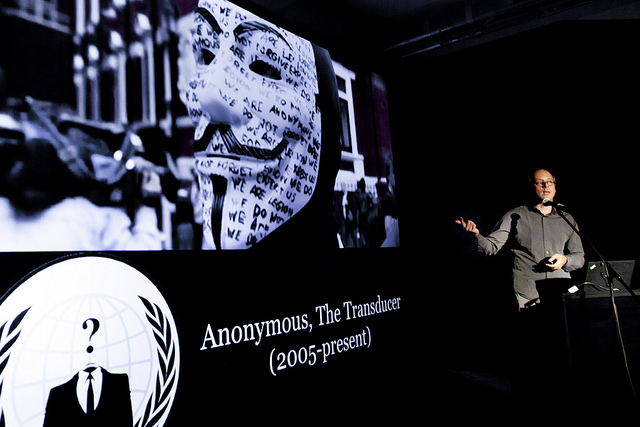
Releasing your ideas out in the wild doesn’t always guarantee they will come back to you unscathed or even return at all. The works of the Janez Janša collective are sent out to corporate systems, being adapted and altered, and returned. Or at the very least offering a challenge to accepted forms of ideological structures. In the Slovenian elections on 3rd June, the Slovenian Democratic Party (SDS) won with 25% of the votes. Levica won 9.0%. The SDS is a far-right, anti-immigration party, reflecting the increasing rise of right-wing parties across Europe right now. The leader of the SDS, Janez Janša, now has the opportunity to form a right-wing government. If this happens, and by the time you read this, it may well have, it would continue the shift in European Councils members towards the right.
There’s nothing new in declaring that everything is in flux. That’s the nature of our hyper-accelerated world. But right now there is a creeping sense that The Other is also to be viewed as The Enemy. The social, political value of art has to change to mean something in what is little short of a battle for a better society for ourselves and others across the globe if it is to have any value whatsoever. Janez Janša, Janez Janša and Janez Janša’s work reflect this evolution by being part of the society around them. Being part of the electoral system reflected this challenge and desire to be part of the real world and to make art mean something more than gallery space and conference papers. If art wants to survive and continue to belong to everyone, then it needs to be part of the world we are living in right now. No one work of art ever changed the world, but it helps us unravel and see through the propaganda of systems. We all need to become Janez Janša®.
The final outcome of the recent Slovenian Elections remains uncertain as Social Democratic Party’s Janez Janša attempts to form a coalition government.
More images at Flickr – https://bit.ly/2yniHYL
More about Janez Janša – http://www.janezjansa.si/about-jj/
SEE IMAGES FROM THE PRIVATE VIEW
Would you like to monetise your social relations? Learn from hostile designs? Take part in (unwitting) data extractions in exchange for public services?
Examining the way that the boundaries between ‘play’ and ‘labour’ have become increasingly blurred, this summer, Playbour: Work, Pleasure, Survival, will transform Furtherfield Gallery into an immersive environment comprising a series of games. Offering glimpses into the gamification of all forms of life, visitors are asked to test the operations of the real-world, and, in the process, experience how forms of play and labour feed mechanisms of work, pleasure, and survival.
What it means to be a worker is expanding and, over the last decade, widening strategies of surveillance and new sites of spectatorship online have forced another evolution in what can be called ‘leisure spaces’. From the self-made celebrity of the Instafamous to the live-streaming of online gamers, many of us shop, share and produce online, 24/7. In certain sectors, the seeming convergence of play and labour means work is sold as an extension of our personalities and, as work continues to evolve and adapt to online cultures, where labour occurs, what is viewed as a product, and even, our sense of self, begins to change.
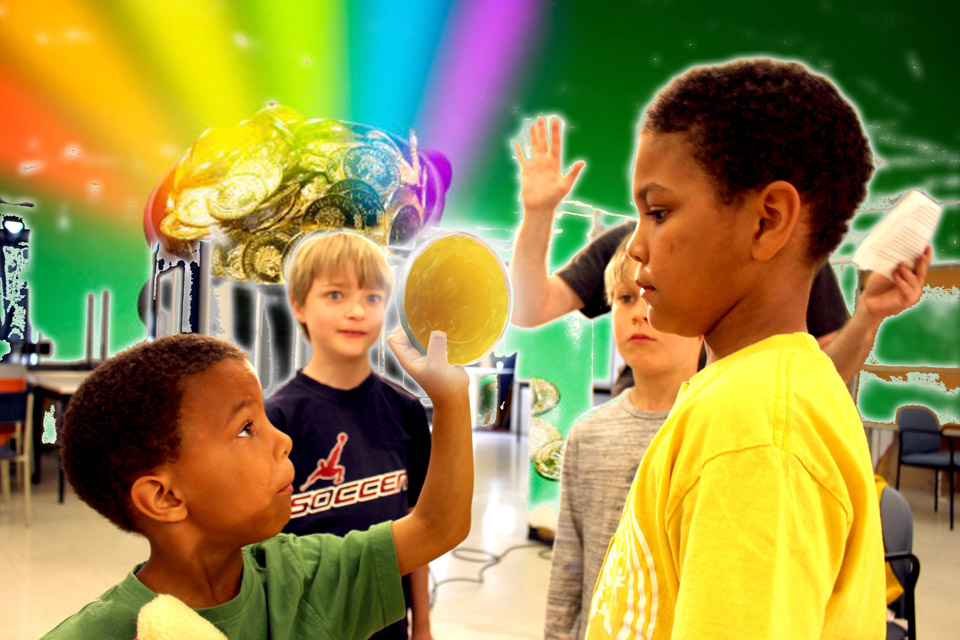
Today, workers are asked to expand their own skills and build self-made networks to develop new avenues of work, pleasure and survival. As they do, emerging forms of industry combine the techniques and tools of game theory, psychology and data science to bring marketing, economics and interaction design to bear on the most personal of our technologies – our smartphones and our social media networks. Profiling personalities through social media use, using metrics to quantify behaviour and conditioning actions to provide rewards, have become new norms online. As a result, much of public life can be seen as part of a process of ‘capturing play in pursuit of work’.
Although these realities affect many, very little time is currently given over to thinking about the many questions that arise from the blurring between work and play in an age of increasingly data-driven technologies: How are forms of ‘playbour’ impacting our health and well-being? What forms of resistance could and should communities do in response?
To gain a deeper understanding of the answers to these questions, we worked with artists, designers, activists, sociologists and researchers in a three-day co-creation research lab in May 2018. The group engaged in artist-led experiments and playful scenarios, conducting research with fellow participants acting as ‘workers’ to generate new areas of knowledge. This exhibition in Furtherfield Gallery is the result of this collective labour and each game simulates an experience of how techniques of gamification, automation and surveillance are applied to the everyday in the (not yet complete) capture of all forms of existence into wider systems of work.
In addition to a performance by Steven Ounanian during the Private View, the ‘games’ that comprise this exhibition are:
Lab session leads and participants: Dani Admiss, Kevin Biderman, Marija Bozinovska Jones, Ruth Catlow, Maria Dada, Robert Gallager, Beryl Graham, Miranda Hall, Arjun Harrison Mann, Maz Hemming, Sanela Jahic, Annelise Keestra, Steven Levon Ounanian, Manu Luksch, Itai Palti, Andrej Primozic, Michael Straeubig, Cassie Thornton, Cecilia Wee, Jamie Woodcock.
Curated by Dani Admiss.
Concept development Dani Admiss and Cecilia Wee.
Mask Making for Children
Sunday 22 July and 12 August 2018, 11:00 – 16:30
Furtherfield Gallery
FREE
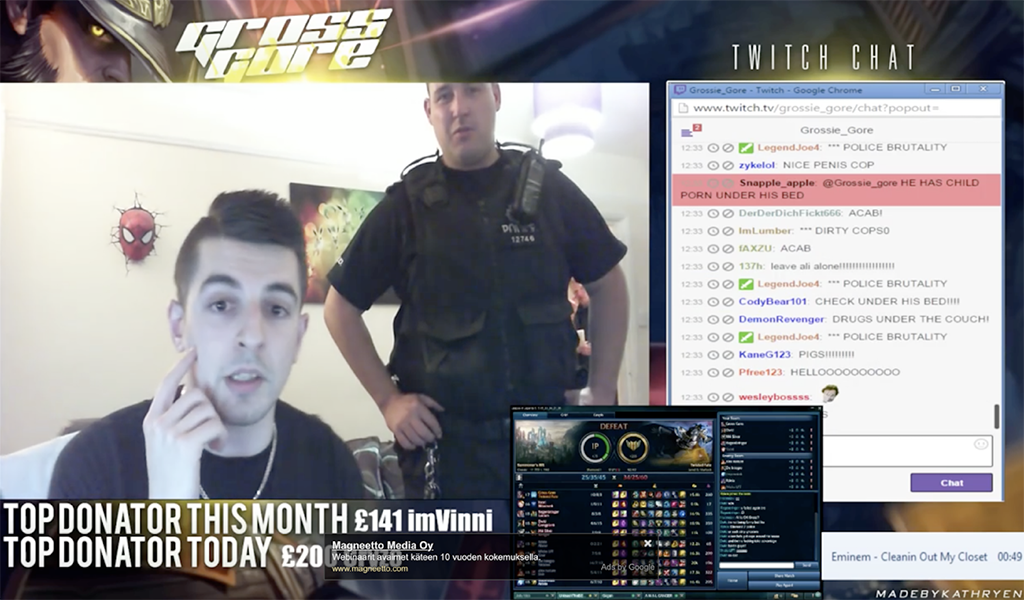
Dani Admiss
When I was 16 I was in a band. I couldn’t sing that well so I used to write lyrics (about vampires) and put them into Babelfish to translate them into French thinking it made me sound automatically cooler.
@daniadmiss
Kevin Biderman
First met you in a dial up world; green block letters on a black screen. Later we traversed through neon colours, pixelated images and imperfect designs. I always knew you were an army brat born out of apocalyptic fears but I never thought you’d turn your back on the counter-culture who raised you. Maybe there will be a third act…
@act3
Marija Bozinovska Jones
The internet has concurrently enhanced and diminished life, yet I appear no longer able to recall life before it. Adding to Jameson’s quote: it is easier to imagine the end of the world, than the end of TECHNOcapitalism.
Ruth Catlow
I am a recovering Web Utopian – decentralised infrastructure does not, it turns out, lead automatically to decentralised power. However i am still most excited by art that happens in wild flows, through collaboration on open channels, rather than being owned, certified and traded like dead matter. I am Ruth and I am one of the voices and pairs of eyes.
@furtherfield
Maria Dada
I regularly translate whole books from German to English using Google Translate. I then take the transcripts and print them using lulu.com. I take pride in the design of the covers for each book. Not all of them are unreadable but most of them just sit on my shelf untouched.
@mariadada
Beryl Graham
I confess:
To buying a mobile phone so that I could text my sweetie.
To being mildly obsessed with weather apps that work best in the North.
To using online dating 15 years ago. The respectable Guardian rather than Tindr of course – hey I’m not an animal.
@berylgraham
Miranda Hall
After school, my friend and I would take screenshots of penises on ChatRoulette then save them in a desktop folder on the family computer called ‘cool fish’
@Miranda__Hall
Arjun Harrison-mann
For Much Longer than I Would Care to Admit, Every Since I Got Msn at the Age of 12, My Msn Profile Picture Was (and I Just Checked, Still Is), a Photoshopped Collage of Michael Jordan.
@arjun_harrisonmann
Maz Hemming
When I was 11, lying about my age to sign up on msn chat to chat about neopets, I ended up as one of the chatroom moderators. Which sometimes ended up with me leaving the window open to idle overnight (or the room would close). On the bonus side when my parents ended up with a bill at the end of the month of £200 (which I didn’t know would happen) we did get broadband. Much cheaper.
@MazHem_
Robert Gallagher
The unread emails in my inbox currently outnumber my Twitter followers by a factor of 47.7461024499 to 1.
@r_gealga
Sanela Jahić
Once my inbox got flooded with promotions of an online store. So my boyfriend and I composed a simple bot, which took random quotes from our sci-fi eBooks collection and posted them as customer reviews on their product pages.
Annelise Keestra
Until more recently than I would admit, I genuinely didn’t think there was any correlation between the file size of a download and data use. As if, there were two kinds of “GB”. Please don’t judge me.
@aut0mne
Steven Levon Ounanian
I think the internet loves me, but just doesn’t know how to show it.
@levontron
Manu Luksch
Our dream rewired. Our powers of prediction grow with every new circuit crammed in. Leap into tomorrow – one trillion calculations a second. And it grows more powerful, becomes smaller. Smart, mobile, personal. Today – in our pockets. Tomorrow – woven into our bodies. Create and share, everything, everywhere. Life in the cloud… with a chance of blue skies. Our time is a time of total connection. Distance is zero. The future is transparent. To be, is to be connected – the network seeks out everyone.” (Dreams Rewired; 2015 – my latest feature film about our hopes and fears of being hyper-connected).
@ManuLuksch
Itai Palti
I started visiting an architecture news forum as a teenager, excited about updates on local building projects. I still visit regularly for the updates, but also make sure to check on an exceptionally cringeworthy, decades-long feud between a couple of regular posters. I think they’d really miss each other if it all stopped.
@ipalti
Joana Pestana
Back in 1999, frustrated, I nurtured no love for my iMacG3 as I had to bare with 1-song-download-per-week for not having Napster.
@joanampestana
Michael Straeubig
Before social networks and Reddit, newsgroups were the places for online discussions. Catering to my interests was comp.ai.philosphy, a group notorious for debates going haywire.
Once I had a very heated discussion with someone I considered to be an immature and irrational teenager. It turned out it was a professor in Artificial Intelligence.
@crcdng
Cassie Thornton
I own/owned these URLs: bizzykitty.com, temporaryartbeautyservices.biz, infinitemuseum.com, evilarchitexture.net, teachingartistunion.org, sfluxuryrealestatejewelry.org, mastercalendar.biz, debtimage.work, institutionaldreaming.com, poetsecurity.net, universityofthephoenix.com, debt2space.info, secretchakra.net, wombco.in, givemecred.com, wealthofdebt.com, strikedebtradio.org, matterinthewrongplace.info, futureunincorporated.com, feministeconomicsdepartment.com, projectherapy.org, and many more I will never remember.
@femnistecondept
Cecilia Wee
The first time I went on the internet was about 1 year after Cyberia cafe opened in central London. I somehow convinced my mum to make a detour from a shopping trip so I could go online to look at 2 websites. Everyone else there was working very hard.
@ceciliawee
Jamie Woodcock
I decided it would be a fun idea to learn to play League of Legends as part of the fieldwork for an esports project. However, I was so bad at it that instead I had to study before playing, reading up on guides and watching streams/videos.
@jamie_woodcock
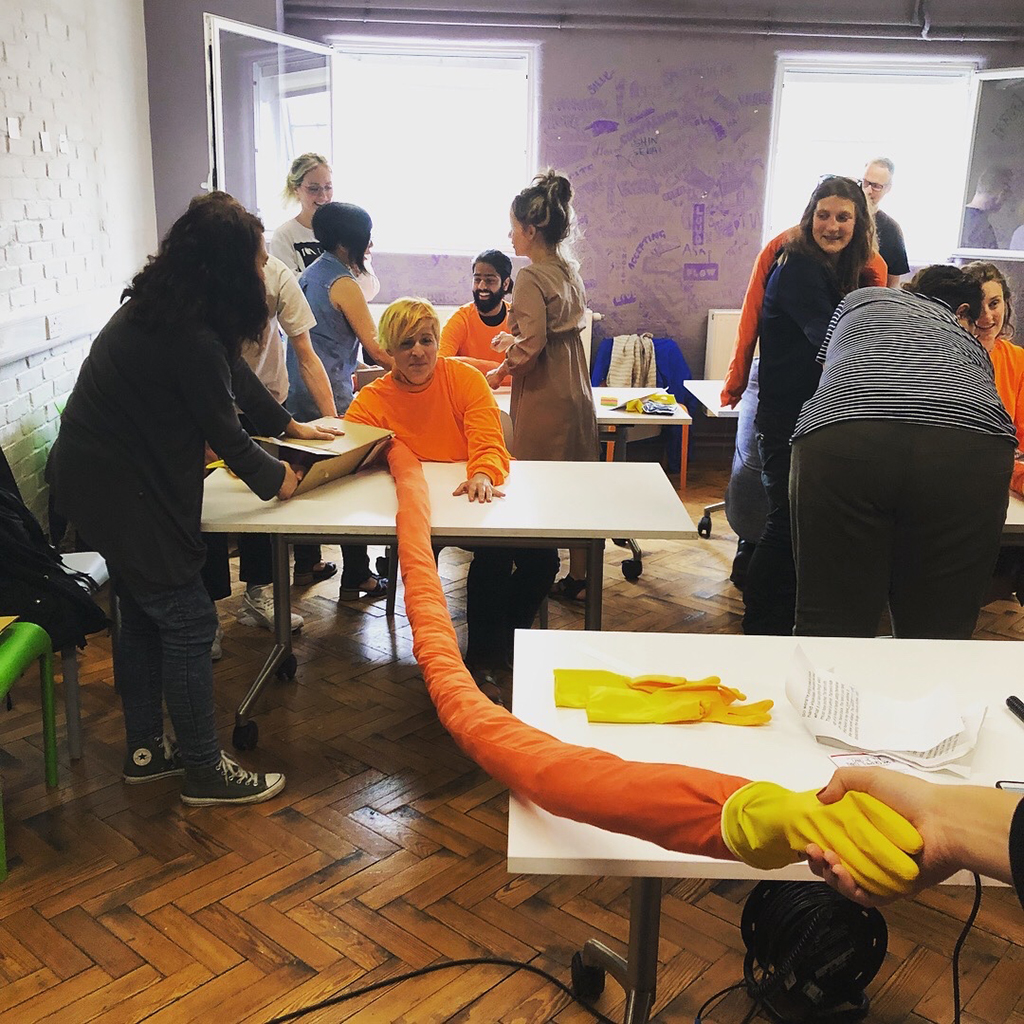
In the lead up to Furtherfield’s Playbour: Work, Pleasure, Survival exhibition Maria Dada, Miranda Hall and Cassie Thornton will be taking over the social media channels on Twitter, Instagram, and Facebook. Each micro-commission is an online space to take in different directions related ideas and themes of #playbour.
Our first week kicks off with Maria. Researcher in the fields of design and material culture, Dada’s Confessional Viral Hoax Engine brings together an interest in the infrastructures and processes used to spread misinformation online with themes of transparency, anxiety, and virtue signalling.
The second week is headed by Miranda Hall, who is a freelance journalist and research assistant at SOAS specialising in digital labour.
In the final week Cassie Thornton, artist, activist and feminist economist, will take-over Furtherfield’s social media channels. You can learn more about her here and her new project being launched on Kickstarter. Her take-over explores ideas surrounding yoga, feminist economics, class war, collective revenge, and social technology.
Dani Admiss is an independent curator and researcher working across art, design, and networked cultures. Her work employs world-building and co-creation to explore changes happening to our social, technological, and ecological, contexts. She is particularly interested in working with others to understand not yet completed transformations of body, society, and earth, into global capitalist systems. She is Founder of Playbour: Work, Pleasure, Survival, an art and research platform dedicated to the study of the worker in an age of data technologies. daniadmiss.com
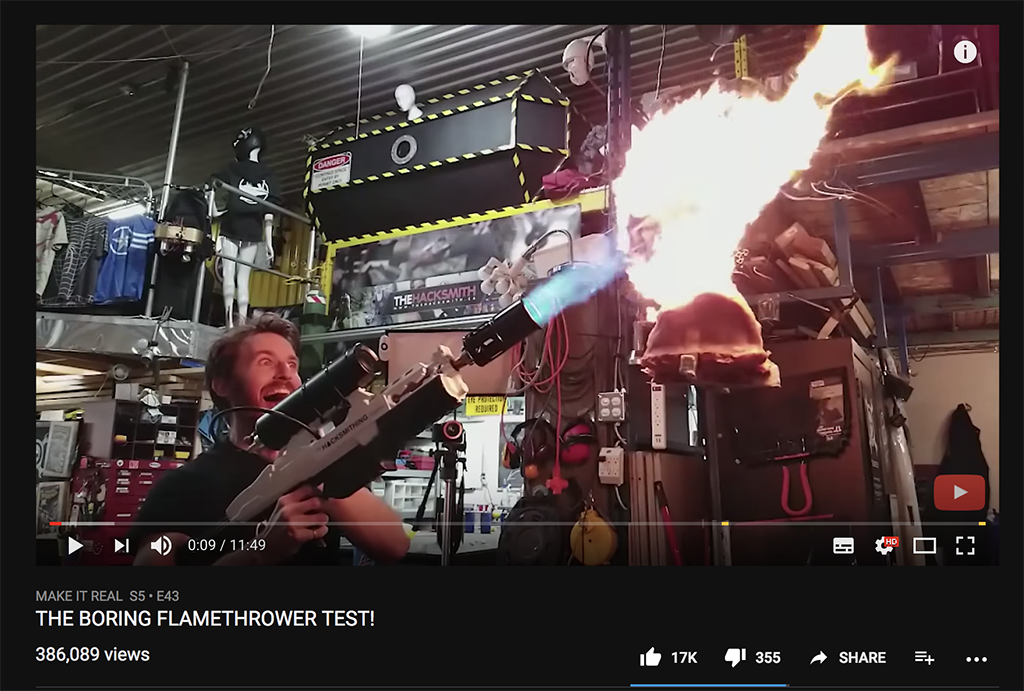
Furtherfield is an internationally renowned arts organisation specialising in labs, exhibitions and debate for increased, diverse participation with emerging technologies. At Furtherfield Gallery and Furtherfield Lab in London’s Finsbury Park, we engage more people with digital creativity, reaching across barriers through unique collaborations with international networks of artists, researchers and partners. Through art Furtherfield seeks new imaginative responses as digital culture changes the world and the way we live.
Furtherfield Gallery
McKenzie Pavilion
Finsbury Park, London, N4 2NQ
Visiting Information
This project would not have been possible without the kind support of our partners.
This project has been funded with the support from the European Commission. This communication reflects the views only of the author, and the Commission cannot be held responsible for any use which may be made of the information contained therein.
Playbour: Work, Pleasure, Survival, is realized in the framework of State Machines, a joint project by Aksioma (SI), Drugo More (HR), Furtherfield (UK), Institute of Network Cultures (NL) and NeMe (CY).
This is a long read by one of the inhabitants of the Zad, about the the fortnight rollercoaster of rural riots that has just taken place to evict the liberated territory of the Zad. It’s been incredibly intense and hard to find a moment to write, but we did our best. This is simply one viewpoint, there are over 1000 people on the zone at the moment and every one of them could tell a different story. Thank you for all the friends and comrades who helped by sharing their stories, rebel spirits and lemon juice against the tear gas.
“We must bring into being the world we want to defend. These cracks where people find each other to build a beautiful future are important. This is how the zad is a model.” Naomi Klein
“What is happening at Notre-Dame-des-Landes illustrates a conflict that concerns the whole world” Raoul Vaneigem
The police helicopter hovers above, its bone rattling clattering never seems to stop. At night its long godlike finger of light penetrates our cabins and farm houses. It has been so hard to sleep this last week. Even dreaming, it seems, is a crime on the Zad. And that’s the point: these 4000 acres of autonomous territory, this zone to defend (Zad), has existed despite the state and capitalism for nearly a decade and no government can allow such a place to flourish. All territories that are inhabited by people who bridge the gap between dream and action have to be crushed before their hope begins to spread. This is why France’s biggest police operation since May 1968, at a cost of 400,000 euros a day, has been trying to evict us with its 2500 gendarmes, armoured vehicles (APCs), bulldozers, rubber bullets, drones, 200 cameras and 11,000 tear gas and stun grenades fired since the operation began at 3.20am on the morning of the 9th of April.
The state said that these would be “targeted evictions”, claiming that there were up to 80 ‘radical’ Zadists that would be hunted down, and that the rest, the ‘good’ Zadists, would have to legalise or face the same fate. The good zadist was a caricature of the gentle ‘neo rural farmer’ returning to the land, the bad, an ultra violent revolutionary, just there to make trouble. Of course this was a fantasy vision to feed the state’s primary strategy, to divide this diverse popular movement that has managed to defeat 3 different French governments and win France’s biggest political victory of a generation.
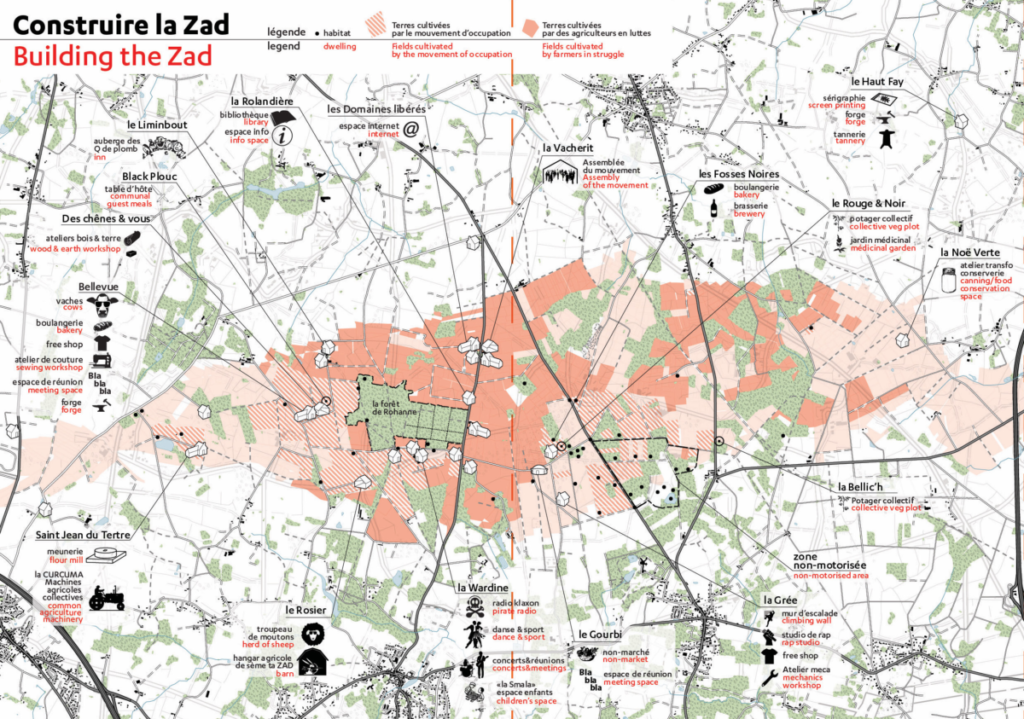
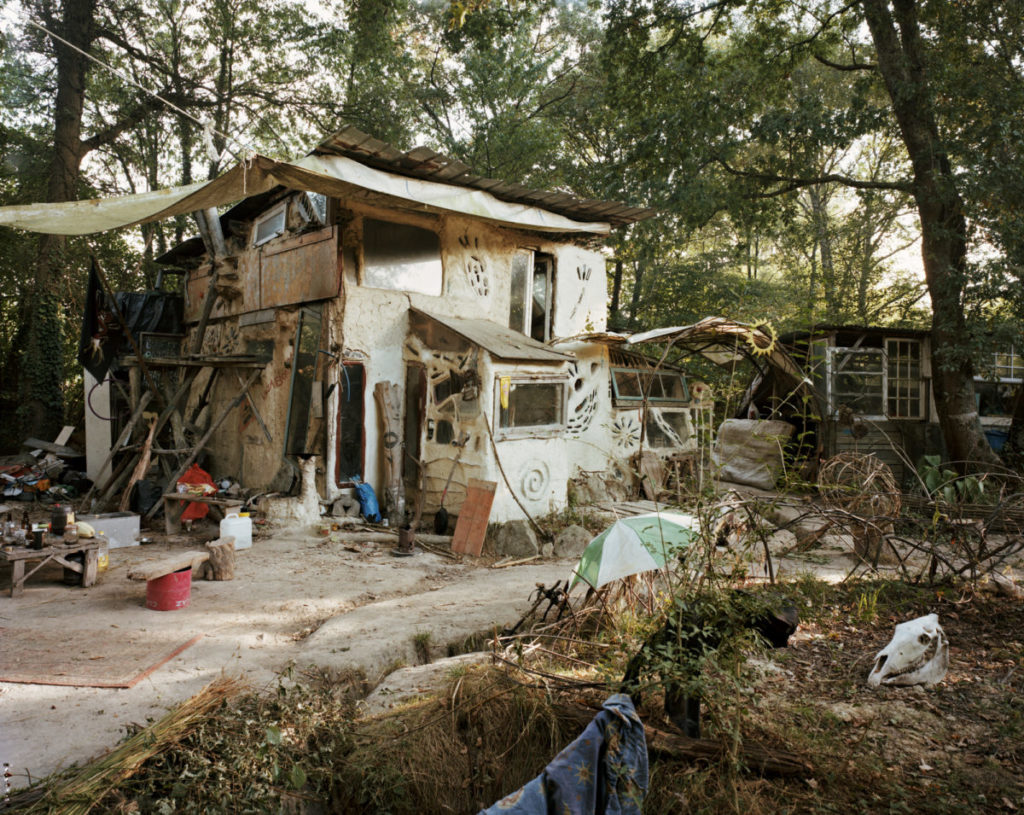
The zad was initially set up as a protest against the building of a new airport for the city of Nantes, following a letter by residents distributed during a climate camp in 2009, which invited people to squat the land and buildings: ‘because’ as they wrote ‘only an inhabited territory can be defended’. Over the years this territory earmarked for a mega infrastructure project, evolved into Europe’s largest laboratory of commoning. Before the French state started to bulldoze our homes, there were 70 different living spaces and 300 inhabitants nestled into this checkerboard landscape of forest, fields and wetlands. Alternative ways of living with each other, fellow species and the world are experimented with 24/7. From making our own bread to running a pirate radio station, planting herbal medicine gardens to making rebel camembert, a rap recording studio to a pasta production workshop, an artisanal brewery to two blacksmiths forges, a communal justice system to a library and even a full scale working lighthouse – the zad has become a new commune for the 21st century. Messy and bemusing, this beautifully imperfect utopia in resistance against an airport and its world has been supported by a radically diverse popular movement, bringing together tens of thousands of anarchists and farmers, unionists and naturalists, environmentalists and students, locals and revolutionaries of every flavour. But everything changed on the 17th of January 2018, when the French prime minister appeared on TV to cancel the airport project and in the same breath say that the zad, the ‘outlaw zone’ would be evicted and law and order returned.
I am starting to write 8 days into the attack, it’s Tuesday the 17th of April my diary tells me, but days, dates even hours of the day seem to merge into a muddled bath of adrenaline socked intensity, so hard to capture with words. We are so tired, bruised and many badly injured. Medics have counted 270 injuries so far. Lots due to the impact of rubber bullets, but most from the sharp metal and plastic shrapnel shot from the stun and concussion grenades whose explosions punctuate the spring symphony of birdsong. Similar grenades killed 21 year old ecological activist Remi Fraise during protests against an agro industrial damn in 2014.
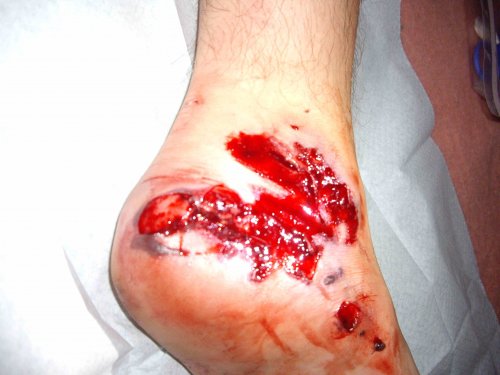
The zad’s welcome and information centre, still dominated by a huge hand painted map of the zone, has been transformed into a field hospital. Local doctors have come in solidarity working with action medic crews, volunteer acupuncturists and healers of all sorts and the comrades ambulance is parked outside. The police have even delayed ambulances leaving the zone with injured people in them, and when its the gendarmerie that evacuates seriously injured protesters from the area sometimes they have been abandoning them in the street far from the hospital or in one case in front of a psychiatric clinic.
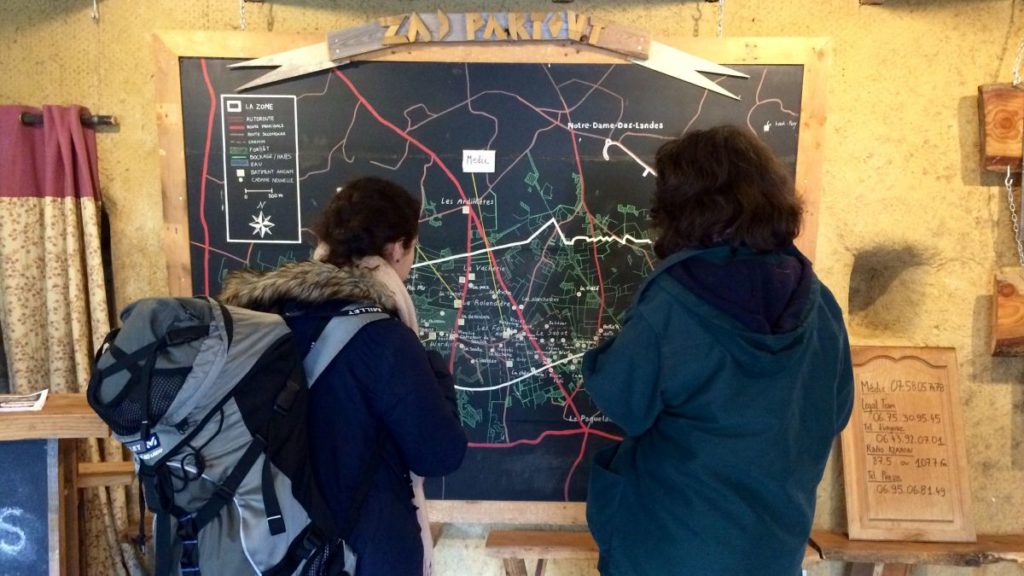
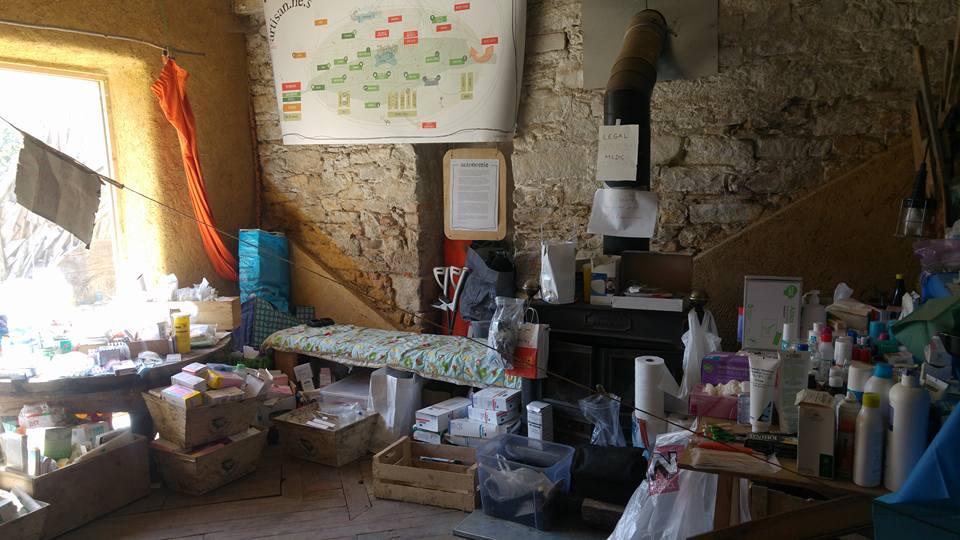
The thousands of acts of solidarity have been a life line for us, including sabotaged French consulate parkings in Munich to local pensioners bringing chocolate bars, musicians sending in songs they composed to demonstrations by Zapatistas in Chiapas, banners in front of French embassies everywhere – from Dehli to New York, a giant message carved in the sand of a New Zealand beach and even scuba divers with an underwater banner. Here on the zone three activist field kitchens have come to feed us, architects have written a column deploring the destruction of unique forms of habitat signed by 50,000 people and locals have been offering storage for the safe keeping of our belongings. A true culture of resistance has evolved in parallel with the zad over the years. Not many people are psychologically or physically prepared to fight on the barricades, but thousands are ready to give material support in all its forms and this is the foundation of any struggle that wants to win. It means opening up to those who might be different, those that might not have the same revolutionary analysis as us, those who some put in their box named ‘reformist’, but this is what building a composition is all about, it is how we weave a true ecology of resistance. As a banner reads on one of the squatted farmhouses here, Pas de barricadieres sans cuisiniers “There are no (female) barricaders without (male) cooks.”
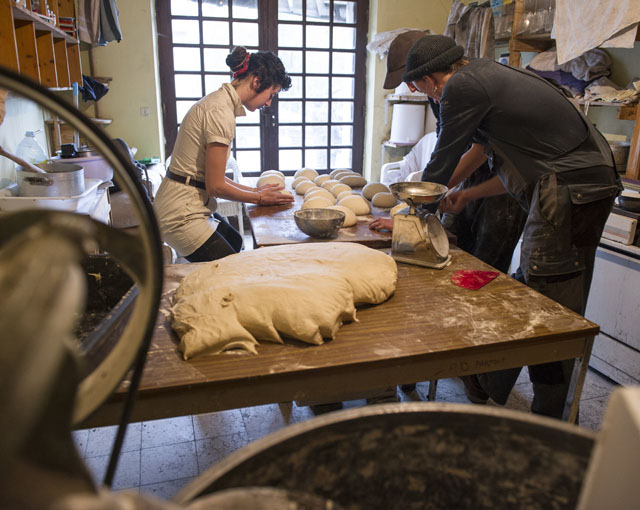
Today has been one of the calmest since the start of the operation, and it felt like the springtime was really flowering, so we opened all the doors and windows of house letting the spring air push away the toxic fumes of tear gas that still linger on our clothes. It feels like there is a momentary lull. For the first time since the evictions, our collective all ate together, sitting in the sun at a long table surrounded by two dozen friends from across the world come to support us. I hear the buzzing of a bee trying to find nectar and look up into the sky, its not a bee at all, but the police drone, come to film us sharing food, it hovers for hours. In the end this is the greatest crime we have committed on the zad, that of building the commons, sharing worlds together and deserting the pathology of individualism.
Two years before the abandonment of the airport project the movement declared in a text entitled The Six Points for the Zad: Because there will be no Airport, that we would, via an entity that emerged from the movement , collectively look after these lands that we were saving from certain death by concrete. A few months before the abandonment the form that this entity took was the Assembly of Usages. Soon after thethe airport was cancelled, we entered into negotiations with the state (via the prefet. Nicole Klein, who represents the state in the department) following a complicated week of pre-negotiations, where we were forced to open up one of the roads which had had cabins built on it since the attempted evictions of 2012. It seemed that the flow of traffic through the zone was the state’s way of telling the public that law and order had returned on the zone. (see the text Zad Will Survive for a view of this complicated period).
A united delegation of 11 people made up from the NGOs, farmers, naturalists and occupiers of the zone attended the negotiations and did not flinch from the demand to set up a collective legal land structure, rather than return these lands to private property and agro-business as usual. In the 1980s a similar legal structure was put in place following the victory of a mass movement against the expansion of a military base on the plateau of the Larzac in Southern France. With this precedent in mind we provided a legally solid document for a global land contract, but it was ignored, no legal grounds were given, the refusal was entirely political. Three days later the evictions began.
The battle lines were made clear, it was not about bringing ‘law and order’ back to the zone, but a battle between private property, and those who share worlds of capitalism against the commons. The battle of the Zad is a battle for the future, one that we cannot loose.
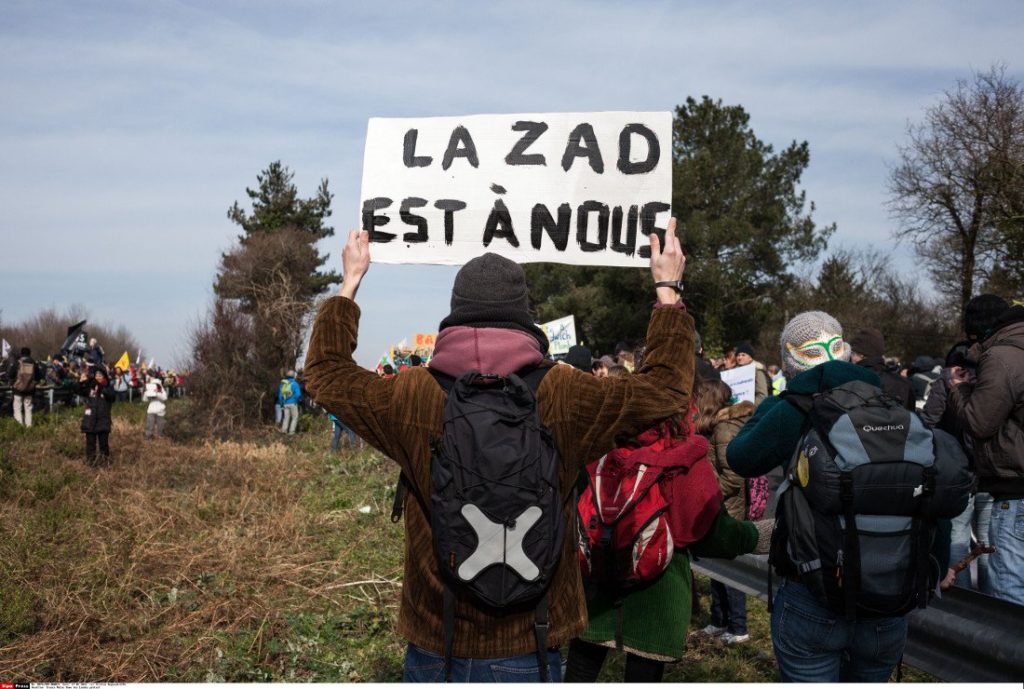
The telephone rings, it’s 3.20am, it’s still dark outside, a breathless voice says two simple words, “It’s begun !” and hangs up. Everyone knows what to do, some run to offices filled with computers, others to the barricades, some to the pirate radio (Radio Klaxon, which happens to squat the airwaves of Vinci motorway radio, 107,7, the construction company that was going to build and run the airport) others start their medics shift. Hundreds of police vans are taking over the two main roads that pass through the zone.
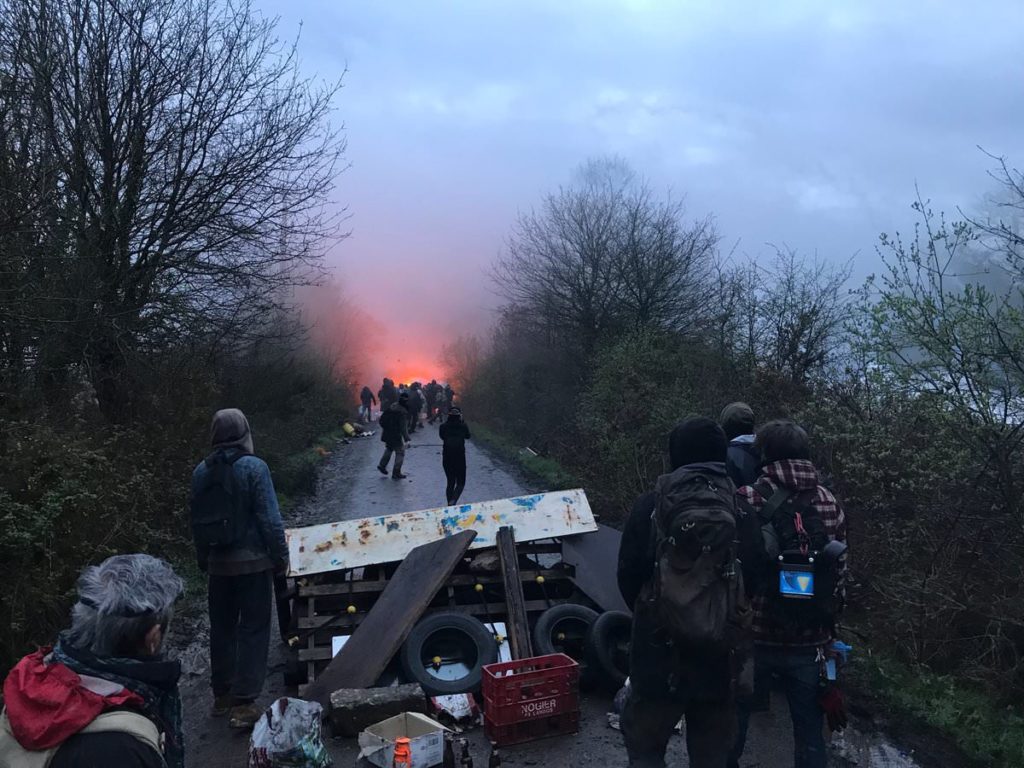
Fighting on one of the lanes manages to stop the cops moving further west. But elsewhere the bulldozers smash their way through some of the most beautiful cabins made of adobe and the wastes of the world that rose out of the the mud in the east of the zone, they destroy the Lama Sacrée with its stunning wooden watch tower, permaculture gardens and green houses are flattened and they rip gashes in the forest. A large mobile anti riot wall is erected by the police in the lane that stretches east to west, a technique that works in cities but in rural riots it’s useless and people spend all morning hassling them from every angle. Despite gas and stun grenades we hold our ground. Journalists are blocked for a while from entering, the police stating that they will provide their own footage (free of copyrights!). The “press group” gives them directions so that they manage to cross the fields and the pictures dominate the morning news.
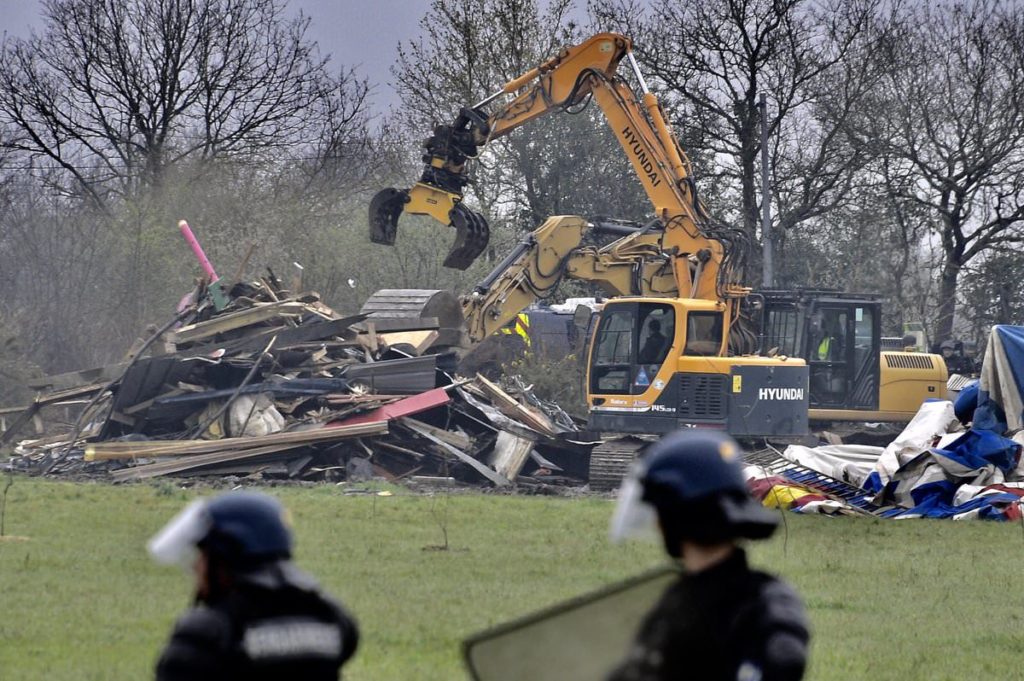
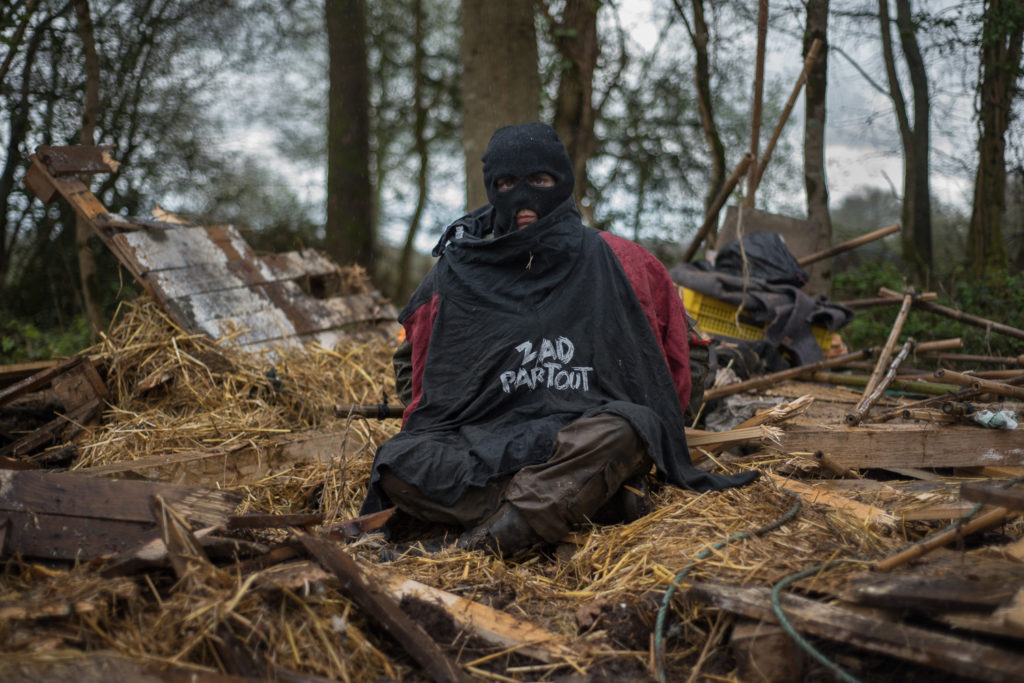
There are over a dozen of us are facing a line of hundreds of robocops at the other end of the field. One of us, masked up and dressed in regulation black kway is holding a golf club. He kneels down and places a golf T in the wet grass. He pulls a golf ball out of a big supermarket bag and serenely places it in the T. He takes a swipe, the ball bounces off the riot shields. He takes out another ball and another and another.
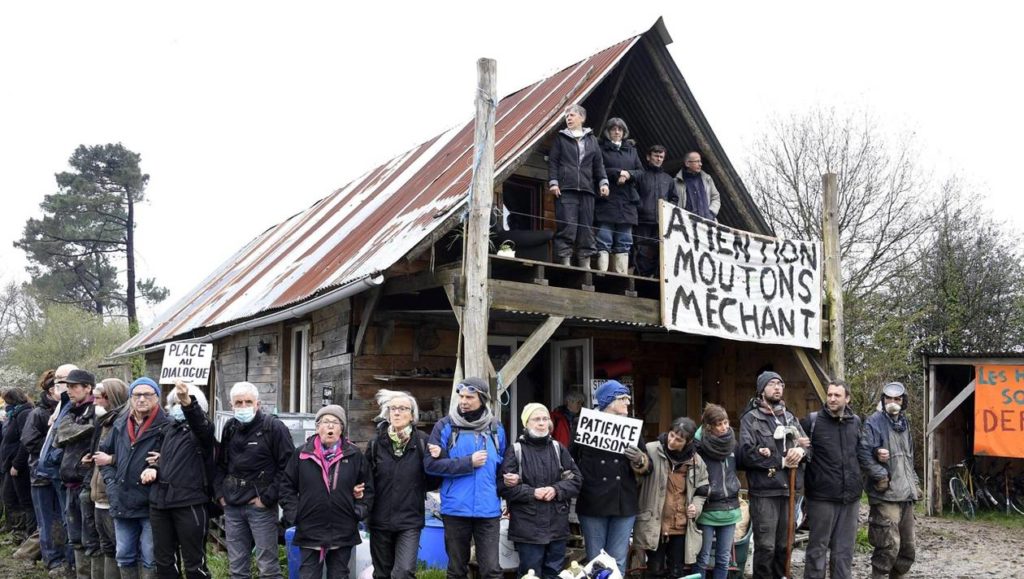
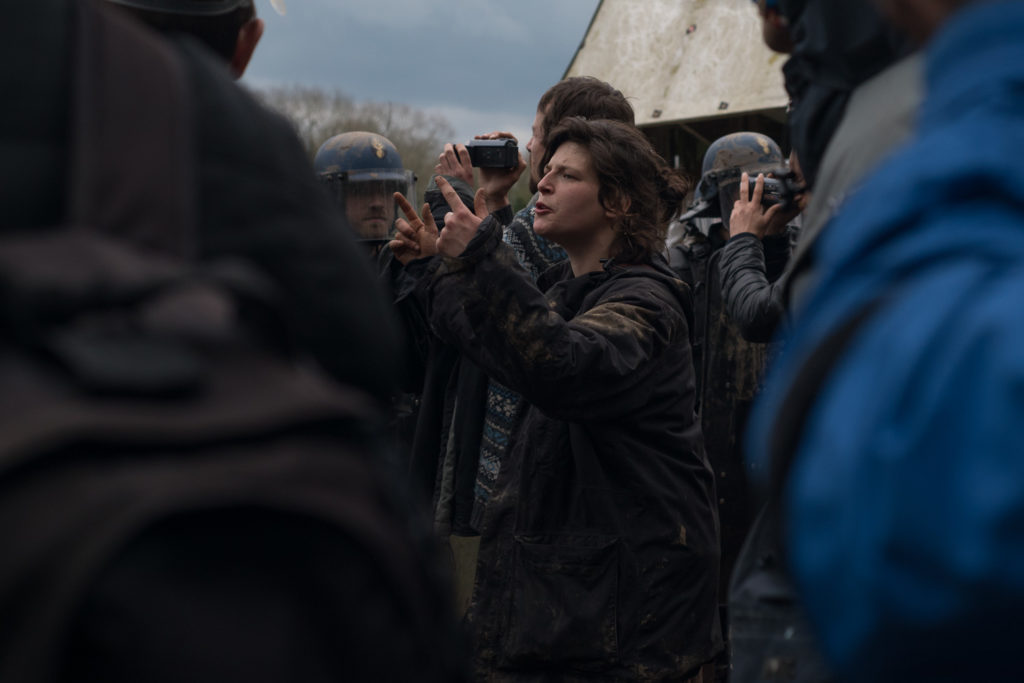
In the afternoon the cops and bailiffs arrive at the 100 noms, an off grid small holding with sheep, chickens, veg plots, and beautiful housing including a cabin built by a young deserting architect which resembles a giant knights helmet made with geodesic plates of steel. The occupiers, who have built this place up from nothing over 5 years are given 10 minutes to leave by the bailiff. Several hundred people turn up to resist, many from ‘the camp of the white haired ones’ which hasbrought together the pensioners and elders, who have called it a camp for “the youth of all ages” and have been one of the backbonesof this long struggle. There must be nearly 200 of us, at the 100 noms, this time no one is masked up. A massive block of robocops is coming up the path, some of us climb on the roof of the newly built sheep barn, others form a line of bodies pressed hard against the riot shields, we are peasants and activists, occupiers and visitors, young and old and they beat us, burn our skin with their pepper spray and push us out of the fields.
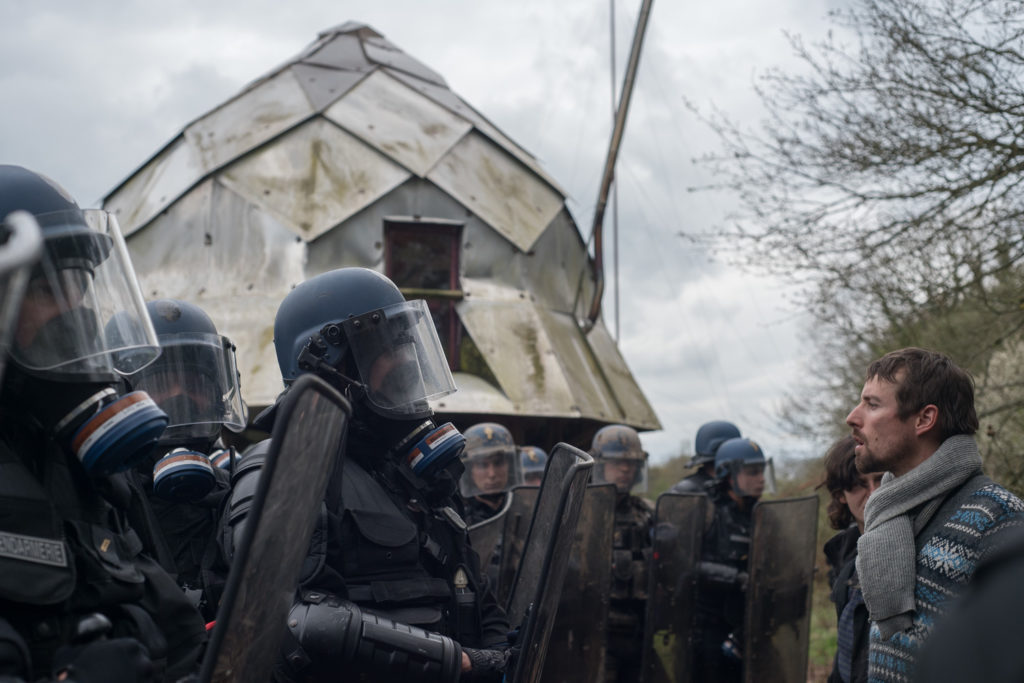
We reply with a joyful hail of mud that covers their visors and shields. The people on the roof are brought down by the specialists climbers and the bulldozer does its job. A few minutes later a one of their huge demolition machines gets stuck in the mud, a friend shouts ironically to the crowd: “come on let’s go and give it hand and push it out!”, Hundreds approach, trails of gas take over the blue sky, dozens of canisters rain down on the wetlands, many falling into the ponds which begin to bubble with their toxic heat. I try to console Manu whose home, a tall skinny wooden cabin with a climbing wall on its side, has just been flattened, my hugs cannot stop his sobs. Our eyes are red with tears of grief and gas.
In the logic of the state, the 100 Noms ticked many of their fantasy boxes of those want to be legalised, ‘the good Zadists’. It was a well functioning small holding, producing meat and vegetables and where the sheep were more legal than its inhabitants. It was a project that had the support of many of the locals. Its destruction lit a spark that brought many of those in the movement who had felt a bit more distant from the zad recently back into the fold of the resistance. Of course its no less disgusting than the flattening of all the other homes and cabins, but the battle here is as much on the symbolic terrain as in the bocage and it is seems to be a strategic blunder to destroy the 100 Noms.
The live twitter videos from the attack are watched by tens of thousands, news of the evictions spreads and a shock wave ripples through France. Actions begin to erupt in over 100 places, some town halls are occupied, the huge Millau bridge over 1000 km away is blockaded as is the weapon factory that makes the grenades in Western Brittanny.
The demolition continues till late, but the barricades grow faster at night, and we count the wounded.
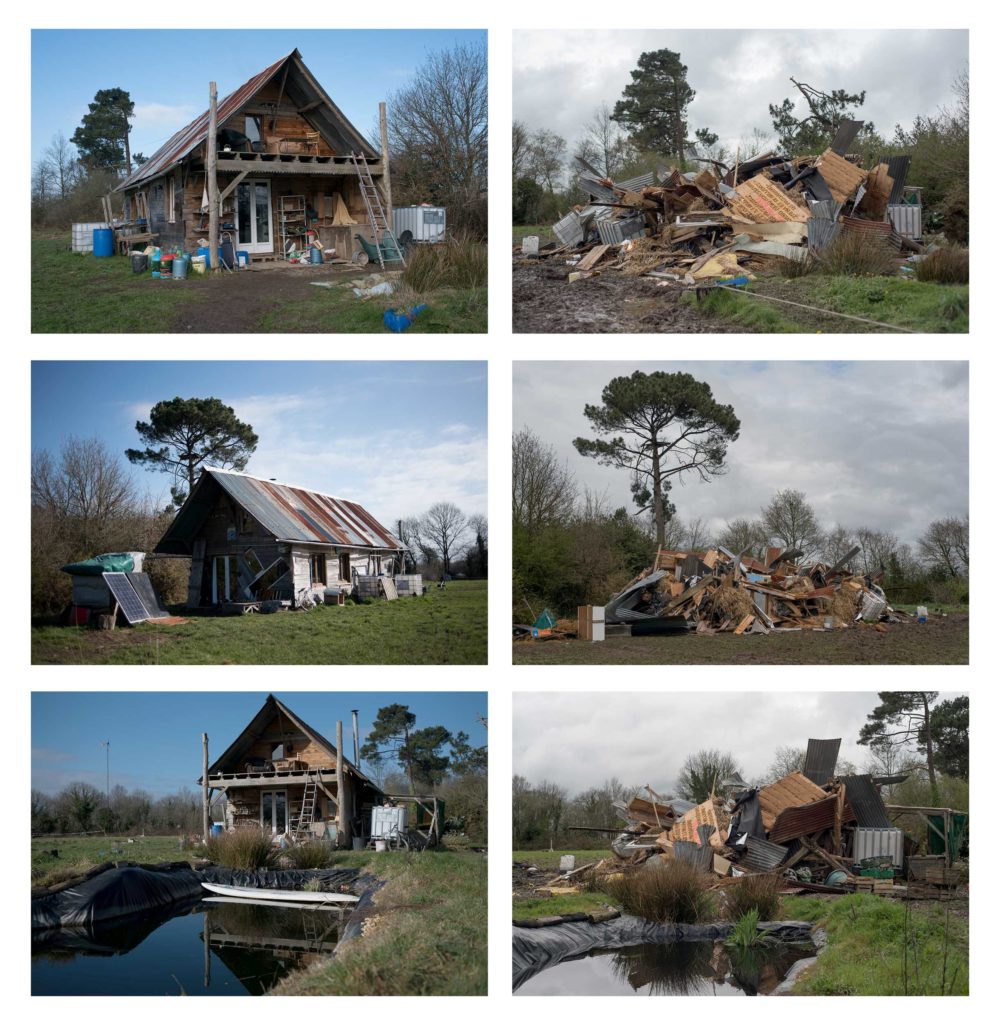
It all begins again before sun rise, the communication system on the zone with its hundreds of walkie talkies, old style truck drivers cb’s and pirate radio station calls us to go and defend the Vraie Rouge collective, which is next to the the zad’s largest vegetable garden and medicinal herb project. We arrive through the fields to find one of the armoured cars pushed up against the barricade, we stand firm the barricade between us and the APC. We prepare paint bombs to try and cover the APC’s windows with. Then the tear gas begins to rain amongst the salad and spinach plants. A friend finds a terrified journalist cowering in one of the cabins, she writes for the right wing Figaro newspaper and is a bit out of place with her red handbag. “What’s that noise??” she asks, trembling, “the stun grenades” he replies. “But why aren’t you counter attacking?” she says, “where are your pétanque balls covered in razor blades?” Our friend laughs despite the gas poisoning his lungs, “we never had such things, it was a right wing media invention, and it’s impossible anyway, no one can weld razor blades onto a pétanque ball! ”
There is so much gas, we can no longer see beyond our stinging running noses. The police are being pressurised simultaneously from the other side of the road by a large militant crowd with gas masks, make shift shields, stones, slingshots and tennis rackets to return the grenades. They are playing hide and seek from behind the trees. The armoured car begins to push the barricade, some of us climb onto the roof of the two story wooden cabin, others try to retreat without crushing the beautiful vegetable plot. Its over, the end of another collective living space on the zone. Then we hear a roar from the other side of the barricade. Dozens of figures emerge from the forest, molotov cocktails fly, one hits the APC, flames rise from the amour and the wild roar transforms itself into a cry of pure joy. The APC begins to back off as do the police. The Vraie Rouge will live one more day it seems, thanks to diversity of tactics.
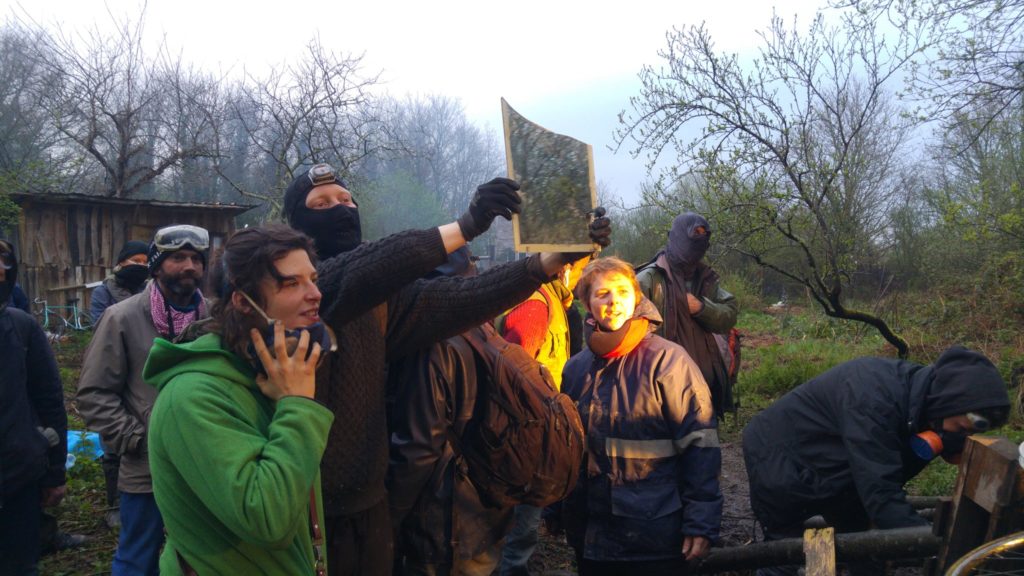
In 2012 when we managed to stop the first eviction attempts of the zone, this was what gave us an advantage. Over the 50 years that the movement against the airport lasted, it used everything from petitions to hunger strikes, legal challenges to sabotage, riots to citizens ecological inventories of the zone, defensive tree houses to flying rocks, tractor blockades to clown armies. Its secret weapon was the respect we had for each others’ tactics and an incredible ability to try and not condemn each other. Pacifist Pensioners and black bloc worked together in a way that I had never seen before, which made criminalising the movement much more complicated for the government. Movements win when they have the richest most colourful palette of tactics at their disposition and they are ready to use everyone of them at the right time and place.
In a woodland dip to the east of the zone, the Cheverie, is still resisting. A huge high cabin made from different types of swirling coloured clay – brown, grey, ochre and white – punctuated by mosaics and carved spiders, constructed by hundreds of hands, is about to be crushed. Hundreds of gendarmes surround it, one of them seems to have a machine gun strapped to his back. From the roof someone uses a traffic cone as a megaphone: “we are defending life and the living.” When the cabin is finally brought down a minor miracle occurs, none of the dozens of windows is broken, which will make it much easier to rebuild.
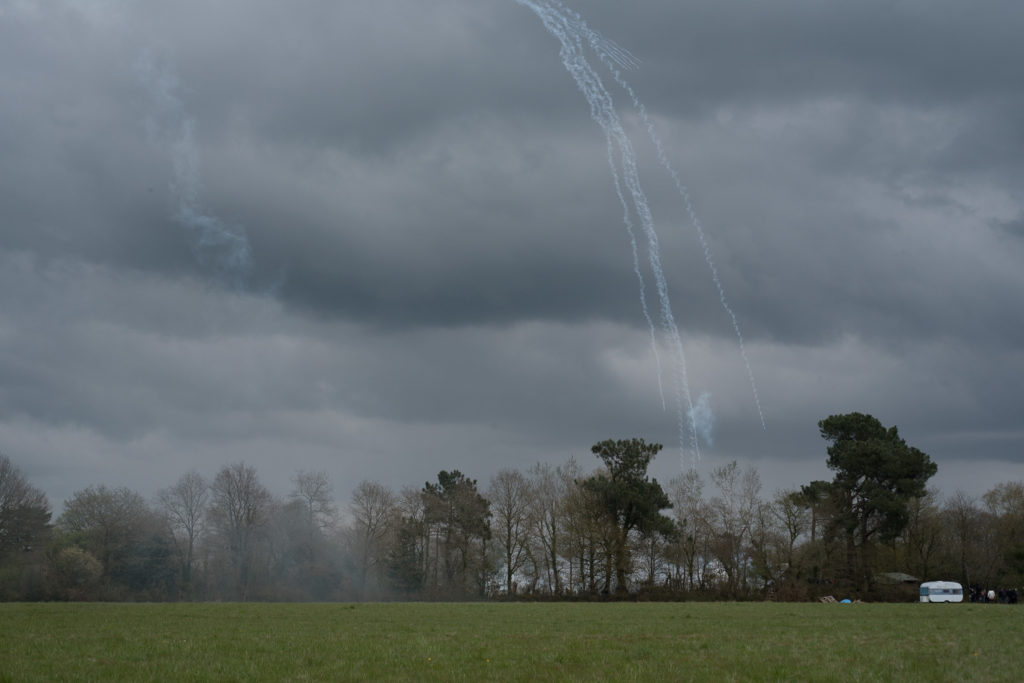
At the Fosses Noires, the brewery has been turned into a canteen, but the tear gas is falling on the pots, pans and piles of donated of vegetables. After lunch, a second press conference takes place, yesterday the first one had brought dozens of TV cameras and microphones from radios across the country, 8 people from all the composition of the movement faced the cameras, their dignified anger was so powerful, so palpable, many of us shed tears listening.
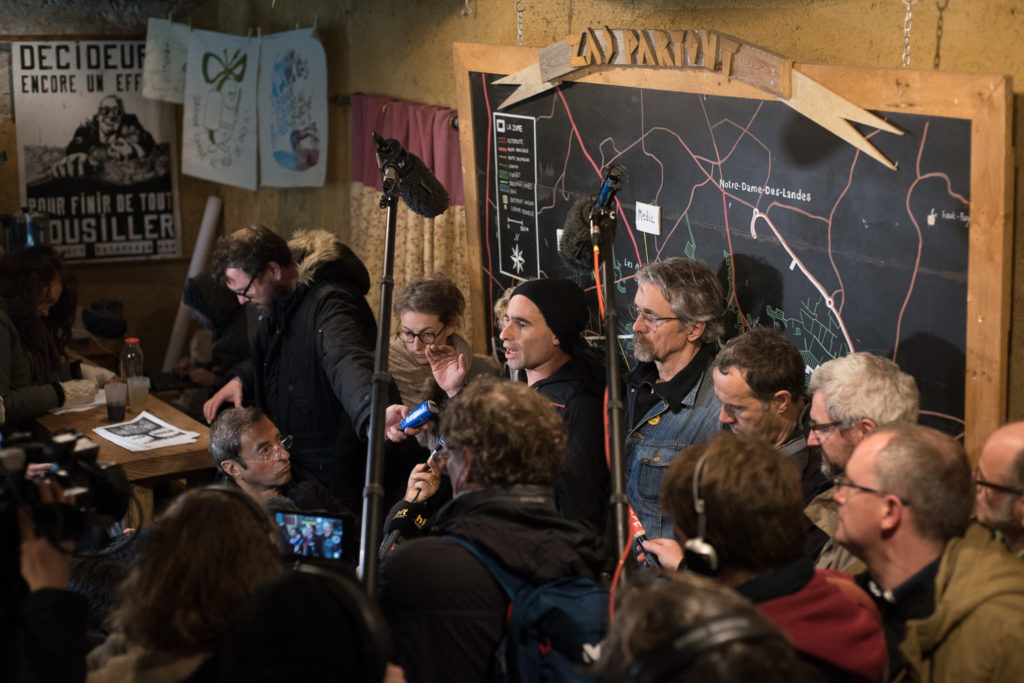
Today there are 30 inhabitants are in front of the cameras, it is those that have an agricultural and craft projects running on the zone, the tanner is there as is the cheese maker, the potter and market gardeners, cow herders and leather workers. They explain how over the last weeks of negotiations with the state, they handed over documents to develop a collective project within a legal non profit association that had been set up. They show that on this bocage to think ecologically is to realise that all the projects are interdependent, rotating the fields between folk, sharing tools and and everyone helping out on each others projects when needed. To divide the zad into individual separate units makes no sense.
But the words are not as strong as the striking image of Sarah, our young shepherdess who like a modern day madonna holds a dead black lamb on here lap. She explains how her flock was legalised already and that this one died from stress when it was moved from the 100 Noms farm to avoid the evictions. Her grey eyes pierce the camera lenses, “they chose violence, they chose to destroy what we build, they chose to break off the dialogue with us.” Whilem a young farmer, whose milk herd squats fields to the west, raises his trembling voice, “ If there is no collective agriculture then you get what’s already happening in the countryside – individualism: eat up your neighbours farm land, be more and more alone with a bigger and bigger farm,” he takes a deep breath, “the isolation is pushing farmers to commit suicide, we are more and more alone on our farms faced with increasing difficulties. On the zad we hold a vision of farming for all, not just for us.”
The zad makes a call for a mass picnic the following day. Vincent one of the supporting farmers from the region, a member of COPAIN 44, a network of rebel farmers whose tractors have become one of our most iconic and useful tools of resistance, sighs, “the government has broken any possibility of dialogue now, they have forced us to respond with a struggle for power.”
Between the tall poles that hold the breweries’ hop plants a long banner is raised, “Nicole Klein radicalised me.”
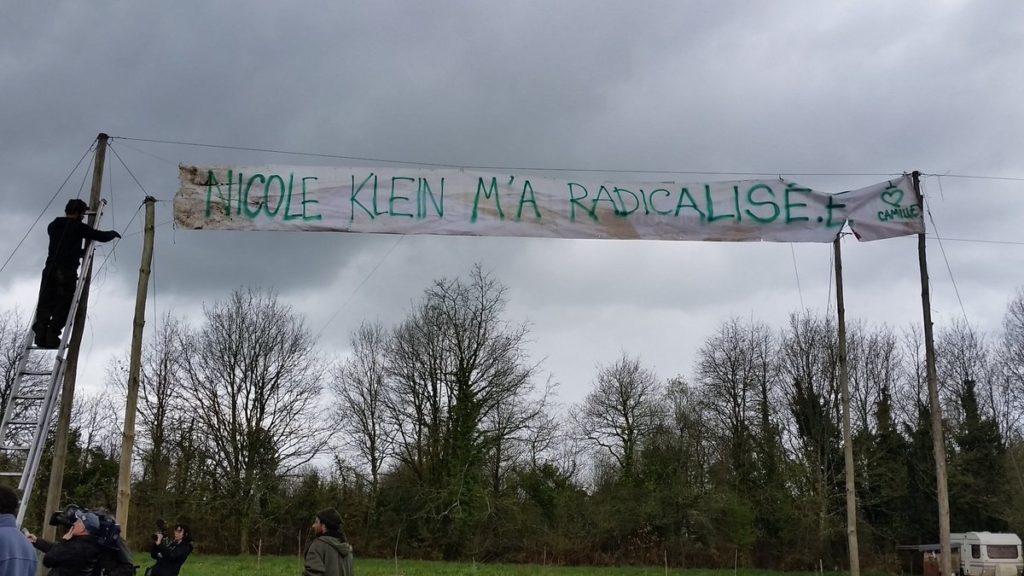
We are woken as normal by the explosions of gendarmes grenades, fighting continues near the D281 road. A small group is trying to stop the police lining up in a field, there aren’t many of us, it feels hopeless, then out of the morning mist comes a tractor, its driver wears a balaclava, in the front bucket – a tonne of stones. He drops them in a pile just where we are standing, puts the tractor in reverse and disappears back into the mist.
In the next door field a towering guy wearing a balaclava and dressed in a full monks habit throws a bucket of water over a handful of robocops – “I baptise you in the name of the zad”, he bellows. A cloud of pepper spray engulfs him, but one the gendarmes slips in the mud and drop his truncheon, at the speed of light the monk grabs it and runs off, wielding his rebel relic in the air. The police megaphone calls out “You must return the state’s property. Return it now!”
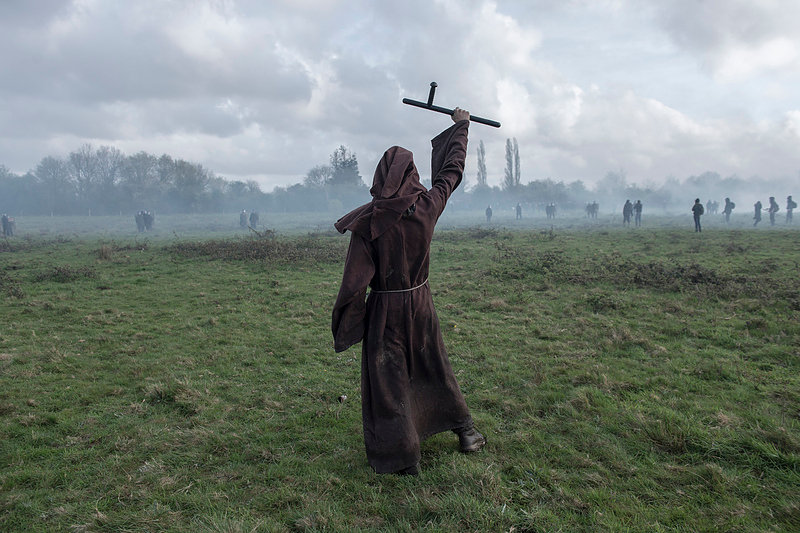
The picnic before it was gassed.
At lunch time, over a thousand people turn up to share a picnic in the fields. Over thirty tractors have come, some from far, despite the fact that its one of the busiest seasons for the farmers, they encircle the large Rouge et Noir collective vegetable garden, now littered with hundreds of toxic plastic tear gas canisters. “The state crossed the red line when they destroyed the 100 Noms” one of them says.
The crowd of all ages walk through the barricades and debris of yesterday’s battle that litter the country lanes. The atmosphere is festive, a samba band with pink masks leads us into the field beside the Lama Sacrée. A long line of black clad police stretches across the spring green pasture. The samba band approach, then all hell lets loose: gas canisters shower down, dozens of stun grenades are thrown into the peaceful crowd, panic ensues, people retreat across the hedgerows.
The houses of la Boite Noire, Dalle à Caca, Jesse James and la Gaité fall in the east. Simultaneously they attack la Grée, the large rambling grafitti covered farm at the centre of the zone that has an unconditional welcome policy. There is a car repair workshop, climbing wall and the rap studio and many folk escaping the misery of street life and addictions end up living there together. Farmers’ tractors are surrounding the building, a barricade made from the carcasses of cars, is set alight. But the tear gas is too strong and the tractors are forced to back off.
Out of the mist of gas come black lumbering troops, they charge across the fields. The whole zone is split in two by a seemingly endless lines of robocops stretching east to west. The crowd is dispersed, people are coughing up their lungs, they are furious. It began as a picnic, now it’s a war zone again. The gas clouds cling to the pasture, frightened cows huddle together in a corner of a tiny field. The medic post at the Fosses Noires has to move away to the Gourbi, but then the gas catches up with it there too and it moves to La Rolandière just in time before the police arrive to smash one of the zone’s most symbolic sites, the Gourbi.
In the very centre of the zad the Gourbi is where the weekly assembly of occupiers is held and Friday’s No-market, a place where excess produce is distributed with no fixed price but by donation only. Initially there was a stone farm house there, inhabited by an old couple who were evicted in 2012 and their home destroyed for the airport project. Then a wooden hut was built in its place, but its ramshackle pallet sides soon needed restoring and so a brand new state of the art cabin like meeting house was built over 2015. But one night someone sneaked into this beautiful meeting house and set it alight.
But Gourbi was to rise from the ashes, and as an ironic response to the governments 2016 local consultation about the airport project, we held an all night building party whilst the results came through (55% for building the new airport). To the sound of a wild one man accordion band doing kitsch covers of Queen and other trashy pop songs, hundreds of people stuffed the clay of the wetlands into a huge geodesic metal dome structure to build our new round meeting house. It was made of steel and mud to resist arson, but today the bulldozer crushed it with a single swipe of its blade. Worlds away in the metropolis, the Minister of Interior, Gérard Collomb, tells parliament “We want to avoid all violence in this country, this is what we are doing at Notre-Dame-des-Landes.”
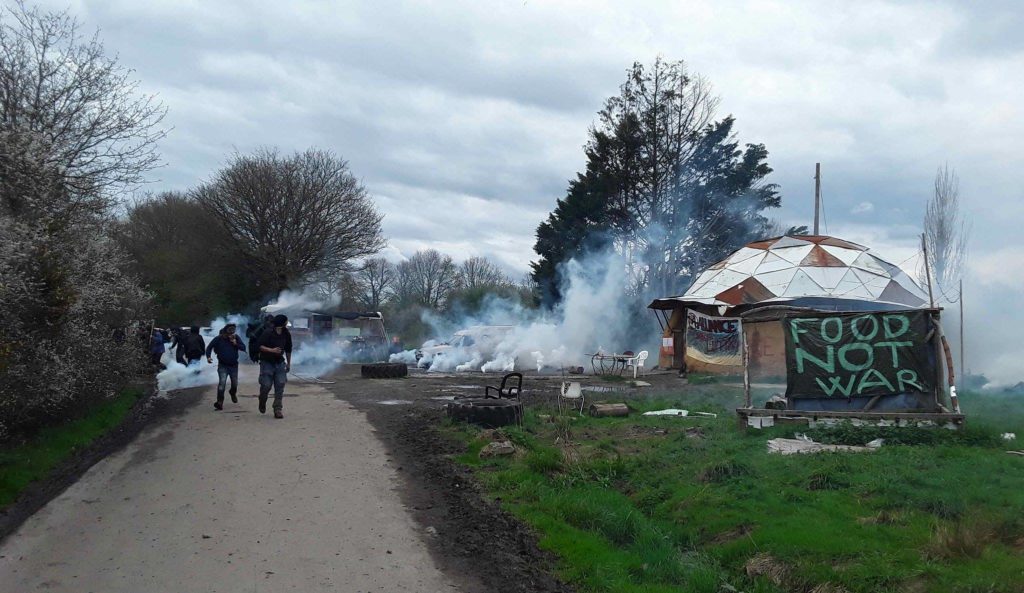
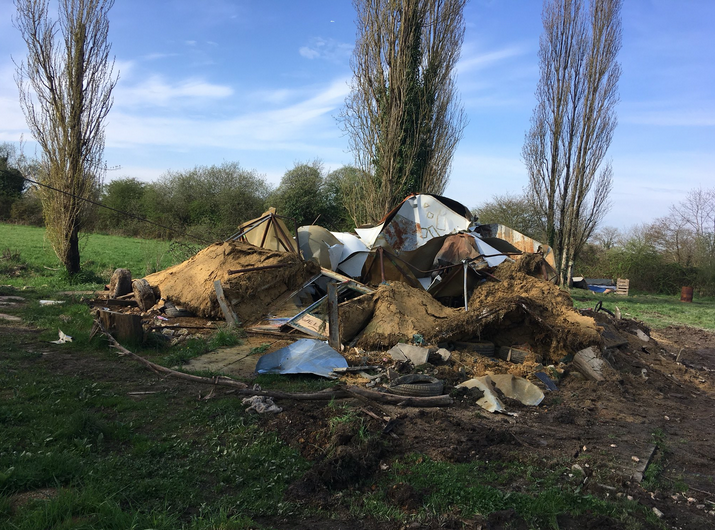
By sunset the government claims to have evicted 13 more living spaces, bringing the total to 29 since Monday. The prime minister refuses to pause the operations, and the medic team share horrific photos of some of the 60 injuries since Monday, including 3 journalists. Meanwhile the cops release their figures: 32 injuries, but it turns out most are from the mis use of their own weapons. Solidarity actions pour in from thousands, including squatters in Iceland, farmers in Lebanon and eco builders in Columbia. In Paris, sex workers send in kinky zad themed S and M photos and students occupy the EHSS elite social science school in solidarity. That afternoon electricity is cut across a large part of the zone and many of our neighbors homes outside of the zad. It is a tactic reminiscent of collective punishment used during military occupations , At night the gentle lulling croak of mating frogs in the marches mixes with the hum of back up electric generators. Four hundred of us meet at the Wardine, in the old concrete cow shed covered in bright murals, we share stories, dogs bark, tempers fray.
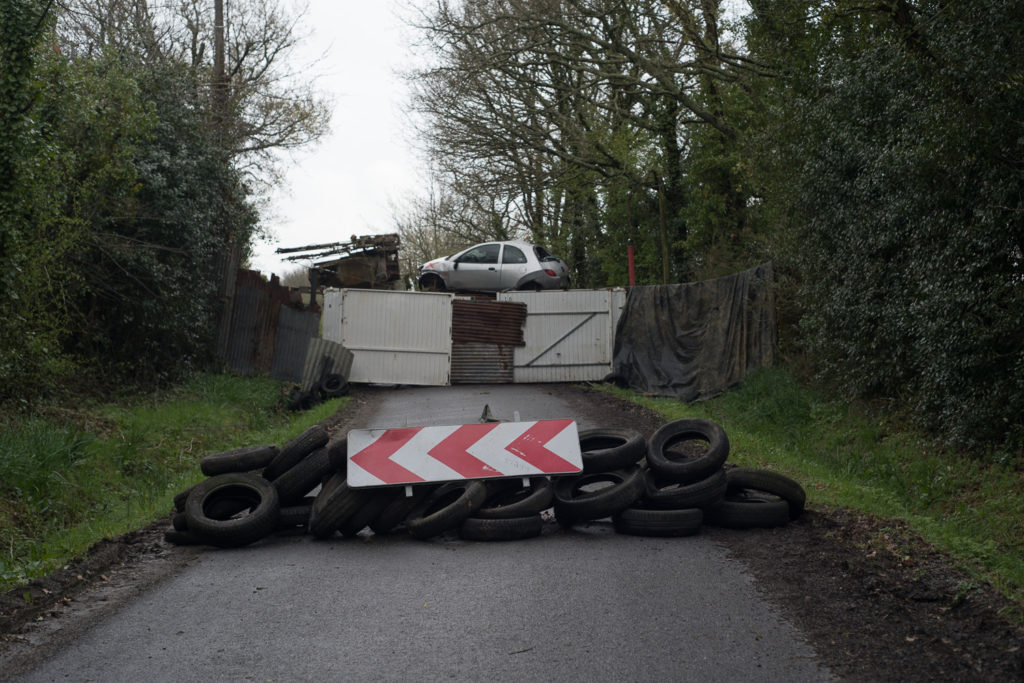
The day begins with some good news on radio klaxon. An affinity group action just shut down the motorway that passes near the zad. Emerging from the bushes they flowed down onto the tarmac armed with tyres, fluorescent jackets and lighters. Within seconds a burning wall blocked the flow of commuters to Nantes. The group disappeared just as quickly as they materialised, melting back into the hedgerows. The more we fight for this land, the more we become the bocage and the harder it is to find us. Every day more and more people converge here, many for the first time in their lives.The art of the barricade continues across the zone, including one topped with an old red boat. Some of our most useful barricades are mobile, in the form of tractors, dozens of COPAIN 44’s machines take over the main cross roads of the zone.
Following an attempt by friendly lawyers to prove that the eviction of the 100 noms was illegal, the prefect is forced to appear in court in Nantes, but the case is adjourned. The indefatigable zad press group sends out a new communique entitled, After 3 days of evictions are they ready to kill because they don’t want a collective ? Clashes continues across the bocage as Macron take to the TV screens for a national statement about his policies. A social movement is rising against him, with university occupations, supermarket, rail workers and Air France on strike – he has to respond. The mise-en-scène is bizarre, he sits in a primary school class room. He speaks about the zad for a little over a minute, “republican order must be returned” he says, and “everything that was to be evacuated has already been evacuated”.
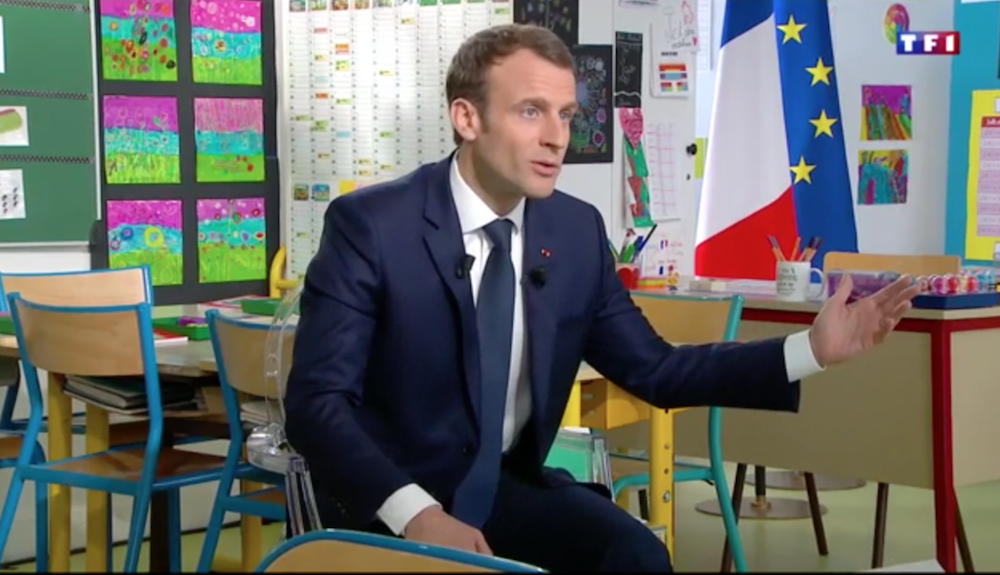
As he speaks a hundred and fifty concussion grenades are launched in less than half an hour in the Lama Sacrée field, the explosions echo across the bocage, bursting the ear drums of those nearby and raising the anxiety levels of those within hearing distance, which on this flat landscape of the zad, is all of us. The league of Human Rights demands that all parties come back to the table. A call is sent for people to converge on the Zone on Sunday: “ The time has come to find ourselves together, to say that the zad must live, to dress our wounds and re build ourselves..” …
We walk home to la Rolandière, with its ship shaped library attached to the lighthouse, built where they wanted to build the airport control tower. The sun is setting, 20m high up on the lighthouse’s balcony a lone figure is playing a trumpet, fluid sumptous jazz floats across the forest. It is one of those moments when you remember why you live here.
That night under a clear constellation filled sky, the Assembly of Usages meets. We sit on wooden hand made bleechers under Le hangar de l’avenir (The Barn of the future). This cathedral like barn was built by over 80 traditional carpenters in 2016 using mostly hand tools, it is ornamented with snakes and salamanders carved into the oak beams. There are several hundred of us at the assembly, one of the peasants whose tractor is blocking the crossroads reads out a series of texts messages he has received from the préfete who is trying to negotiate with COPAIN 44. “Yesterday the Prime minister said it was war, today the president says its peace, therefore it’s all over.” It’s clear that she’s feeling that the situation has become much more complicated than predicted. A deal is made, move your tractors she writes, and I promise that by 10pm I will announce to Ouest France, the regional news paper, that it is the end of operations by the Gendarmes.
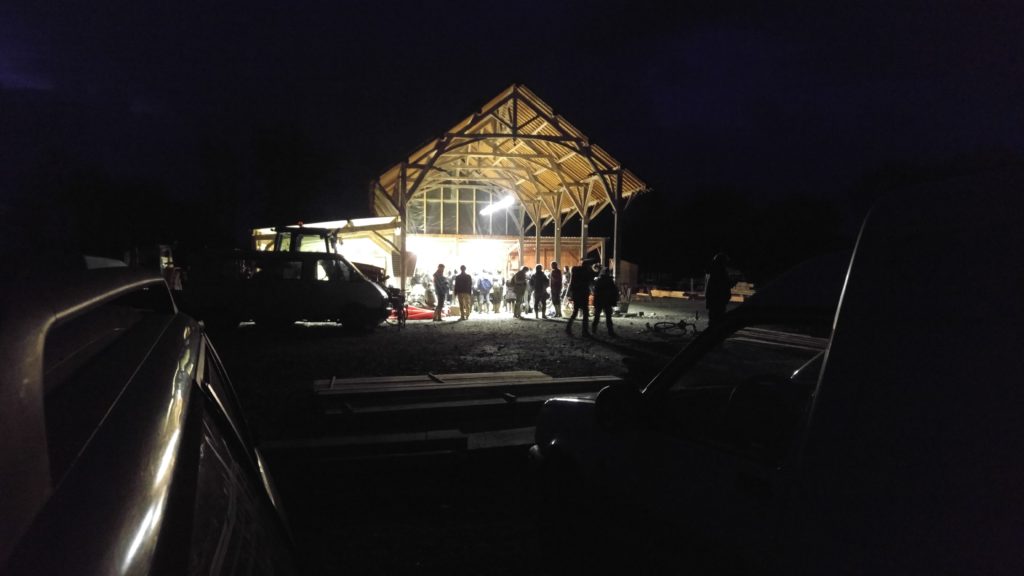
The meeting continues, we wait for the article to appear on the newspaper’s web site. I reload my phone endlessly waiting for the site to update. Suddenly it does, but it’s just a story about rock legend Johnny Hallyday, was it all a bluff ? Then it arrives, half an hour late. A cheer rises from the tired voices. At home we try to party a little, at least we might get a lie in tomorrow morning, it seems that it’s over for the time being?
I’m half awake, there is a rumble of vehicles on the road… At first I think it’s tractors, then I see the lights, blue and flashing, van after van of cops passing. We leap out of bed and run to the top of the lighthouse, the entire road is filled with vans as far as the eye can see. The huge barricade at the crossroads, which the tractors left last night following the préfete’s announcement, is on fire, a plume of black smoke frames the the orange dawn. The familiar pop of tear gas canisters being fired is accompanied by the crunching sounds of barricades being pushed by the APC. Radio Klaxon says they have kettled la Grée and are searching it, the Wardine camping is also encircled and a hundred and fifty cops are heading towards the Rosier. The Lascar barricade, made of several burnt cars, with a huge metal doorway and a trench that is several meters wide, is being defended by a nearly 100 of us. The forest is wrapped in toxic mist, ghostly rebel silhouette run from tree to tree, stones are aimed at the robocops with catapults that were made by Andre, an 83 year old who set up a production line for us during the eviction threats of 2016, his team churned out 1000. The cops throw stun grenades blindly from the fields into the forest, one explodes just above my head, caught in the tree it rips the bark into smithereens. Is this what they call the end of operations ?
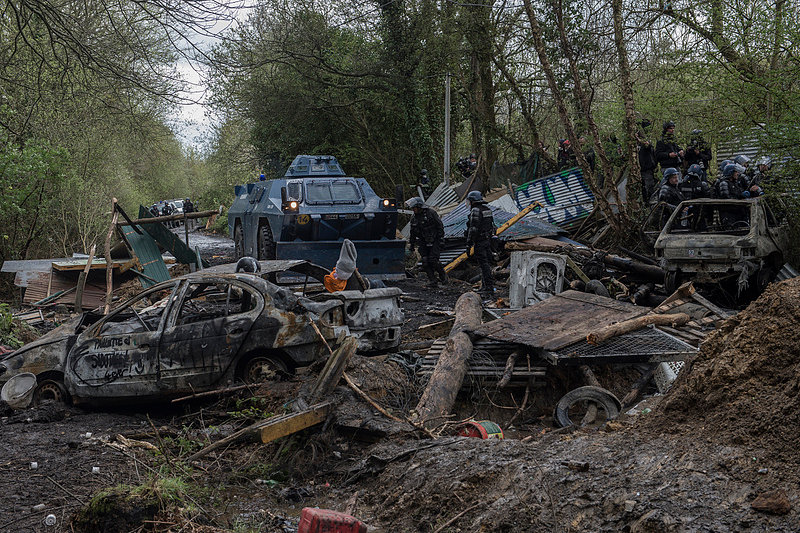
A communiqué from the gendarmerie explains that they are clearing the roads and are not doing any expulsions or knocking down any squats, but that they are looking to arrest people who fired a distress rocket at their helicopter. At la Grée they take away two people but not for that charge. The gas pushes everyone back from the Lascar’s barricade and the grinders come out to cut the metal gateway into pieces. Despite the rising clouds of tear gas, people on the roof of the brand new Ambazada, a building that will host folk from intergalactic struggles, manage to sing some of our re purposed folk songs, recount the history of the struggle of the zad.
Then a moment of joy, one of the armoured cars attacking the Lascar tips into a ditch and has to be pulled out by the other one. The mud of this wetlands has always been our ally, its wetness our friend. When they retreat a banner is put up, “Cheap APC driving license available here.” Our other accomplice is humour of course, even in what feels like a war zone, with tarmac scorched, broken glass and rubble everywhere, being able to laugh feeds our rage. The police retreat again and the barricade grows back out of its ruins, bigger and stronger than ever. We notice that where the APC fell into the ditch is now a huge deep hole at exactly the place where the drain for the Ambazada was going to be dug, no need for digging, just put the plants in it to make our grey water reed bed. That’s what you call radical permaculture, least effort for maximum gain.
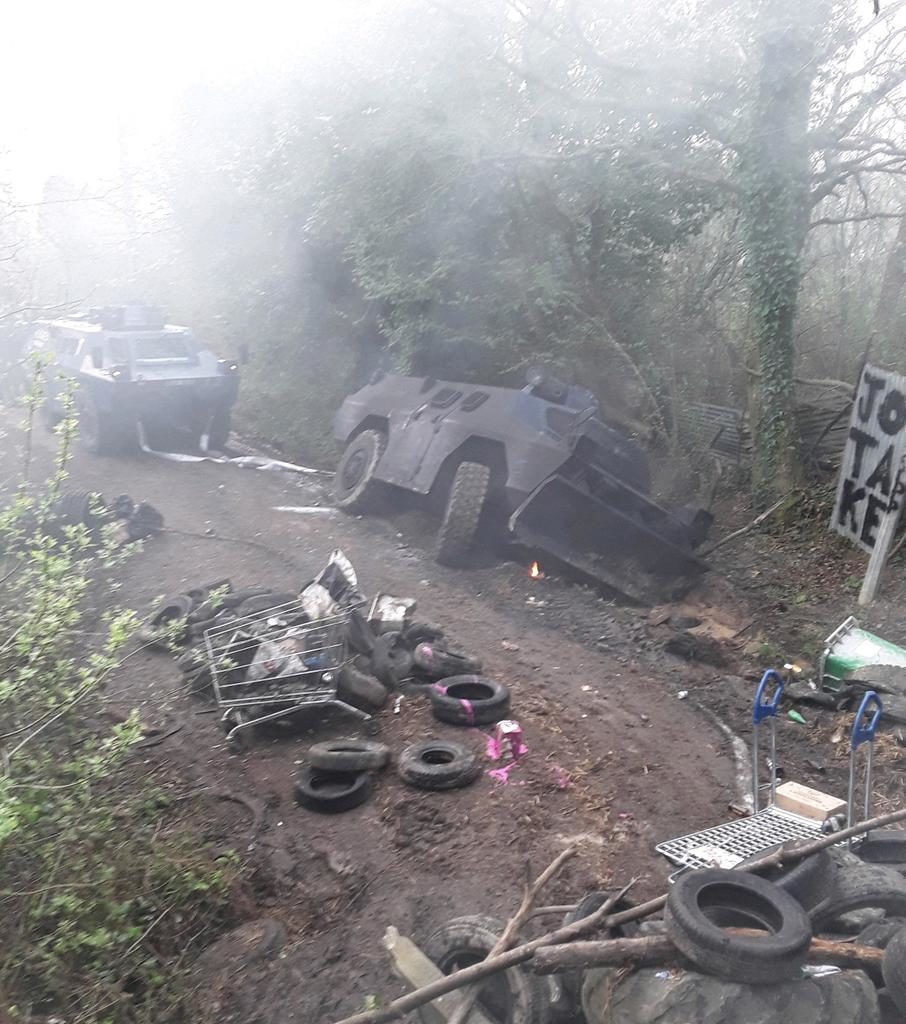
At midday the préfete begins her Press conference in Nantes. She confirms last nights message – evictions are over – and in a dramatic gesture, flourishes a page of A4 paper towards the cameras. “It’s a simplified form” she tells the press, “so that those who wish can declare their projects as quickly as possible…The deadline is the 23rd of April” she continues “ all we are asking is that they declare their names, what agricultural project they wish to develop and to tell us what plot of land they wish to work on, so that the state can process them.” She also confirms that it was Macron who was running the operation not the prime minister or interior minister, it was he who decided to stop the expulsions. “I am holding out my hand” she says, and asks for negotiations to re start on Monday, “I am giving the zadists a last chance.” Sitting next to her General Lizurey in charge of the Gendarme’s operations says that the number of zadists on the zone has increased from 250 to 700.
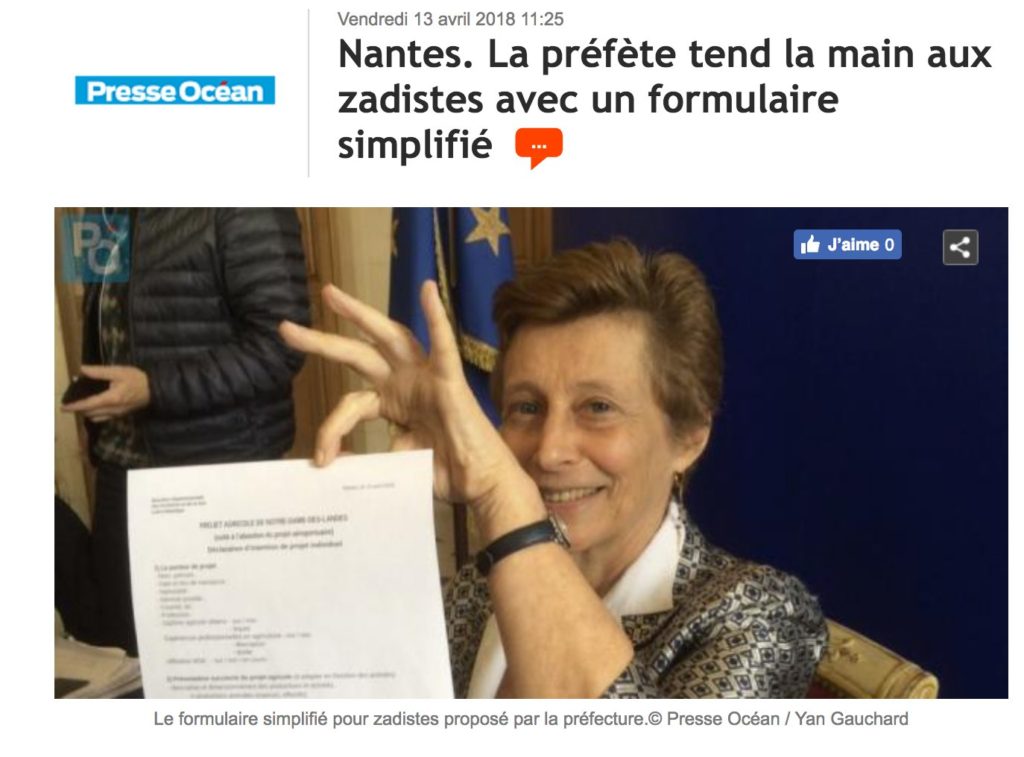
I walk through the Rohanne forest to The Barn of the Future, I breathe in the forest air, the sweet pine, the musty damp smell of mushrooms. The barn has returned to its normal use as a saw mill and carpentry workshop for the zad. It is the base of the Abracadabois collective that looks after the forests and hedgerows, harvesting fire wood and building timber and setting up skill shares to learn carpentry, forest biology, wood carving, chain saw use and learning about other ways of inhabiting forests inspired by indigenous practices from past and present. The saw mill is planking the logs, twenty carpenters are busy preparing frames for a new building, a new assembly and no-market hall for the Gourbi, that we aim to put up on Sunday during the mass action.
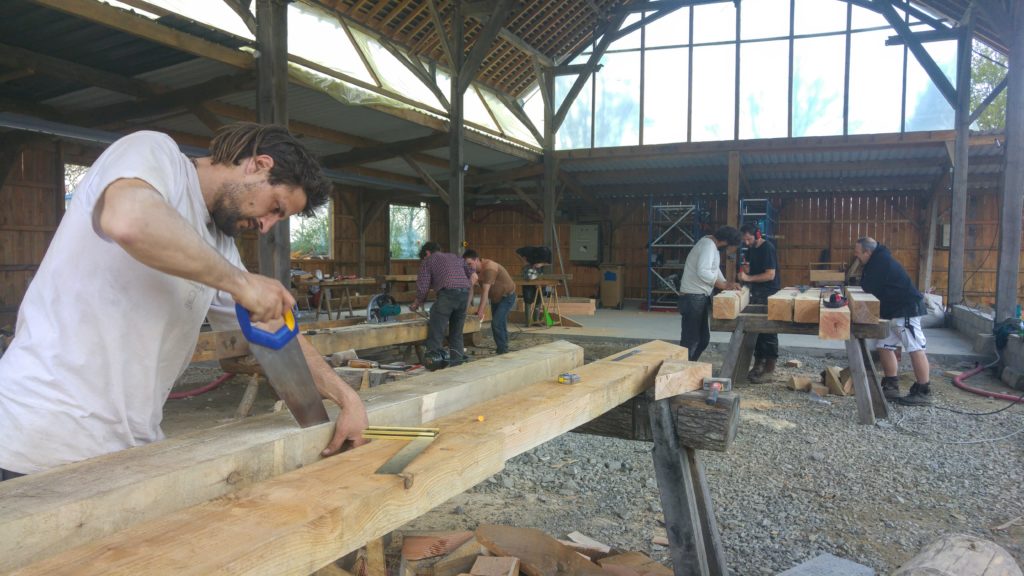
This morning I was enveloped in tear gas and now I’m watching some of the same barricaders without their gas masks making a barn using the techniques that have been used for millennia. It is somehow healing to watch the attentive work. It is this capacity to fight and build, to block capitalism and to construct other forms of life which gives the zad its strength. It is also another reason the state wants to destroy us, they can deal with nice clean alternative eco projects, easy to buy off and recuperate into new forms of green capitalism. But when those who have a systemic critique are also providing material examples of other ways of being, it becomes dangerous. The resistance and creativity, the no and the yes, are the twin strands of DNA of this territory, split one from the other and the zad dies. It becomes another ecovillage or Transition Town, alternatives without teeth.
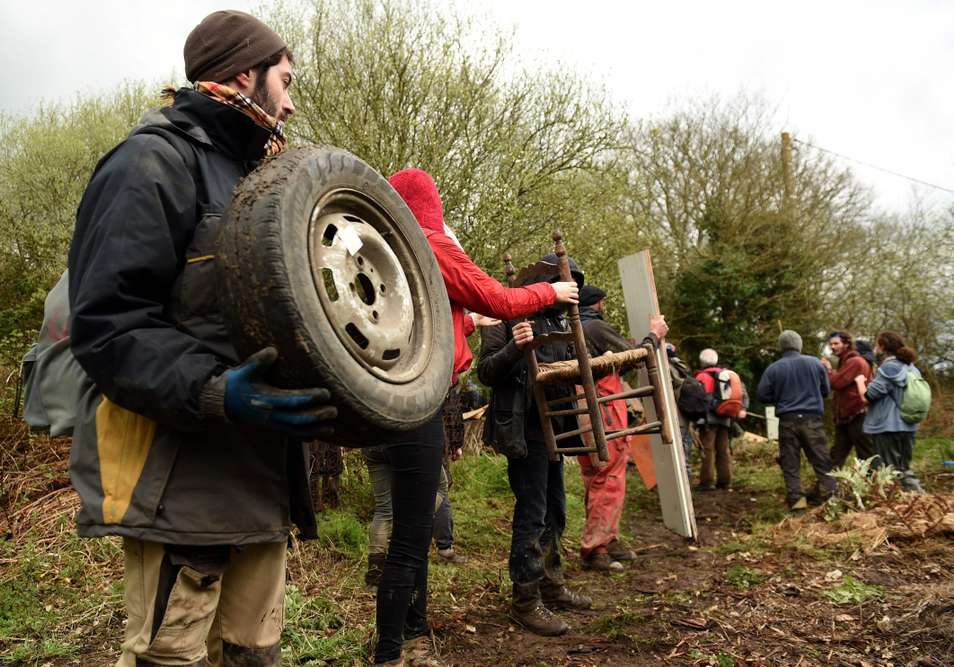
Yet a second helicopter is flying above the barn, this time with Prime Minister Edouard Philippe and the minister of interior inside, they are getting a private birds eye tour of the zad. They have come to congratulate the troops for their hard work. As he shakes hands with the gendarmes Phillippe tells the press that “the state will not accept any reconstruction or reoccupation.” He is referring to the action planned on Sunday, “Any place that tries such an action will exclude itself from any possible regularisation…. and will thus put themselves under judicial proceedings.” Once again the threat of sorting the good zadists from the bad. The carpenters work late into the night.
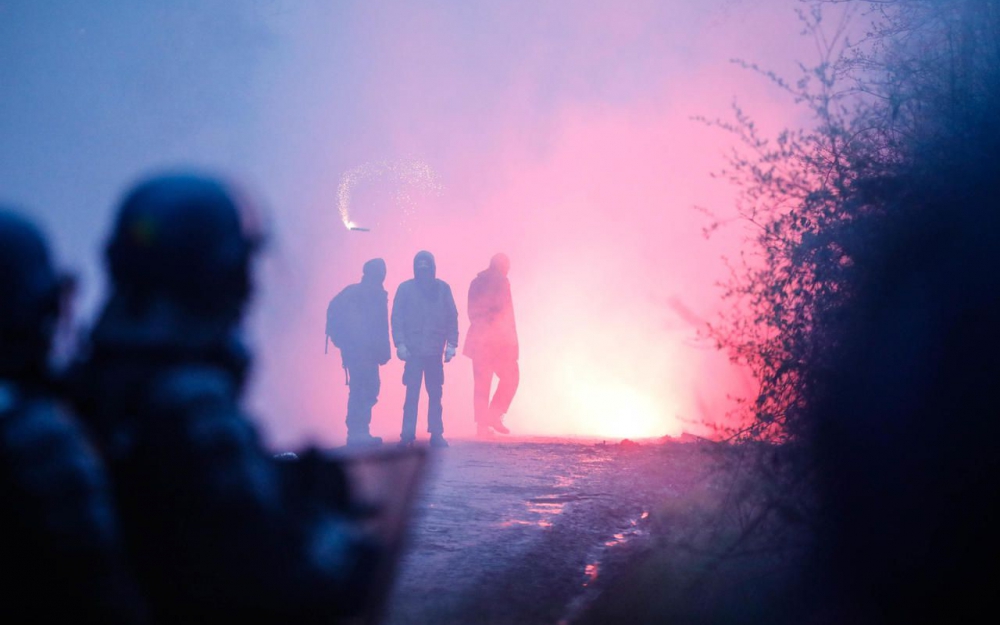
Bang, another wake up call, the APCs and dozens of vans pass by at the speed of a TGV train, bulldoze the barricades away on the D81 road again, and continue South, probably to Nantes where striking workers are holding a demonstration followed by one against the eviction of the Zad.
Barricades are cleared at the Lama Fachée at the same time, and a strange new gas is spotted, dark yellow. It makes people throw up, sows mental confusion and a loss of all spatial and temporal senses. Behind one of the barricades, a trio of action medics are keeping an eye on the adjoining woodland where grenades are exploding, “ It’s been war wounds here,” they explain “skin and nerves hit by shrapnel, open gashes, eardrums damaged, necrosis and bone fractures.” Some folk have over 70 pieces of shrapnel in their limbs, it takes hours every day to pull them out and clean them, some have gone 3cms deep into the skin. Many of the new comers on the zone throw themselves into picking up the thousands of gas canisters that litter the fields, placing them in big bags for everyone to see in the “camp of the white haired ones.” Each canister costs 110 euros.
The demonstration in Nantes is big, 10,000 people. The 1000 riot police on duty attack it and gas people drinking on the café terraces.
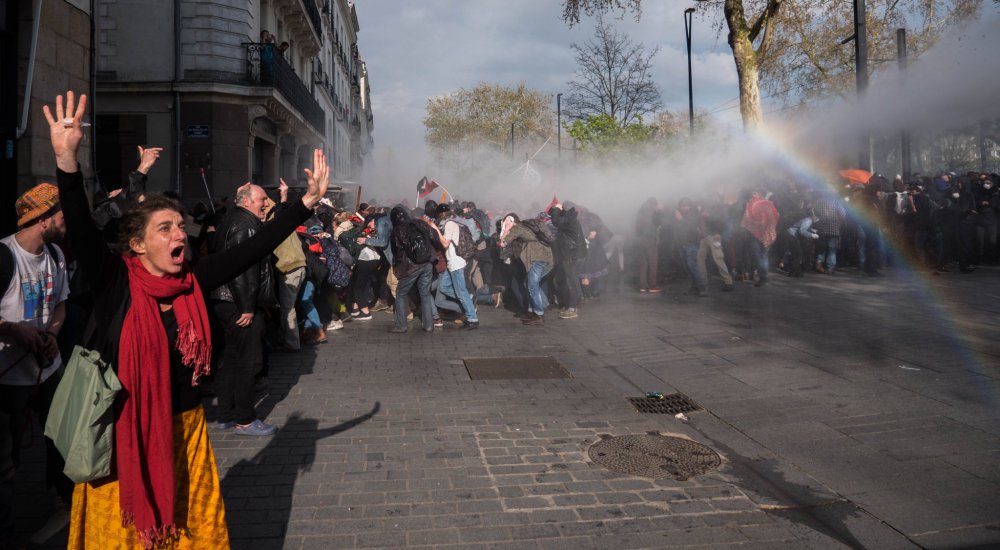
The sun set is dark red this evening. The wood working tools and machines are cleared aside, the Barn of the Future becomes a meeting hall again for the Assembly of Usages. The fresh smell of saw dust perfumes the discussions about whether we should go to back to the negotiations on Monday. The response is no, not yet.
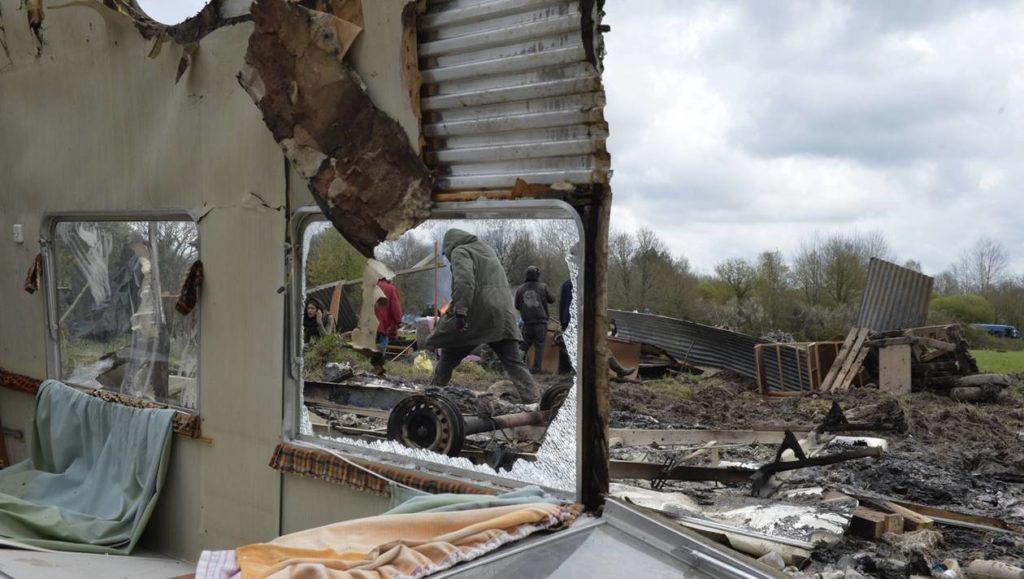
It’s the big day, thousands of people from all over the country are converging on the zone for the day of mass action. The troops have cut off a third of the zad, they line the lanes for kilometers, cutting off access to any of the part of the zone where homes had been destroyed last week. This includes the Gourbi where we hoped to bring the new building too. All road access to the zad are blocked off by the gendarmes, they tell people to go home because they won’t be able to reach the demonstration. But more than ten thousand of them disobey, park their cars and coaches in the nearby villages and trek for over an hour across the bocage. The details of the new building are still being finished, as the crowds arrive, such as a large ‘fuck you’ finger and the face of a fox that are being carved.
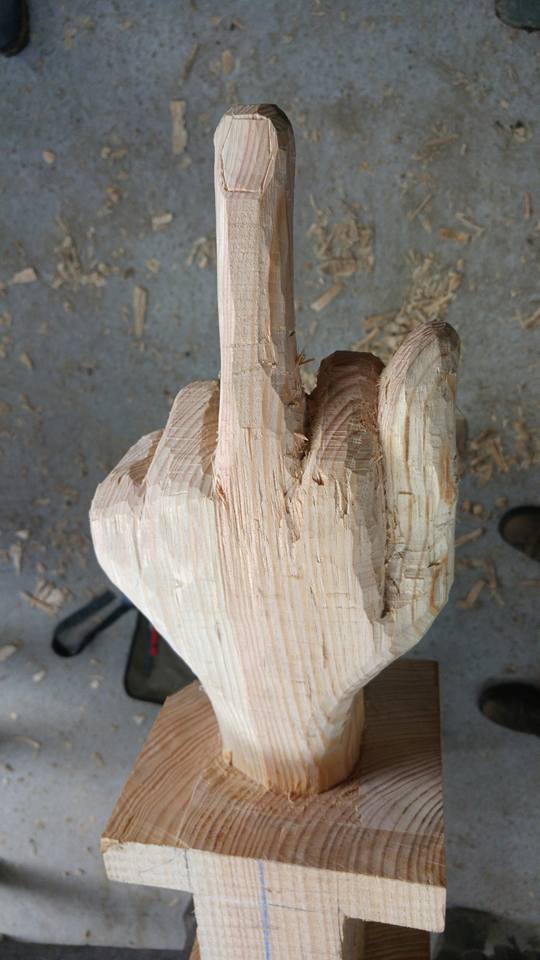
Through the pirate radio, text messages and word of mouth, we tell people to converge on Bellevue, the big farm in the west and wait for a decision about what we will do. 50 of us meet in a field in an emergency meeting, the farmers don’t want to risk their tractors, we don’t want to have a gesture that feels too symbolic, once again the collective intelligence comes to the fore and we come up with a plan B. The building will be erected as close to the front as possible without forcing the police line, there are too many families here to risk being gased.
Simultaneously we will ask people to unearth the staffs and sticks that had been planted in the ground in October 2016 when the government told us they were coming to evict. It was a ritual disguised as a demonstration, 40,000 people answered the call, planted their stick into the ground and made a pledge to return to get them if the government came back to evict the zone for the airport. The ritual magic worked, that time the government stood down. But now they were back with a vengence and the moment has come.
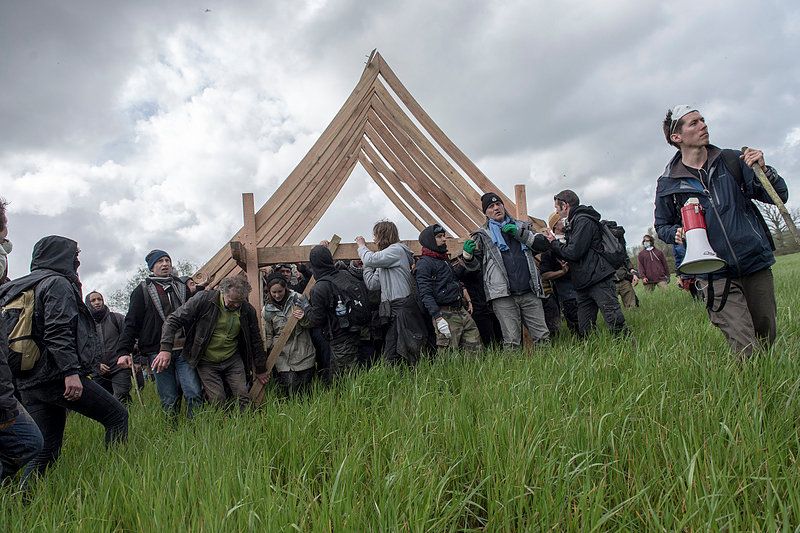
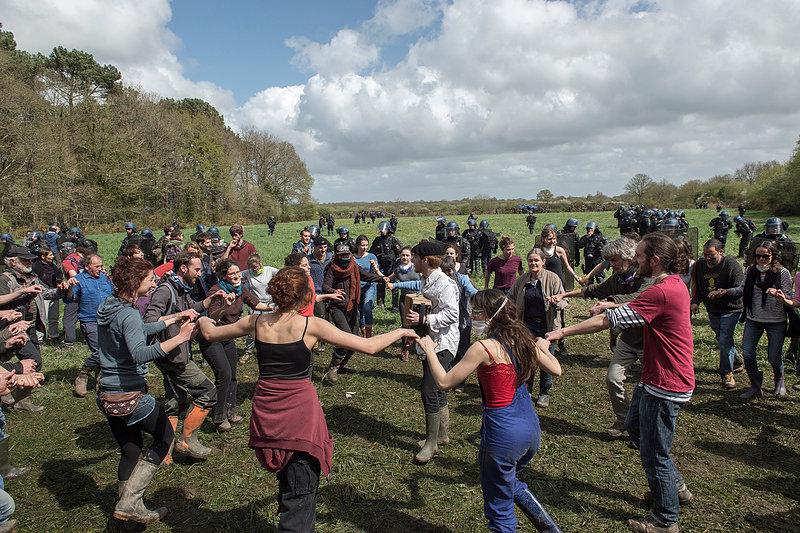
Whilst people pulled the deeply charged sticks out of the clay, others on lane behind carried the huge wooden frames, planks and beams of the new building to the field between between the Wardine and the Ambazada. It takes a few hours to put the carpentry back together and raise the structure up, meanwhile thousands of people push their sticks back into the ground creating a huge circular pallisade around it. In the next door field the police start to tear gas and stun grenaded hundreds of people, some had been reading poems to the cops many held their hands in the air in a gesture of peace. Families hold their ground next to masked up barricaders.
Meanwhile, a handful of people decide as a kind of game, to take the campanille, the tower like addition of the new building, through the forest to the east. A crowd of hundreds follows, we cross the road next to the cops who charge but are forced back by the mass of bodies, we try to get as near to the Gourbi as possible. The wind is on our side and blows the teargas back into the cops lines. But the playful act of defiance ends when its clear that we can’t get anywhere near the Gourbi, the police lines are too thick. However, the pleasure of running through forests and fields carrying part of a wooden building is clearly addictive. A few hours later, once the sun has gone down and the cops have left, a new plot is hatched. Why don’t we move the whole building, one and a half tonnes of it, 3kms across the fields, in the dark – to the Gourbi !
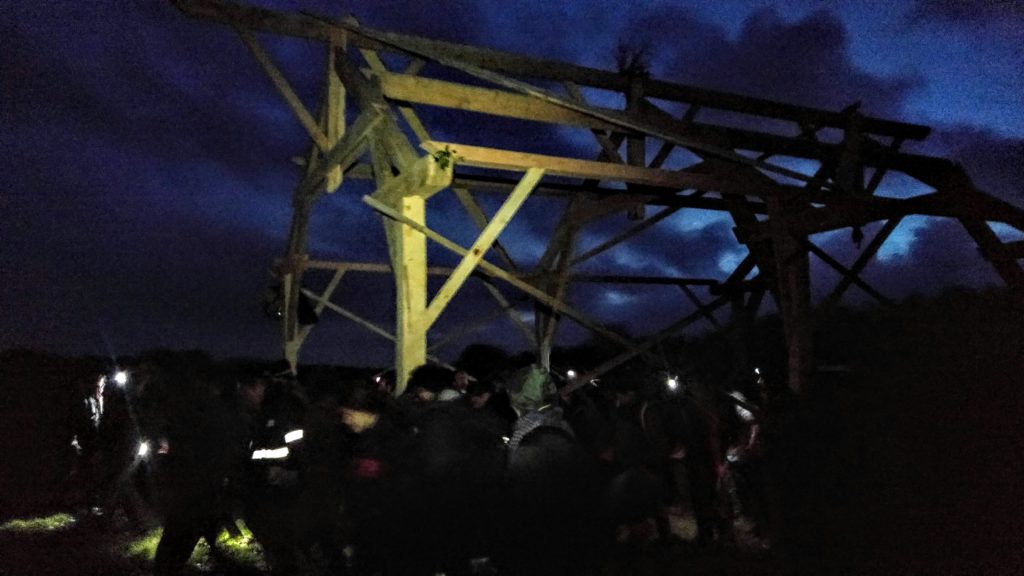
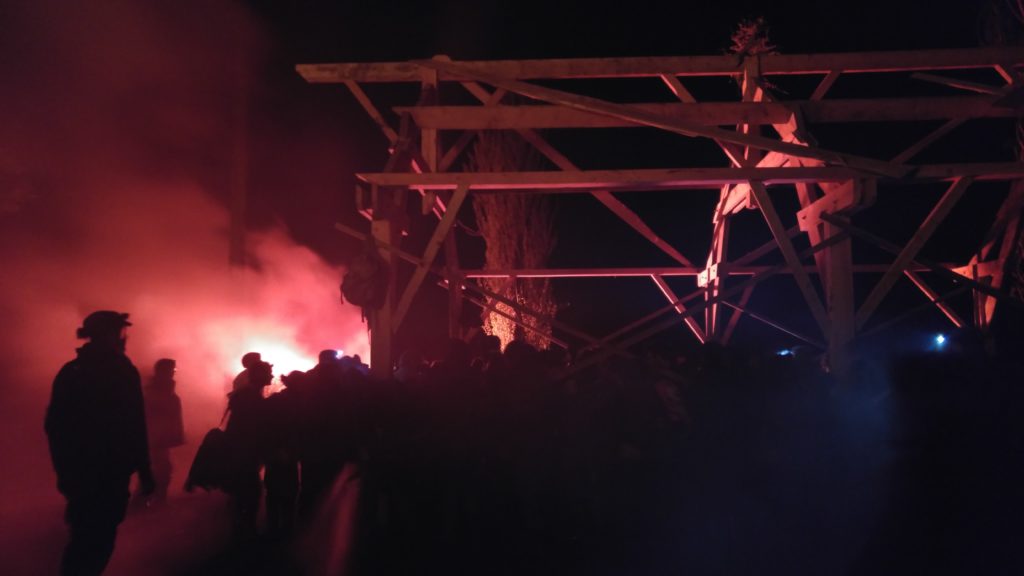
Despite the general state of tiredness that fills our bodies, we manage a huge heave, 150 of us lift up the structure. A mass of rubber booted feet walk in unison, it feels like a strange chimera shuffling across the bocage, half human half millipede. One of the carpenters directs the operation via megaphone, “a bit to the left ! slow down ! watch that tree branch !” Lit by the beams of dozens of head torches the building seems to float above the prairies, we are plunged into a space between fabulous dream and a scene from an epic film. Someone sits on the very top of the building pushing up the electricity and phone cables so we can pass under them. This is what we call the magic of the zad, the belief that anything is possible when we do it together.
We half expect to see the police helicopter, to feel its spot light pierce the night, but nothing. The closer we get to the Gourbi the louder the chants: “on est plus chaud, plus chaud, plus chaud que le lumbago” (we are much hotter, much hotter than lumbago). When we arrive, fireworks shoot up into the darkness, a bright red distress flare illuminates the scene. We set the building next to the pilled up ruins of the dome. We light a bonfire, Gourbi has risen again.
Whilst we were moving our house, Macron was being interviewed live on TV, sitting in a black and gold marble hall the Eiffel tower as monumental backdrop. He declares that airport had been abandoned as part of the “ecological priorities of the government” and that therefore our anger is no longer legitimate. Rather than an alternative society, the zad was “a project of chaos… illegally occupying public lands” he tells the nation.
“We have restored republican order” he declares, at least four times. We must sign individual forms before the 23rd of April or “everything that should be evicted will be evicted” he says. Macron ends with a ridiculous analogy: the zad is as if someone came into your living room to propose an alternative and squated your sofa. Ridiculous and wrong, none of the land here belongs to private individuals, it all still belongs to multinational airport builders Vinci and the state. But his statement was a new ultimatum, a declaration of total war against all collective forms of life. We return home to the news, but it cannot blunt the memories of this improbable night.
There are a half a dozen bodies perched like birds on the rafters of the new Gourbi, one plays a drum, a couple kiss, the green prairies below burst with yellow dandelions. We hear the rumble of APCs, it’s obvious they are coming straight here. The glint of riot visors shimmer in the sunlight, a column is moving towards us. A few flash bangs later and those on the roof are brought down by police climbers. The pillars of the building are cut by a chainsaw and the APC drives into it. Like the skeleton of a dying beast it crumbles to the ground. The police leave under a hail of stones, people sort out the broken beams. “Bastards !” a friend points to a stump of cut timber, “they sawed off the big fuck you finger and took it back to the barracks as a trophy !”
The Gendarmerie release their drone footage of the destruction on social networks. They need to show some success in their operation, they too are getting tired of this infernal cycle of destruction and reconstruction. A communication from a group called “Gendarmes and Citizens” denounces the fact that they are feeling “bogged down” and feel like “cannon fodder” faced with “rural guerrillas”. They deplore the “political paralysis” of the government who are on the one hand communicating with a “warlike tone” but are not following it up with effective orders on the ground. “Why are we not being given orders to arrest everyone in the squats ?” they complain. So far there have been suprisingly few arrests, we wonder if they will just come back later, raid our homes, pick us off one by one, when things are quieter ?
There is a new moon above tonight’s Assembly of Usages. Unsurprisingly the debates are heated, we have to decide to re start negotiations or not. The question has never been negotiate or fight, we always knew that we had to do both, but after so many days of attacks it’s not easy to accept to go back to the table. In the end we decide that we can meet the préfete, not to negotiate the base issues, but make demands for the continuation of talks, one of which is take the troops off the zone. “You don’t negotiate with a gun to your head”, one of the locals says, but we known that if we refuse to meet, Macron’s machine could return and destroy everything that is left, risking lives and in the end depriving us of this territory where we found each other.
An older friend of mine, someone who experienced the uprisings of ’68, writes to me. His letter just says, “the zad will never end, it will simply change shape.” And he is right. This attachment we have to this territory where we have been able shake our dependence to the economy and the state, is something that brings us together, however disparate our political perspectives. Our love for this huge play ground which inspires us to organise together, this deep desire for the wetlands that lubricates our imaginings, these are not abstractions but feelings that are deeply anchored to our experience of this bocage and all our experiments that emerge from it. It is a place that compels us to recompose, to renew, to have the courage to put our political ideas into question, to always push ourselves further than what we thought was possible, to open ourselves up beyond a radical ghetto or walled off utopia. Despite our barricades and the diversity of disobedience, if the state really wants to eradicate the whole of the zad, they can. Everyone would have lost their homes, workshops, fields, tools and we would probably find ourselves banned from returning to the region (a common judicial punishment in France). Scattered across the country without a place that enables us to grow roots together, we would loose all our strength. We know that changing shape is painful, but like a cameleon changes colours, we need to find a way protect this laboratory and camouflage its revolutionary potentialities from the eyes of the state. If we want to stay we need to find a compromise whilst refusing to let go our the commons.
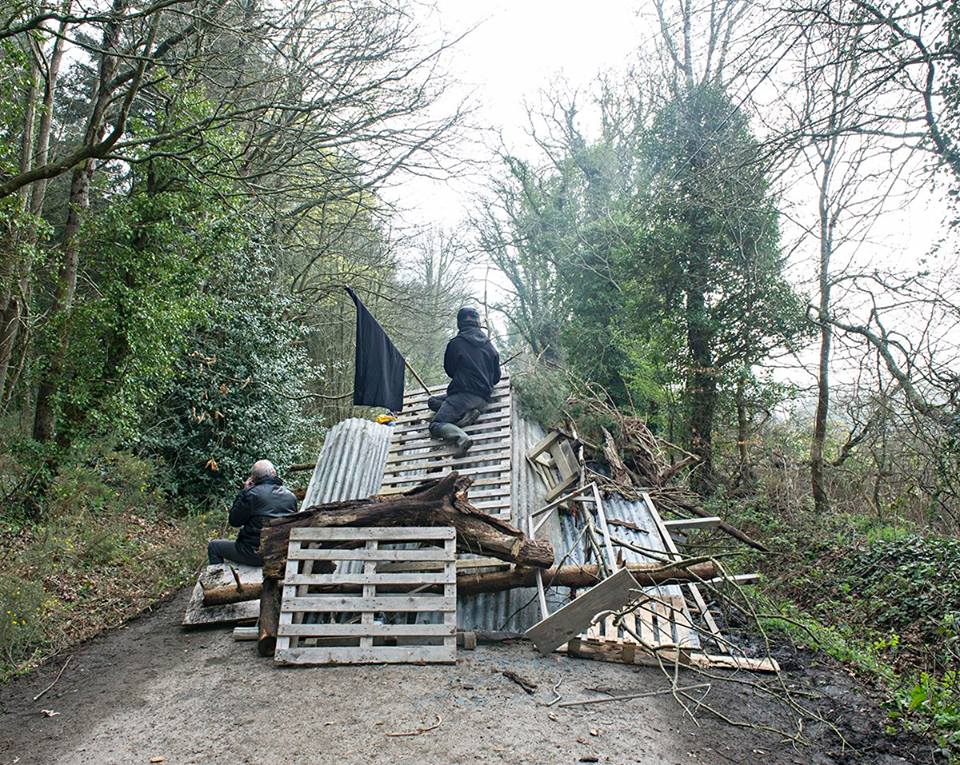
It’s a week later. Over breakfast, Paul tells me about last night’s adventures. “It felt like we were robbing a bank. So organised, dressed in black, head lamps, maps, scouts etc. Except all we were doing was evacuating the bee hives from the destroyed homes and gardens, getting them off site.” he smiles “we had to carry them full of bees across the hedgerows behind police lines.”
The days have calmed down. Less cops on the zone, more bird song than explosions. The cycle of barricade growing and then being smashed slows down, partly because on the main roads the police bring in huge skips to take the materials away. In the smaller lanes barricades remain.
The restart of the negotiations on Wednesday went badly, nothing shifted, despite the presence of ex TV personality Nicolas Hulot, now Minister of Ecological Transition, in charge of the zad case since Marcron’s election. He is flown in specially to Nantes in the presidential jet. Following the meeting with us, he gives a press conference in the palatial hall of the Prefecture. The government’s hard line is held, the rights of property and the market reign, there will be no global or collective contract for the land, we have to give individual names and land plots by the 23rd or face evictions. In a rhetorical floury he ends, “ecology is not anarchy.”
Not surprising for a man whose ‘ecology’ involves owning six cars, signing permits for oil exploration and supporting the nuclear dump at Bure. Hulot is simply the ‘eco’ mask for Macron’s “make the planet great again” form of authoritarian neoliberal green capitalism. But his statement shows Hulot’s absolute ignorance of the history of both ecological and anarchist thought. Many of the first theoreticians of ecological thinking, were anarchists. Élisée Reclus, world famous geographer and poet, whose beautiful idea that humans are simply “nature becoming aware of herself,” fought on the barricades of the 1871 Paris Commune. 19th century geographer Peter Kropotkin, spent many years in jail and exile for his politics, but was renowned in scientific circles as an early champion of the idea that evolution is not all a competitive war of “red tooth and claw” but instead involves a cooperation, what he termed Mutual Aid. From the 1950s onwards, US political philosopher Murray Bookchin (now best known for the influence he has on the Kurds to build a stateless form of Municipal Confederalism, taking place in the autonomous territory of Rojova – Northern Syria) brought ecology and anarchy together.
At the heart of his Social Ecology is the idea that humans dominate and destroy nature because we dominate ourselves. To avert ecological collapse we had to get rid of all hierarchies – man over woman, old over young, white over black, rich over poor. According to Bookchin, our greatest lesson to gain from the natural world was that we had let go of the idea of difference, and reclaim the concept held by many small scale organic societies, of unity in diversity. Diversity being the basic force of all bio-systems. He envisioned a world that would be neither communist nor capitalist, but what he called “Communalist”. “The effort to restore the ecological principle of unity in diversity,” he wrote, “has become a social effort in its own right – a revolutionary effort that must rearrange sensibility in order to rearrange the real world.” For him the question of society, to reframe Rosa Luxembourg’s: “Socialism or barbarism” – was: “Anarchism or extinction.”
When we truly inhabit an eco system it becomes obvious that life has no control centre, no heirachy, no chiefs or bosses, no governments or presidents. Every form of life is a self organising form of commons – deeply connected and interdependent, always changing, always embedded and entangled – from the cells in your fingers to worms in your the garden, from the trees in the forest of Rohanne to the bacteria in your gut. As biologist and cultural theorist Andreas Weber says, all life forms “are continuously mediating relationships among each other – relationships that have a material side, but also always embody meaning, a sense of living and the notion of belonging to a place.” The more we observe the living world in all its complexity the more we are able to understand how to become commoners, how to truly inhabit a place and see that the separation between the individual and the whole is a fiction.
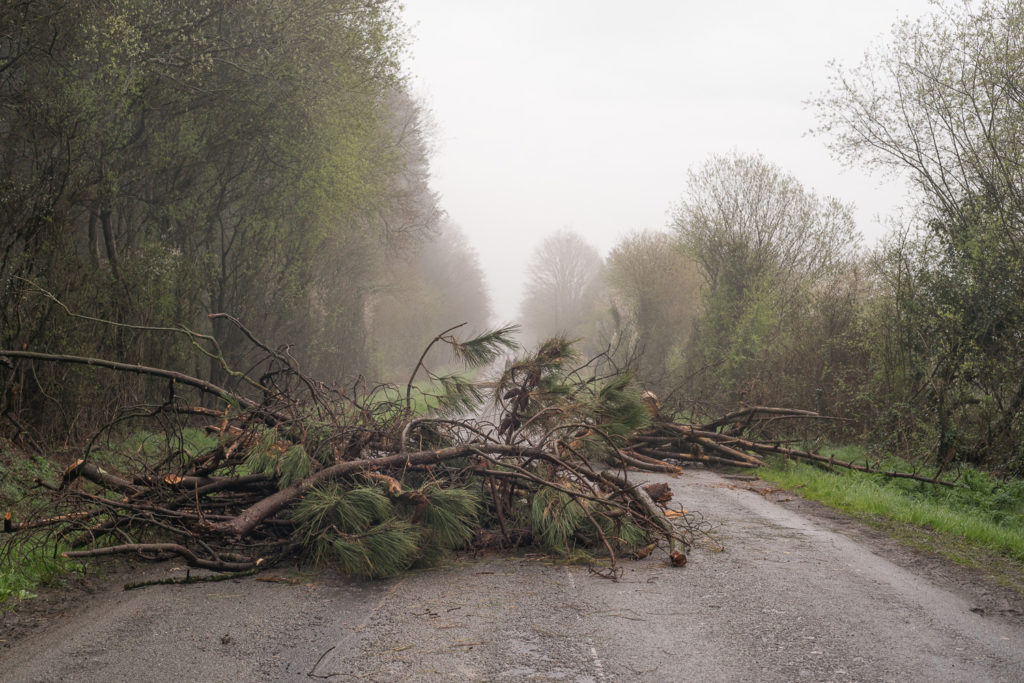
“In the ecological commons” writes Weber “a multitude of different individuals and diverse species stand in various relationships to one another – competition and cooperation, partnership and predatory hostility, productivity and destruction. All those relations, however, follow one higher principle: Only behaviour that allows for the productivity of the whole ecosystem over the long term and that does not interrupt its capacities of self-production, will survive and expand. The individual is able to realise itself only if the whole can realise itself. Ecological freedom obeys this basic necessity.”
And so to be really free is not to be an individual able to operate free from constraints, but to be tied to beneficial relationships with people and habitats, relationships that feed you materially and psychologically. Without a tie to your food – you starve, without the tie to lovers – you sadden. We are free because we are linked. Freedom is not breaking our chains but turning them into living roots and veins that connect, share, flow together and enable us to change and evolve in common.
Since the abandonment of the Airport, changing together on the zad has been a very a painful process. On the zad often it is a fight between those of us who try to read the terrain and invent something new that is messy and hybrid yet fits the situation we are in and those of us who want to keep a pure radical position, more based on uprooted ideas and ideology than the complexity of the present moment, the here and now, the forces we hold and don’t. In 1968 Bookchin asked“When will we begin to learn from what is being born instead of what is dying?” It is a question still just as relevant today on the zad.
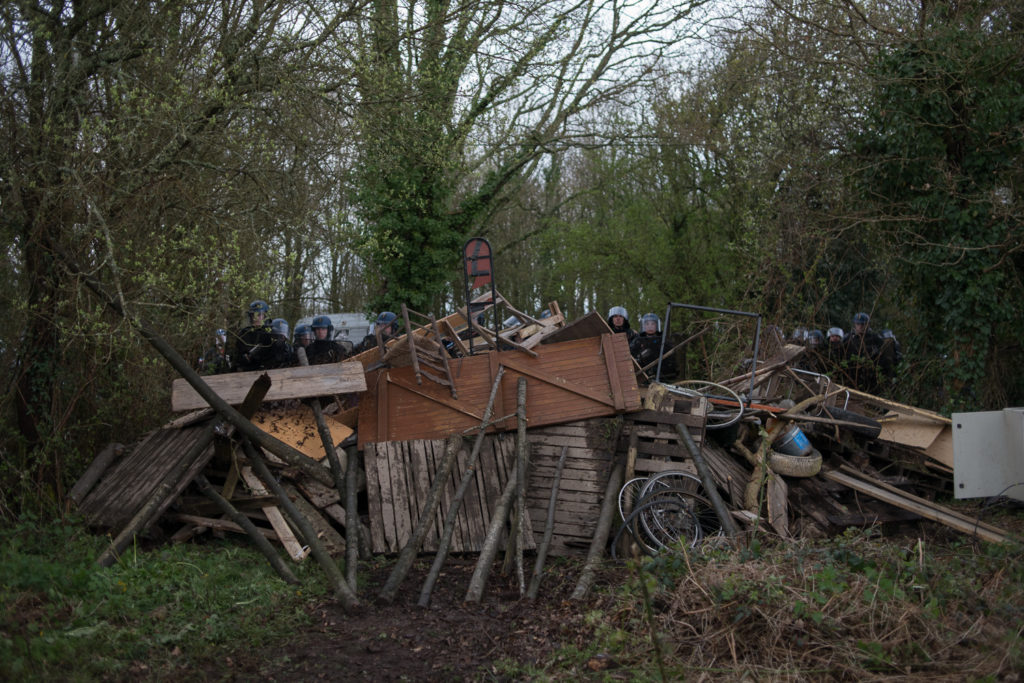
Things have been moving so fast. After Hulot’s ultimatum, a ministerial announcement suggests that the Prime minster and minister of interior are on a war footing, they are prepared to go for it, evict the whole zone on Monday’s deadline, the 23rd.
During the re start of negotiations on Wednesday a technical meeting between our delegation and the bureaucrats, who look at the case from a purely land and agriculture question, had been set for two days later, Friday 20th . Once again we are on a knife edge, this could be the last moment of negotiation before a full scale attack, an attack that most of us who live on the zone know we can’t win against, how ever big our barricades.
The Assembly of Usages makes a huge strategic gamble, its a paradigm shift in tactics. We decide to hand in the forms at the Friday meeting, but in a modified way, to show that yes we can fit the state’s square boxes of individual projects if they want, but that on the bocage nothing can be separated out, everything is interdependent. Whilst at the same time making a call out for people to come and be ready to defend on the territory from Monday onwards if the state attack. Its the logic of hacking, take what’s there, re purpose it, change its use.
Then one of the most unexpected types of zad magic takes place, an office of form filing is set up in the Zad’s library, and for 24 hours the building becomes a disturbed ants nest, dozens and dozens of people are running around carrying white pages of paper, writing on computers, having meetings together, looking at maps of the zone, making phone calls. Comrades with great legal and administrative knowledge help out and and by Friday afternoon, just as the meeting at the Prefecture begins a huge black bound file of 40 different projects is produced, each with a name and plots of lands earmarked, but no single name attached to a single plot. A colourful cartography of the commons of the zad is attached to further illustrate the interdependent and cooperative nature of the projects, be they a school of shepherding or the library, orchards or the sports group, mechanics garage or a snail farm, sunflower oil production or bringing up children together. Of the 70 living spaces on the zone, 63 are covered by the forms, only 7 decide not to take this bet of a barricade of paper. Of course paper barricades are not half as fun as ones on the streets, but this time they just might be the ones that save zad from becoming just another orgasm of history, another free commune which shined briefly but ended in bloodshed, another martyred experiment in freedom sacrificed for the sake of a pure revolution. The zad always tried to go beyond the idea of a TAZ (Temporary Autonomous Zone), in favour of a building a PAP ( Permanent Autonmous Zone), this desire is embeded in the solid buildings, the long term agricultural plans, the vineyards planted for win in 5 years time. We can’ just let go of all the ties we built here, with the locals, surrounding farmers, pensioners, workers in the city, wanderers of all sorts, Nantes students and the youth, the owls, the black squirming salamanders, the knarly oaks trees, the mud. We must hold onto all these deep friendships and networks of struggle that we have shared with such intensity over the last decade.
The state bureaucrats were confused, some enchanted, the préfete seemed relieved. Leaving the meeting our delegation tells the press that “we have responded to the injunctions of the state because we want to stop the escalation of tension and at last find the time for dialogue and construction,” warning that “ if we take away one element of the collective, it cannot work. It’s up to the state now to negotiate.”
As I finally finish this text, the helicopter returns, anxiety rises again in my chest. It spends a long time swooping over the zone, observing this rebel bocage that it wants to reclaim back. Perhaps it is preparing for a final revenge against the commons, who knows, all we know is that during this last fortnight we have fought with every weapon we thought possible including the unexpected. Now we wait to see if the bet worked out…
P.S
On the 26th of April three days after we posted this blog, the Prime Minister made a statement about the Zad: announcing a truce in evictions until at least the 14th of May, to allow time for the regularisation of the occupants who filed forms. According to the Minister of the Interior, “Everything moves calmly and in serenity, as always,” that hasn’t stopped them piling in with the tear gas this morning to clear barricades. The bet seems to have given us some breathing space, even though they remain with the logic of sorting the ‘good’ who have chosen the ‘right path’ and the bad ‘illegals’, something we continue to reject.
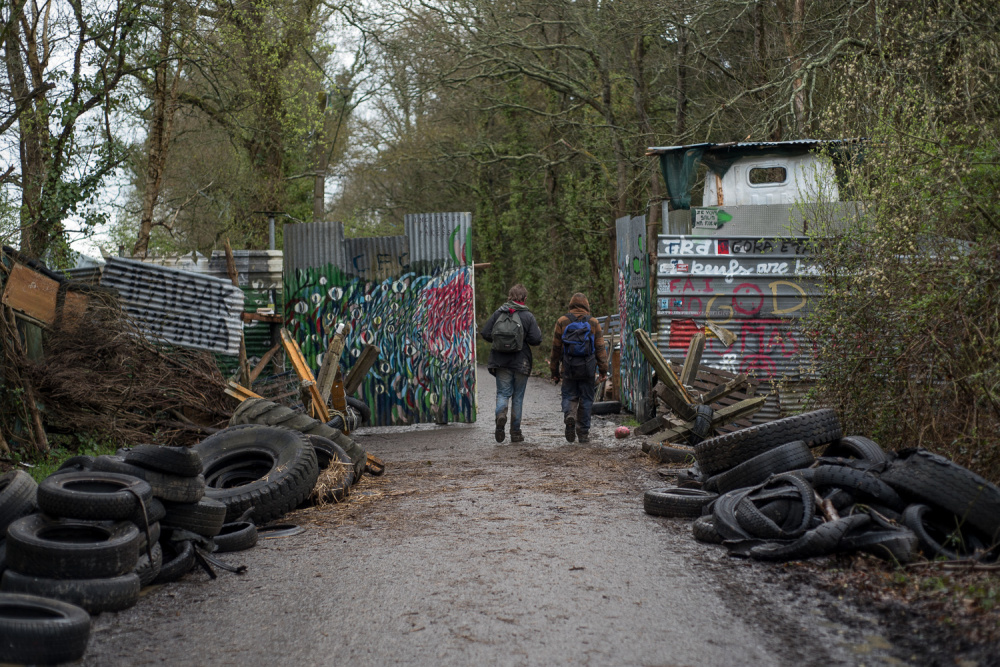
A recent report on digital attitudes shows that while 50% of people in the UK say that the Internet has a positive impact on their lives, only 12% believe it has a positive impact on society.[1] Mark Zuckerberg’s recent failure to give a straight answer to questions about misuse of Facebook’s user data, illustrates a major problem.
Much has been made of the democratising effect of social media platforms. However, while more of us are encouraged to “have our say”, we have less influence over the important decisions that most affect our lives, our localities, and the ways in which our societies are organised. The owners of digital platforms from Facebook to Uber, answer to shareholders in private, rather than to citizens in public. It should therefore not surprise us when they manipulate, monetize and exploit users’ interactions, attitudes and behaviours for their own commercial and political interests.
This problem of privately owned social space is not one that can be resolved by consumer and state regulation alone. It is a wider societal issue that further reinforces to us at Furtherfield, the immense value of park spaces in which neighbours come together each day, renegotiating in public, the spirit of the place through a diverse mingling of purposes.
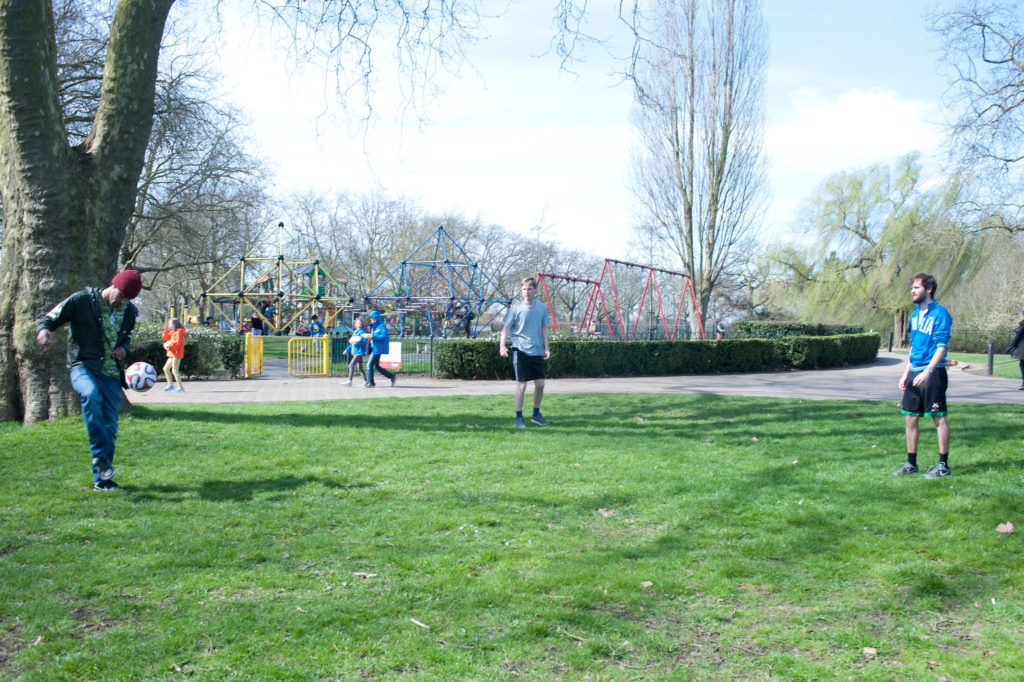
Over the last six years more than 50,000 people have encountered over 75 digital artworks that Furtherfield has brought to the park, working with international artists who reveal the invisible forces at play in machine and digital infrastructures. This summer Furtherfield extends its programmes beyond the Gallery and Commons venues into public green space of the park as we announce the first exhibitions, workshops and labs as part of Platforming Finsbury Park.
We are inviting park users to collaborate with us to transform the park into a public platform for cultural adventures, social inventions and reflections; to work with artists, hackers and academics from all backgrounds to rethink the social impact of technology and its flows on public spaces; and to bring local needs to the forefront in the context of planetary-scale techno-social advancements.
Currently showing at Furtherfield Gallery in the heart of Finsbury Park is the exhibition Poetry for Animals, Machines and Aliens: the Art of Eduardo Kac which is free and open to the public every day through May. The exhibition includes Lagoogleglyph, the third in a series of images as part of a global, networked artwork that takes the form of a pixelated bunny painted (in this instance) onto a field in the park, to be enjoyed by people on the ground and seen from Google Earth. In his essay Andrew Prescott, curator of the exhibition and Professor of Digital Humanities at Glasgow University revisits historic antagonisms between culture and technology prompted by reflections on the invention and imagination at play in Kac’s digital poetry.
Meanwhile families are joining artist Michael Szpakowski to use the very same satellite infrastructure to create GPS bunny drawings in his workshop series Let’s Fill the Park With Rabbits!
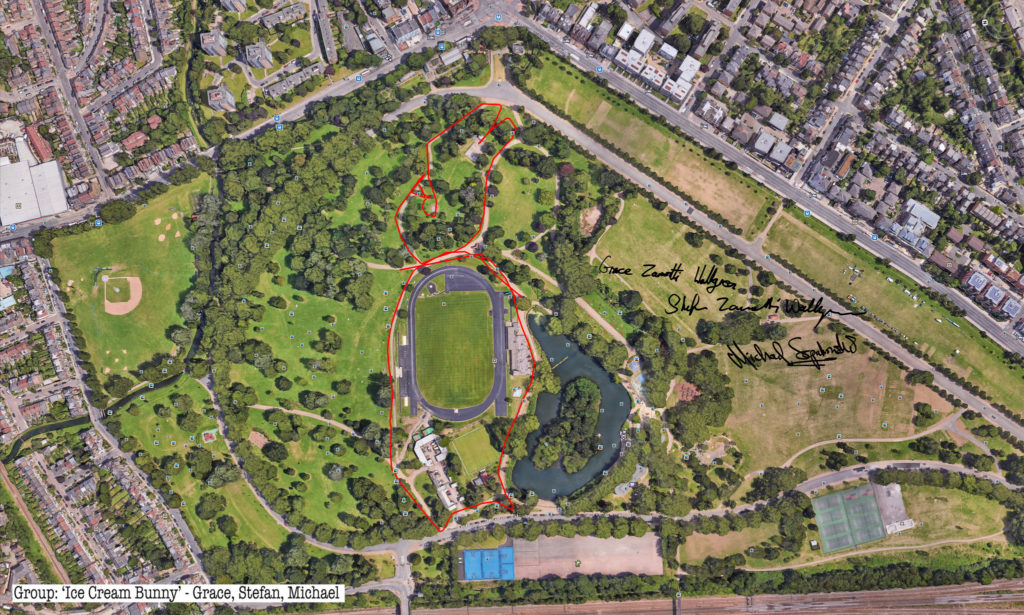
We hope that Platforming Finsbury Park will also start to flip some assumptions about who and what both art and technology are for. Over 180 languages are spoken in Finsbury Park. We want to make space for conversations and experiments with people from different backgrounds. Alongside the exhibition Andrew Prescott is also leading a series of public workshops on the theme of Digital Transformations promoting dialogue between and across diverse cultures.
In late May, we host Playbour – Work, Pleasure, Survival, a 3 day lab for artists, scientists and technologists dedicated to “the worker in an age of data and neurotechnologies”. From these will flow art commissions and collaborations towards our next exhibition in July.
Here you can read an interview with designer Ling Tan about the SUPERPOWER wearable technology workshops at Furtherfield Commons last summer in Finsbury Park. Ling tells us about how a group of young women from All Change Arts worked with her to devise activities and to learn about creating and interpreting data to themselves shape attitudes and behaviours. Dani Admis, curator of Playbour, continues this work later in the summer, exploring with local young women how they might effect change on their own terms, using the conceptual power tools of neuroscience.
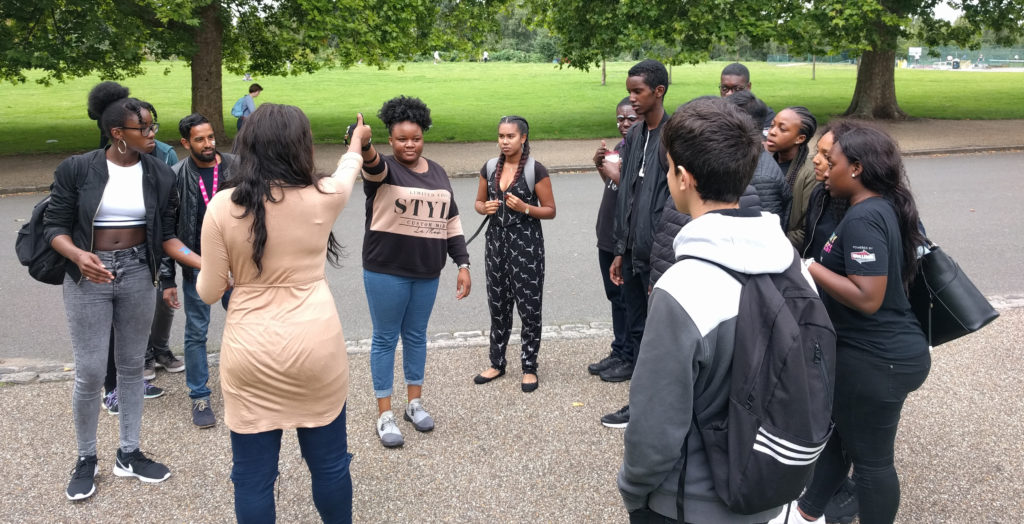
Finally a provocation to Furtherfield from Simon Poulter, artist, technologist and producer of NetPark, the digital art park at Metal in Southend, who is working in partnership with us. He celebrates our commitment to the commons “as a real thing, worth our energy and stewardship, the point at which people do touch each other and listen.” He also issues a call to action…“It is time to invent another future, lest we will become the disrupted and not the disruptors.”
As Manuel Castells famously put it ‘The flows of power generate the power of flows, whose material reality imposes itself as a natural phenomenon that cannot be controlled or predicted… People live in places, power rules through flows’. [2] And in network society these flows often have the power to wash clean away communities’ ties, extracting value and flowing it to the private interests of absent and distant persons and bodies.
So our future mission grounds us in Finsbury Park, while maintaining our global reach. We are passionate and committed to multiple points of entry, bringing in consenting and diverging voices, to channel and circulate flows locally to generate the power to enact this public place together with verve.
Much of our cultural history of the past two hundred years has been defined by anxieties about the growth of a technological and commercial society. In the nineteenth century, Samuel Taylor Coleridge bewailed ‘the philosophy of mechanism which, in everything that is most worthy of the human intellect, strikes Death’, while Matthew Arnold declared that ‘Faith in machinery is our besetting danger’. For such commentators, culture represented a means of staving off the threat of an industrial society ruled by money and commercialism.
It is easy to fall into a false binary of opposition between art and technology. When pioneering artists and scholars first demonstrated the potential for using computers in arts and humanities research in the period after the Second World War, their work often provoked antipathy because of this anxiety to maintain a distance between art and the machine. In my inaugural lecture at King’s College London in 2012, An Electric Current of the Imagination, I argued that artistic practice offers a particularly effective means of fostering a creative and critical relationship between art and technology. I declared that ‘Such a new conjunction of scientist, curator, humanist, and artist is what the digital humanities must strive to achieve. It is the only way of ensuring that we do not lose our souls in a world of data’.
Since 2012, I have held an AHRC fellowship as Theme Leader Fellow for its strategic theme of ‘Digital Transformations’. One important outcome of this theme has been further exploration of the way in which artistic practice offers innovative perspective on our relationship with technology. Artistic experiments with a range of text technologies from the typewriter to the computer provide exciting insights into the materiality of the text and the way in which text interacts with our senses as readers and writers.
One event held under the auspices of my fellowship which seemed to me to encapsulate these possibilities was an exhibition, Design and the Concrete Poem, curated by Bronac Ferran at the Lighthouse Gallery in Glasgow from 28 September – 6 October 2016. This exhibition introduced me to the work of many artists whose exploration of the materiality of text and poetry I found compelling.
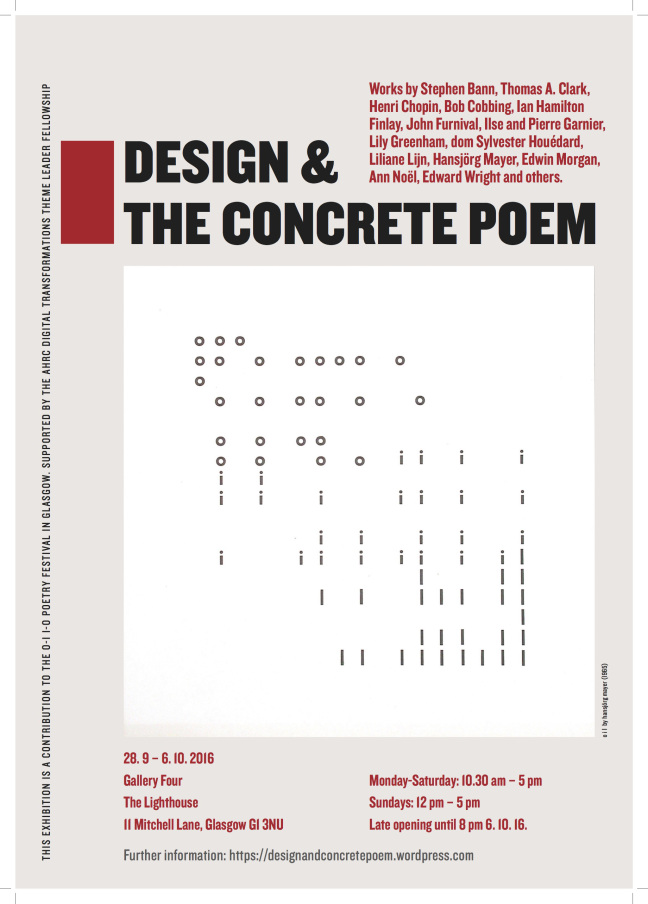
Design and the Concrete Poem introduced me to such reinventions of the text as dom Sylvester Houédard’s experimentation with typewriters or Liliane Lijn’s use of letraset on metal drums to create Poem Machines. The way in which Lijn’s exploration of Dickensian engineering workshops in London in the late 1960s inspired her Material Alphabet (1970), and her fascination with industrial processes and images, epitomises the way in which artistic practice can generate creative conjunctions with technology. Pierre and Ilse Garnier’s poem cut on a Gestetner duplicating stencil, shown for the first time in the Glasgow exhibition, offered both a novel view of textual materiality and an elegy for an obsolete technology.
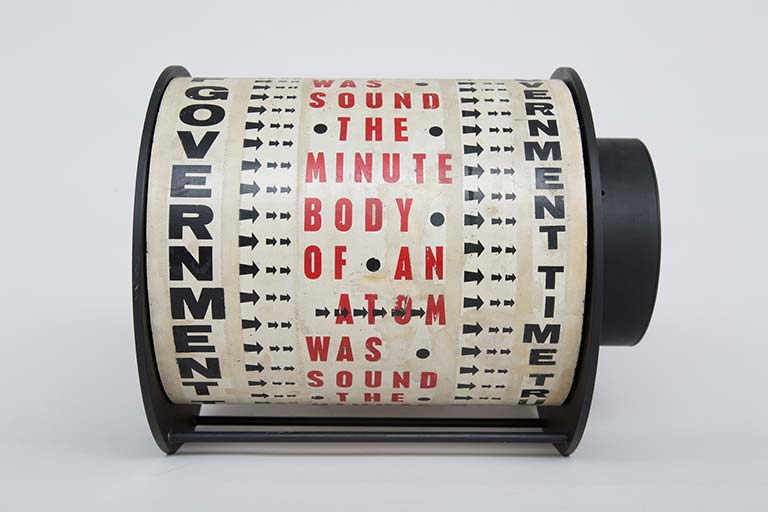
One artist whose work I have found consistently helpful in thinking about the interaction between technology, communication and our human condition is the Chicago-based Eduardo Kac (b. 1961), and I am delighted to have helped arrange at Furtherfield his first UK show, Poetry for Animals, Machines and Aliens.
Poetry is challenging. A poem questions our certainties, makes us see the world from different angles and, by encouraging us to pause and reflect, subverts that mechanistic goal-oriented outlook which so horrified Coleridge and Arnold but nevertheless dominates the modern world. Technology can give words and letters new shapes and resonances and, in so doing, subvert a consumer-oriented view of technology.
There can be no more imposing expression of technological achievement than the International Space Station. One of the most fascinating aspects of the video of Eduardo Kac’s space poem Inner Telescope, performed in 2016 by the French astronaut Thomas Pesquet, shown in the Furtherfield exhibition, are the interior shots of the cramped space station, jam-packed with wires, containers and panels from innumerable scientific experiments. The confined space station contrasts with the expansive views of the earth visible through the space station windows. This contrast itself seems like a commentary on the puny character of human technological ambitions.
Kac proposed the idea of space poetry in 2007. He pointed out that weightlessness would affect the temporal and physical logic of a poem, while the readers’ sensory engagement with the act of reading would also be different under zero gravity. Inner Telescope vividly illustrates how a simple performance such as cutting paper may be different in zero gravity, while the movement of the paper (cut into a form representing the word ‘Moi’) seems to epitomise the fragility of textual communication. In the rigidly scheduled life of the space station, Inner Telescope uses poetry to pause and reflect on the complex interrelationship of humanity, technology and the wider universe.
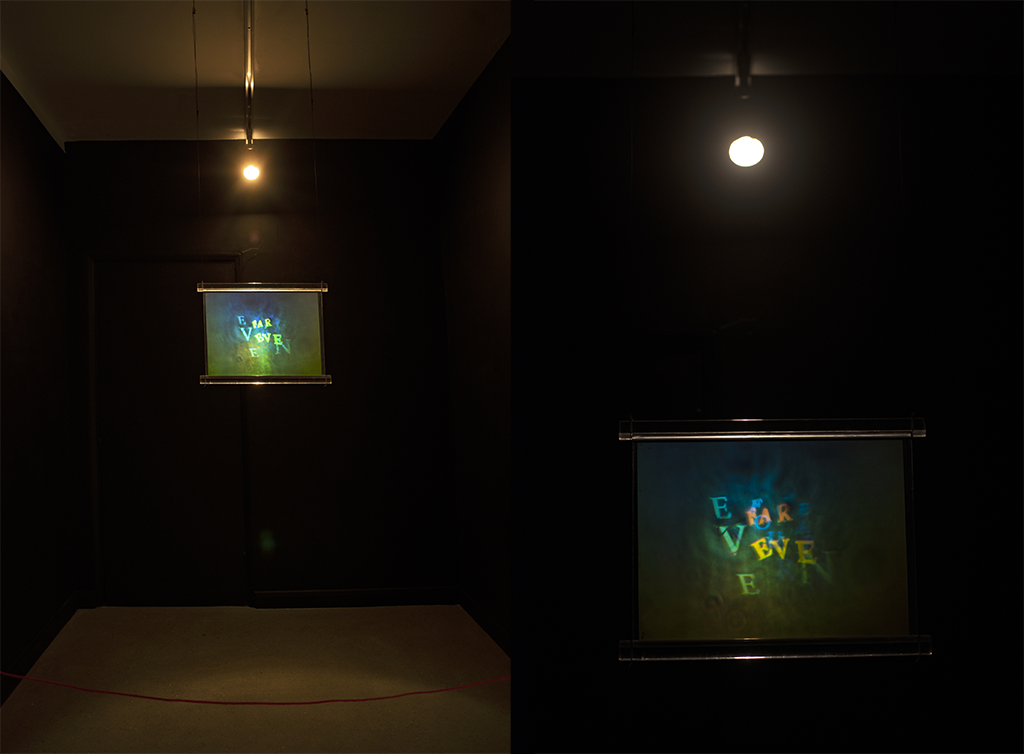
One major thread of Kac’s art has been the relentless interrogation of technology to create radical and original poetic visions. Kac experimented with the potential of the typewriter to allow different juxtapositions and textual shapes in his Typewritings of 1981-2 and from these experiments sprang his first digital poem, Não! (No!) , in 1982-4. Não! was presented on an electronic signboard with an LED display with fragmentary text blocks, encouraging the reader to guess at the links between them.
The digital poems shown in the Furtherfield exhibition illustrate how Kac makes use of digital technologies to redefine the relationship between the reader and text and to reveal new poetic elements in short words and phrases. In Accident (1994), a digital loop introduces shifts and uncertainties into a text, recalling the nervous hesitation when two lovers meet, but also causing the reader’s perception of the text to change as the piece progresses.
Another remarkable pioneering digital poem on display at Furtherfield, Letter (1996), uses virtual reality markup language to create a three-dimensional spiral of text which the reader can spin, invert, twist and explore from every conceivable angle. The text appears to be a single letter, but turns out to be two letters, one from the artist to his dead grandmother and another to his newly born daughter.
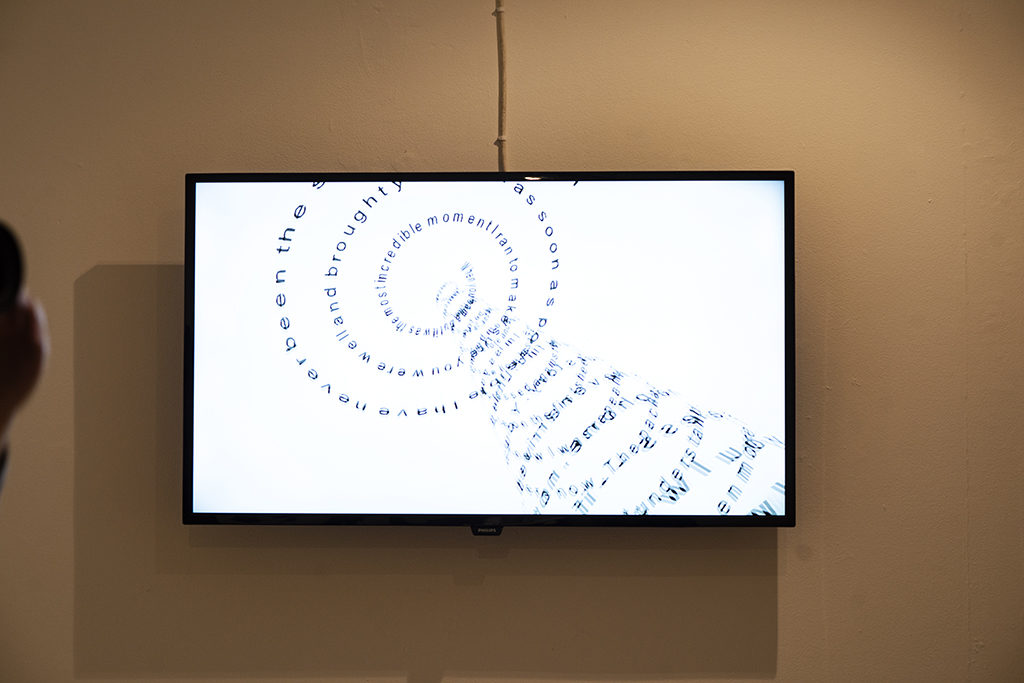
Text and language are perhaps the two technologies which most profoundly shape our lives. By altering our perception and engagement with text, Kac raises questions about the way in which we communicate and understand each other. In his beautiful holopoems, one of which is on display in the Furtherfield exhibition, Kac creates texts which shift and change depending on the angle at which they are viewed. Text technologies frequently give the impression of immutability, but Kac’s holopoems remind us how unstable and deceptive texts may be.
The full range of Kac’s technological exploration is impossible to encompass in a single exhibition, but some sense of it is evident from his website (www.ekac.org). Particularly fascinating is the way in which Kac has explored the poetic possibilities of technologies which are now redundant. Although the platform on which the work was realised is now obsolete, the work nevertheless anticipates contemporary digital cultures. Thus, Kac used the French videotext network Minitel to show the possibilities of network art. He demonstrated the potential of large-scale collaborative works by various pieces using fax. Kac was already experimenting with the potential of telepresence, robotics and wearables in the 1990s.
At each point in these explorations, Kac urges us to engage with these technologies creatively, to use them to create fresh visions, and not simply to accept them as consumers. As a historian, I have long felt that humanities scholars too often passively accept the technological resources and tools made available to them by commercial companies and others. One of the reasons why I believe passionately that humanities scholars should engage more closely with artistic practice is that such a dialogue will foster a more creative and critical approach to the use of digital methods by humanities scholars. The artists whose work I have encountered in the course of my AHRC Fellowship, such as Fabio Lattanzi Antinori, Michael Takeo Magruder, and Katriona Beales as well as pioneers such as Nam June Paik all convey the message that we need to engage creatively with technology. Technology is a threat if we view it passively as an inhuman external force; if we rather seek, like Kac and these other artists, to interrogate, extend and reimagine technology in a creative way we can hope to take greater ownership of it.
This is most spectacularly illustrated in Kac’s bio-art. It is now becoming evident that new biotechnologies will within a short period of time profoundly alter human existence and personality. Kac’s bio-art (following in a tradition which includes the creation of germ pictures by Sir Alexander Fleming) again encourages us to engage creatively with these emerging technologies.
DNA is text and DNA can be poetry of the most profound sort. In a series of works called Genesis (2001), a synthetic gene was created by Kac by translating a sentence from the biblical book of Genesis into Morse Code, and converting the Morse Code into DNA base pairs according to a conversion principle developed by the artist. The sentence chosen was Genesis 1:26: ‘Let man have dominion over the fish of the sea, and over the fowl of the air, and over every living thing that moves upon the earth’.
Visitors to the gallery showing Genesis could trigger mutations in the bacteria’s DNA by switching an ultra-violet light on and off. This in turn mutated the text when it was converted back in morse code and then into English. The artist comments that ‘the ability to change the sentence is a symbolic gesture: it means that we do not accept its meaning in the form we inherited it, and that new meanings emerge as we seek to change it’.
Kac’s most well-known work is GFP Bunny (2000) in which an albino rabbit called Alba was bred in a laboratory with a gene causing the rabbit to glow fluorescent green under a blue light. Kac’s image of Alba has become very well-known and was perhaps one of the first iconic art images of the twenty-first century. We will be exploring the cultural phenomenon of Alba in another exhibition at the Horse Hospital called ‘…and the Bunny goes Pop’, opening on 2 June 2018.
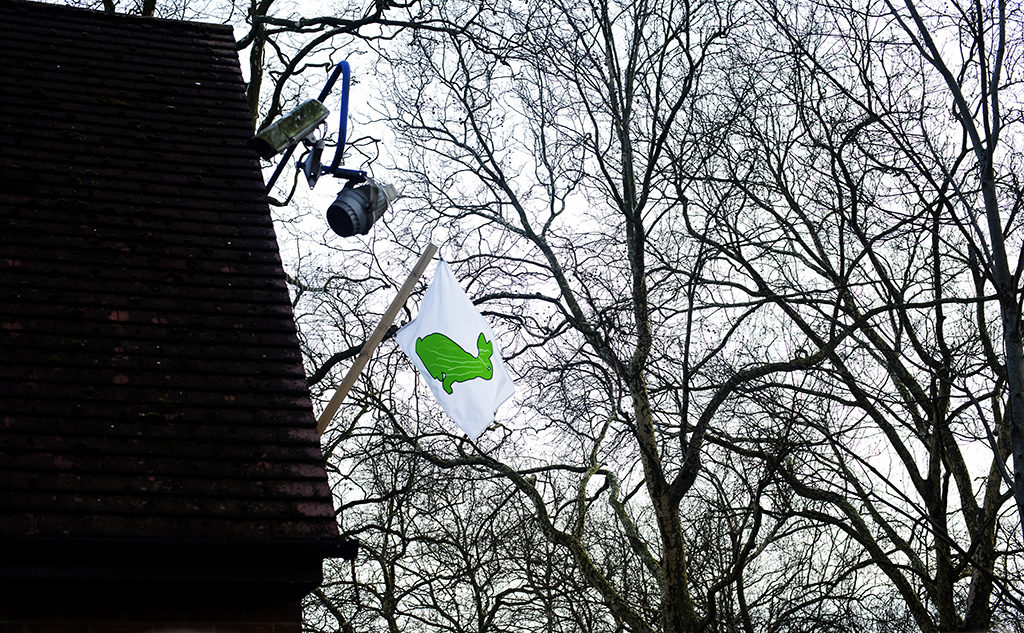
The distinctive image of Alba, shown on The Alba Flag (2001) hanging outside Furtherfield during the exhibition, is also a highly poetic image, conveying many messages about identity, the nature of life and belonging, and the increasing intersection of these with technology. Kac’s memories of Alba prompted him to create a wordless language system incorporating rabbit imagery which he called lagoglyphs (from the ancient Greek words ‘lagos’ for hare and ‘glyphe’ for carving).
Kac has now begun a series of Lagoogleglyphs, large lagoglyphs designed to be visible from the satellites which provide the imagery for Google Earth. Lagoogleglyph I (2009) was installed at Oi Futuro, Rio de Janeiro, Brazil and Lagoogleglyph II (2015) at Es Baluard Museum of Modern and Contemporary Art, Palma de Mallorca, Spain. Lagoogleglyph III has been installed in Finsbury Park.
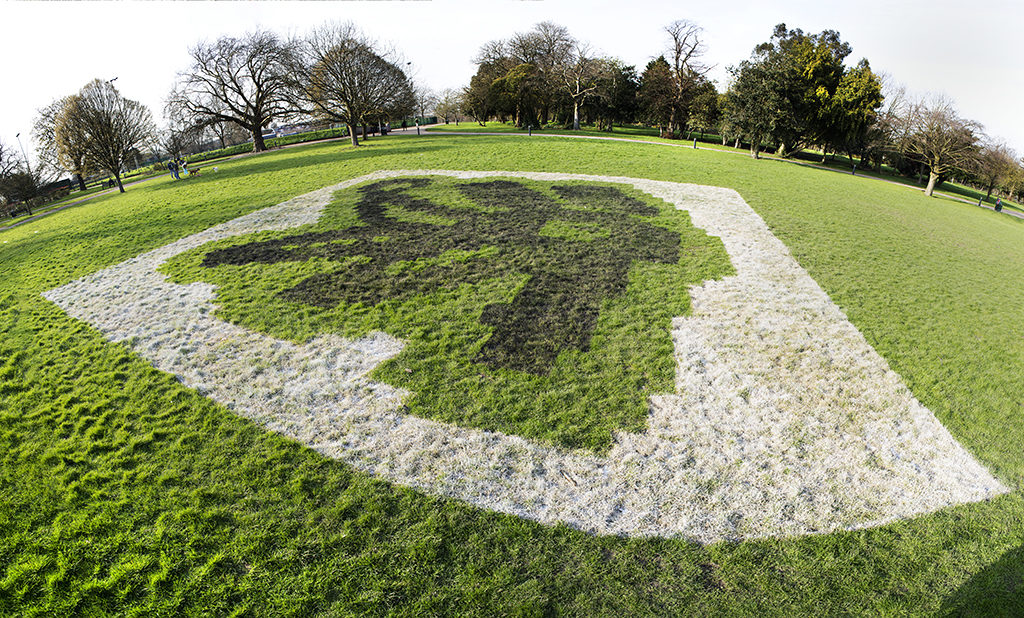
The Lagoogleglyphs encapsulate what is to me the central message of Kac’s work. Google is a vast all-encompassing technology giant which encourages us to consume its services while it makes money from data about us. The way in which Google Earth acts as a panopticon for the world, presenting an idealised sunny view of the planet’s surface, symbolises the hierarchical downward nature of much modern technology.
How can we seek to make our presence felt with the world of mass corporate technology? Painting a huge image in Finsbury Park is an inspired way of intervening in the artificial deracinated corporate view of the human world presented in Google Earth.
When the Arts and Humanities Research Council established its strategic theme of ‘Digital Transformations’ in 2011, the terminology echoed that used in many corporate contexts, and was redolent of improved business processes and data management. Eduardo Kac’s work reminds us that real digital transformations are achieved through creative interrogation of technology and through reimagining how we engage with that technology. Poems turn out to be true drivers of digital transformation.
Artist and designer Ling Tan talks about the SUPERPOWER! workshop that explored ways to empower young women through a creative exploration of wearable technology in public space.
Last summer, artist and designer Ling Tan worked with young peer leaders from All Change Arts, and the Furtherfield team to devise a project called SUPERPOWER! Finsbury Park. It brought together young women from different walks of life to discuss their relationship with the city. The project explored the ability for technology to bring about female empowerment, and question the participant’s role as female in regards to decision making about our city.
Three common themes by the participants were collectively identified, and linked to a place in Finsbury Park. Using the themes to co-create a series of wearable devices that enabled them to record their subjective perceptions of the city using gesture sensing technology. These were: Cultural diversity and inclusivity in our community; Safety of individuals in the London Borough of Islington and; Wheelchair accessibility around Finsbury Park area
It was all co-scripted and used for an exploration walk, involving the team walking around a specific area of Finsbury Park, performing and recording their subjective experiences using the wearable devices that catalogued their gestures. During the workshop, participants designed body gestures using the wearable technology which track their body gestures and communicate remotely with each other through haptic/audio sensors.
Marc Garrett: Where did the idea for the workshops come from and how did the concept of superpower shape what participants did with your wearable technology.
Ling Tan: In SUPERPOWER! Finsbury Park, the participants were young women aged 15-25 years old and almost all of them have no prior knowledge of electronics and coding. Instead of the workshop being about coding and making, I wanted it to focus on empowerment, challenging them to go beyond their comfort zones. Hence the term “superpower” became a powerful concept to get them to think about technology as a form of superpower that extends their perception into the environment. The idea for the workshop built upon a couple of projects I was doing over the past few years; WearAQ and Fakugesi Social Wearables. The projects use wearable technology to enable different communities to actively record and map out their relationship with their cities through individual subjective perception in the form of body gestures. For example, perception of air quality in London, UK and perception of safety on the streets in Johannesburg, South Africa.
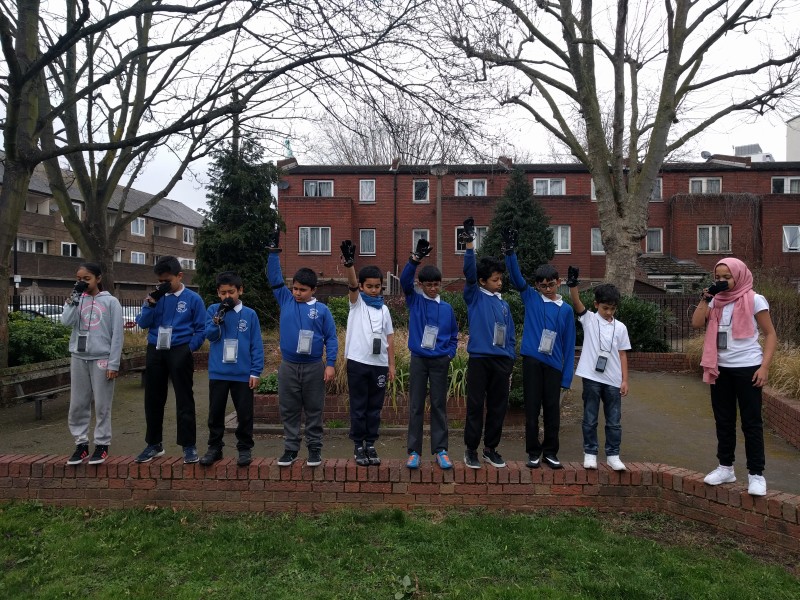

In the workshop, participants discussed about their relationship with Finsbury Park, designed experiments and body gestures to map out their own relationship through the use of an existing set of wearable devices, went out into public space and run with experiments with strangers, park users. For me, learning about what they want to do with technology is more important than picking up skills like coding or fabrication.
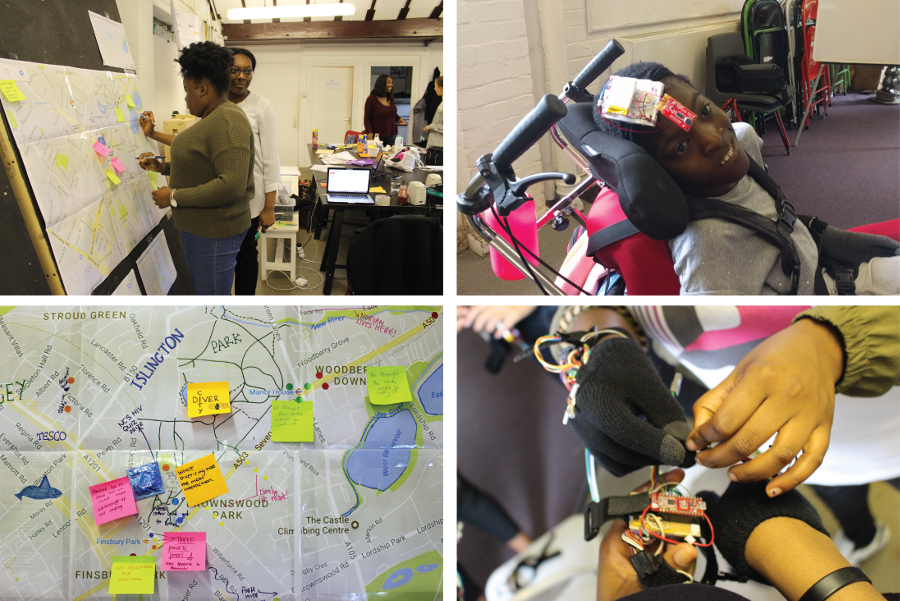
MG: We were surprised to hear how much the young women had appreciated being taught in depth about how the wearable technologies worked as part of this workshop. Do you think this informal workshop format offers a different way of supporting learning about and working with technology? What most surprised you about the way that the young women responded?
LT: I wanted to steer away from a conventional technology workshop where participants would focus on coding and fabrication, than design, because these are skills that they can pick up themselves through on-line documentation and support. For me, what is more important is to figure out what their own interests are with technology, by learning it through hands on design activities with ready made wearable technology. That way, it makes them feel comfortable with tackling complex technology and it also gives them the opportunity to learn about issues that might occur when technology is tested in the real world, checking it out when it does not work and why.

I was most astonished by their speed of learning and how well they picked up the tech knowledge. For example, one part of the workshops involved learning about the body gesture and what the wearables can detect through decoding “1” and “0” read via the body gesture sensors. I was very surprised that they were able to quickly translate that into their own body gesture design.
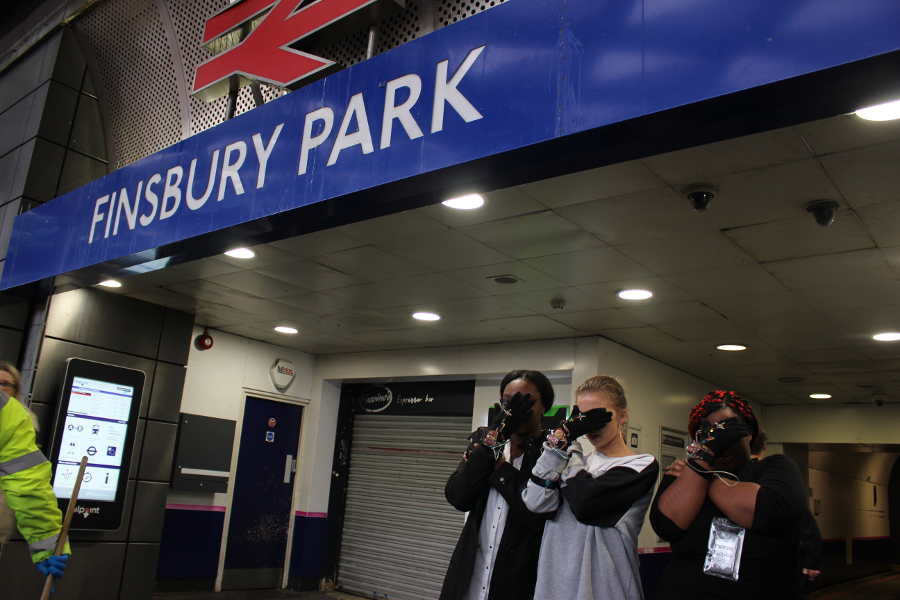
MG: Your workshop addressed questions of value in technology innovation, in the particular context of working in the public space of the park. Please tell us about how you approached these questions and why this is important to you.
LT: I think its is important to demystify technology especially given that we are living in an era where technology is so embedded into our everyday life that we take it for granted and do not notice its impact. It is important for the younger generation to learn about ethics of technology, to be curious about who and why companies are designing specific types of technology, and most importantly, to learn that technology does not always work, that technology cannot solve all our problems. They need to learn to be proactive and have a sense of agency in tackling issues concerning their own environment. For example, issues such as safety on the streets cannot be solved entirely by technology, it also needs other input such as citizen vigilance, policy and law changes.
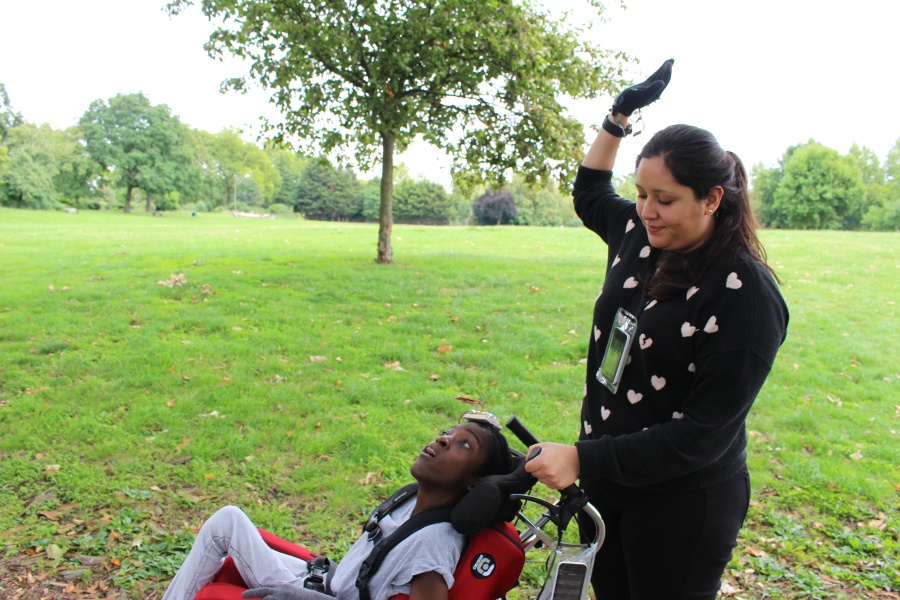
SUPERPOWER! Finsbury Park was a part of the B Creative Summer School, a programme of arts projects created by young women for young women aged 16 – 25 in Islington.
Special thanks to:
All the participants involved in the project
Peer leaders from All Change
Ella Medley Whitfield
Commissioned and supported by: Furtherfield and All Change
This project has been funded with the support from the European Commission. This communication reflects the views only of the author, and the Commission cannot be held responsible for any use which may be made of the information contained therein.
Valuing people is a core property of wealth creation, wealth creation can be positively bound into communities. We can’t afford not to be involved in digital creativity because it explores areas of social space that are entwined with intrinsic cultural and economic value.
The point of entry has become ubiquitous, we are everywhere, they are everywhere – I am over there and here too. Marshall McLuhan, the Canadian media theorist gave us ‘emotional extension in electronic space’ [1]before we came up with the clumsy and often misunderstood paradigm of ‘post-digital’ – a way to describe a circularity and return to being human that accepts the intersubjectivity and convergence we feel with other people and technology.
It is this corporeal and algorithmic unification and association that Furtherfield grasps; sometimes like harsh high summer nettles on uncovered hands, gathered as ingredients for a convivial soup. Not afraid to be stung or to make the soup, even though after 22 years of foraging you are not now the only voice or flag raised at the intersections of art, technology and social change. The mission is always different and always the same. This then is my provocation to you.
The case for digital creativity has grown. Why is that? Because there is deep unrest and even malevolence in electronic spaces and at their corporeal nodes. “The creative adult is the child who has survived,” says Ursula K. Le Guin.
As creative people engaged in the field we are with agency and in turn create agency; we gladly pick up refurbished laptops, remixed maps and fragmented tweets. Our fieldwork means we are in the river, standing watching by the shore, and holding up a mirror in the lobby of the hotel. We facilitate others, not just ourselves, we do it with others. Artistic people are children and not confined or restrained by common sense orders from the immaterial elite – some are pointed, focused and ready to enter the field, others are yet to claim their agency, and even more have yet to experience due North and due South. We can provide the co-ordinates, the beginning of the map and the line of sight. Artists in the future will become agents of change and observers of truth in a familiar return to base. And so we are not given to the idea, in the field, of carrying out instrumental command and we caution ourselves against suggesting this to others.
In a hotel in Sweden we listened as the French Philosopher, Bernard Stiegler brought attention to our attention. In clipped and someway jarred English, he opened up the vast chasm and problem of attention as the fundamental commodity of our age (emotionally extended, post-digital etc). His references to ‘techne’ willfully conjured up derivations from Greek – craftsmanship, craft and art. We are crafting the digital to draw attention to ourselves and our products. We are becoming products, through a process of digital reification. Lukács describes reification ‘as a relation between people that has taken on the character of a thing’[2]. So, while humans and machines merge evermore, we understand that the end-point of creative processes is not to make attention-seeking people become products and things, it is to diversify our subjectivities and illuminate the way forward for all.
The agency of artists has been a key factor in the development of the Furtherfield’s mission in its first two decades. This agency broadly disseminates to artists networks, activism, societal change, environmentalism, localism, global affairs and more recently emerging technologies such as blockchains. Within an unfolding world political landscape, these areas of interest show greater convergence and potential as moments of reflection become more important in the reified world of products. Our role is to be that reflective space for 360 degree scanning and to hold digital time up in the chain.
Our future mission grounds us on our locus in order to do this, while maintaining our global reach. We are passionate and committed to multiple points of entry, bringing in consenting and diverging voices. The ‘commons’ to us is a real thing, worth our energy and stewardship the point at which people do touch each other and listen.
We know that technology will not save us and furthermore we propose that this is not the right question. In working in partnership with academics, businesses and other institutions we are always asking ourselves where progressive change can come from, in a series of open dialectical spaces. Finsbury Park offers us a node in which to conduct business and make new wealth – cultural, social and economic capital. The predication of wealth creation on technology alone is too simplistic when a multitude of tools are needed. Our approach to the idea of the ‘commons’ is to use old and new tools and ways of getting things done together..
As McLuhan says: “Once we have surrendered our senses and nervous systems to the private manipulation of those who would try to benefit from taking a lease on our eyes and ears and nerves, we don’t really have any rights left. Leasing our eyes and ears and nerves to commercial interests is like handing over the common speech to a private corporation, or like giving the earth’s atmosphere to a company as a monopoly.” (from Understanding Media, 1964.)
We are not isolated from the huge pressures of the global economy, when advancements outstrip the ethics and the algorithms that come to define new normative patterns and processes. The role of digital creativity and artists is now fully emerging as one that reconnects them and us back into the critical space that Goya, Galas and others occupied. So, we can hold up time and re-enter it at a different point. Yes, Furtherfield offers time travel!
The disruptive power of technology is evident in its ability to unhinge and even eliminate existing businesses, local centres and distribution methods. This is not new, just as McLuhan defined electronic extension in the 1960s, Clayton Christensen defined ‘Disruptive Innovation’ in his book The Innovator’s Dilemma in 1997. However, digitally disruptive business models such as Uber are now mainstreamed and fast-tracked into our everyday experiences. With the advance in real time data and algorithms these disruptions can have a dramatic effect in social and economic terms. We are faced with a shift in the language from the progressive and anti-establishment power of Punk and music culture; into the realms of digitally distributed start-ups, iterative technologies and remix culture.
It is time to invent another future, lest we will become the disrupted and not the disruptors.
Image credit: Museum of Contemporary Commodities by Paula Crutchlow at Furtherfield 2016
DOWNLOAD PRESS RELEASE
DOWNLOAD GALLERY HANDOUT
SEE IMAGES FROM THE PRIVATE VIEW
In his first solo show in the UK, pioneering media artist Eduardo Kac puts poetry into space in entirely new ways and prompts us to ask “How do words work? What happens if we look at them upside down or inside out? What kind of poem could be made by an astronaut in outer space? What has poetry got to do with green bunnies?”
Kac explores how digital and other technologies provide poets with new possibilities of sound, light and movement. Even space flight offers the poet opportunities. Kac moves the poem off the page and into action. He explores the poetic possibilities of technologies ranging from digital videos and holograms to DNA manipulation and space flight, liberating poetry from the constraints of the printed page.
You can experience poems by Kac in the three rooms of Furtherfield Gallery as well as outside in the park. Follow the rabbit-shaped drawings on the paths in the park to see Poetry for Animals, Machines and Aliens in Furtherfield Gallery and installed in the field nearby.
Kac’s most famous work is GFP Bunny (2000), in which a rabbit called Alba was created in a laboratory with a gene causing her to glow fluorescent green under blue light. The artist made The Alba Flag (2001), on the outside of the Gallery next to the entrance, to celebrate Alba. Kac’s work with Alba prompted him to create a wordless language called lagoglyphs that give new expression to the bunny.
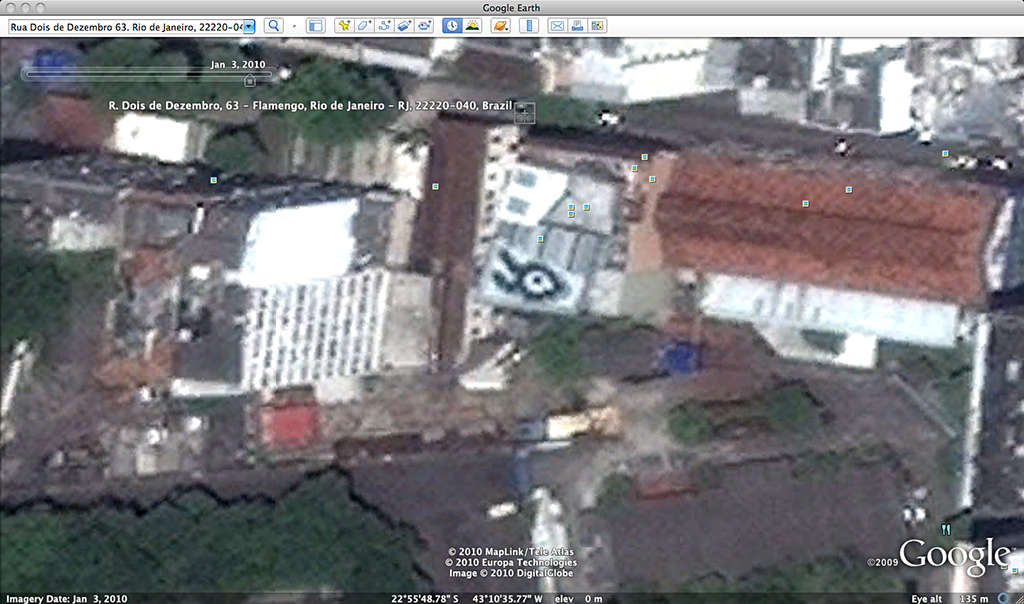
One of the highlights of the exhibition is Kac’s Lagoogleglyph, a work made for viewing from space. Covering a field in Finsbury Park it is optimised by Kac for viewing through satellite imagery and visible in Google Earth. The Lagoogleglyph is part of a series which forms a globally distributed artwork visible only from space. Earlier Lagoogleglyphs were installed at Oi Futuro, Rio de Janeiro, Brazil (in 2009) and Es Baluard Museum of Modern and Contemporary Art, Palma de Mallorca, Spain (in 2015).
Also featured in the exhibition:
In Adhuc (1991), holography alters our behaviour as readers. You cannot read the poem left to right. You must dance a little in front of it. As you do this, letters and words shift, drift away and colours change.
Inner Telescope (2017), performed by the French astronaut Thomas Pesquet in the International Space Station, is poetry for zero gravity. The form has neither top nor bottom, front or back, left or right. Sometimes it looks like the French word MOI (me). At other times, it looks like a human figure with the umbilical cord cut. It is the first poem to be made in outer space.
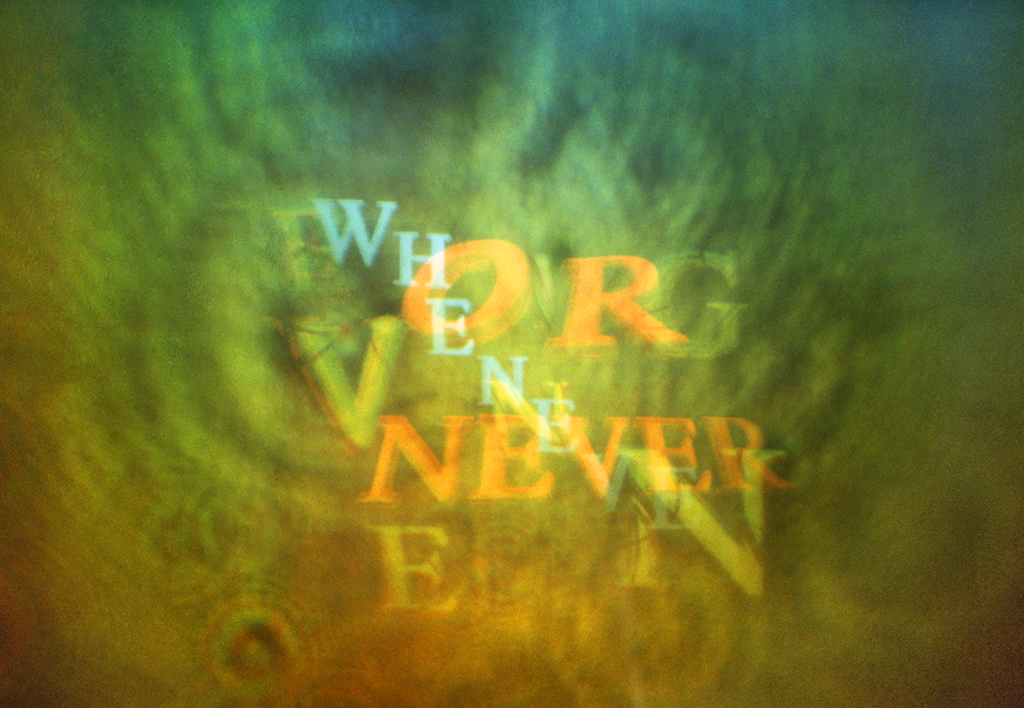
Let’s Fill this Park with Rabbits!
Free family Workshops
Sat 7 April, Sun 22 April & Mon 7 May, 11am – 4.30pm
Furtherfield Gallery
Families and groups of all ages are invited to join artist Michael Szpakowski to design their own giant rabbits and draw them on Finsbury Park by walking your own rabbit route using GPS software. Just turn up on the day to book a place for your group – workshop places will be offered on a first-come first-served basis on each day. Groups and families can also just turn up on each day to join in with the fun and walk some bunny routes in the park.
FREE
Arts and Humanities Research Council Digital Transformations Workshops
Inspired by and building on the Kac exhibition, these workshops will draw together themes and issues which have emerged from the AHRC thematic research programmes including Translating Cultures, Science in Culture, Care for the Future and Connected Communities.
More info
Digital Transformations and Community Engagement
18 April 2018, 10.30am – 4pm
Furtherfield Commons
How can we promote collaboration between communities and academic researchers? Do digital methods help create community engagement?
FREE | booking essential
Reconnecting Artistic Practice and Humanities Research
25 April 2018, 10.30am – 4pm
Furtherfield Commons
Can a renewed dialogue between humanities scholars and artistic practice provide innovative perspectives to confront current social and cultural challenges?
FREE | booking essential
Language and Diversity
8 May 2018, 10.30am – 4pm
Furtherfield Commons
Exploring the role of language and translation in promoting understanding and communication within, between, and across diverse cultures.
FREE | booking essential
Science in Culture
23 May 2018, 10.30am – 4pm
Furtherfield Commons
How can art engage with science and technology? And how can art explore the role of science in culture?
FREE | booking essential
Further Eduardo Kac exhibitions are being held in London during 2018 as part of the AHRC Digital Transformations theme. During June, the Horse Hospital, Colonnade, Bloomsbury, London WC1N 1JD, will host an exhibition called … and the Bunny Goes Pop!
This exhibition forms part of research undertaken by the Digital Transformations strategic theme of the Arts and Humanities Research Council. It has been curated by Professor Andrew Prescott of the University of Glasgow with assistance from Furtherfield team and Bronac Ferran, with advice and support from the artist.
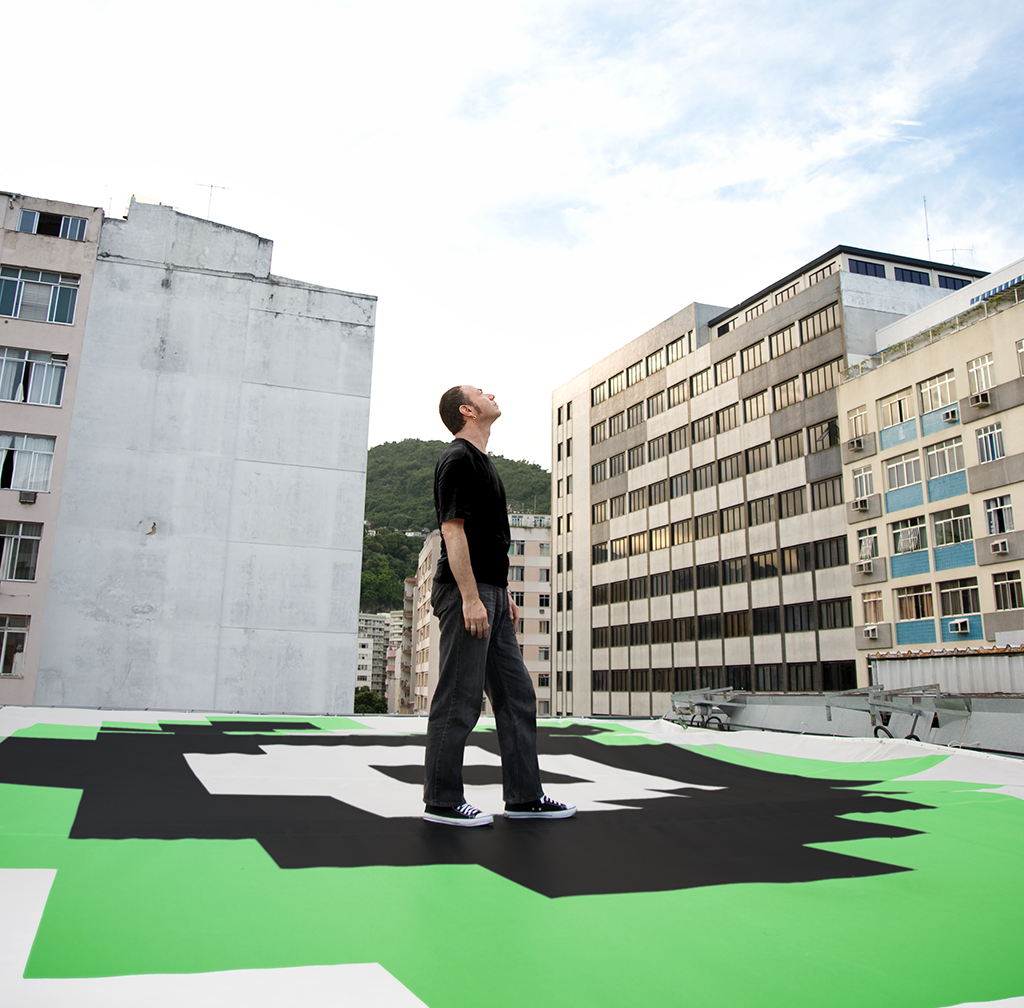
Eduardo Kac has been a pioneer in exploring the use of new technologies to create innovative poetic experiences. Experimenting with a range of technologies since the 1980s including fax, photocopiers, LED screens, the French videotext service Minitel, holography, conductive ink, and a variety of digital and network technologies. Kac’s distinctive body of work has been featured in exhibitions in New York, Paris, Rio de Janeiro, Madrid, Shanghai, Tokyo and many other venues. He has received the Golden Nica Award, the most prestigious award in the field of media arts and the highest prize awarded by Ars Electronica. This is his first solo exhibition in the United Kingdom.
Andrew Prescott, Professor of Digital Humanities at the University of Glasgow and Theme Leader Fellow for the ‘Digital Transformations’ strategic theme of the Arts and Humanities Research Council.
Furtherfield is an internationally renowned arts organisation specialising in labs, exhibitions and debate for increased, diverse participation with emerging technologies. At Furtherfield Gallery and Furtherfield Lab in London’s Finsbury Park, we engage more people with digital creativity, reaching across barriers through unique collaborations with international networks of artists, researchers and partners. Through art Furtherfield seeks new imaginative responses as digital culture changes the world and the way we live.
Furtherfield Gallery
McKenzie Pavilion
Finsbury Park, London, N4 2NQ
Visiting Information